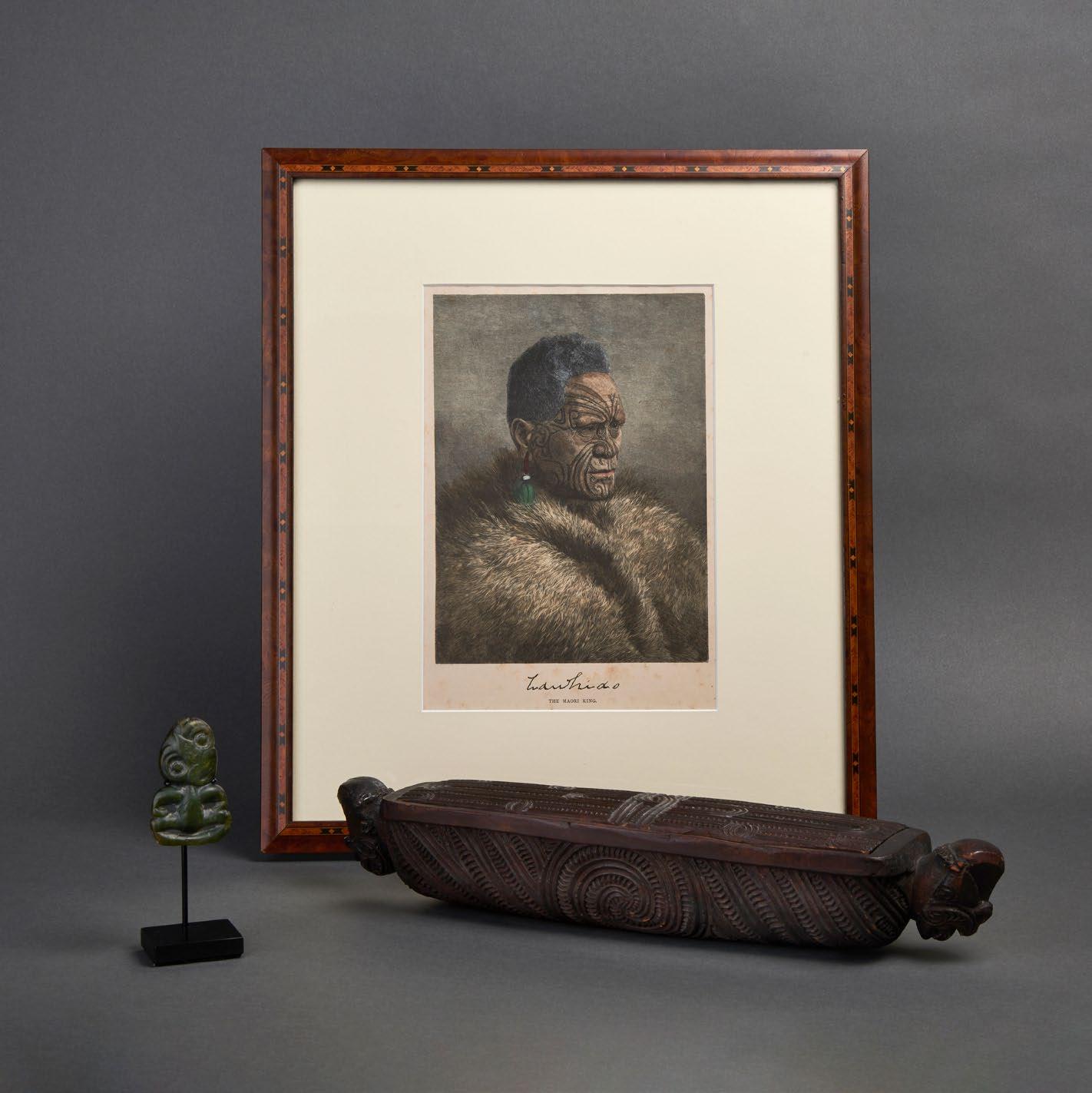

The Indigenous Arts of the Southern Hemisphere
Auction • Part 1 Melbourne, 16 & 17 November 2025
Auction • Part 2 Auckland, 24 November 2025
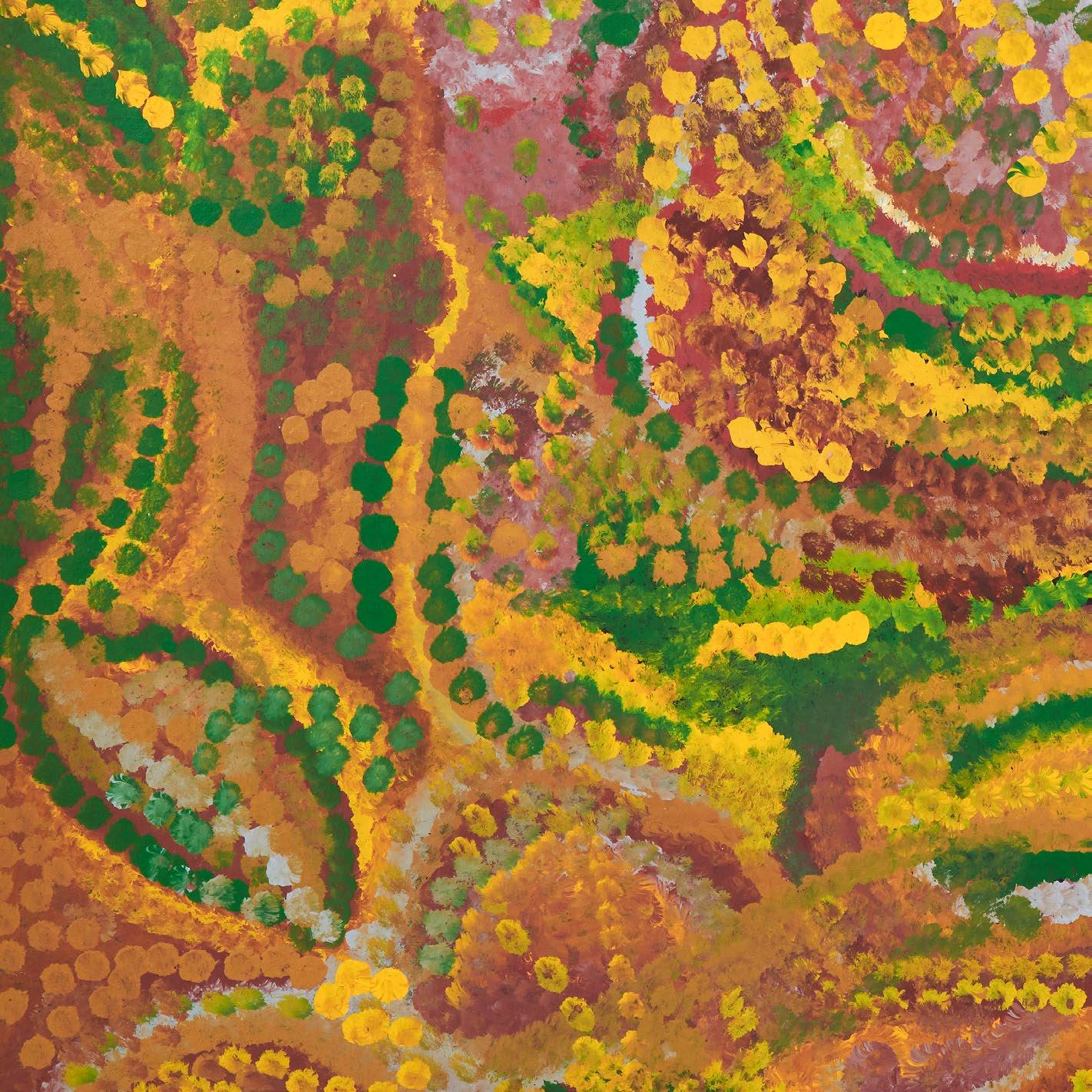
Emily Kam Kngwarray 1910-1996
Yam Flowers, 1992

Specialists
Single-Owner Auctions
Paul Sumner 0412 337 827
Sandy Bruce 0421 920 387
Chinese and Asian Arts
Donald Lee 0455 888 080
Yang Yang 0466 112 688
Paul Sumner 0412 337 827
Indigenous Australian Art
Shaun Dennison 0410 501 857
Arts of the Middle East
Dr Susan Scollay 0418 175 694
design + decoration & Interior Decorator Auctions
Amanda Swanson 0414 592 234
Australian and International Art
Paul Sumner 0412 337 827
Michael O’Meara 0418 505 519
Ethnographic Arts
James Parkinson james@artvisory.com.au
Melissa Parkinson melissa@artvisory.com.au
Regional Representatives
Western Australia
Julie Smetana 0427 921 756
South Australia
Judith Quigley 0417 841 355
Brisbane
Dominic Katter (07) 3003 1850
New Zealand
James Parkinson james@artvisory.com.au
Melissa Parkinson melissa@artvisory.com.au
For all email enquiries please email mail@artvisory.com.au
The Indigenous Arts of the Southern Hemisphere
Part 1 Melbourne
PART 1 LIVE AUCTION
PART 2 LIVE AUCTION
VIEWING
COLLECTIONS
Evening Session: Sunday 16 November 2025, 6pm (AEDT) Day Session: Monday 17 November 2025, 10am (AEDT)
See New Zealand auction details for Part 2 on page 166.
Thursday 13 November 11am–5pm Friday 14 November 11am–5pm
Saturday 15 November 11am–5pm Sunday 16 November 11am–3pm
Tuesday 18 November 10am–5pm Wednesday 19 November 10am–5pm Thursday 20 November 10am–5pm
ADDRESS Artvisory 310 Toorak Road, South Yarra, Melbourne
ONLINE View catalogue online at www.artvisory.com.au
SPECIALIST ENQUIRIES
ADMINISTRATION ENQUIRIES
James Parkinson james@artvisory.com.au
Melissa Parkinson melissa@artvisory.com.au
Accounts & auction administration: Amanda Swanson 0414 592 234 amanda@artvisory.com.au
Shaun Dennison 0410 501 857 shaun@artvisory.com.au
Paul Sumner 0412 337 827 paul@artvisory.com.au
Collections & Shipping: Jennifer Hirst 0410 777 996 jennifer@artvisory.com.au
2025 AUCTION YEAR IN REVIEW
Artvisory was instructed to sell some incredible collections this year — collections that had been formed over decades, and in one case, over centuries.
The Contents of Gringegalgona
In June we sold the contents of the stunning Victorian mansion Gringegalgona in the Western District of Victoria.
Hugh and Sue Gaussen, descendants of a Huguenot family, that dates back centuries, were faced with the difficult task of breaking up their home and selling art and antiques that had been in their family for many generations, but with no other viable option, we were invited to advise on how this could best be done, following the sale of their property.
It was both an honour and a great adventure for us to handle this collection. Not only was there
an incredible family story for us to tell but as we progressed the cataloguing of the collection, we had some great discoveries, such as the pair of badly broken and very incomplete blue and white vases that the family were going to throw out. We said: ‘Sell them as they are’ and they fetched $5,240. inc. BP.
A folder of wonderful topographical watercolours of the Peninsular War, fought by allied forces on Spanish soil in the early 19th century, revealed not only their own considerable value ($11,970.00 inc BP), but also that a distant connection to the Gaussen family
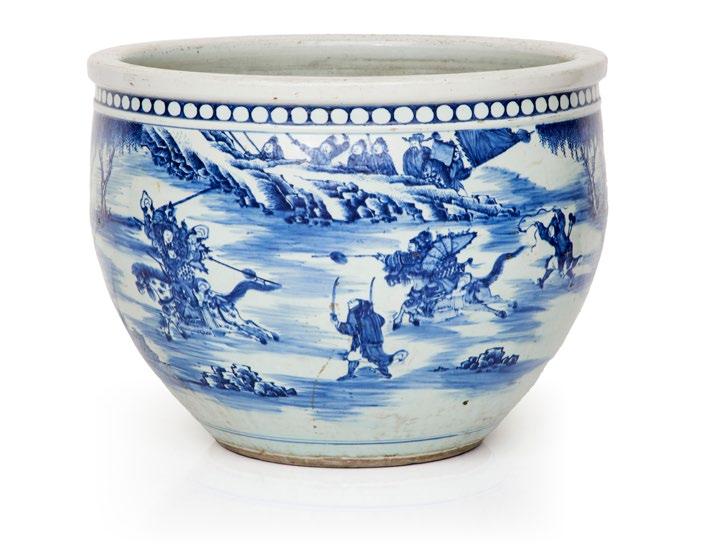
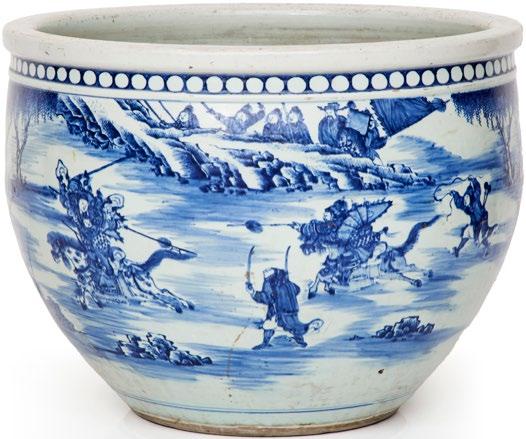
Editor: Amanda Swanson
had come to Australia in the early 19th century and who had become Private Secretary to Governor Darling. These watercolours had belonged to him but it remained unclear how they had come back within the Gaussen family collection. If only items could talk…
This auction in particular reminded us how very fortunate we are to operate in such a business, one which is peppered with incredible stories of great lives, where the items that we sell become inextricably intertwined with these fascinating narratives.
LEFT
A large Chinese blue and white jardinière, Chinese, Daoguang period (1782-1850)
Estimate $3,000–5,000
Sold for AUD$24,890.00 inc. BP
RIGHT
An impressive Chinoiserie black-lacquered oak cabinet-on-stand, English, early 18th century
Estimate $4,000–6,000
Sold for AUD$25,200.00 inc. BP
FAR RIGHT
After Annibale Carracci, after Correggio (Italian School, 18th/19th century)
Madonna and Child with Saints Jerome and Magdalene known as 'Madonna di San Gerolamo' or 'The day'.
Estimate $7,000–10,000
Sold for AUD$21.420.00 inc. BP
THE VENDORS REPORT CARD
After the sale of ‘Gringegalgona’ we were left with the vexing question of what to do with the contents of a sizeable Victorian home, that was furnished with an eclectic assortment of articles assembled over many generations. Paul Sumner’s name had been recommended to us as the way to proceed. Our initial contact bought a swift response from Paul, his advice on art works and a proposal of how to present the contents for sale. Paul and Amanda together with their professional team, proceeded to photograph and catalogue each and every item for sale.
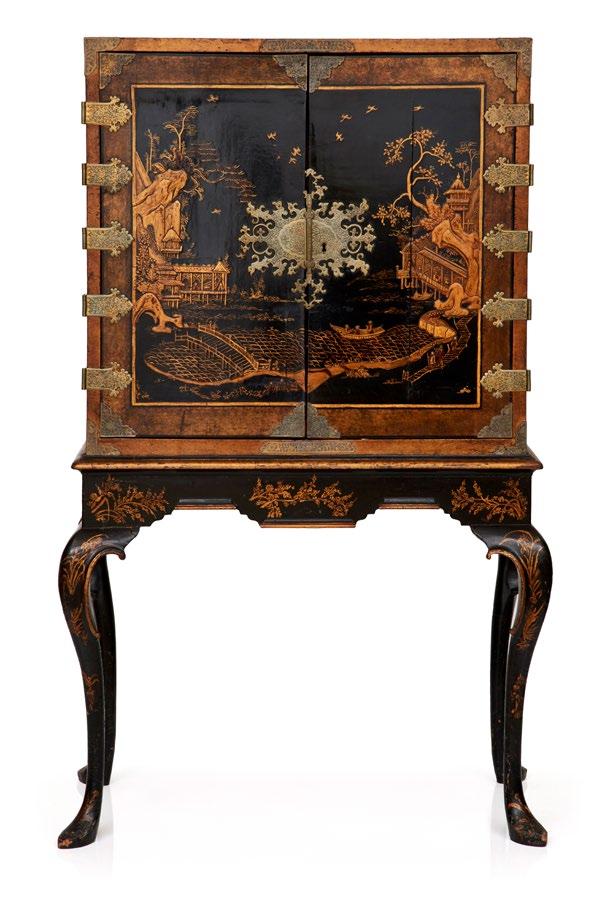
Throughout this process they were all very aware, and considerate of our emotions in dismantling our home, and we thank them for caring.
All the sale items were packaged and transported to Artvisory. Further research was carried out, and a truly magnificent catalogue created. Paul and Amanda’s talent for displaying the works was amazing. It was somewhat disconcerting to see our possessions in a completely different setting, but it worked!
We thank Paul and Amanda and their team. Hugh and Sue Gaussen
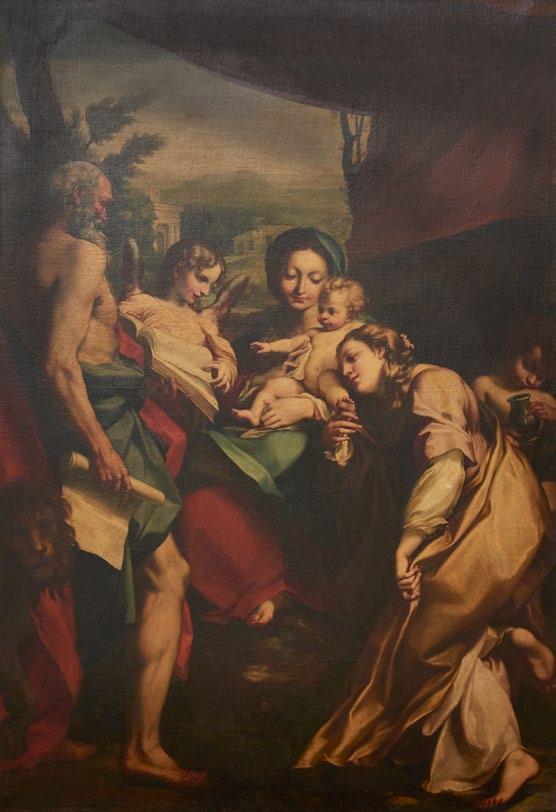
The Collection of David and Marie Louise Wordsworth
In July we were instructed to take on the great challenge of preparing for auction the vast and important West Australian collection of David and Marie-Louise Wordsworth in Perth. This was no mean feat as the collection was as varied as it was large and preparing a collection on the other side of our vast country, in itself, presented its own challenges. We never take the responsibility of handling a family collection lightly as we recognise the importance to our vendors in handling their family history with great respect and dignity. There were literally thousands of items and we had to make a
decision about the duration of the auction, as there is a limit to the number of lots you can put up for live auctions, without negatively impacting the overall auction. Together with the collector’s daughter Sara Wordsworth, we agreed to offer the extraordinary Prinsep archive of letters, documents, artworks and historical ephemera relating to the Bunbury and Busselton region of Western Australia as one lot, instead of breaking it up piece-meal. We further agreed to hold a Part 2 timed-online auction for the general antiques and effects which reduced the number of live auction
items to a manageable scale, but even so, the live auction held at Cottesloe Civic Hall started at noon and finished at dusk!
In the end all the planning worked out very well and every single lot of the 750 offered found a new home and the Prinsep archive sold to a West Australian institution for nearly six times its pre-auction estimate at $126,000. inc BP. The staggering results of this auction made the news in London and we were delighted to receive this testimonial from Sara Wordsworth after the auction had been settled by the trust accountants.
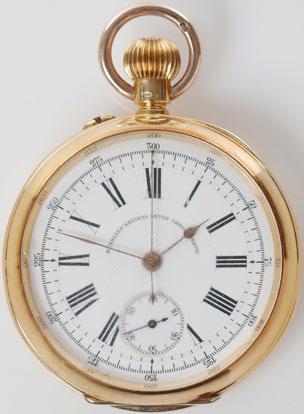

FAR LEFT
Alexander Forrest's 18 carat gold Russell's Keyless lever chronograph pocket-watch inscribed to Alexander Forrest from Wilson Barratt's, Christmas day, 1898
Estimate $3,000–5,000
Sold for AUD$35,280.00 inc. BP
LEFT
The Extraordinary Henry Charles Prinsep and Prinsep Family Archive
Estimate $5,000–10,000
Sold for $126,000.00 inc. BP
THE VENDORS REPORT CARD
I employed Artvisory after meeting Paul, who had been recommended to me. He kindly flew over from Melbourne to meet with me.
I was overwhelmed by my parents’ collection and didn’t really know where to start, as there were valuable artworks, furniture and chests and drawers stacked full of early Western Australian history and antiques. The size and complexity of the collection unfazed Paul and he took an amazing load off my shoulders. He understood the collection and he worked hard to attract the best new homes for it. His meticulous research engendered further confidence and the catalogue they produced is fabulous. Paul was direct and honest in all his dealings and he covered all the bases. I had no worries or concerns and the process was without hitches and gave me great reassurance.
In addition to that he was a thorough gentleman with very professional and courteous staff.
I have absolutely no hesitation in recommending Paul, Amanda and their staff. They are wonderful and I was very happy with the results they obtained.
Sara Wordsworth Perth, West Australia.
Estimate $40,000–60,000 Sold for $AUD$138,600.00 inc. BP

RIGHT
English school Manner of Thomas Phillips, or William Beechey (English, circa 1832-34)
Portrait of Admiral Adam James Stirling, First Governor of Western Australia, circa 1833
The Estate of Tom Lowenstein OAM
In July we offered the Australian art collection from The Estate of Tom Lowenstein.
Tom was a much-loved identity in the Australian art scene for over 50 years. As personal accountant and confidant to generations of artists Tom’s passing has left a big hole in many people’s lives. Tom’s respect within the Australian art community and the fact that we all felt so much for Tom, meant there was great responsibility on us to ensure the success of
the auction. No stone was left unturned in the process. Michael O’Meara in particular needs to be called out for the diligence he showed in preparing each and every lot and ensuring the accuracy of the auction catalogue, which in itself becomes an item of archival merit.
We were delighted that the auction did as well as it did and we know that Tom would have been happy himself, had he been here to witness the result.
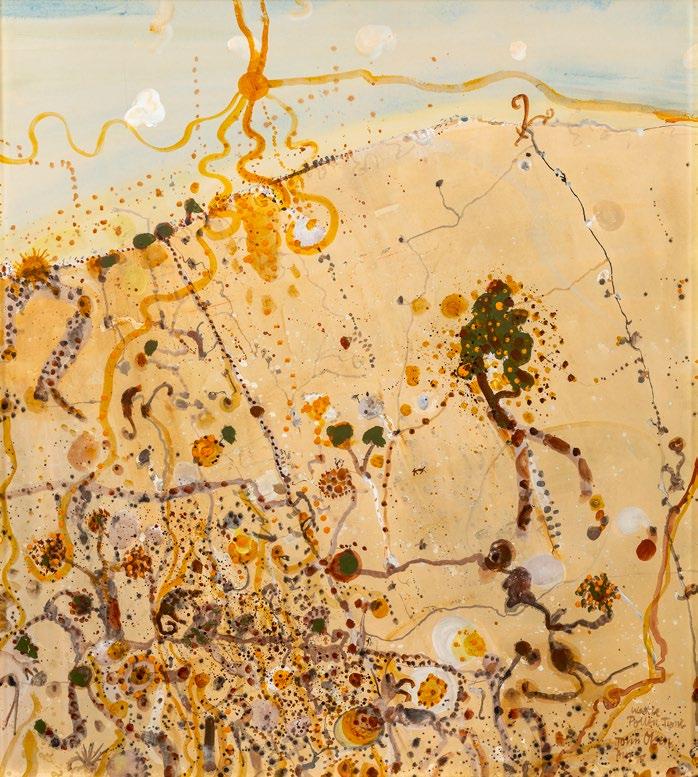
LEFT
John Olsen (Australia, 1928-2023)
Wattle Pollen Time, Aug 1978
Estimate $55,000–75,000
Sold for AUD$176,400.00 inc.BP
THE VENDORS REPORT CARD
I would very highly commend and recommend the staff and team at Artvisory. Every aspect of the sale was handled professionally and thoughtfully and most importantly their hard work and great efforts managed to secure a great result on the night, a result that exceeded all of our family’s expectations.
Paul, Amanda’s and Michael’s strategy was perceptive, bespoke and tactically correct with these combined strategies recommended yielding our great result . They were a pleasure to deal with and their devotion and care to our family’s collection was heartfelt and sincere.
Evan Lowenstein Director, Lowensteins Arts Management

Robert Klippel (Australia, 1920-2001)
Collage, 1993
Estimate $18,000–25,000
Sold for AUD$35,280.00 inc. BP
BOTTOM RIGHT
Hilarie Mais (England, 1952-)
Red Maze II
Estimate $3,000–5,000
Sold for AUD$7,560.00 inc. BP

TOP RIGHT
The Contents of 36 Anderson Street, South Yarra 3141
And then in August, we were invited to tender for the sale of the Contents of 36 Anderson Street, South Yarra which was a gracious home, adjacent to the Royal Botanical gardens. But there was an unusual factor with this auction. The vendors had kept the contents of their previous home in St Georges Road, Toorak and bought in a different style for their South Yarra home. But now, they wanted to combine both contents together into the one auction. This
was a challenge, but every content’s auction provides it’s own curve-balls and our job is always to make things work regardless.
We first advised the vendor to keep the art and antiques together, rather than sell separately, an important factor to ensure that the auction had broad appeal and to attract wealthy art buyers, who would likely bid on other items if we could attract them to the onsite viewings, while retaining enough value in the auction to

allow for adequate prestige marketing. This would be required if we were to sell the large quantity of high-quality antiques and homefurnishings in particular.
We were delighted that the vendor took our advice at every turn and this we feel was a big factor in what became a very successful auction.
A fine mahogany break-front library bookcase, English, circa 1820-30 Estimate $10,000-15,000 Sold for AUD$33,280.00 inc.BP
THE VENDORS REPORT CARD
Selling a lifetime's worth of possessions is a daunting and emotional process. The team at Artvisory handled the entire home contents sale with remarkable professionalism and care. The logistics of the sale were particularly challenging, from the meticulous process of cataloguing and valuing a house full of diverse items to the seamless coordination of the sale itself. Their team managed every detail flawlessly, ensuring the entire process was efficient and stress-free.
Their communication was excellent from start to finish, keeping me informed every step of the way. Most importantly, they achieved a fantastic result, exceeding my expectations. I am so grateful for their expertise and compassionate approach, which made all the difference in what could have been an overwhelming experience. I highly recommend Paul, Amanda and the team at Artvisory to anyone facing the difficult task of selling a lifetime of cherished items.
The Vendors of 36 Anderson Street, South Yarra
FAR RIGHT
John Perceval (Australian, 1923-2000)
Sunflowers (After Vincent Van Gogh)
Estimate 20,000–30,000
Sold for AUD$48,640.00 inc.BP
BELOW
Dean Bowen (Australian, born 1956)
Large Echidna
Estimate $5,000–8,000
Sold for AUD$10,880 inc. BP

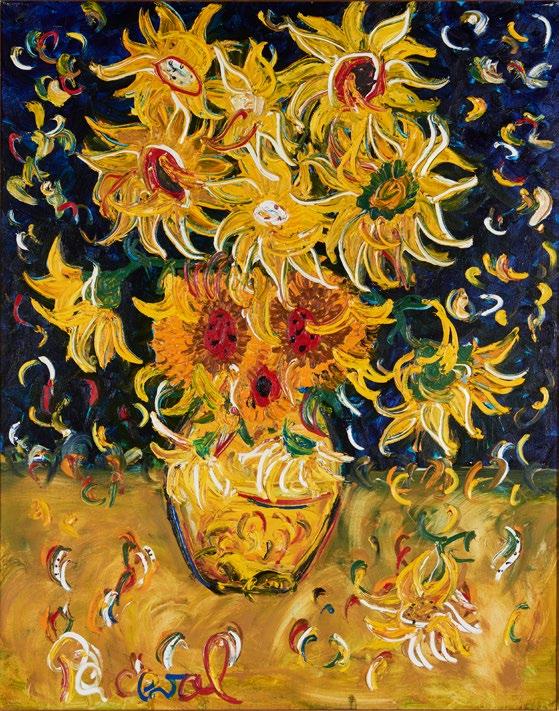
Introducing the Indigenous Arts of the Southern Hemisphere
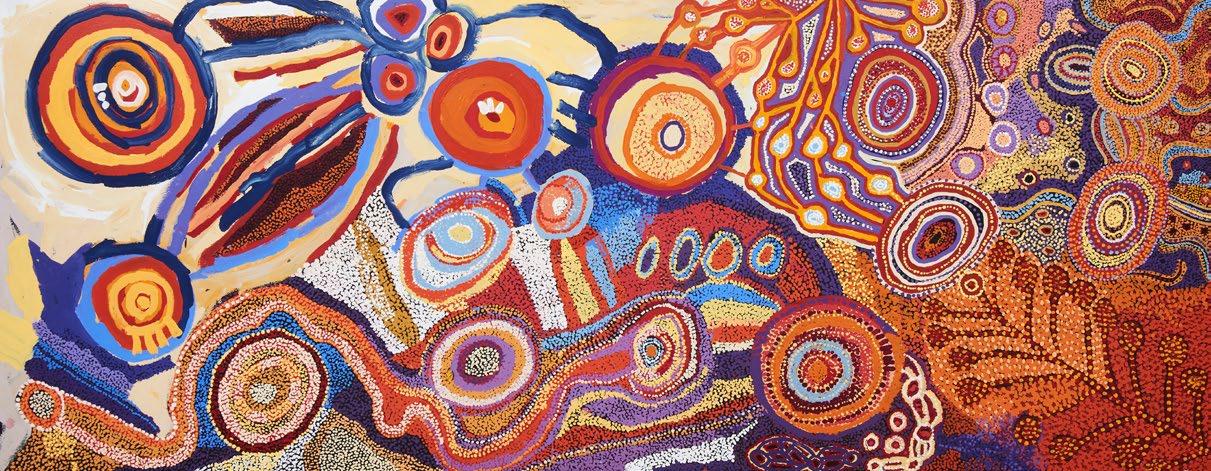
Welcome to this our inaugural auction of ‘The Indigenous Arts of the Southern Hemisphere’.
Our aim now and in the years ahead, is to help develop a strong regional market for the sale of Oceanic and Regional Indigenous artefacts, alongside the already growing market for indigenous paintings and sculpture, where the eyes of the world have already taken notice of the rich cultural and artistic diversity of our region. Although this progress has been a longtime coming, it is due to the inspirational efforts of many in our visual-arts, past and present-specialist dealers, academic curators, public institutions, auction-house
specialists, and many other contributors, who have all moved the dial considerably from where it once was.
This new auction concept, which we are launching here, has been a collaboration between several specialists, with different areas of interest and knowledge and we would like to thank firstly James and Melissa Parkinson, who have made a very dynamic start and while they may not be as wellknown yet to collectors and academics in Australia, they are extremely well-known and respected in New Zealand. We warmly invite you to meet them at our auction viewings. It has already been a great achievement for James and Melissa in consigning so many
wonderful artefacts, on both sides of the Tasman, for this, our first new category auction, especially for consigning two important New Zealand collections and one in Australia, that we will leave James and Melissa to introduce.
Artvisory would also like to thank Shaun Dennison, who is now our longest serving specialist, having been with us from dayone. We have always had great respect for Shaun’s honest and ethical approach with Contemporary Indigenous Australian art, the field in which he has dedicated half his life and in which he is so passionate.
James and Melissa Parkinson’s commentary on this auction:
This catalogue presents a selection of Oceanic art drawn from both New Zealand and Australian collections, with particular emphasis on two distinguished private holdings, one based in Melbourne, the other in Auckland.
The Melbourne collection belongs to Marcia and Ian Parkes, founders of the seminal Collector’s Gallery in South Yarra. From 1979 to 1993, the gallery was a vital presence in Melbourne’s cultural landscape—a pioneering space for ethnographic art. Under the Parkes’ thoughtful stewardship, its quarterly exhibitions garnered critical acclaim and a loyal following, regularly featured in The Age newspaper. The
gallery’s program was global in scope and discerning in taste, encompassing textiles, ritual objects, and ethnographic works from Africa, Melanesia, India, Nepal, Tibet, Bali, the Philippines, and the wider Indonesian Archipelago, as well as the Swat and Chitral valleys of northern Afghanistan and Pakistan. Rugs and kilims from Turkey, Iran, and Afghanistan added further richness to its carefully curated offerings.
The Auckland collection, known as the Epsom Taonga Collection, was assembled by the late Robert Lerner, whose deep respect for Māori and Pacific cultures evolved into a focused and heartfelt practice of collecting taonga tūturu (authentic Māori cultural treasures). In 2011, Lerner acquired the esteemed Kalimantan Collection, which
became the cornerstone of his holdings. The first part of this collection was offered in March 2024, setting a national record for the sale of Māori taonga in New Zealand. The second part, presented here, is equally significant. It includes superb examples of hei tiki, mere pounamu, and other treasured pieces, many accompanied by welldocumented provenance.
Also included in the Melbourne and Auckland auction are pieces from the estate of highly respected Auckland Art Gallery curator Ron Brownson.
Shaun Dennison's commentary on this auction:
“As market interest in secondary Australian Indigenous works continues to grow, sourcing excellent examples has become increasingly challenging, with increased competition for securing works coupled with a reluctance of vendors to let works go. It is within this context that we are delighted to present a curated selection of Australian Indigenous paintings.
This sale features works from across Australia, each with impeccable provenance. Highlights include:
Yam Flowers by the highly collectable Emily Kam Kngwarray, a vibrant piece painted in June 1992 for Delmore Gallery and formerly part of the renowned Alan Boxer Collection.
Blue Reef at Night, 2018 by Naomi Hobson, a significant work exploring the vastness, vivid colours, and patterns of her Country, reflecting both environment and identity.
Minyma Kutjara Tjukurrpa by Maringka Baker, painted in 2021, which is beautifully executed in elegant, understated hues.
A work on canvas board by Old Mick Walankari Tjakamarra, c.1983 which was collected by Margaret Carnegie, who was ahead of her time in collecting Indigenous art works.
A large and rare collaborative piece from Tjala Arts, Ngayuku ngura – My Country, 2013 (pictured on page 12).
We are also offering many other beautiful works, spanning from the 1980s to the present decade”
Welcome to this auction and we look forward to engagement with you at the viewings, or at some stage in the future.
How to bid at our Auctions
Part 1 Melbourne
Catalogues and Viewing
Auction catalogues can be viewed on the Artvisory website www.artvisory.com. au approximately three weeks prior to the published date of an Auction.
Printed catalogues will be available complimentary at the auction viewing and can be express posted (within Australia) prior to the viewing for $25AUD.
The Auction viewing is open to the public and generally takes place during the three days prior to the Auction date at the advertised location/s in the Auction catalogue, 11am-5pm daily.
Lot Descriptions
The Lot/Catalogue descriptions provide the overall information of an item including size, date or age, medium, attribution, quantity and if known, provenance.
Estimates
The estimate accompanies each lot in the printed and online catalogue. This estimate takes into consideration the quality, condition, rarity, condition and provenance of the item. Each estimate also has a reserve, and the reserve is the undisclosed and confidential amount set at or below the low estimate. Please note the reserve will never exceed the low estimate at Artvisory.
Condition Reports
Condition reports supplement the lot/catalogue description and focus on the condition of the item. We strongly advise obtaining a condition report if you are unable to view the lot in person. Condition reports and additional images are available to view as part of the auction item listing at Invaluable.com or can be requested from Artvisory directly.
Symbols
Occasionally a symbol is printed next to a lot number in the catalogue, this indicates a special clause that is associated with the sale of that item. Please refer to the Terms and Conditions for specific symbol meanings and information.
Buyers Premium
Artvisory Auctions in Australia are conducted in AUD and charges a Buyers Premium of 26% on the hammer price of all Auction items unless otherwise stipulated with GST of 10% applicable to the Buyers Premium.
Bidding
Artvisory offers four options for bidding at our Auctions:
Live Bidding
If this is your first-time bidding in person at an Artvisory auction you will be required to register with us, which requires you to fill out a buyer registration form in person at the viewing.
To facilitate this, please bring along your Government issued photo identification, such as a driver’s licence or passport as this is the only form of identification that will be accepted.
Please make sure you register in the name you want your final invoice to be made out to, as invoices once issued cannot be changed, and in certain cases a deposit may be required before you can bid.
Online and Timed Online Bidding
Online bidding via the International Auction platform Invaluable.com allows you to bid via the internet in real time, whilst also allowing you to view the live stream of the Auction. You have two options to register for this service:
• Register via the Artvisory website and an Invaluable.com online bidding fee of 2% of the hammer price is added
• Register direct with Invaluable.com and an online bidding fee of 5% of the hammer price is added
Please make sure you register for online bidding at least 24 hours prior to the Auction to ensure you do not miss your lot and note that you must use Chrome or Firefox as your Internet Browser as Safari is not supported.
Please note if you have not bid with Artvisory previously, then Government issued photo identification verifying your name and address will be also be required before you can be approved to bid with Artvisory via the Invaluable.com site, and in certain cases a bidding deposit (20% of the low estimate of each Lot you wish to bid on) may be required before you can bid.
Artvisory cannot be held responsible for any errors that occur with internet connectivity during an auction or buyer bidding errors.
Bidding Deposits
Artvisory reserves the right to request a deposit for any buyer wanting to register for the auction, and this must be received in cleared funds 24 hours prior to the commencement of the auction. If the buyer is not successful, then it will be refunded in full by the third day after the auction.
Telephone Bidding
Complimentary telephone bidding is available at all of our live Auctions and involves an Artvisory representative calling you approximately 3–5 lots in advance of your nominated lot and you then instruct them to bid on your behalf.
Telephone Bids must be requested at least 24 hours prior to the commencement of the Auction and are provided on a first come, first served basis, as the number of phone lines available are limited.
See our website to download and complete a telephone bidding form and please note that if this is your first time bidding with Artvisory, we will require a clear, scanned copy of Government issued photo identification such as a drivers licence or current passport verifying your name and address and in certain cases a deposit may be required before you can bid.
Artvisory reserves the right to request a deposit for any buyer wanting to register for the auction, and this must be received in cleared funds 24 hours prior to the commencement of the auction. If the buyer is not successful, then it will be refunded in full by the third day after the auction.
Absentee Bidding
Absentee bidding offers convenience if you are unable to attend an Auction in person, bid over the telephone, or if you wish to stick to your budget.
An absentee bid should be set at the maximum amount you wish to bid on the lot/s you are interested in purchasing. Should the lot/s be knocked down at an amount lower than the bid recorded on your form, the lot will be sold to you for the lesser hammer price plus Buyers Premium. If identical bids are received for the same lot, then the first bid received by Artvisory will take precedence.
Absentee bids must be received by Artvisory at least 24 hours prior to the Auction commencing and the Company cannot be held responsible for activating any late bids that are received.
See our website to download and complete an absentee bidding form and please note if this is your first time bidding with Artvisory, we will require a clear, scanned copy of Government issued photo identification such as a drivers licence or current passport verifying your name and address and in certain cases a deposit may be required before you can bid.
Payment and Collection
If you are successful with your bid/s, your invoice will be emailed to you immediately after the Auction finishes.
You will pay the hammer price, plus the Buyers Premium of 26% plus GST on each lot, together with any additional charges such as the Invaluable.com online bidding fee, GST on hammer, or the Artist Resale Royalty if applicable.
As per our terms and conditions, payments must be made in full by three (3) days after the Auction has been completed as printed in the catalogue.
We accept Direct Deposit into the Company Trust Account, Eftpos (up to your daily limit) or credit card in person with the following merchant fee applicable (1.43% inc GST for Visa, Mastercard and American Express)
If you wish to pay “over the telephone“ with a credit card you must request a secure payment link by emailing accounts@artvisory.com.au and the secure BPOINT link will be emailed to you. Cash payments must be deposited direct to the Company Trust account via any Commonwealth Bank Branch, and goods can be released upon supplying the deposit receipt.
Personal, Company and Bank cheques are not accepted. All payment options and Company Trust Account details are included on the invoice that is emailed to you after the Auction if you are a successful bidder.
All items must be paid for in full and collected within the collection times advertised for each individual Auction. If items are not collected within this time frame then Artvisory reserves the right to charge removal, storage and release fees.
Packing and Delivery
Artvisory has a list of recommended carriers specific to each auction that will be sent with your invoice if you are the successful buyer and is happy to help you with this process.
OLD MICK WALANKARI TJAKAMARRA
AUSTRALIAN, 1914-1946
Untitled, c.1983
synthetic polymer paint on artist canvas panel
46 x 61cm
PROVENANCE
Collected by Margaret Carnegie, Melbourne
Private collection, Melbourne
$8,000–10,000
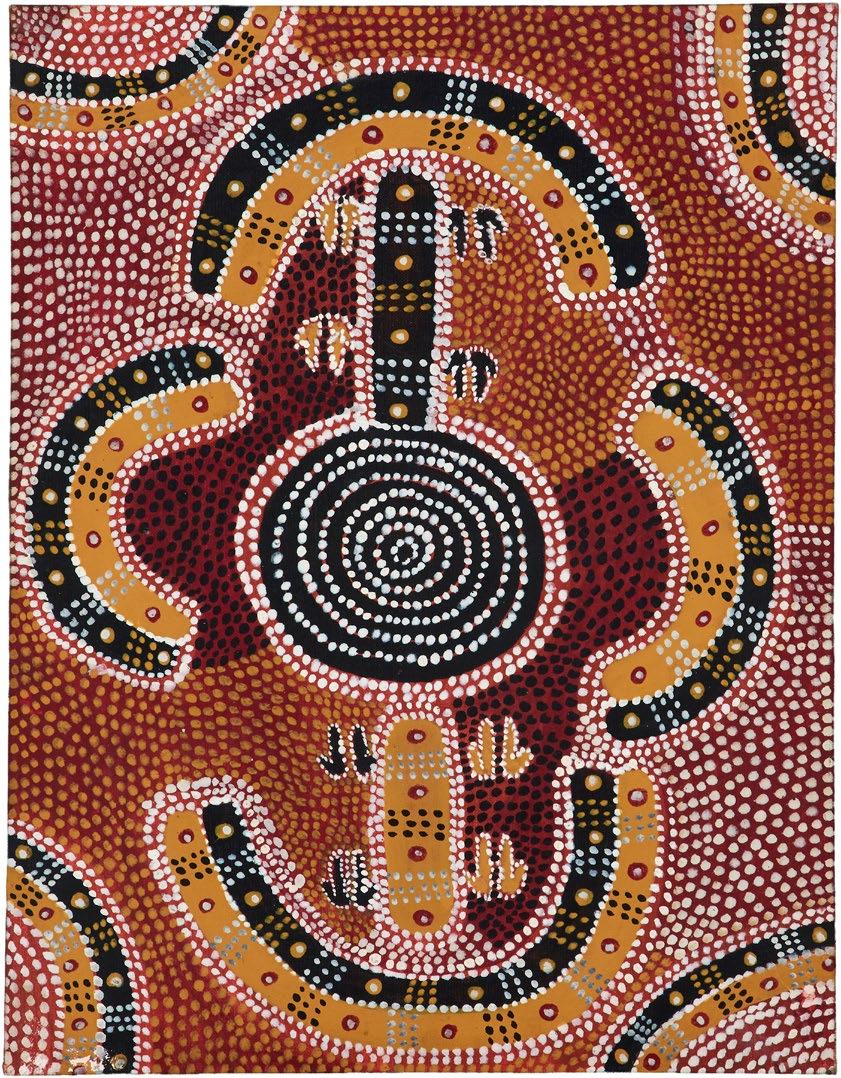
JIMMY YANYATARI DONEGAN AUSTRALIAN, 1940-2022
Malu Tjukurpa, 2020
acrylic on linen 122 x 61cm
PROVENANCE
Ninuku Artists, Anangu Pitjantjatjara Yankunytjatjara (APY) Lands, cat. no. 20-444
Raft Artspace, Darwin Private collection, America
$4,000–6,000
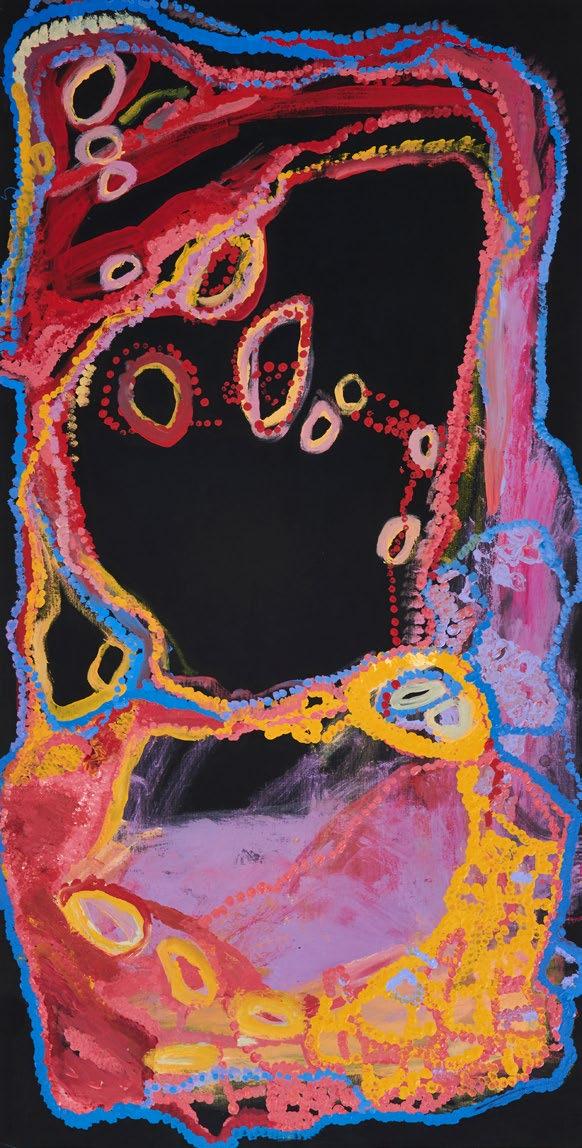
NYARAPAYI
GILES
AUSTRALIAN, 1940-2019
Warmurrungu, 2018
acrylic on canvas
122 x 91.5cm
PROVENANCE
Tjarlirli Art Centre/Kaltukatjara Art, Western Australia, cat. no. 18/418
Darwin Aboriginal Art Fair (DAAF) 2021
Private collection, America
$3,000–5,000

CAROLANNE KEN
AUSTRALIAN, 1971
Minyma Makuli Tjukurpa, 2021
acrylic on canvas
152 x 148cm
PROVENANCE
Kaltjiti Arts, cat. no. 622-21, South Australia
Salon des Refuses, 2022, Darwin
Private collection, America
$5,000–7,000

NORA WOMPI (NUNGURRAYI)
AUSTRALIAN, 1939-2017
Kunawarritji, 2013
acrylic on linen
180 x 120cm
PROVENANCE
Warlayirti Artists, Balgo Hills, Western Australia, cat. no. 44/13
Private collection, America
$8,000–12,000
Wompi was a Manyjilyjarra and Kukatja woman, born in the Great Sandy Desert at Lipuru (Libral Well, Canning Stock Route Well 37). She grew up in the desert between Punmu and Kunawarritji (Canning Stock Route Well 33) and further northward.
Wompi was a prolific painter and evocative storyteller, with deep knowledge about the Country surrounding her home at Kunawarritji. Wompi was highly regarded for her beautifully ethereal style.

An Impressive Dayak Hudoq Mask
Kalimantan, Indonesia, 20th century
Painted in red, white and black enamel with mirror disc eyes, embellished with beads and ring earrings. Mounted on a custom-made stand.
46cm height, 47cm wide
PROVENANCE
Collection John Graham, Melbourne
$4,000–6,000
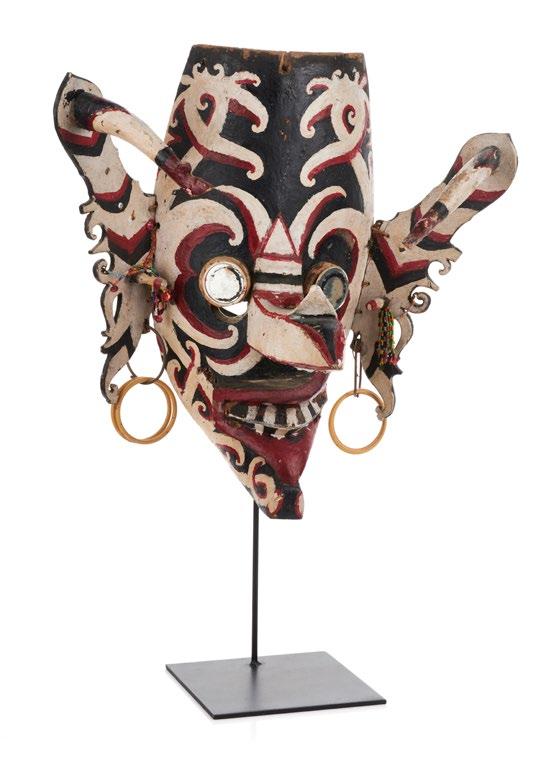
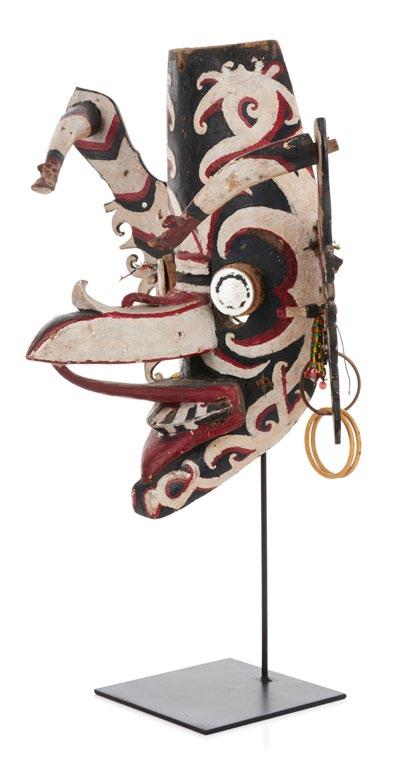

A Sunduk Grave Marker
Sama/Bajau Culture, Sulu Archipelago, Philippines, early 20th century
Large carved wood folate and scroll design grave marker.
Mounted on custom made stand.
110cm height, 38cm wide
PROVENANCE
Collection Ian and Marcia Pakes
$800–1,200

Two Rare Gogodala Headdresses
Middle Fly District, Western Province, Papua New Guinea, 20th century
Woven plant fibre construction, decorated with brown, black, and white pigments. 42cm height, 23cm diameter
PROVENANCE
Collection Peter Hallinan, field collected in the 1960s Collection Ian and Marcia Pakes
Adorned with cassowary feathers. Used in ritual or performance contexts associated with clan identity or initiation.
$1,000–2,000

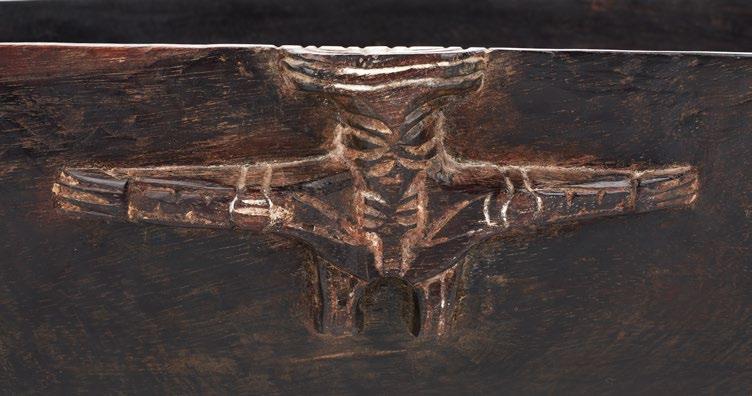

9 (Detail)
A Superb Large Tami Bowl
Tami or Siassi Island, Huon Gulf, Papua New Guinea, early 20th century
Elongated elliptical form carved from a single piece of Kwila. Each side features an ancestor figure carved in high relief on an ebonised surface, flanked by stylised serpent motifs at either end and highlighted with lime.
A beautiful example.
83cm length, 31cm wide
PROVENANCE
Collection of Peter Hallinan, field collected in the 1960s
Collection of Ian and Marcia Pakes
$1,000–2,000
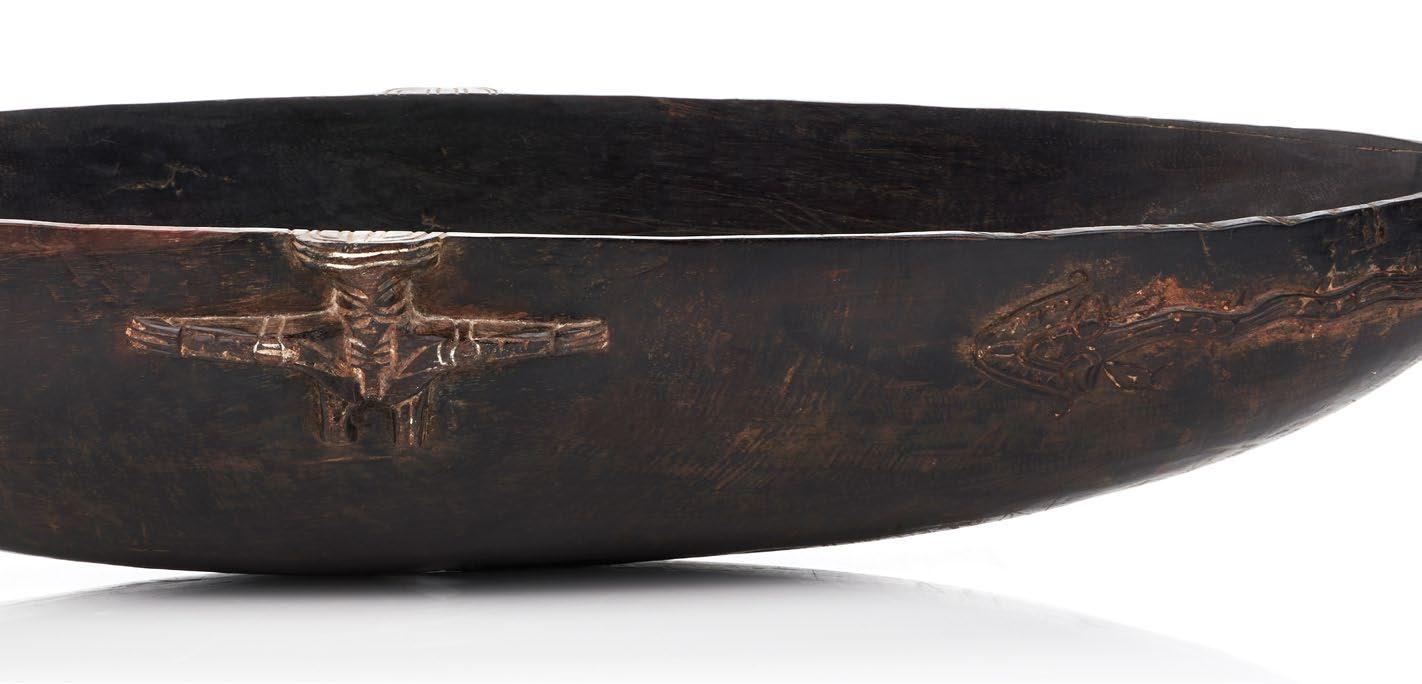
A Rare Iwam Canoe Prow
May River, Upper Sepik Region, early to mid-20th century
Finely carved wooden prow adorned with aquatic wave and dentate patterns intersecting with furling navigatory star motifs.
107cm length, 13cm height, 15cm wide
PROVENANCE
Collection Roman Grynberg, best known for his work in international trade and Pacific Island development, also a notable collector of tribal art, particularly from Oceania and Africa.
Private Collection Melbourne
The Iwam people of the Upper Sepik region are renowned for their intricately carved shields, canoe prows, and paddles.
$2,500–4,000
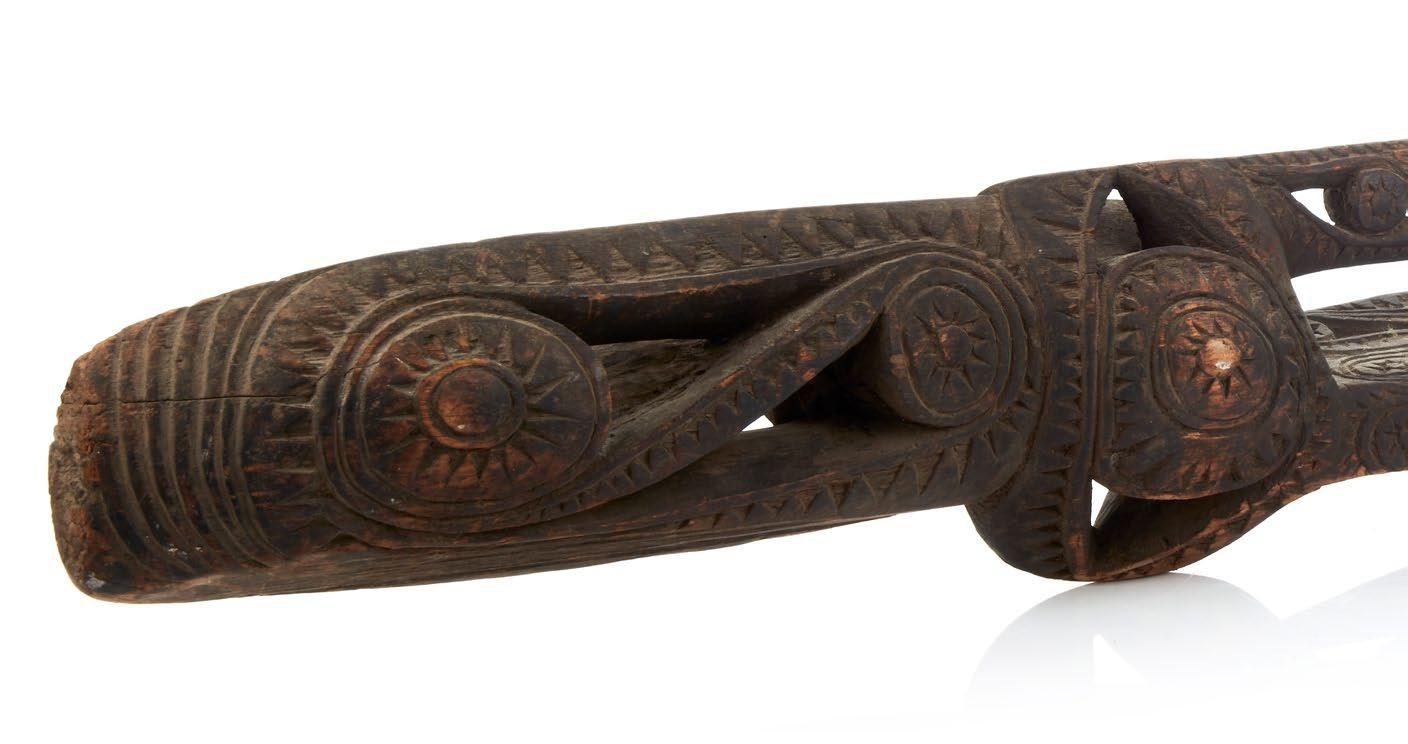

BARBARA (MBITJANA) MOORE AUSTRALIAN, 1964-
Ngayuku Ngura (My Country), 2013
acrylic on canvas 122 x 198cm
PROVENANCE
Tjala Arts Centre, South Australia, cat. no. 316-13
Deutscher and Hackett, Important Aboriginal + Oceanic Art Auction 25/05/2016, lot 76, Melbourne Private collection, America
EXHIBITED
Ngayulu Nguraku Ninti – The Country I Know Barbara Moore & Sharon Adamson Kluge-Ruhe Art Collection (2019-2020)
$7,000–10,000


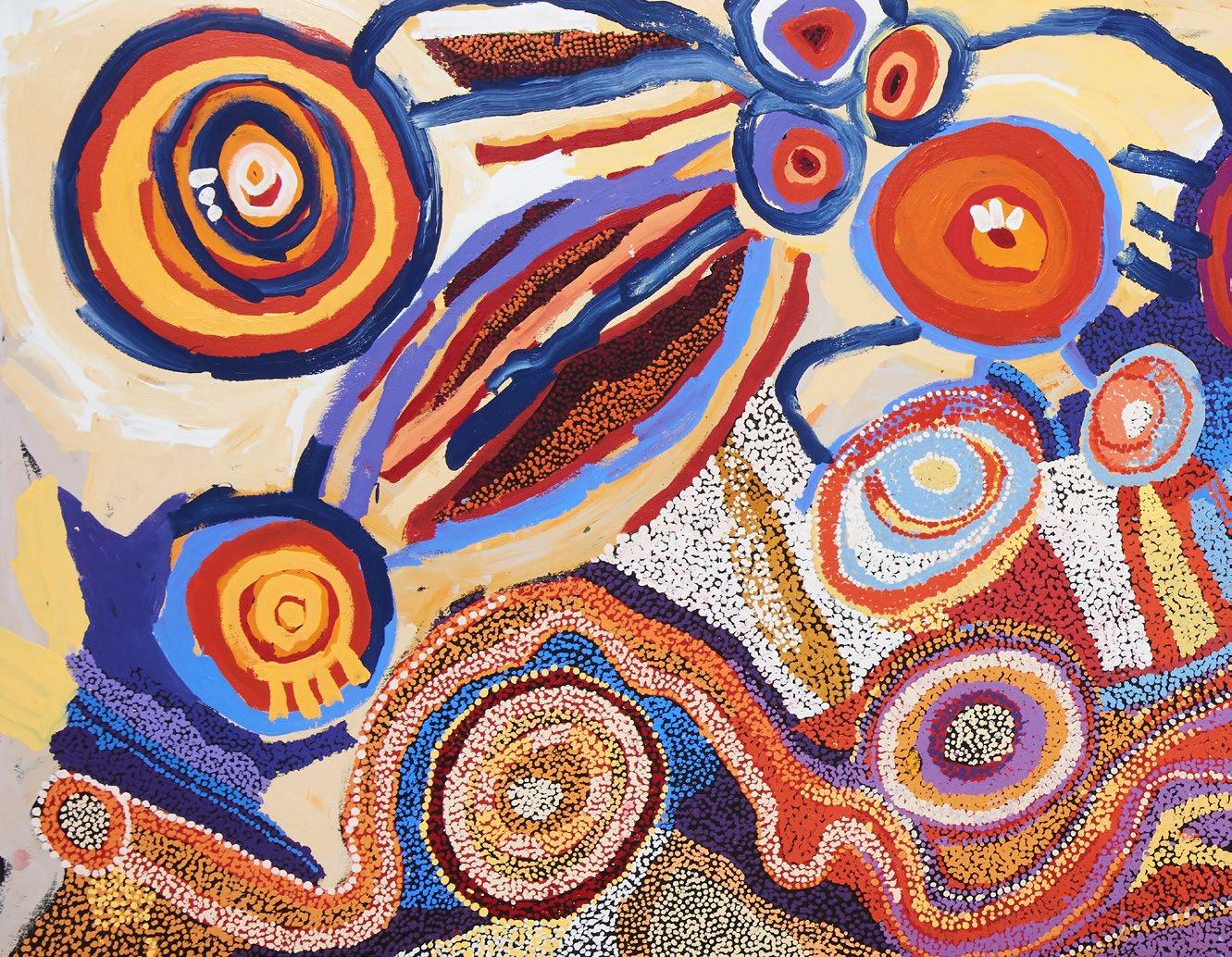
PROVENANCE
TJALA ARTS COLLABORATIVE AUSTRALIAN
Ngayuku ngura – My Country, 2013
Tjala Arts, Alice Springs, cat. no. 236-13
Private collection, Sydney
$25,000–35,000
synthetic polymer paint on linen
117 x 295cm

This stunning painting was created by Kunmanara (Wawiriya) Burton (1925-2021), Ruby Tjangawa Williamson (1940-2014), Barbara Mbitjana Moore (1964-), Katanari (Nancy) Tjilya Burton (c1939-), Mary Katatjuku Pan (1944-), Paniny Mick (1939-2022) and Naomi Kantjuriny (1944-). In this painting the women of Tjala have depicted their country. The different colours and designs represent variations in the landscape and the existing spirits.
Collaborative works offer valuable insights into the culture and identity of a community. The artists of Tjala Arts are particularly recognised for their vibrant use of colour and dynamic mark-making, both of which are clearly demonstrated in this piece. The composition is cohesive and visually engaging, resulting in a work that is both aesthetically pleasing and culturally significant.
NAOMI HOBSON
AUSTRALIAN, 1979
Blue Reef at Night, 2018
synthetic polymer paint on canvas
210 x 210cm
PROVENANCE
ReDot Fine Art Gallery, Singapore cat. no. NH201806006
Private collection, America
$20,000–25,000
Naomi Hobson’s artistic practice spans painting, photography, and ceramics, drawing deeply from connections to Country, culture, and family. Since 2008, Hobson has exhibited widely across Australia and internationally, with works acquired by many Australian institutions. Blue Reef at Night exemplifies Hobson’s distinctive style and is an excellent example of her work. As Hobson explains:
‘My aboriginality is what grounds me. Through art I get to freely express all of this. I can share my creative freedoms in a contemporary way. My style also reflects my individuality... I want my work to tell my stories in an innovative way. I want to introduce new work, to maintain a point of difference. I am wary to re-define and not recycle.’*
This painting powerfully conveys Hobson’s connection to the Cape York Peninsula in Far North Queensland. The artwork explores the vastness, vibrant colours and patterns of Hobson’s Country, reflecting both environment and identity.
Shaun Dennison
* https://naomihobson.com.au/work/language-of-the-land/
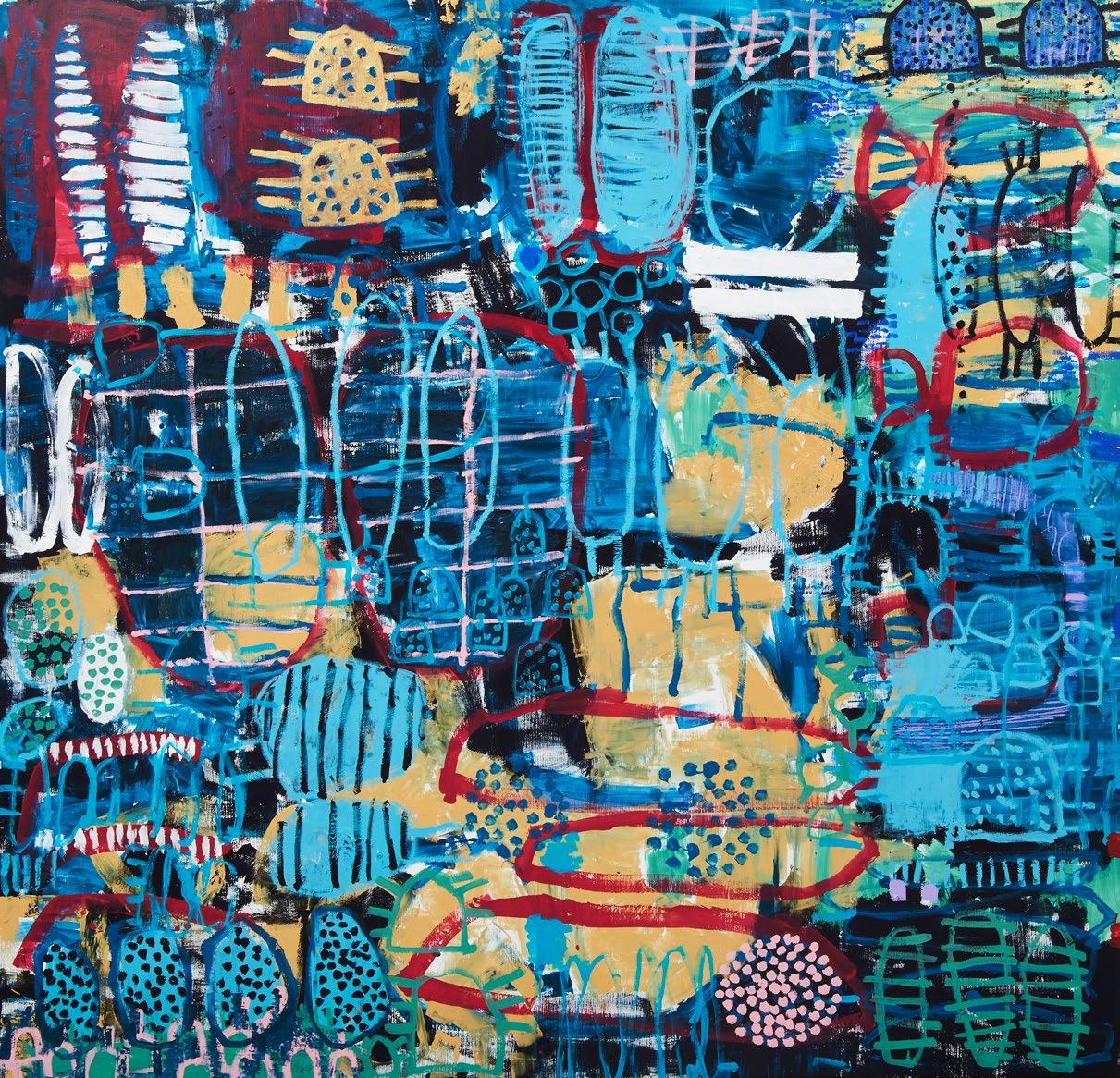
EMILY KAM KNGWARRAY
AUSTRALIAN, 1910-1996
Yam Flowers, 1992
acrylic on Belgium linen bears a Sotheby's consignment number 92F039 151 x 122cm
PROVENANCE
Delmore Gallery, NT cat. no. 92F039
The Alan Boxer Collection, Canberra Private Collection, Canberra
$250,000–350,000
Emily Kam Kngwarray is one of Australia’s most critically acclaimed contemporary artists. Her work has been celebrated internationally, with two major retrospective exhibitions overseas: the current exhibition at the Tate Modern (July 2025 to January 2026), and previous retrospectives at the National Museum of Art in Osaka (February to April 2008), and the National Art Center in Tokyo (May to July, 2008). In addition, her paintings have been featured by commercial galleries abroad, including the recent Emily Kam Kngwarray, My Country exhibition at Pace Gallery London (June to August 2025) in conjunction with D’Lan Contemporary. Emily began painting on canvas in 1988, and over an eight-year period, it is estimated that she produced approximately 3,000 works. At the time, her paintings were considered fresh, innovative, and distinctly contemporary — a quality they retain today. By embracing an abstract, free-form style that resonated with the art market, Emily (along with other notable Indigenous artists in the late 1980s and early 1990s) paved the way for other Indigenous artists to express themselves with greater freedom, breaking away from pre-determined constraints. This marked a significant turning point in the Australian Indigenous art movement, particularly for women artists, who have since become a powerful force in the field.
Emily painted for various agents, but most notably for Delmore Gallery and Rodney Gooch. In my opinion, the quality of the paintings from these sources are consistently high quality.
We are fortunate to be able to offer Yam Flowers, a vibrant work painted in June 1992 for Delmore Gallery. In that year, Emily shifted her style, moving away from the simple linear structures influenced by batikmaking seen in her earlier work, and towards large fields of dots that allowed for quicker execution. Yam Flowers is an excellent example from this period and comes from the renowned Alan Boxer Collection. Alan Boxer was a discerning collector ahead of his time in acquiring excellent examples of Indigenous art.
Shaun Dennison
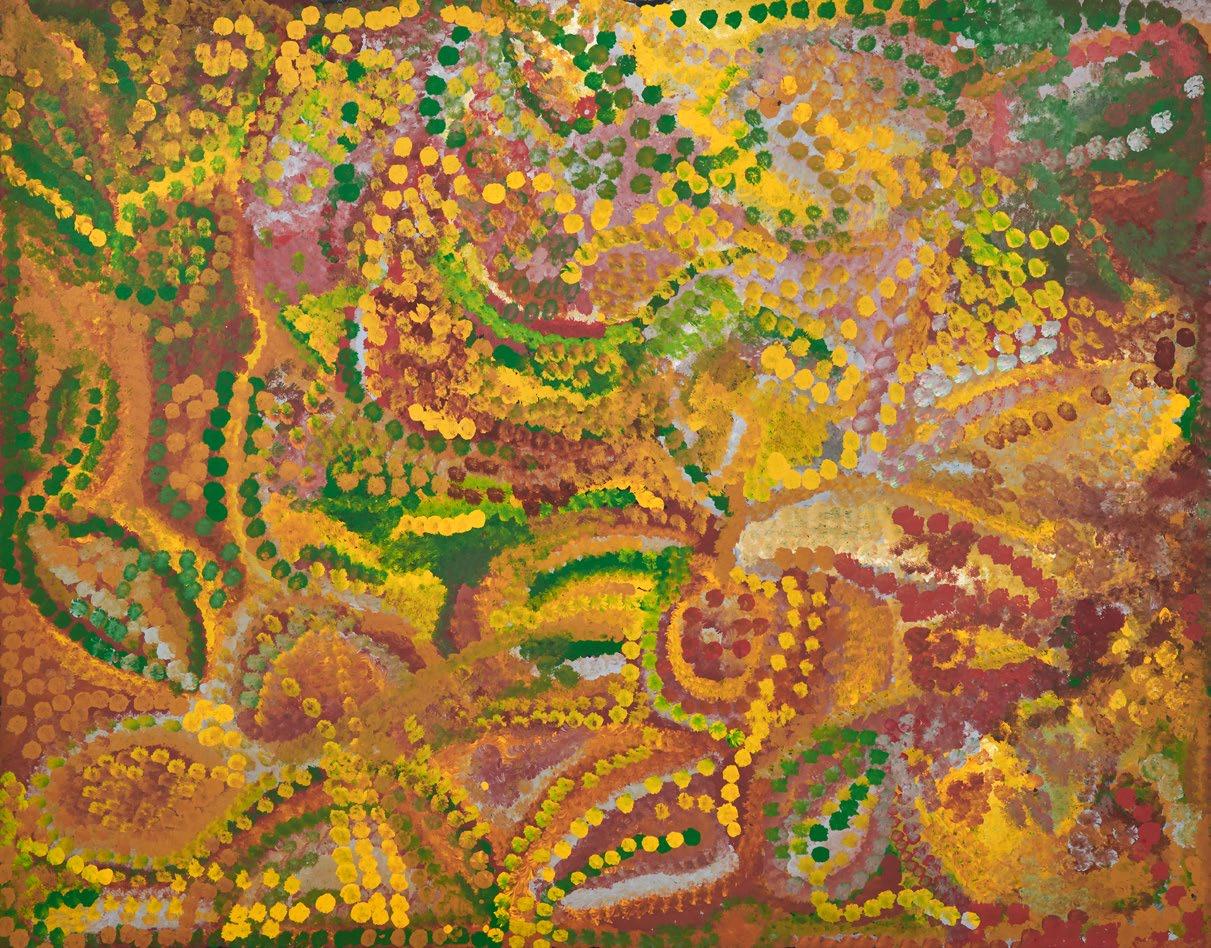
MARINGKA BAKER
AUSTRALIAN, 1952-
Minyma Kutjara Tjukurrpa, 2021
synthetic polymer paint on linen
200 x 150cm
PROVENANCE
Tjungu Palya, South Australia, cat. no. 21-OO5
Vivien Anderson Gallery, Melbourne
Private collection Melbourne
$15,000–20,000
Maringka Baker is a respected senior Pitjantjatjara woman, who lived and worked in the remote community of Kanpi, located approximately 100 kilometres east of the tri-state border of Western Australia, South Australia, and the Northern Territory. She has exhibited and is represented in collections nationally and internationally.
Minyma Kutjara Tjukurrpa (2021) represents the culmination of the artist’s mature period and stands as her largest and most ambitious work. Monumental in both scale and concept, the painting encapsulates a profound articulation of The Minyma Kutjara or Two Sisters Dreaming as they travel across vast tracts of desert country. The elder sister, embodying wisdom and custodial knowledge, guides her younger sibling on a return to their homeland. Having lived with another family near the southern ocean for an extended period, the younger sister hesitates to venture northward into the unfamiliar interior. In an act both maternal and pedagogical, the elder sister carries her upon her back, instructing her in the stories, songs, and significance of the land they traverse. Throughout their journey, the sisters engage in Inma—ceremonial singing and dancing—at sacred rock holes including Punuwara and Irrunytju, before continuing northward toward Docker River. These sites, resonant with ancestral presence, are reimagined within the painting’s rhythmic topography of line and colour. The artist’s use of expansive compositional space and luminous pigment conveys not only the physical vastness of Country but also the metaphysical dimensions of creation and continuity.
Vivien Anderson

A Massim Splash Board and Wave Splitter Trobriand Island, Milne Bay Province, Papua New Guinea, 20th century
Carved from a flat section of wood and painted with white and red pigments. Decorated on one side with a central shaft and mirrored scrolls. Features low-relief curvilinear and anthropomorphic motifs. The central apex figure is said to protect the canoe but may turn against the captain if his seamanship fails. Mounted together on a custom made stand. 78cm height, 74cm wide, 57cm depth
PROVENANCE
Collection Peter Hallinan, field collected in the 1960s
Collection Ian and Marcia Pakes
The carving of splashboards and wave splitters is a key canoe-making skill in the Milne Bay region. Splashboards are mounted transversely at the front and back of the canoe to secure sideboards and deflect water. Splitters are positioned at right angles in front of the splashboards to support them.
$2,000–4,000

16 (Detail)
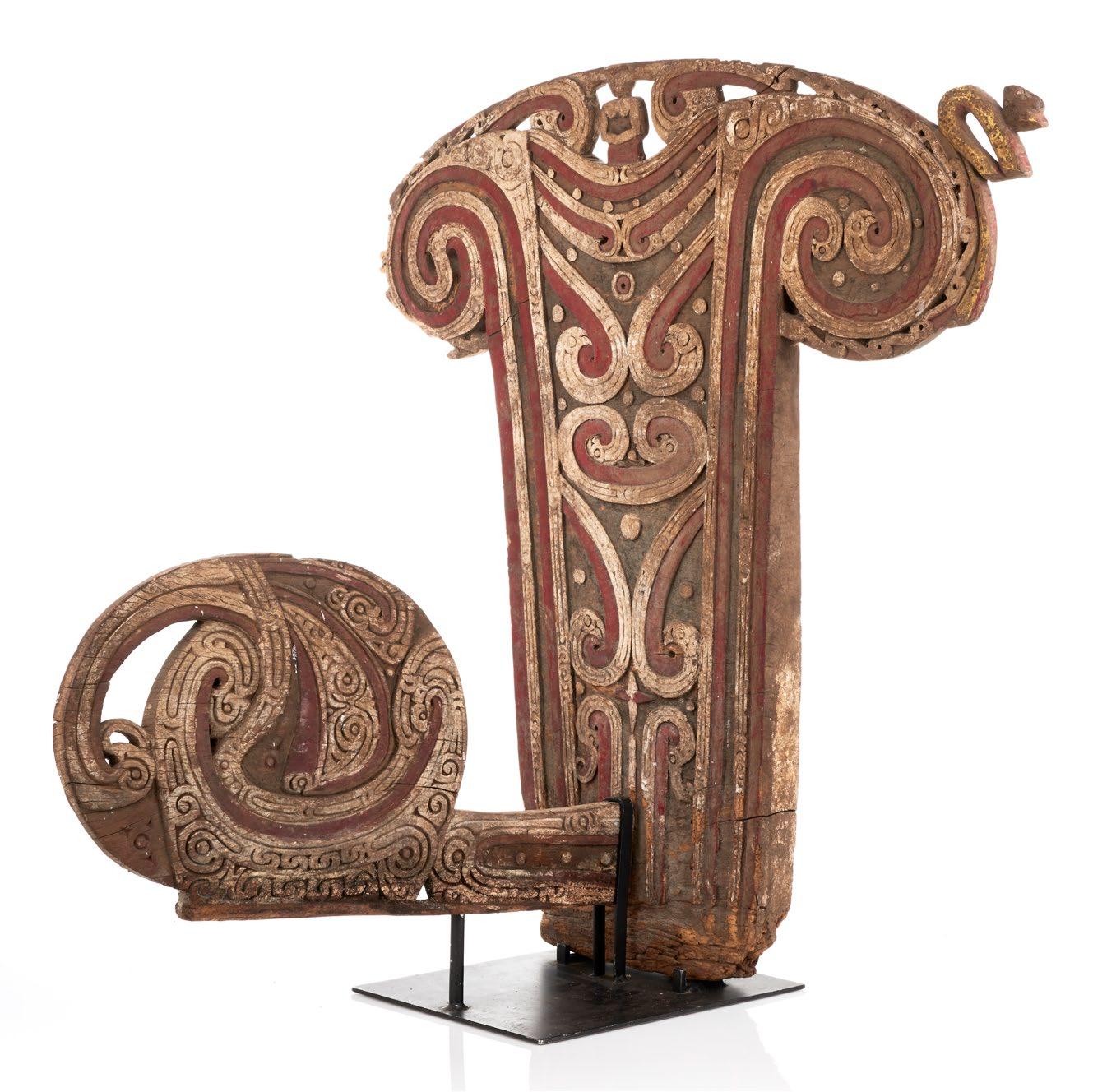
A Massim Vayola Shield
Massim People, Trobriand Islands, Papua New Guinea, 19th century
A rare, decorated war shield reserved for elite warriors. Incised and painted in red ochre, white lime, and black pigment, the design centres on a large oval flanked by birds, topped with rosettes and a crescent motif. The background features repeated rectangular patterns. Convex, oval form widens at the base; original cane handles remain threaded through the center.
74cm length
PROVENANCE
Purchased in the UK
Collection John Graham, Melbourne
$5,000–8,000
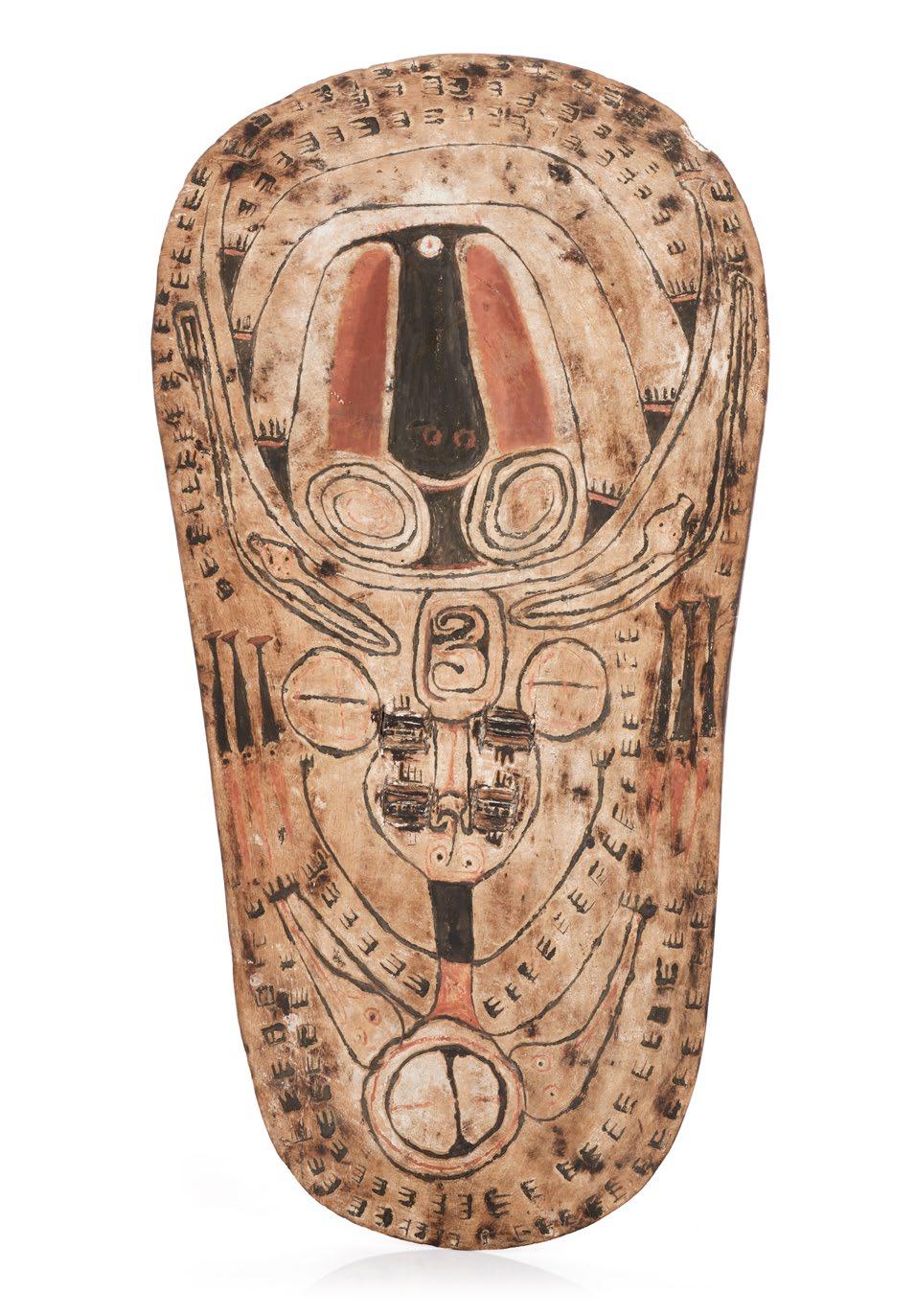
A pair of Male and Female Buka Island Figures
Solomon Islands, 19th to early 20th century
Carved wood standing figures. Carved with the traditional features of a Buka man and woman with domed coiffure and facial scarifications. Probably early trade examples of traditional figures. 55cm, 52cm height
PROVENANCE
Private Collection, U.S.A Collection John Graham, Melbourne
REFERENCE
Blackwood, B. (1933) Both Sides of Buka Passage Oxford: Clarendon Press
$6,500–7,500
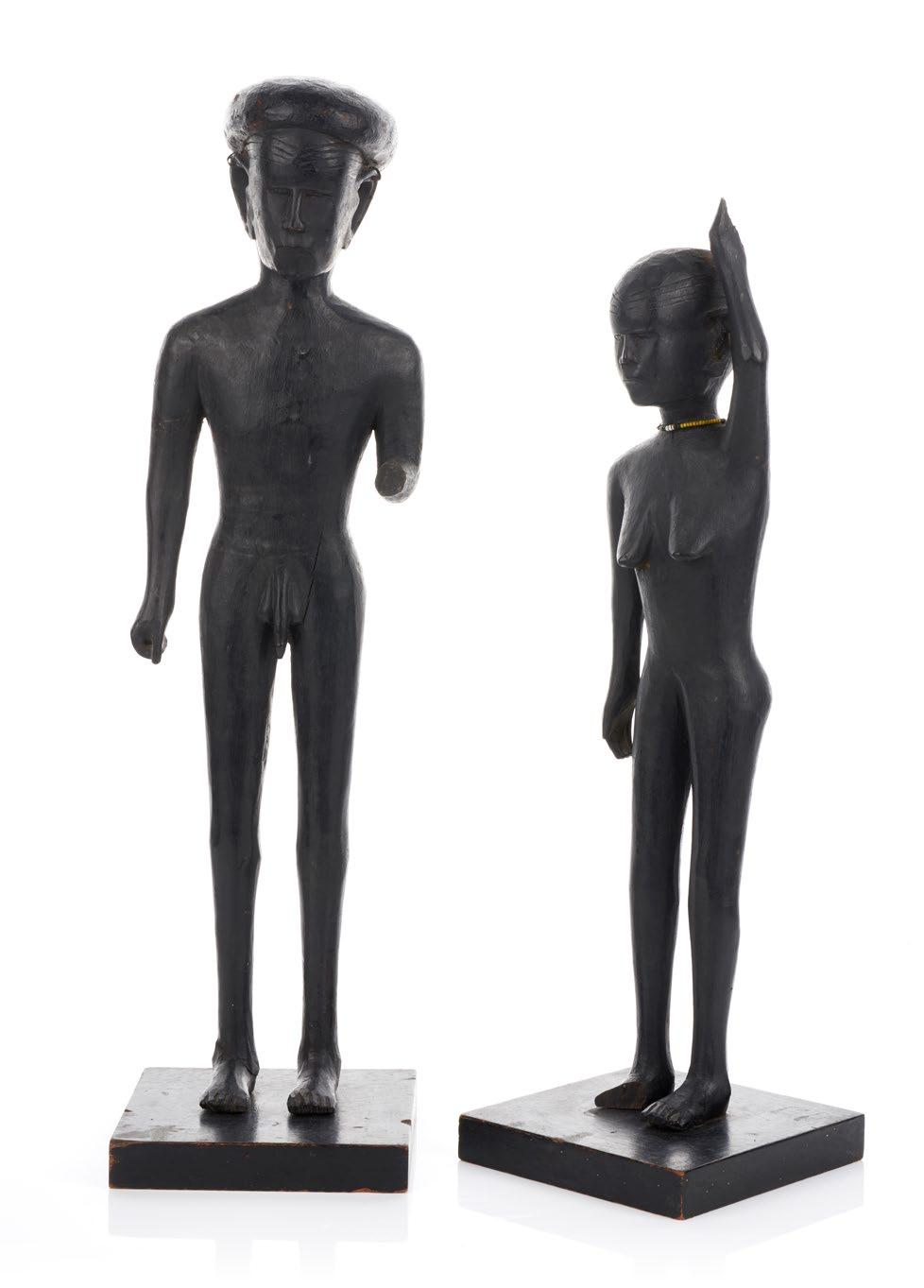
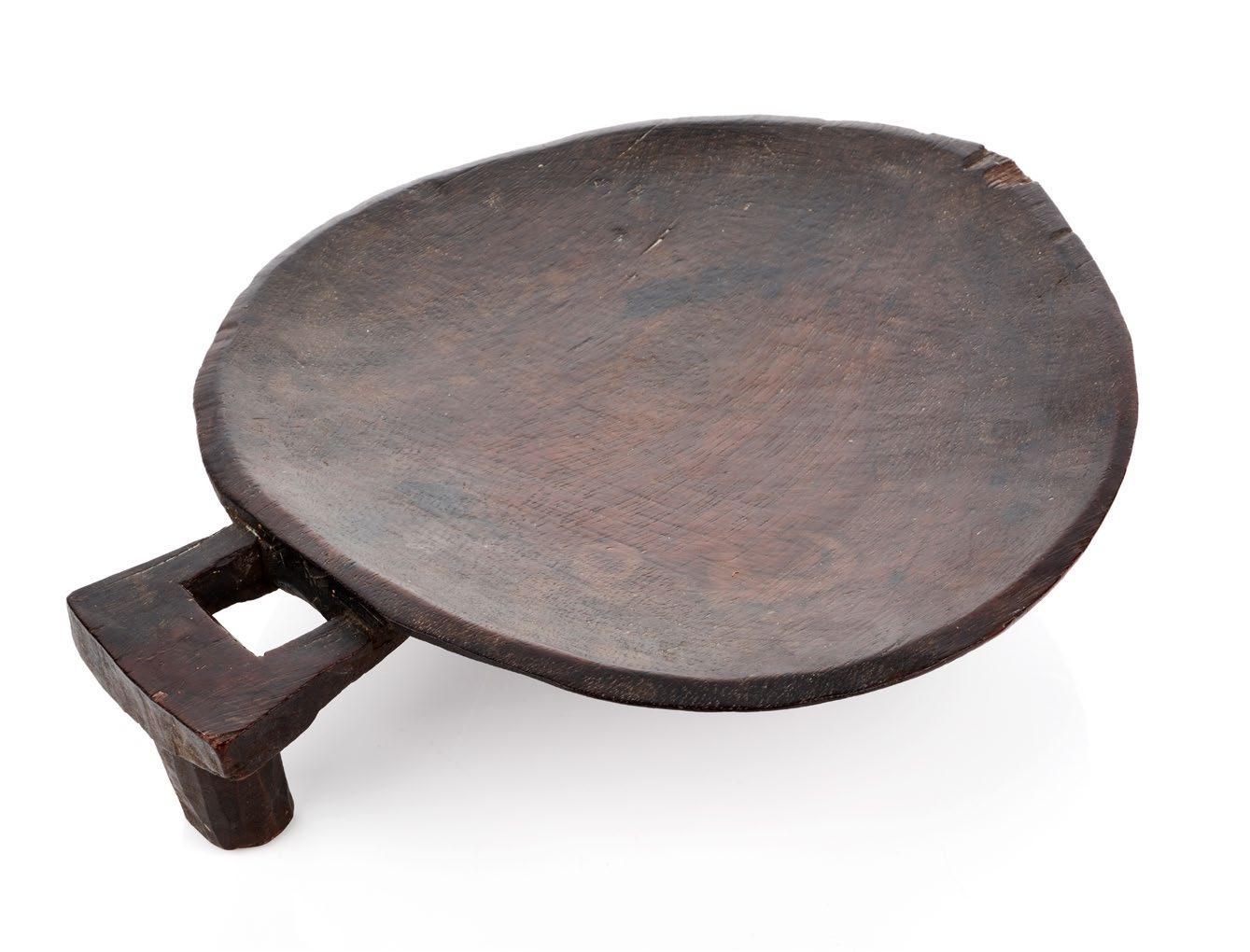
A Good Ritual Oil Dish Fiji, early 19th century
A shallow stone-tooled wooden bowl supported on three short legs. Rich dark patina.
8.5cm height, 35.5cm length, 29cm wide
PROVENANCE
Collection Alex Philips, of Alex Philips Oceanic Art Collection of Robert Bleakley
$2,500–5,000


A Superb Rare Santa Isabel Paddle
Solomon Islands, 19th century
Incised pattern to the grip section with the horizontal shaft handle terminating in two carved naturalistic human heads.
Beautiful rich patina.
151cm length
PROVENANCE
Collection Count Werner D. Schack
Purchased Bruun Rasmussen, November 2012
Private Collection, New South Wales
$4,500–8,000

PETER MARRALWANGA
AUSTRALIAN, 1916-1987
Ngarrbek (Echidna)
natural earth pigments on bark 106 x 50cm
PROVENANCE
Mary Macha, Perth.
Acquired by the current vendor from the above circa 1980s, where it has remained ever since.
$6,000–10,000
Legendary Perth-based art dealer Mary Macha was engaged with Indigenous art for almost fifty years. She played a critical role in the development of Aboriginal art in Western Australia, firstly in the government sector and subsequently as a private dealer. Her clients included Alistair McAlpine (Lord McAlpine) and Robert Holmes a Court. She was the key player in the development of what became known as the East Kimberley School of art and formed a close relationship with many key artists, especially Paddy Jamanji and Rover Thomas.
Peter Marralwanga (1916–1987), also known as Djakku (meaning lefthanded), was one of our greatest bark painters. He was a member of the Kardbam clan of the Bininj people, and spoke the Kuninjku language. In addition to being a ceremonial leader, Marralwanga also helped found the Marrkolidjban outstation near Maningrida in 1972, with the help of artists Yirawala, Mick Mandayngu and Curly Barrkadubu. For most of his life, Marralwanga lived at the remote outstation, but briefly lived at the government settlement at Maningrida.
Born in 1916 in West Arnhem Land in the Northern Territory of Australia, Marralwanga derived influence from Yirawala, a fellow artist and elder from his community. He taught younger artists of his region including his son, Ivan Namirrki, and his nephew, John Mawurndjul. Not only did Marralwanga possess an "intimate first-hand knowledge of the religious geography" of his country (which he passed on to his sons) but he also aided in the technical aspects of painting, sometimes even re-tracing the work of his sons to correct or improve the figuration.
Marralwanga began to paint during his mid 50’s, starting around 1970. Under the guidance of Yirawala, Marralwanga began to incorporate ceremonial items in his works. His later style was further influenced by Yirawala.
In Kuninjku art, much artistic content is sacred, and artists have strict guidelines on what they can depict in their works. Artists who have special roles within a community may receive exclusive rights to paint certain images. Due to his age, he gained permission to incorporate ceremonial elements and knowledge into his work. Through his designs, Marralwanga represented the power of the original ancestral spirits, the Djang. In fact, the designs that these Djang wore on their bodies were first translated to body paintings of indigenous people during ceremony and then served as the inspiration for bark painters such as Peter Marralwanga. He passed his knowledge of rarrk to a new generation of artists and was an inspiration in their works.
Rather than employing one style of cross-hatching (rarrk) Marralwanga innovated and created, using contrasting colours, styles and application techniques to make his works shimmer with life. One such way of achieving this effect would be to visually cram a large ancestral figure within the edges of the bark, so that the "figures' spiritual energy appears to be compressed in physical form... waiting to be unleashed."
Alongside Yirawala, Marralwanga was one of the first Kunwinjku artists to experiment with painting the subject so large that it takes up nearly all of the available bark space. This change brought greater emphasis to the power and movement offered by the rarrk to fill in the painting's subject. Yet, Marralwanga remained true to his ancestral roots even in his experiments; drawing his use of brightly coloured rarrk contrasted with dotted lines directly from body designs that would be painted on during ceremony.
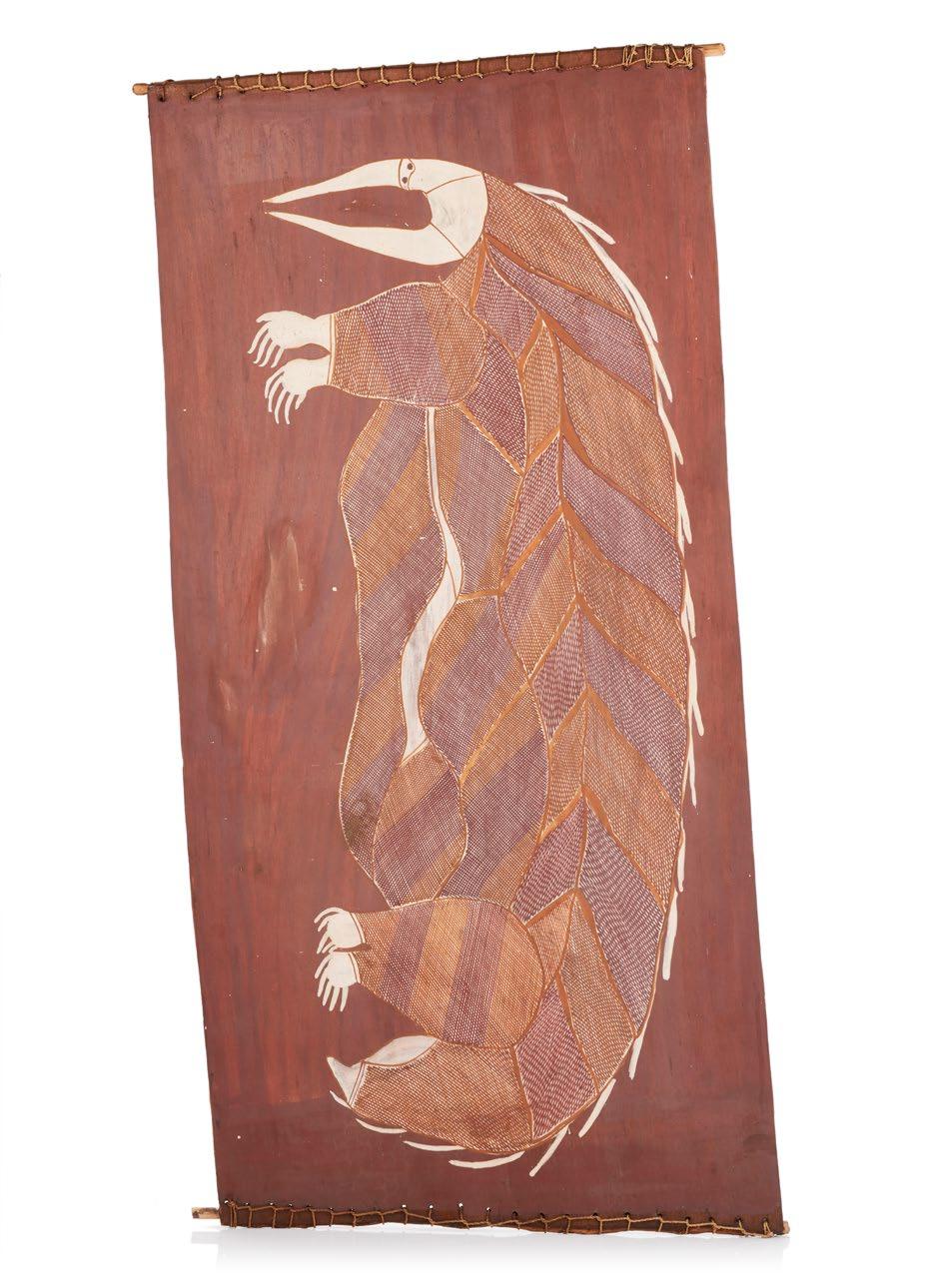
BALANG NAKURULK (JOHN MAWURNDJUL AM)
AUSTRALIAN, 1952-2024
Ngarrbek (Echinda)
natural earth pigments on bark 122 x 40cm irregular PROVENANCE
Maningrida Arts and Crafts cat. no. MAW33/31 Mary Macha, Perth.
Acquired from Mary Macha by the current vendor from the above circa 1980's, where it has remained ever since.
$25,000–35,000
Legendary Perth-based art dealer Mary Macha was engaged with Indigenous art for almost fifty years. She played a critical role in the development of Aboriginal art in Western Australia, firstly in the government sector and subsequently as a private dealer. Her clients included Alistair McAlpine (Lord McAlpine) and Robert Holmes a Court. She was the key player in the development of what became known as the East Kimberley School of art and formed a close relationship with many key artists, especially Paddy Jamanji and Rover Thomas.
Balang Nakurulk-John Mawurndjul AM (1952–2024) was the most highly regarded and recognised of our Australian bark painters.
Balang was born in 1952 in Mumeka, a traditional camping ground for members of the Kurulk clan, on the Mann River, about 50 kilometres south of Maningrida. He was a member of the Kuninjku people of West Arnhem Land, Northern Territory, and grew up immersed in traditional life with extended family, having only occasional contact with non-
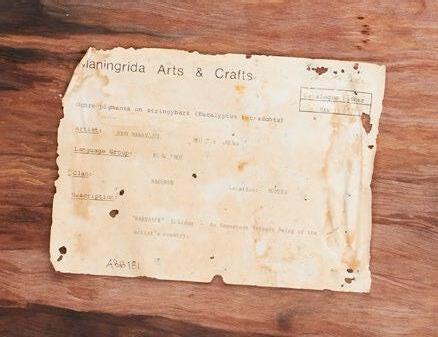
indigenous people and culture. Born in the bush south of Maningrida, Balang based his life on Kurulk clan lands, that stretch between the Liverpool, Mann and Tomkinson Rivers and moved between seasonal camps along these rivers with family. This tract of sparsely populated tropical woodland is some 500 kilometres east of Darwin and accessible only by dirt road during the dry season.
Balang was introduced to ritual painting in 1969 by his father Anchor Kulunba (c. 1920 – 1996). Balang's art practices began through his participation in the Mardayin ceremony, where he learned to paint rarrk on bodies and ceremonial objects. In ensuing years, under the instruction of his older brother Jimmy Njiminjuma (1947-2004) and Peter Marralwanga (1916-1987), he became a proficient bark painter developing expertise unique to this form of practice: the harvesting and preparation of the stringy-bark, cartographic knowledge of sacred ochre deposits and skills to grind, mix and fix their coloured pigments, and the fashioning of sedge rushes into delicate single-strand brushes. Under Njiminjuma's watch, Balang was also introduced to long-established Kuninjku conventions dictating subject matter and its iconography, the characteristics of which have been explored at length by anthropologist Luke Taylor in his pioneering analysis of Western Arnhem Land art. According to Luke Taylor, Balang has played a large role in redefining Kuninjku artistic tradition by incorporating ceremonial motifs into contemporary art.
Growing up during the late 20th century, Balang experienced an era when the government of Australia was beginning to have a greater reach into Arnhem Land; a phenomenon that influenced his art throughout his career.
Balang is known for his exceptional use of ‘rarrk'. which is not simply for decoration, rather, it often makes the viewer feel a little unsure of what they are seeing. The way the lines move and shift, gives the artwork a sense of motion or flickering, which draws people in and makes them observe more deeply. This kind of visual confusion actually connects to how Kuninjku people understand their ceremonies, where not everything is meant to be seen clearly or understood right away. Balang's use of rarrk marked a major turning point in bark painting. Mawurndjul was the first bark painter to successfully challenge the hegemony of the Desert and Kimberley styles within the terms of contemporary.
Balang’s 2018–2019 ground-breaking retrospective at the Museum of Contemporary art, John Mawurndjul: I Am the Old and the New, showcased his innovative use of rarrk (crosshatching) and his focus on sacred sites in Arnhem Land. Critics noted that his work challenges the dichotomy between traditional and contemporary art, positioning him as a pivotal figure in redefining Indigenous Australian art within the global contemporary art scene.
Balang was tutored in rarrk, using fine cross-hatching and infill, in the 1970s by his uncle Peter Marralwanga and elder brother Jimmy Njiminjuma and began producing small paintings on bark. In 1979, Balang began painting for the market, in which much of his work were small bark paintings that depicted animals and spirits, including bambirl (echidna), ngaldadmurrng (saratoga fish), birlmu (large barramundi fish), mimih spirits, yawkyawk and Ngalyod (the Rainbow Serpent). Some of his early inspiration draws from Yirawala, Peter Maralwanga, Midjawmidjaw, Paddy Compass, and other artists.
During the 1980’s he began producing larger and more complex works, and in 1988 he won the Rothmans Foundation Award. 1988 also marked the year in which Balang's worked gained heavy momentum being displayed in many exhibitions in Australia and overseas.
Throughout the 90s, Mawurundjul's work was included in major exhibitions displaying Aboriginal Australian art, most notably, Dreamings in New York (1988), Magiciens de la Terre in Paris, France (1989), Crossroads in Japan (1992), Aratjara: Art of the first Australians in Germany and the UK (1993–1994), and In the heart of Arnhem Land in France (2001).
In 2000, Balang's work was amongst that of eight individual and collaborative groups of Indigenous Australian artists shown in the prestigious Nicholas Hall at the Hermitage Museum in Russia. The exhibition received a positive reception from Russian critics, one of whom wrote: "This is an exhibition of contemporary art, not in the sense that it was done recently, but in that it is cased in the mentality, technology and philosophy of radical art of the most recent times” Also in 2000, his work was featured at the Sydney Biennale.
In 2004, twenty-two of Balang's works were curated by Hetti Perkins in Crossing Country at the Art Gallery of New South Wales in Sydney, in attempts to detach common perception of market engagements with contemporary Aboriginal art, as well the use of bark as a medium. Crossing Country looked at the history of western Arnhem Land's artists and how they communicated and inspired each other.
After completing a major work for Musée du Quai Branly, Balang was recognised by French president, Jacques Chirac, as the 'maestro' at the museum's inauguration. He was also famously photographed in front of the Eiffel Tower in Time magazine.
Many other accolades followed, culminating in 2010, when Balang became a Member of the Order of Australia.
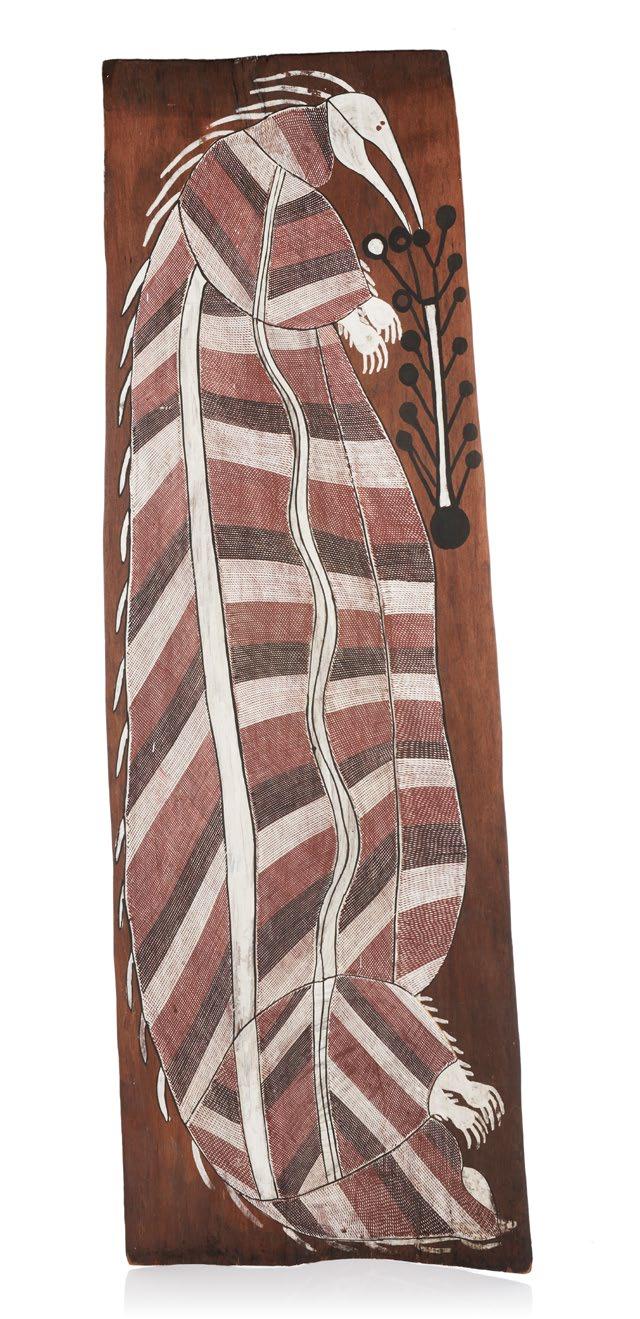

NANDABITTA MAMINYAMANDJA (ATTRIBUTED)
GROOTE EYLANDE, AUSTRALIAN, 1911-1981
Untitled
natural earth pigments on bark
50 x 27cm (irregular)
PROVENANCE
Private collection, America
$2,000–4,000
ARTIST UNKNOWN
GROOTE EYLANDE, AUSTRALIAN, CIRCA 1960s
Macassan Prau
natural earth pigments on bark
25 x 43.5cm (irregular)
PROVENANCE
Acquired Sydney, Mission outlet, early 1960s, by resident of Delmar, New York (John Hotchin)
Private collection, America
$3,000–5,000

BADAYAL LOFTY NADJAMERREK AUSTRALIAN, 1926-2009
Kangaroo and Mimih
natural earth pigments on bark artists name inscribed to verso 117 x 59cm
PROVENANCE
Hogarth Galleries Sydney, 1989.
Rex Irwin Art Dealer Sydney Skin and Bone 2001, cat. no. 36
RELATED WORKS
A related work was sold Sotheby's, Important Aboriginal Art, Melbourne, 07/06/2011, lot no. 131 and four fine works were sold for substantial prices from the Clive Evatt Collection of Aboriginal Bark Paintings and Sculpture, Bonhams Sydney, 24/11/2013.
$4,000–6,000
Throughout his life as a senior artist, ceremony man and traditional knowledge holder, the use of ochre was central to Bardayal ‘Lofty’ Nadjamerrek’s cultural and artistic expression. His palette literally comprised the colours of his country, and his inspiration the stories that created, transverse and embody it. His knowledge of country ran deep. The traditional walking tracks he travelled with his family west and south-west from his mother’s Djordi and father’s Mok clan estates, deep in the escarpment country of Western Arnhem Land in the Northern Territory, were important in maintaining and reinforcing kin relationships. This was also where, among other things, he learned to paint. He made his first rock-art painting at around the age of 13, at a place called Kundjorlomdjorlom, under the watchful eye of his father Nanjorluk, also an accomplished rock-art painter. This large and exquisite wetweather shelter, home to layers and layers of rock art, is located close to Kabulwarnamyo, the family homeland Nadjamerrek established in 2002 while surveying Aboriginal land interests with other senior Western Arnhem Land men in the 1990s.Kabulwarnamyo was of vital importance to Nadjamerrek, rekindling happy childhood memories of growing up on country with his family. Kabulwarnamyo is Ankung Djang (Honey Dreaming) country.
In the late 1950s Nadjamerrek moved with his young family to the Western Arnhem Land community of Oenpelli (Gunbalanya). Here, with a group of senior men, he established Injalak Arts Centre, where artists soon took up painting for the western art market. Nadjamerrek first painted on bark and later worked with paper and print media. His barks shimmered with brilliant white, red and yellow ochres, and his artistic
confidence – both in the scale of his works and his ideas for them –never stopped developing, making him one of the region’s most widely respected artists.
Nadjamerrek made his mark as a master painter using a single parallel line hatching technique not commonly used by Western Arnhem Land artists. The finer his line work, the more exquisite the detail, as seen in his early work Ceremony with women taking part (circa 1970). In this painting, the tightly condensed brushstrokes and intimate line work provide a clear sense of fluid movement, capturing a memory from Nadjamerrek’s youth.
The diversity of Nadjamerrek’s practice is evident not only in his keen interest in exploring new materials and subject matter, but also in the fact that he continued throughout his career to paint on bark and on country. It is rare to visit a rock-art site and know the creator and subject matter of a painting. However, because of the importance Nadjamerrek placed on this practice, and the people who were dedicated to documenting it, we are fortunate to know a number of the rock-art paintings he made on his mother’s Djordi and father’s Mok clan estates throughout the Arnhem Land escarpment country – an area teaming with a multitude of rock-art paintings and their stories. Nadjamerrek continued rock-art painting until 2005, a practice he undertook in the company of close friends and family and dedicated to his grandchildren. His legacy continues to be a source of inspiration for many people in the Western Arnhem Land region.
Keith Munro is Curator, Aboriginal and Torres Strait Islander Programs at the Museum of Contemporary Art Australia, Sydney.

FREDDIE TIMMS
AUSTRALIAN, 1944-2017
Victory Hole, 1998
natural earth pigments and synthetic binder on linen signed, dated and titled verso: F Timms Victory Hole
150.5 x 150cm
PROVENANCE
Watters Gallery, Sydney, cat. no. F.T. 46
The Lowenstein Collection, Melbourne Mossgreen Auctions, The Lowenstein Collection of Modern & Contemporary Australian Art, Melbourne, 07/03/2017, lot no. 61
Private Collection Sydney
LITERATURE
Grishin, Sasha, Accounting for Taste: The Lowenstein's Arts Management Collection, Macmillan Art Publishing, Melbourne, 2013, p. 215 (illustrated)
$15,000–20,000
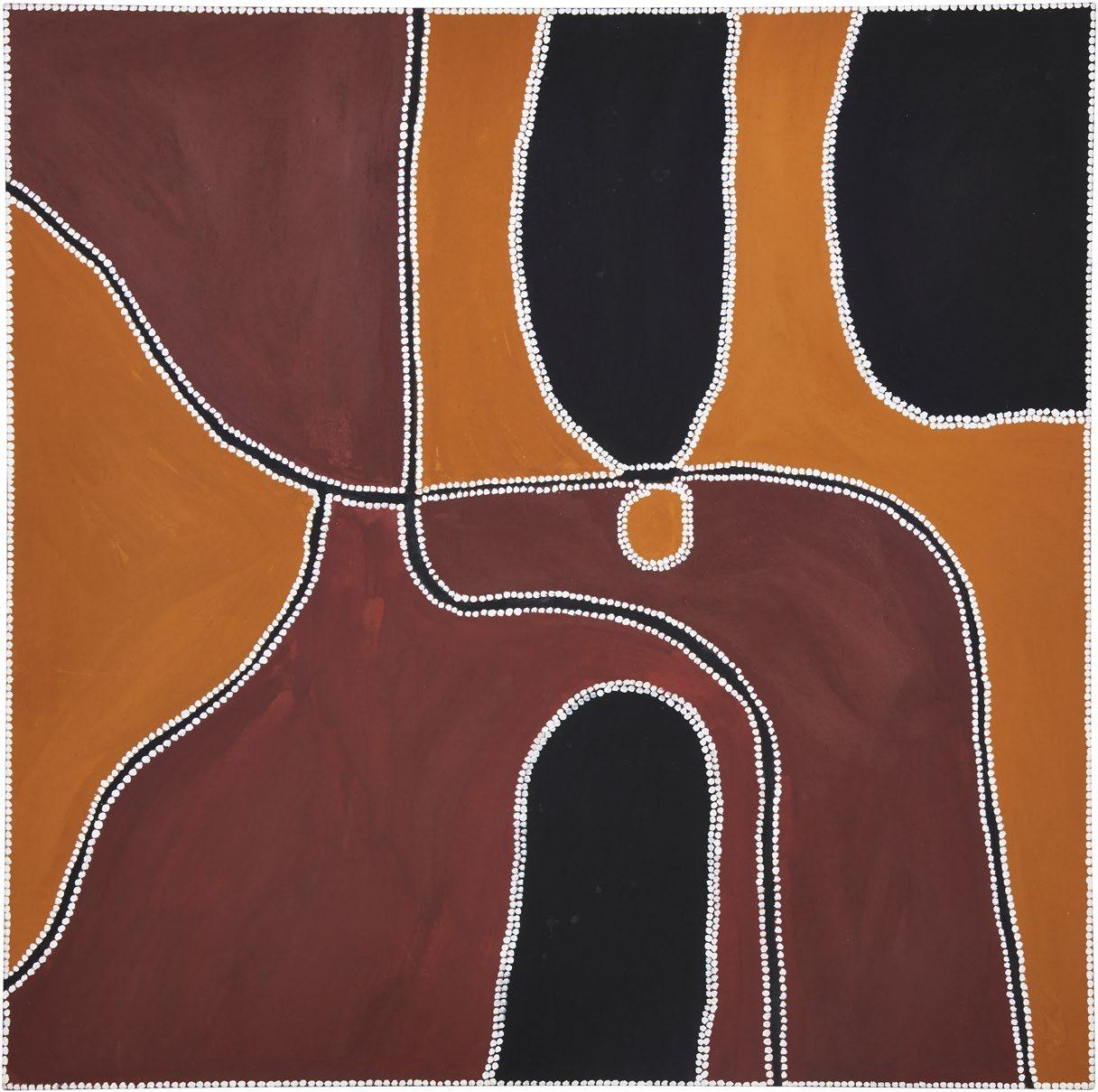
CHARLIE TARARU TJUNGURRAYI
AUSTRALIAN, 1919-1999
Bandicoot Dreaming at Tjiturulnga, 1988
synthetic polymer paint on linen
187 x 96cm
PROVENANCE
Papunya Tula Artists, Alice Springs, cat. no. CT880755
Vivien Anderson Gallery, Melbourne
Private collection Melbourne
$8,000–10,000

BILLY THOMAS JOONGOORRA
AUSTRALIAN, 1920-2012
Waterholes and Sandhills in the Great Sandy Desert, 2001
Synthetic polymer paint on canvas
Inscribed and cat. no. verso: RED ROCK ART. / 08/01 / Billy Thomas / KP1345
80 x 100cm
PROVENANCE
Red Rock Art, Kununurra, Western Australia (accompanied by a Certificate of Authenticity), cat. no. KP1345
The Lady Marsha and Sir Andrew Grimwade CBE Collection, Victoria Gibson's Auctions: Australian and International Art, lot 29, October 2023
Private collection, America
$6,000–8,000
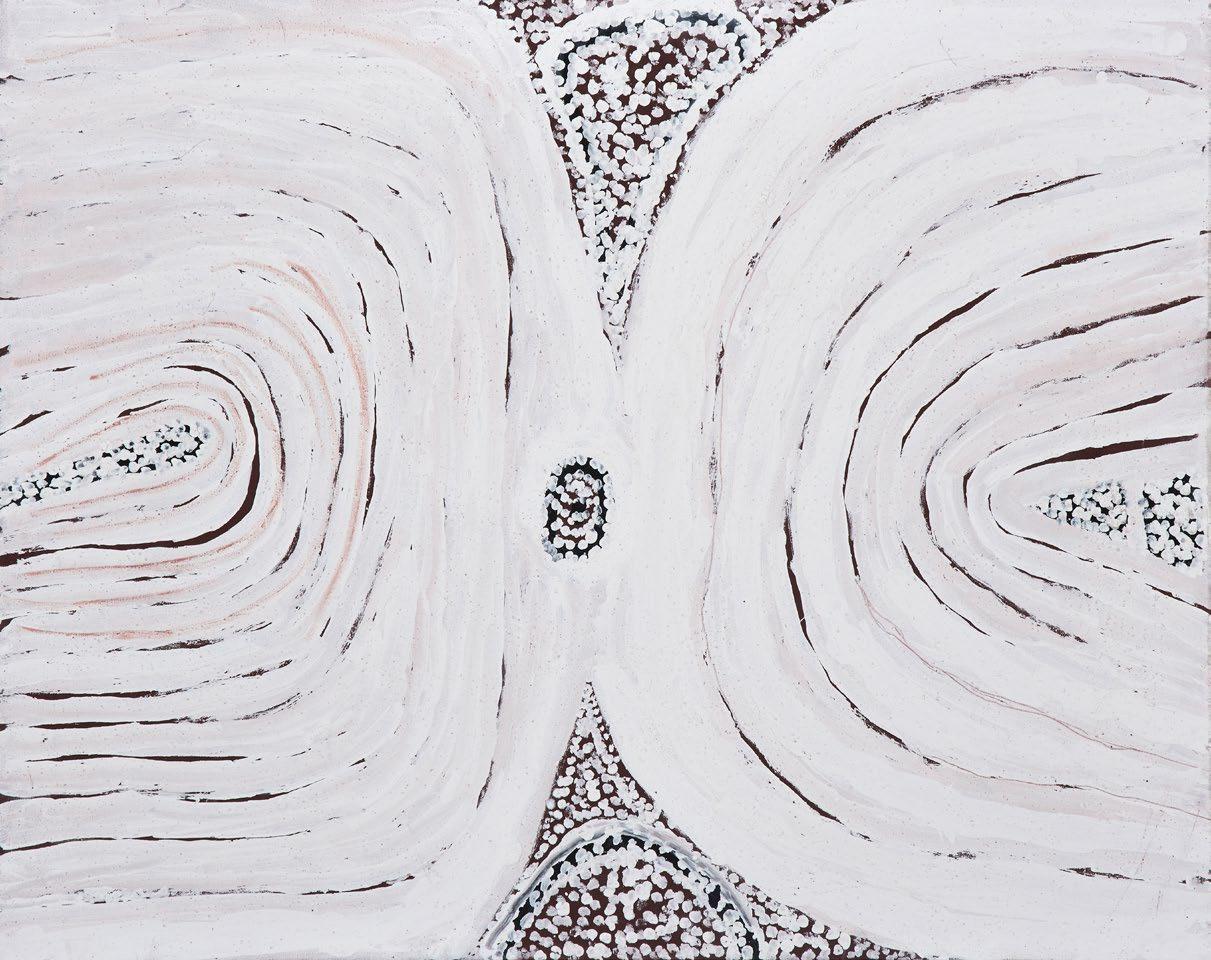
ANAK AGUNG GEDE SORBRAT
BALI, INDONESIA, 1911-1992
Bali, 1978
Masked Balinese Dancers
oil on canvas laid down on card.
signed indistinctly a a gede, Ubud, Bali 78 46 x 41cm
PROVENANCE
Collected by the artist and photographer Theo Schoon in Bali in 1980.
Collection Ron Brownson, Auckland
$4,000–8,000
Born in 1912 to an aristocratic family from Padangtegal in Ubud, Bali, Anak Agung Gede Sobrat’s love of art began as a child watching shadow puppet shows (wayang kulit), and traditional sacred dances from village temples. Through his grandfather (who was a renowned puppeteer), he learned about decorating and cutting wayang puppets, illustrating the Mahabharata and the Ramayana— two of the most important Sanskrit Hindu epics of ancient India.
Sobrat was one of the first artists who studied under Russian-born German primitivist artist Walter Spies and Dutch artist Rudolf Bonnet, both who lived and worked in Bali, Indonesia. He was inspired by the artworks they created in regards to composition and the aesthetic interpretation of telling stories. Sobrat was captivated with Spies style of magic realism and use of light in his paintings, further learning about portraiture from Bonnet.
Joining the Pita Maha group— an association for artists in Bali to modernise and popularise Balinese art, Sobrat was one of the earliest Balinese artists adding western art aesthetics to his paintings, depicting scenes and subject matters in his own unique way. He’s best known for painting the nature rich, lush greenery and buoyant life on the island. Market scenes, village activities and Balinese dances all capture the essence of the subject's presence through space and time.

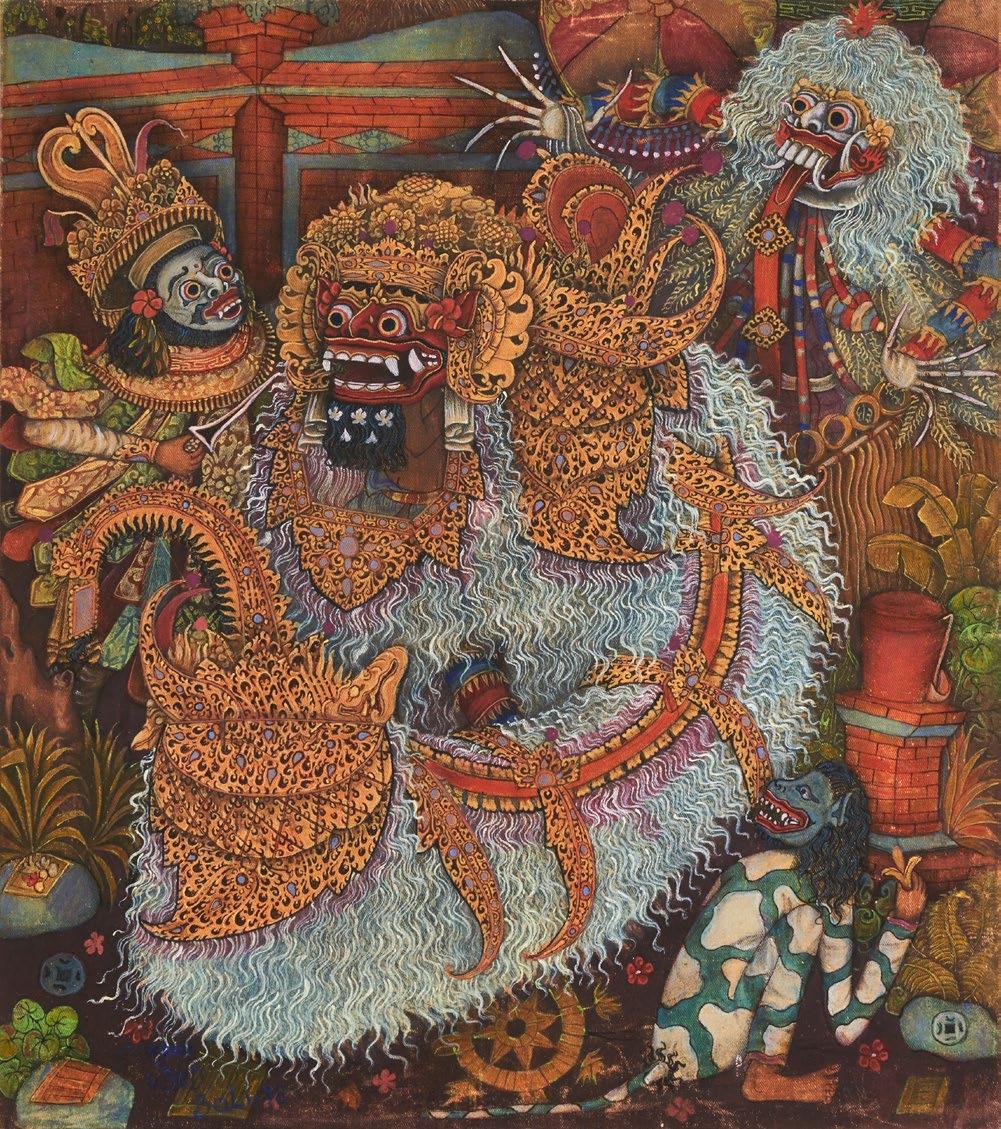
A fine and rare Chief's Stool, No'oanga Aitu Island, Cook Islands, 19th century
Finely carved from a single piece of hardwood with a curved top raised on anthropomorphic legs terminating in spade shaped feet.
47cm wide, 17cm height, 22cm depth
PROVENANCE
Purchased Cordys Auctions, Auckland 1998 Collection Ron Brownson
$5,000–10,000
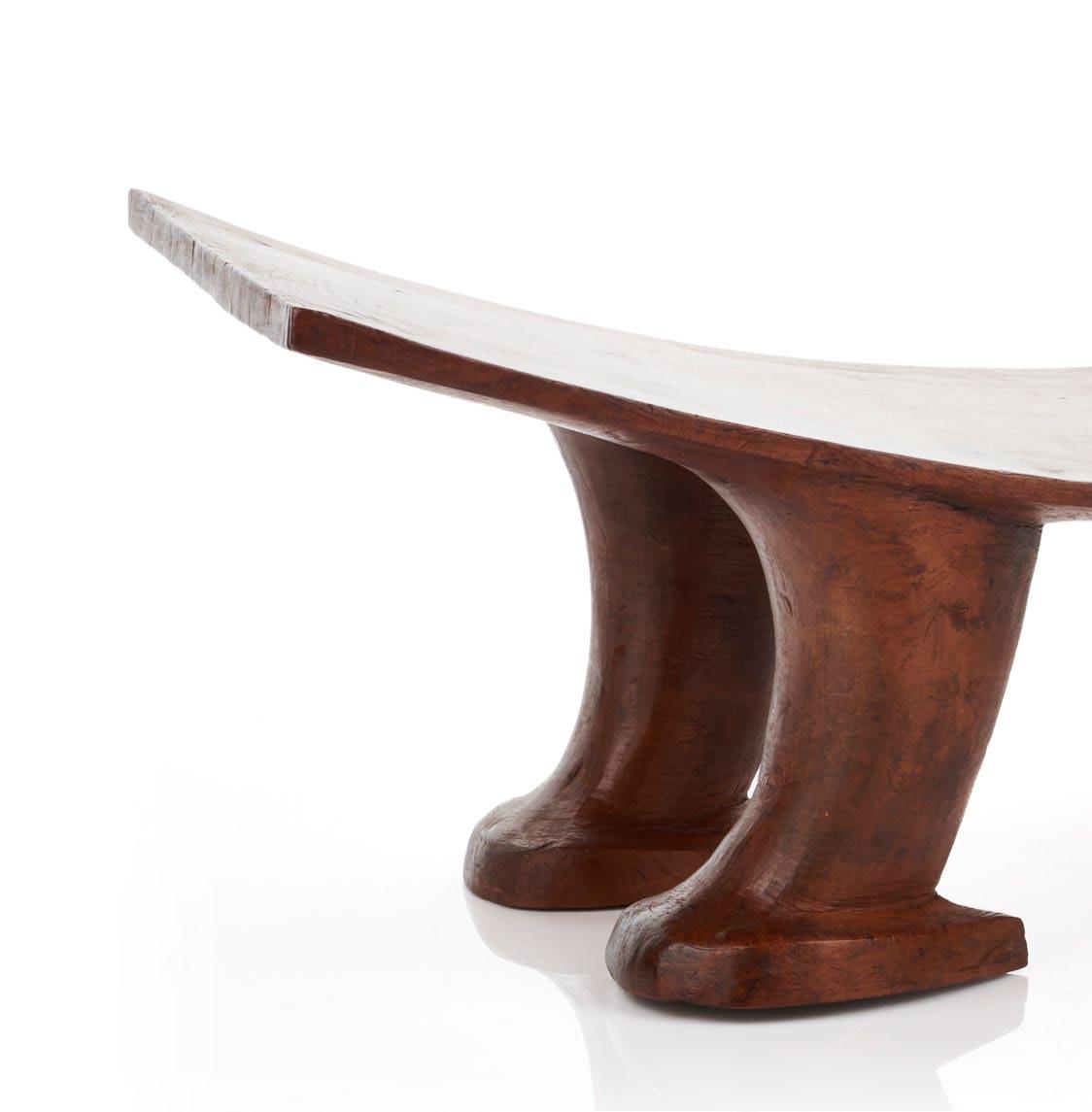
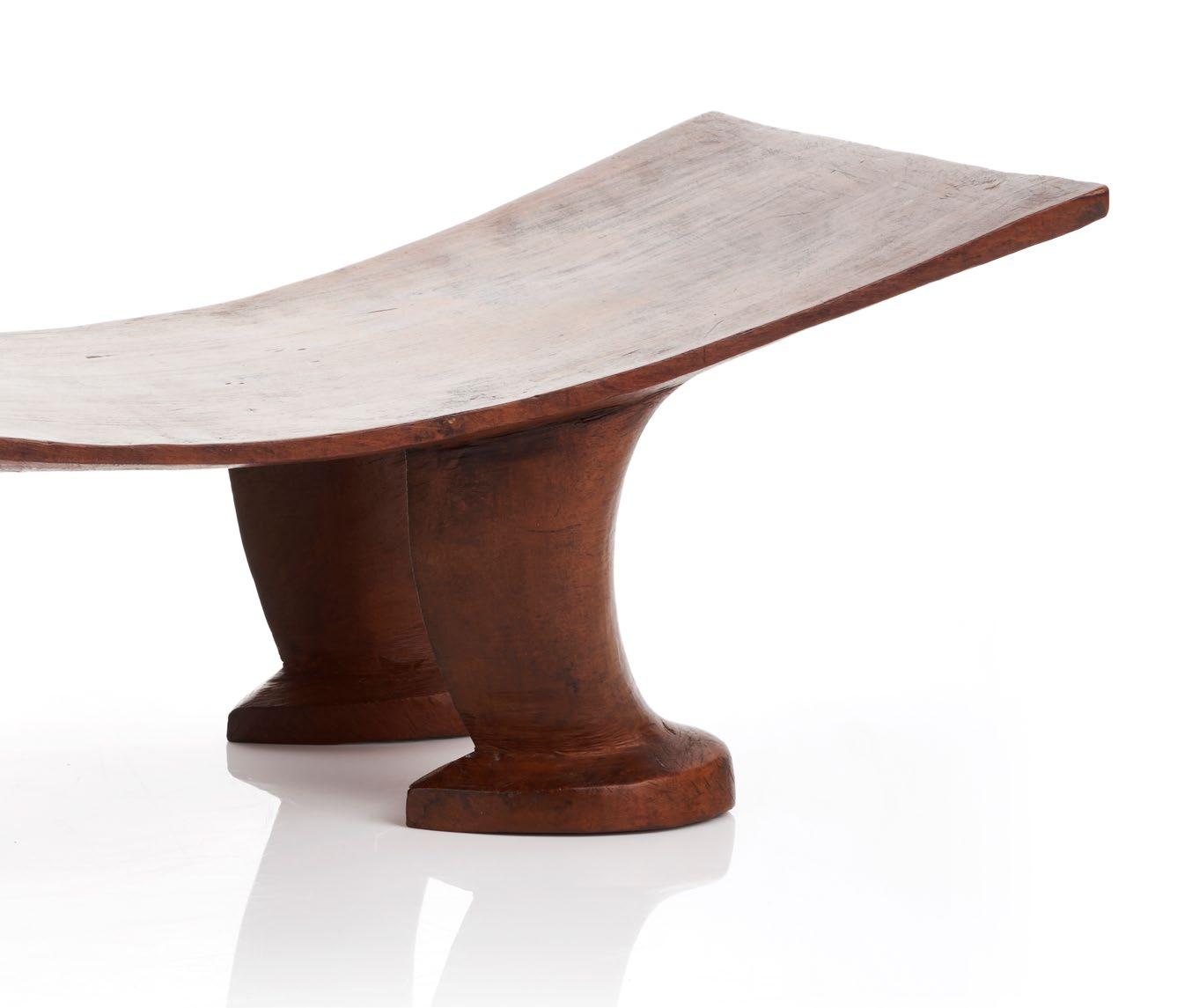

A Good Ewa Aripa Figure
Korewori River, Middle Sepik region, Papua New Guinea, 19th century or earlier
Carved wood with traces of original pigment remaining. Raised on a single leg with naturalistic head. 113cm height, 22cm wide
PROVENANCE
Peter Hallinan Collection, field collected in the 1960s Ian and Marcia Pakes Collection.
REFERENCE
Sotheby’s, The Peter Hallinan Collection of Melanesian Art, Auction catalogue. London: Sotheby’s, 7 December 1992.
$8,000–16,000
Legacy and Provenance
The Collections of Ian & Marcia Pakes and Peter Hallinan
This auction, together with its accompanying timed sale, offers collectors a rare opportunity to acquire works from two of Australia’s respected sources of ethnographic art: the private collection of Ian and Marcia Pakes—founders of the influential Collectors Gallery in South Yarra and select pieces from the esteemed Oceanic art dealer and field collector, Peter Hallinan, drawn from the Pakes’ personal collection.
From 1979 to 1993, the Collectors Gallery was a cornerstone of Melbourne’s cultural landscape, a seminal gallery dealing in ethnographic art. Under the stewardship of the Pakes, the gallery hosted quarterly exhibitions that drew a dedicated following and critical acclaim, including regular features in The Age newspaper. The gallery’s scope was global and discerning: textiles, ritual objects, and ethnographic works from Africa, the Swat and Chitral valleys of northern AfghanistanPakistan, Melanesia, India, Nepal, Tibet, Bali, the Philippines, and the broader Indonesian Archipelago. Rugs and kilims from Turkey, Iran, and Afghanistan added further depth. Ian Pakes travelled extensively, forging relationships with collectors and gallery owners across Australia, and bringing rare and authentic works to Melbourne audiences. Every item was selected with care, always with age or antique, always genuine and accompanied by rich documentation from knowledgeable exhibitors. Among these, one name stands out - Peter Hallinan. Hallinan worked closely with the Pakes, holding regular exhibitions at their gallery. Hallinan was a pioneering figure in the field of Oceanic art. He was both idiosyncratic and deeply learned, a dealer whose deep fieldwork and connoisseurship helped shape global appreciation of Melanesian material culture. His early fascination with ethnographic collections at the Field Museum in Chicago led him to Australia in the early 1960s, where he immersed himself in the cultures of the Pacific. After a brief stint in Sydney’s advertising world, Hallinan retreated to the Gold Coast and in 1968 founded the Tribal Arts Gallery in Broadbeach with Joan Dansey
and John Valilio. The gallery quickly became a sanctuary for collectors and scholars, offering museum-quality works and fostering a deeper understanding of Oceanic traditions.
Over the course of 25 years, Hallinan undertook 26 expeditions to Papua New Guinea, living among communities, documenting rituals, and collecting with an eye for cultural integrity. His life was marked by paradox: a public figure in the art world who craved solitude, a dealer who eschewed commercialism in favour of cultural stewardship. Frequently he would spend weeks travelling to small obscure villages retrieving examples and on information on art forms that little was known about. There were trips to the remote regions of Milne Bay, the Dampier and Vitaz Straits. On one eleven-month trip he retrieved an important Kula canoe from the Trobriand Islands and then oversaw its delivery to the South Australian Museum.
Field collecting offers a solitude that is not isolation, but immersion, a way of being alone while profoundly attuned to land, lineage, and the quiet rhythms of village life. For Peter Hallinan, each expedition into the remote regions of Papua New Guinea was a kind of pilgrimage. Freed from the distractions of commerce and crowd, he entered a space of listening, observing, and absorbing, where culture revealed itself. In such silence, tribal objects speak. A lime spatula, a cave figure, a Massim betel nut container, each becomes an interlocutor, bearing the imprint of ritual use and ancestral memory. These were not mere acquisitions; they were companions in a private dialogue with cultural tradition. Hallinan’s legacy was crystallized in the landmark Sotheby’s London auction of 1992, which unveiled the depth of his vision and the breadth of his collecting ethos. Included in this auction are important works from Hallinan’s collection, notably a rare Papua New Guinea cave figure (Aripa) field-collected in the 1960s, a testament to his immersive approach and commitment to provenance. Together with the Pakes collection, these works offer collectors a rare chance to acquire pieces of exceptional authenticity, each bearing the imprint of curatorial care and cultural respect. Among the most enigmatic and spiritually charged sculptural traditions of the Sepik region are the aripa figures of the Inyai-Ewa people, who inhabit the upper reaches of the Korewori River, a remote tributary winding through the dense forests of Papua New Guinea. Such figures were once housed in the men’s ceremonial house where they served as guardians, hunting allies, and repositories of ancestral knowledge. Upon the death of their owner, they were often relocated to rock shelters. Field collected by Peter Hallinan in the 1960s, this figure was reportedly relocated and stored in a cave. According to accounts shared with Ian and Marcia Pakes, Hallinan made two unsuccessful attempts to retrieve the figure due to elevated water levels obstructing the cave entrance. On his third visit, conditions permitted access, and he successfully recovered the object. It remained in his personal collection until its subsequent sale to the Pakes.
James Parkinson
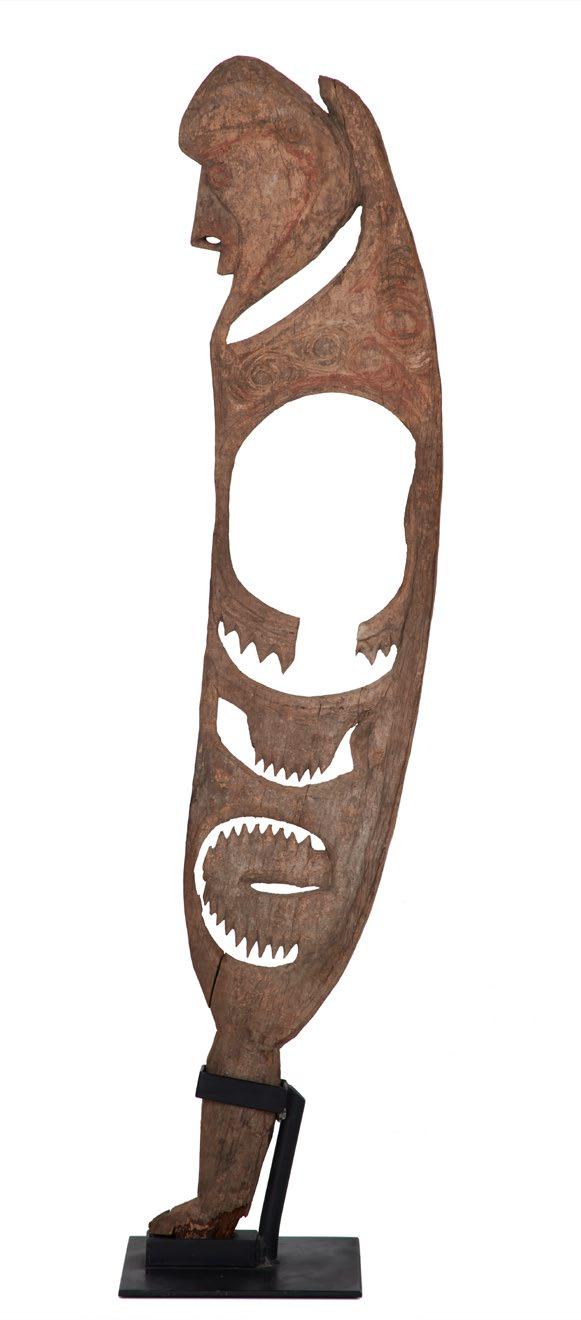

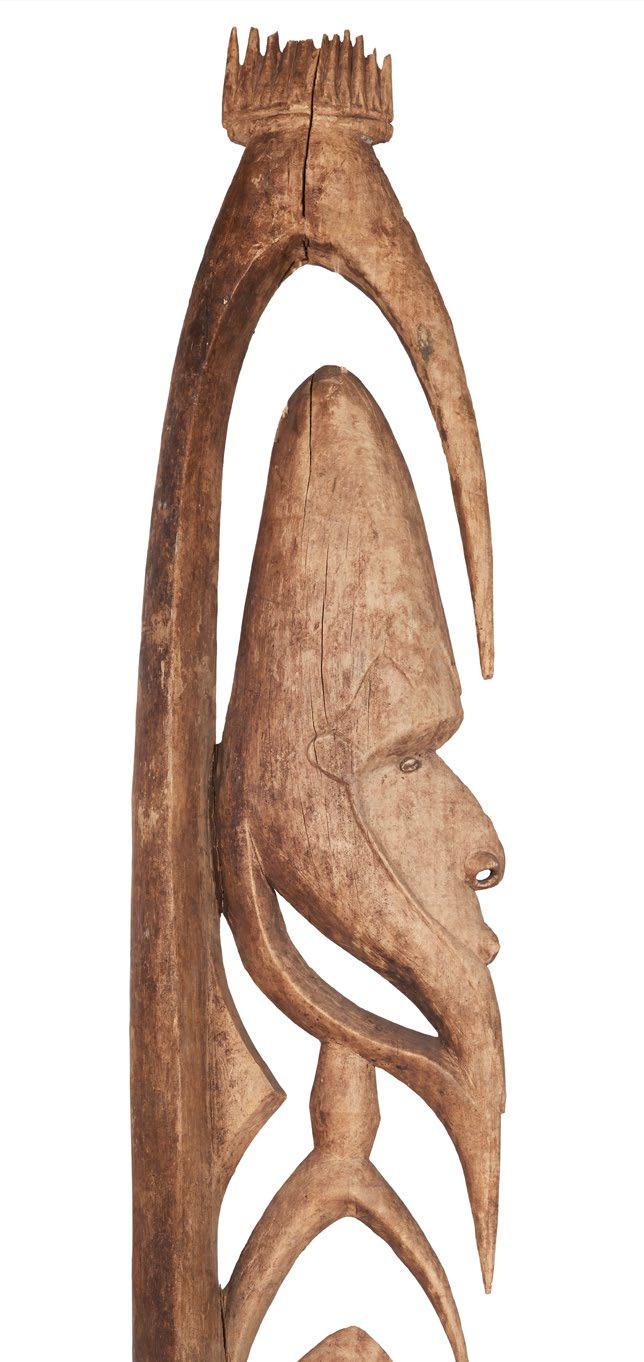
A Rare and Important Yipwon Figure
Korewori River, East Sepik Province, Papua New Guinea, 19th century
This impressive figure, monumental in scale and presence, has been carved from a single block of hardwood. The head features a beard terminating in a sharp point. Above the head a pointed projection issues from the curved back which protects the sculptural framework. The torso area with six semicircular shapes carved in concentric patterns surrounding and protecting a central phallic projection. The figure raised on a single leg supported un-typically on two feet. 248cm height, 30cm depth
PROVENANCE
Collection Wayne Heathcote, Brussels / New York / London. Field collected in the 1960s
Purchased directly from the above, 1973
Collection James Fairfax
Purchased Leonard Joels, Fairfax estate auction, 2017 Private Collection, Melbourne
REFERENCE
A similar example, most likely by the same carver and also field collected by Wayne Heathcote, sold at Sotheby's Lot 44, Sotheby's, New York — Nov 22, 2021
The Blue Horizon: Pacific Art from an Important Maui Collection
Sold: $58,000 Australian dollars
Another similar example, dated to the mid-19th century held in the collection of the Denver Art Museum.
$25,000–45,000
In ceremonial life, Yipwon figures were housed in the men's cult house (haus tambaran) and activated through offerings and invocation. Their spirits were summoned to weaken the life force of game animals or adversaries, ensuring success in hunting and warfare. The hooks, representing ribs and internal organs, served as conduits for this spiritual energy.
This exceptional example was field collected by Wayne Heathcote in the late 1960s and sold directly to James Fairfax in 1973. Fairfax was a renowned Australian company director, philanthropist, and connoisseur and a passionate collector of Australian art and European old masters. He was a generous patron of the Art Gallery of New South Wales and the National Gallery of Australia. The Yipwon remained in James Fairfax's personal collection until his passing in 2017, a lasting testament to its profound cultural resonance and the esteem in which it was held by one of Australia's most discerning collectors.

A Pair of Standing Bulul Guardian Figures (Tinagtaggu)
Kababuyan Ifugao People, Philippine Islands, 19th to early 20th century
58cm, 61cm height
PROVENANCE
Collection Floy Quintos, Manila
Collection Hiro Kabayashi, Japan
Collection John Graham, Melbourne
Anthropomorphic carved wood figures used to guard the rice crop of the Ifugao people (and their sub-tribe Kalanguya) of northern Luzon.
$6,500–8,000

TJUMPO TJAPANANGKA
AUSTRALIAN, 1929-2007
Men's Law Painting – the Great Sandy Desert, 1998
acrylic on Belgian linen
120 x 79.5cm
PROVENANCE
Warlayirti Artists, WA, Balgo Hills, Western Australia, cat. no. 315/98, Gallery Gondwana, Northern Territory, cat. no. 3957TT
Private Collection, Northern Territory
Cooee Gallery Indigenous Art Auction, lot 82, October 2022
Private collection, America
$6,000–8,000
At the time of his passing, Tjumpo Tjapanangka was regarded as Balgo's most esteemed male artist and the community's leading Law Man. Both his artwork and personal presence radiated a lively, animated spirit. This vibrant energy and confidence shaped the resonant planes that define his most acclaimed pieces. In his paintings, the orange circles symbolise living water—permanent water sources where rainwater collects before seeping back into the sand. The sweeping forms of the tali, or sand dunes, dominate the landscape, holding deep personal significance for Tjumpo, as several family members, including his uncle, lost their lives at this very place.
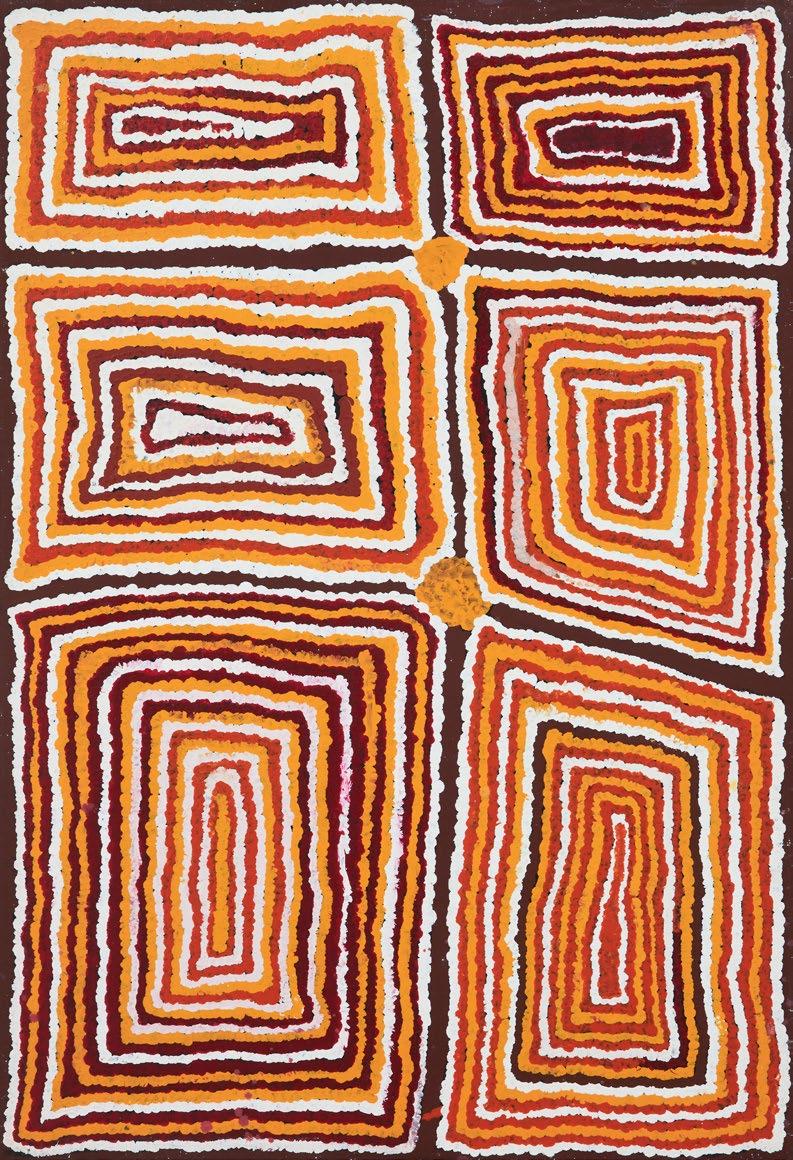
YARITJI YOUNG
AUSTRALIAN, 1956
Tjala Tjukurpa, Honey ant story, 2015
synthetic polymer paint on canvas 151 x 121cm
PROVENANCE
Tjala Arts, Anangu Pitjantjatjara Yankunytjatjara (APY) Lands, cat. no. 414-15
Private collection, Melbourne
$8,000–12,000
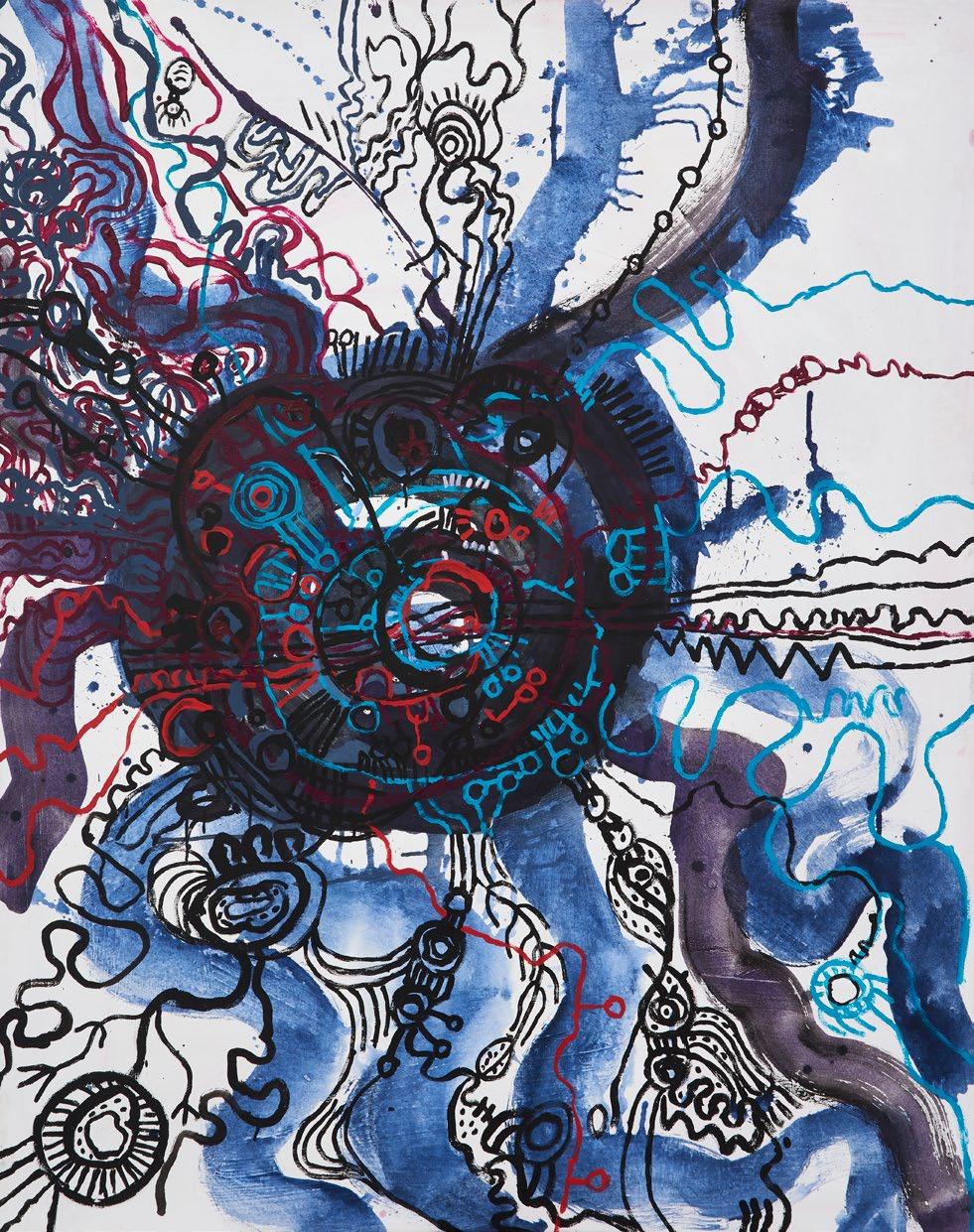
ROSALIND TJANYARI
AUSTRALIAN, 1971Ngura, 2021
acrylic on linen
152 x 198cm
PROVENANCE
Iwantja Arts, Anangu Pitjantjatjara Yankunytjatjara (APY) Lands, cat. no. 164-21
Everywhen Art, Shoreham, Victoria Private collection, America
$4,000–6,000
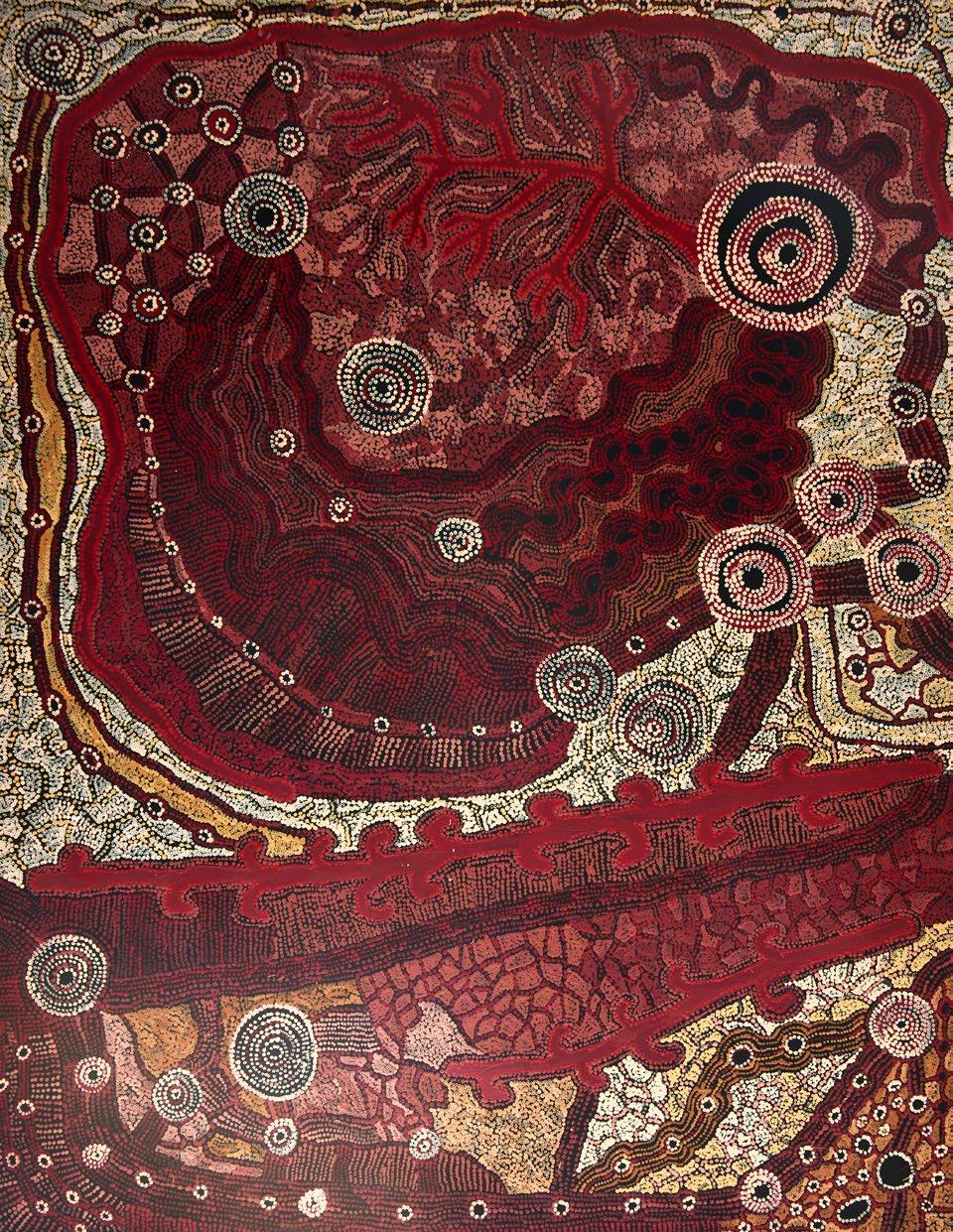
JIMMY YANYATARI DONEGAN
AUSTRALIAN, 1940-2022
Pulkara, 2005
Synthetic polymer paint on linen 149 x 100cm
PROVENANCE
Papulankutja Artists/Blackstone, Western Australia, cat. no. 05-980
Marshall Arts, Adelaide
Corrigan Art Collection, Sydney
Cooee Art, Australian Fine Art Auction, lot 91, June 8, 2021 Private collection, America
PUBLISHED
McCulloch's Encyclopaedia of Australian Art, Australian Art Editions and The Miegunyah Press, Melbourne, University Publishing, 2006 p. 129 (illus.)
$4,000–6,000
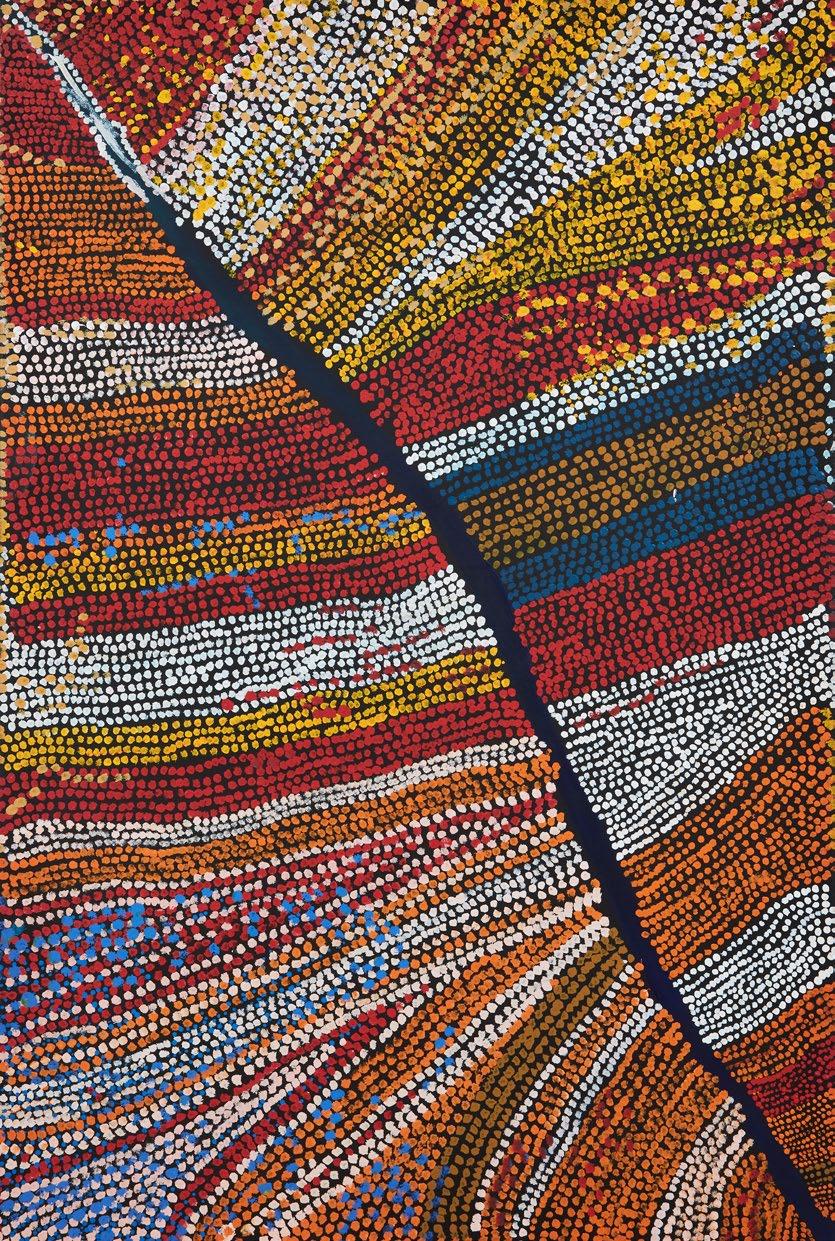
BETTY KUNTIWA PUMANI AUSTRALIAN, 1963
Antara, 2012
synthetic polymer paint on canvas
182.5 x 120cm
PROVENANCE
Mimili Maku Arts, Northern Territory, cat. no. 150-2012
Private collection, Melbourne
$6,000–8,000

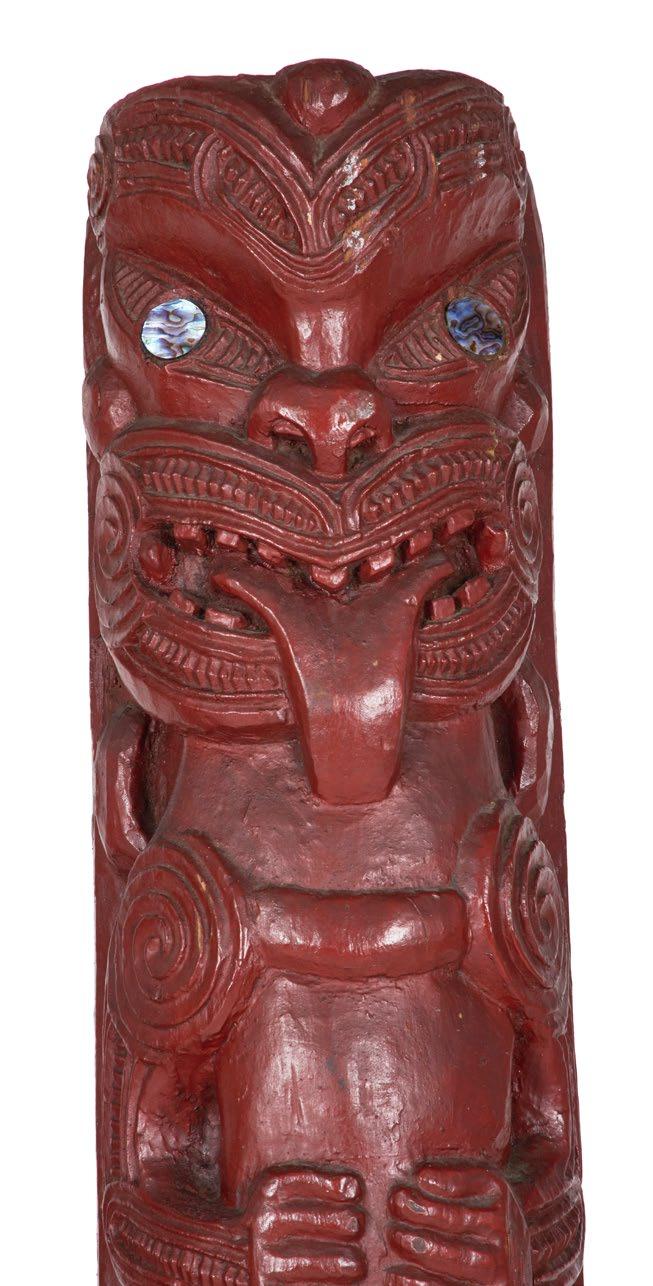
A good pair of Poupou Posts
Māori, Aotearoa, New Zealand, early 20th century
Each carved in high relief with three ancestral wheku figures with protruding tongues and cut paua shell disc eyes. Each figure with hands clasped to the abdomen and knees together with feet turned in. The bodies decorated with rauponga and takarangi spirals. Red ochre painted finish. Probably from a wharenui (meeting house) in the Whanganui region of New Zealand.
207cm height, 20cm wide
PROVENANCE
Collection Todd Barlin, Sydney
$30,000–40,000
(Detail)


A Superb Pre-European Hei Tiki
Māori, Aotearoa, New Zealand, 18th century or earlier
A finely carved type I hei tiki carved in exquisite translucent inanga variety stone. The head features widely recessed double ringed with eyes with clear surmounting eyebrow markings, a detailed nasal bridge, and heart shaped mouth with tongue. The body is symmetrical with delineated neck and ribs carved to the torso, the three fingered hands resting on thighs. Broken out stoned-drilled concealed suspension hole to the back of the head.
7cm length, 4.5cm wide
PROVENANCE
Collection George Withers (1946 - 2023), United Kingdom Purchased Dore & Rees, Somerset, United Kingdom, 22 Feb 2024. Lot 1346
Private Collection, New South Wales
REFERENCE
Austin, Dougal. (2019). Te hei tiki: An enduring treasure in a cultural continuum. Wellington, New Zealand: Te Papa Press. Epstein, J., Bassani, E., & McLeod, D. M. (1989).
Jacob Epstein: Collector. Associazione Poro. Webster, K. Athol. (1948). The Armytage collection of Māori jade Photography by John Queenborough. London: Cable Press.
$20,000–30,000
The Journey of Hei Tiki: Artistry, Ancestry, and the Global Collector’s Eye Māori personal adornments take a wide variety of treasured forms. But it would be hard to overstate the significance of the highly esteemed and culturally iconic human-figure pendants called hei tiki. Today these prized pendants are enjoying a resurgence in popularity, highlighting the rich and complex cultural continuum of their meaning and the history of their wearers and makers. In this catalogue, we offer part II of largest most significant early hei tiki collection to come to market since the Kenneth Webster Collection in 2002.
Hei tiki is a generic word used by Māori to describe human images carved in bone, stone, or wood to be worn as neck ornaments. The abbreviated “Tiki” was an early expression of humanity used as an accolade to designate persons of high birth. During the late eighteenth and early nineteenth centuries hei tiki were mostly observed to be worn by Māori men. However, by the late nineteenth century, due to the drastic decline in the Māori population as a result of impoverishment due to loss of land and introduced diseases, wearing hei tiki was more often the preserve of Māori women as a talisman for fertility. Early Pounamu hei tiki was the result of many months of back-breaking human endeavour, sourcing and then carrying heavy boulders extracted from riverbeds along arduous treks through river valleys and mountain
passes. Once they reached their destination in pounamu working villages, much labour was expended on cutting and shaping rectangles and wedges suitable for toki, mere, and hei tiki. It could take artisans more than 250 hours to fashion each hei tiki into its finished form.
Certain varieties of pounamu were highly prized. There was a clear preference for using the densely opaque light colour of the inanga variety. The qualities of inanga were often enhanced by a firing process whereby the darkened fired surface was ground back to reveal a milky pale inner stone with a distinctive silvery sheen. The next most important pounamu variety used was kawakawa with its vibrant green colour and mineral inclusions in the stone. Kahurangi variety pounamu was especially highly prized for its bright translucency but was not as readily available and only makes up about seven percent of hei tiki. Tangiwai or bowenite, known for its high translucency typically ranges in colour from dark green to light olive green and in shades approaching yellow. However, only very occasionally one will find an early hei tiki made from tangiwai due to its softness and relative lack of durability. Tangiwai hei tiki later experienced popularity during the late nineteenth century due to advancements in manufacturing and their popularity in Victorian fashion. Hei Tiki pendants are of two general types. Type I is the more common, representing around nine out of every ten examples. It is modelled with both hands positioned to rest on its thighs and typically have deeply carved features, including deeply recessed eyes with the head resting directly on the shoulders. A raised central bridge below the head represents a rudimentary neck which commonly forks across the upper torso to form ribs. The rarer type II form is configured with one hand typically resting on the thigh and the other hand elevated to the chest. The head typically displays ear and chin projection and is surmounts a discernible neck. Very occasionally, the elevated hand may be positioned to the side of the head, to the mouth, or another unusual position. When genitals are displayed below the belly, usually either as a diamond or a cross, they indicate that the hei tiki is female.
Among the rare and important early hei tiki featured in this catalogue are pieces with provenance from major historical collections, including several repatriated from overseas.
A highlight of the Melbourne sale is a superb, finely carved pre-European type I hei tiki modelled in exquisite inanga pounamu from the estate of British antiques dealer, historian, and collector George Withers (1946–2023). Notably this hei tiki is not subject to the Protected Objects Act (1975), making it available for purchase to international collectors. Five hei tiki in the Auckland sale are also notable for their important provenance (lot 43 and 49) are distinguished by their dual provenance to the Jacob Epstein and Carlo Monzino collections which are widely recognised for their historical and aesthetic significance.
Sir Jacob Epstein, one of the most influential sculptors of the 20th century, was not only a pioneer of modernist sculpture but also a passionate collector of Ethnographic art. His collection, known as the Epstein Collection of Tribal and Exotic Sculpture was exhibited by the
Arts Council of Great Britain in 1960 and remains a significant testament to his global artistic vision. Epstein also played a pivotal role in shaping cosmetic mogul Helena Rubinstein’s early engagement with tribal art in 1909, laying the groundwork for her major collection of some 360 pieces that reflected both his artistic values and her emerging curatorial vision.
The Epstein collection was later acquired in 1965 by Carlo Monzino (1933–1996), a prominent Italian collector, in a landmark transaction that pre-empted acquisition efforts by the British Museum. Monzino expanded the collection over subsequent decades, adding works from Papua New Guinea, and Easter Island. His acquisitions, often guided by aesthetics, historical significance and connoisseurship later reentered the market in the 1990s with dual Epstein–Monzino provenance, underscoring their historical and artistic value. The two hei tiki in this catalogue are pictorially referenced in the book “Jacob Epstein: Collector” (Epstein, J., Bassani, E., & McLeod, D. M., 1989).
The remaining three hei tiki (lots 22, 33 and 40 are provenanced to Kenneth Athol Webster (1906–1967) who was a pioneering New Zealandborn collector and dealer whose legacy shaped the repatriation of Māori and Pacific artifacts.
Webster began collecting ethnographic material after World War II, focusing on Oceanic art, manuscripts, and fine objects sourced from British auction houses, museums, and private collections. Operating from London, he became one of the foremost collectors of Māori and Pacific heritage, alongside figures like William Oldman and James Hooper. Unlike many of his contemporaries, Webster was a vocal advocate for the repatriation of Māori taonga to New Zealand. He played a key role in returning facilitating the sale of Oldman’s Pacific holdings to the New Zealand government in 1948.
In 1962, Webster offered his own collection to the government, though it was declined. Portions of his holdings were later sold through Dunbar Sloane auctions in 2002 and 2011, with many items entering private and institutional collections. His commitment to cultural stewardship and his nuanced role as both dealer and advocate made him an influential figure in the history of Oceanic collecting.
The hei tiki stands as one of the most potent and enduring expressions of Māori identity, artistry, and ancestral reverence. From its origins in arduous pounamu craftsmanship to its evolving symbolism across centuries of wear, hei tiki embody a continuum of cultural meaning that transcends time and geography. The pieces featured in this catalogue, distinguished by their exceptional materials, rare typologies, and storied provenance, offer collectors and scholars alike a rare opportunity to engage with taonga of profound historical and aesthetic value. As these pendants re-enter the public sphere, they not only illuminate the legacies of their makers and collectors but also reaffirm the living significance of hei tiki within Māori cultural heritage and its global appreciation. Melissa Parkinson

A Wakahuia (Treasure Box)
Māori, Aotearoa, New Zealand, early 19th century
Each end of the box with protruding wheku heads. The recessed lid carved with rauponga detailing. The main body of the box with conforming carving and with takarangi spirals. 41cm length, 10cm wide
PROVENANCE
Collection Todd Barlin, Sydney
$25,000–35,000


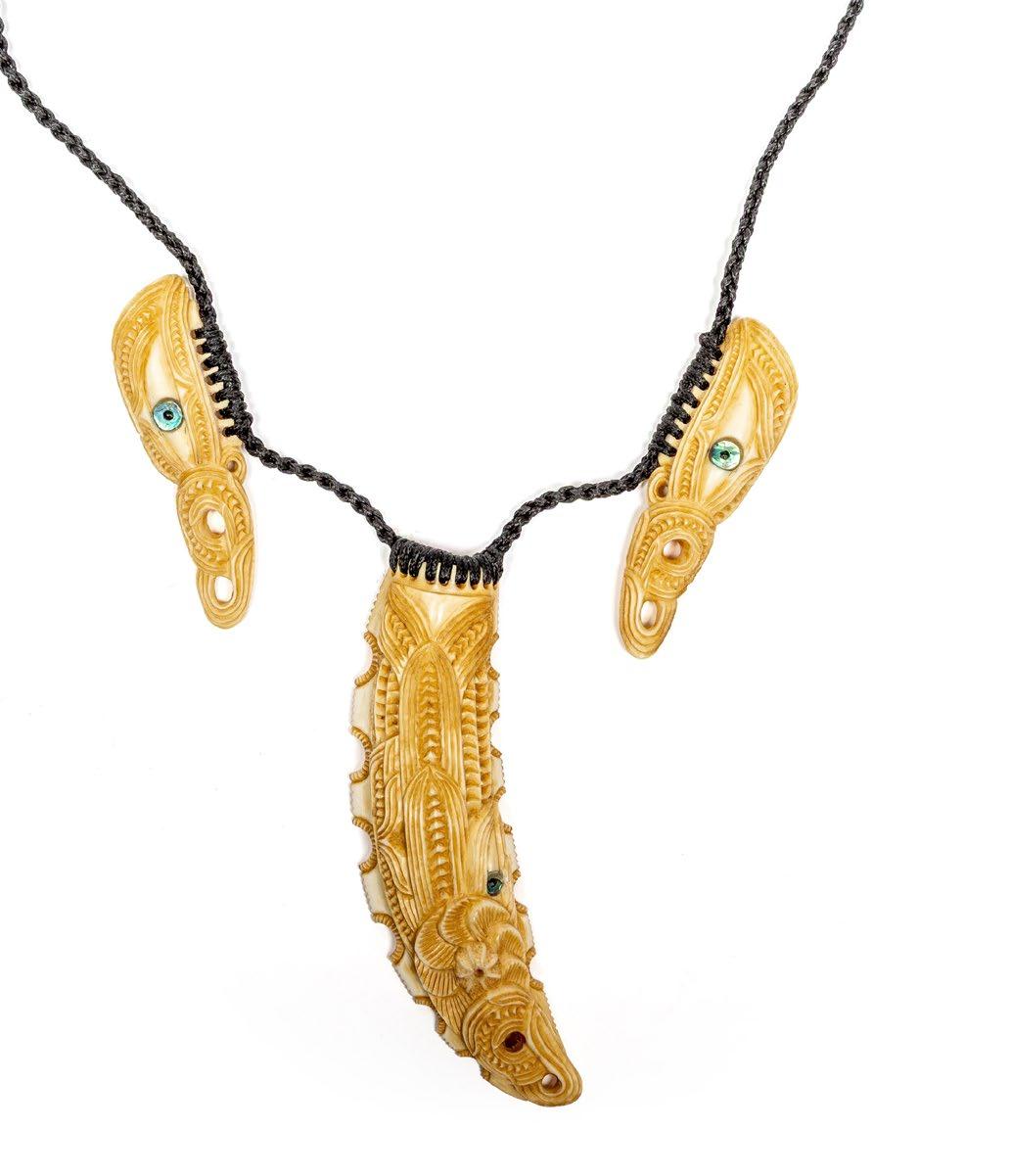
42
A Gareth McGhie Niho Tohora Māori, Aotearoa, New Zealand, 2025
Carved from marine ivory. This piece depicts the mother whale with two calves represented by manaia tohora suspended on each side of the main tooth.
10cm, 6cm length
Gareth McGhie is a contemporary New Zealand master carver working predominantly in bone, wood, and stone. Originally from Heretaunga Hawke's Bay, he is now based in Wellington, New Zealand. His carving work is focused within an adornment and sculptural context and is drawn from the Te ao Māori, Keltoi, and Norse worlds. The work is inspired by the traditions, histories, and mythologies of our ancestral peoples, and the beauty and majesty of the natural world.
$2,000–3,000
43
A Rare Carved Pouwhenua
Māori, Ngati Tarawhai, Aotearoa, New Zealand, early 20th century
Each side carved with three graduated wheku heads with paua shell eyes intersected by takarangi spirals with haehae notching. 122cm height, 8cm wide
PROVENANCE
Collection Todd Barlin, Sydney
This rare fully carved pouwhenua exemplifies the virtuosity of Ngati Tarawhai carvers, whose lineage of whakairo shaped the visual lexicon of Te Arawa (Rotorua, Bay of Plenty) carving traditions. More than a weapon, the pouwhenua served as a marker of land, lineage, and mana. In ceremonial contexts, it was wielded to assert whakapapa and territorial rights. The Ngati Tarawhai style, distinguished by deep relief, fluid transitions, and carved embellishment reflects the aesthetic refinement of this carving school.
$10,000–20,000


Three Rare New Ireland Ceremonial Headdress, 20th century
Each constructed from tapa and coconut fibre. Painted to the front and reverse with charcoal on a thick chalky lime ground with a frigate bird and fish and geometric motifs.
45 x 38cm
PROVENANCE
Collection Peter Hallinan
Collection Ian and Marcia Pakes
$1,500–2,500
These headdresses were used for important ceremonial purposes such as funerals. They were used once and then discarded in the forest. These three rare examples were field collected by Peter Hallinan in the late 1960s. Each mounted on a custom-made stand.
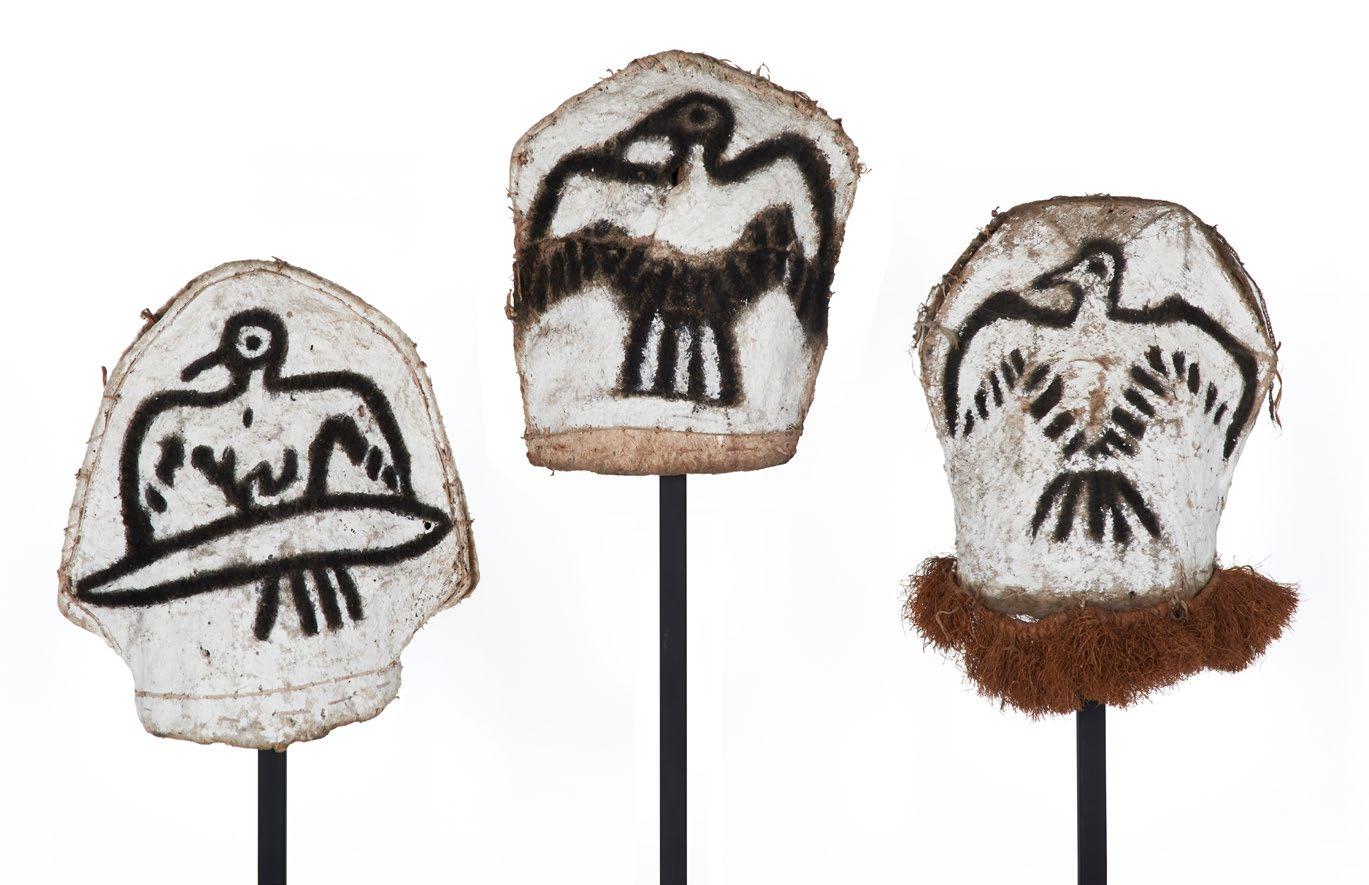
A Bungain Mosquito Mask
Papua New Guinea, Delta Sepik River, early 20th century
Wood with dark brown patina and natural red and white painted pigment decoration.
42cm height, 19cm wide
$1,800–2,800


A Batak Tungkot Malehat Staff Top
Karo Batak, Sumatra, Indonesia, 20th century
Carved staff finial depicting a seated equestrian ancestral figure riding a "Singa". Featuring a domed headdress of twisted rattan, rising into vertical feather quills, with trailing fibre strands down the back.
Mounted on a wooden pedestal.
35cm height
PROVENANCE
Collection John Graham, Melbourne
$4,500–6,500
A Tungkot Malehat staff top is the finial or carved figure that crowns the ritual staff used by religious specialists among the Batak people of North Sumatra, Indonesia.
An Asmat Sheild
Papua Region, Irian Jaya, early 20th century
Vertically oriented wooden shield carved in low relief with symmetrical curvilinear motifs. The upper section surmounted by a stylised anthropomorphic figure. The reverse side is undecorated with a central grip carved in high relief.
170cm height, 50cm wide
PROVENANCE
Field Collected by Ed Boyland in the 1960s
Private Collection, Melbourne
$1,500–2,000
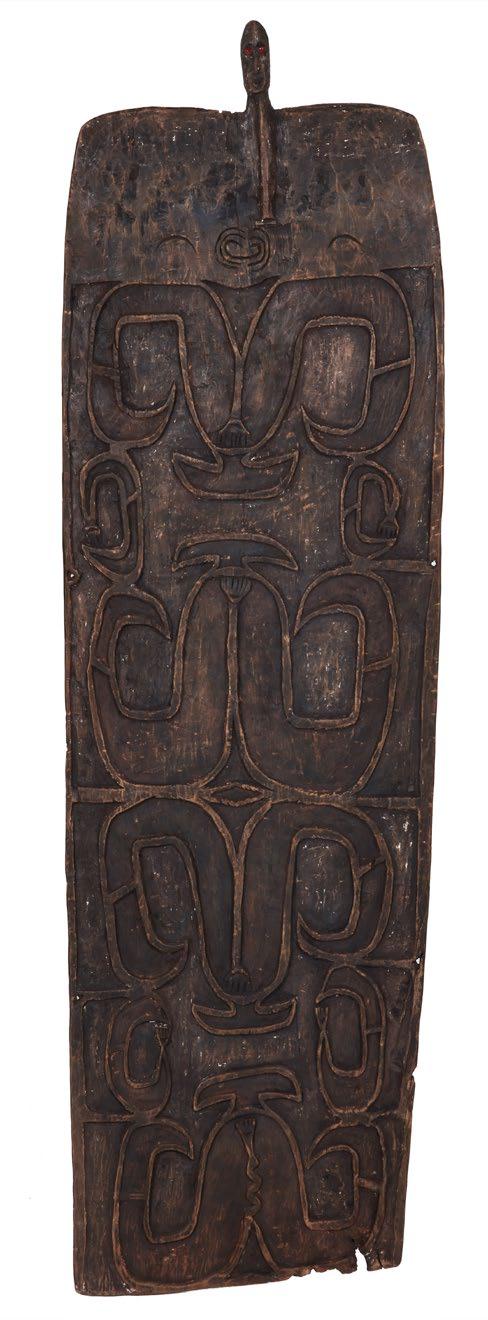

A Superb Figurative Ceremonial Paddle Buka/Bougainville Island, Solomon Islands, 19th century
Carved wood embellished with natural pigments. The paddle most likely used as a dance wand characteristically displays a squatting Kokorra figure with upraised hands and mitre-like coiffure.
151cm length
PROVENANCE
Sotheby's, London, 23 June 1981, lot 43
Private Collection, New South Wales
$2,500–5,000
A Superb Old Western Highlands Sheild Wahgi Valley Area, Papua New Guinea, 19th century
Large rectangular wooden shield with surface decoration incised with punctate pecking to outline clan motifs painted in yellow, white, and black pigments. The front face embedded with arrow and spear points, indicating active use in combat. 158cm height, 65cm wide
PROVENANCE
Collection Todd Barlin, Sydney Australia
Purchased Theodore Bruce Auctioneers and Valuers, Sydney, Dec 2022, Lot 9085
Private Collection Melbourne
Used in inter-clan warfare. These shields were operated by two men, one advancing the shield, the other positioned behind to shoot arrows with precision. Designs were clan-specific and served as visual identifiers in battle. Warfare in the region was frequent, with shifting alliances and traditional rivalries.
$2,500–3,500

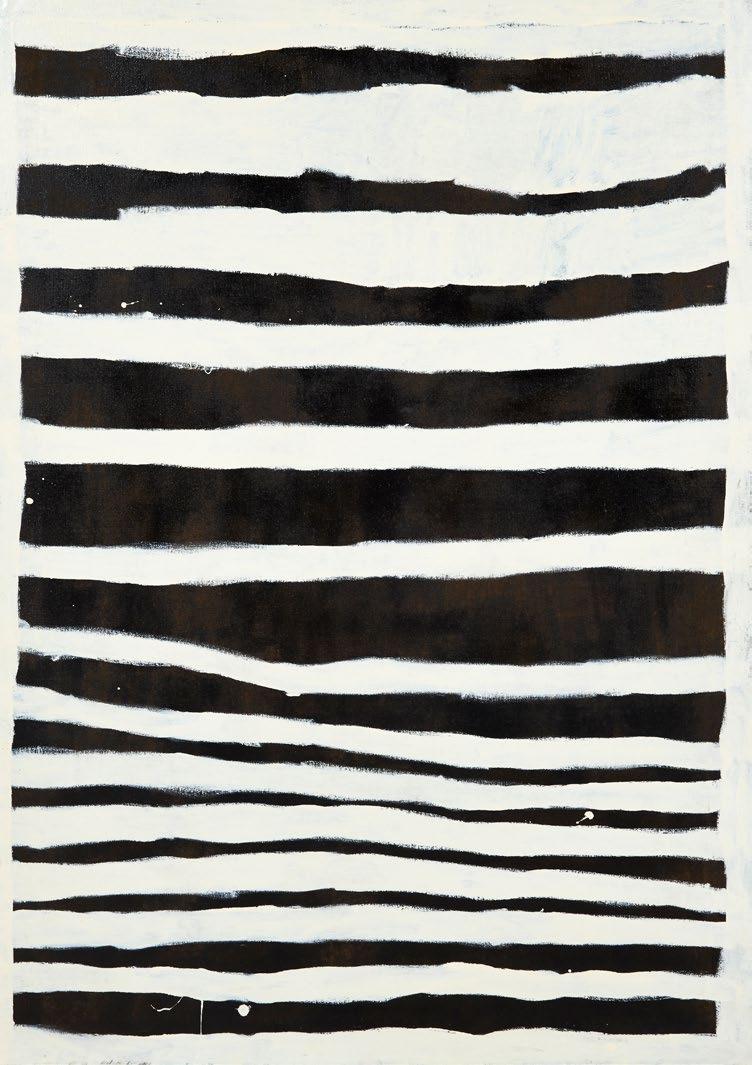
MARCUS CAMPHOO
AUSTRALIAN, 1990-
Untitles, 2019
acrylic on canvas
143 x 76cm
PROVENANCE
Nyinkka Nyunyu Arts Centre, Northern Territory, cat. no. 371-19
Darwin Aboriginal Art Fair (DAAF) 2022
Private collection, America
$2,000–3,000
AUSTRALIAN, 1961-
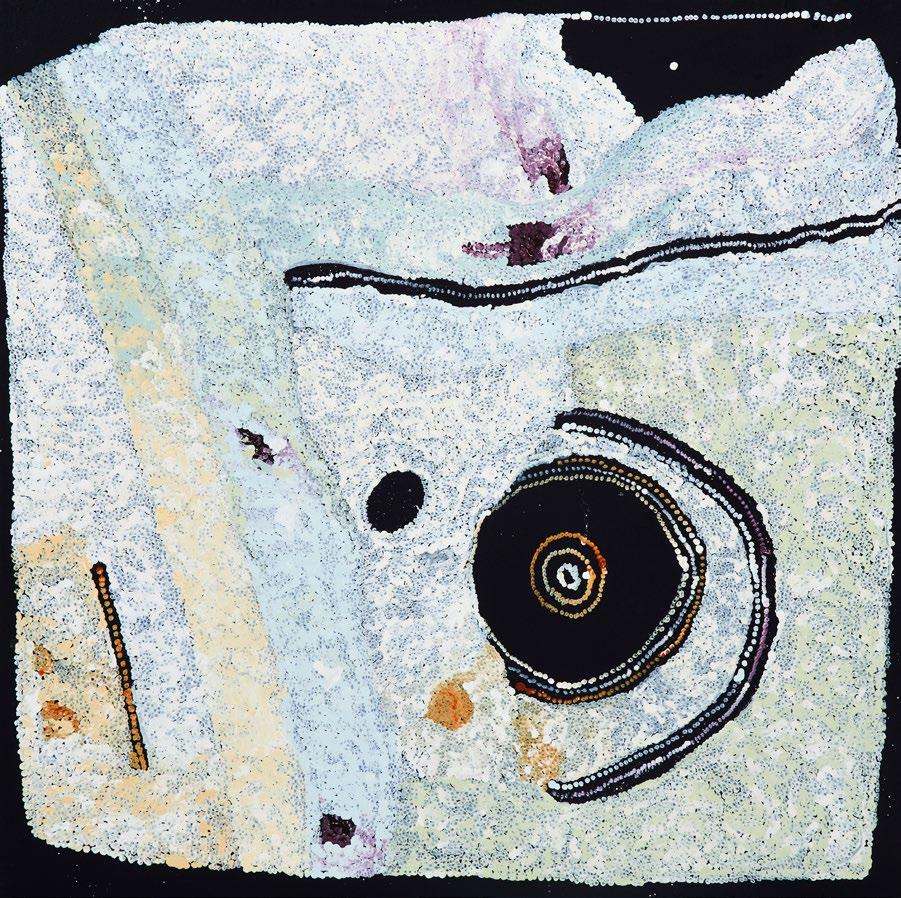
101
PROVENANCE
Everywhen Art, Shoreham, Victoria
Private collection, America
$2,500–3,500
BETTY CAMPBELL
Minymaku Tjukurpa (Women's Story), 2022
acrylic on linen
x 101cm
Mimili Maku cat. no. 509-22, Anangu Pitjantjatjara Yankunytjatjara (APY) Lands
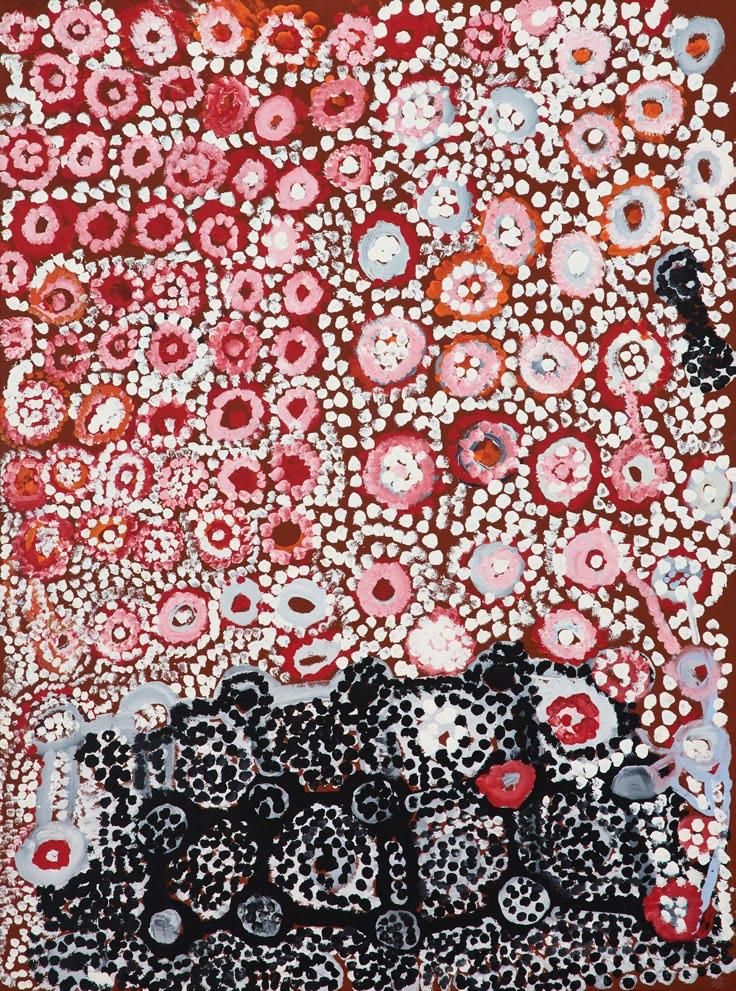
NEVILLE NIYPULA MCARTHUR AUSTRALIAN, 1938-
Wati Tjukurrpa, 2011
acrylic on canvas
101 x 76cm
PROVENANCE
Warakurna Arts Centre, Western Australia, cat. no. 2249-236-11
Private collection, America
$1,000–1,500
IMELDA YUKENBARRI GUGUMAN
AUSTRALIAN, 1954Winpurpurla, 2011
synthetic polymer paint on canvas bears inscription verso: artist's name, size and Warlayirti Artists cat. no. 106/11
120 x 80cm
PROVENANCE
Warlayirti Artists, Balgo Hills, Western Australia, cat. no. 106/11
Company collection, Melbourne, acquired 2011
Deutscher & Hackett, Fine Indigenous Art, May 28, 2024, lot 19
Private collection, America
EXHIBITED
WaterMark – the Signature of Life: Aboriginal Art Masterpieces in Hong Kong, The Space, Hong Kong, 6–8 September 2012 (illus. in exhibition catalogue)
WaterMark – the Signature of Life: A Collection of Aboriginal Masterpieces, The Arts House, Singapore, 21 November 2014 (illus. in exhibition catalogue, p. 8)
$3,000–4,000
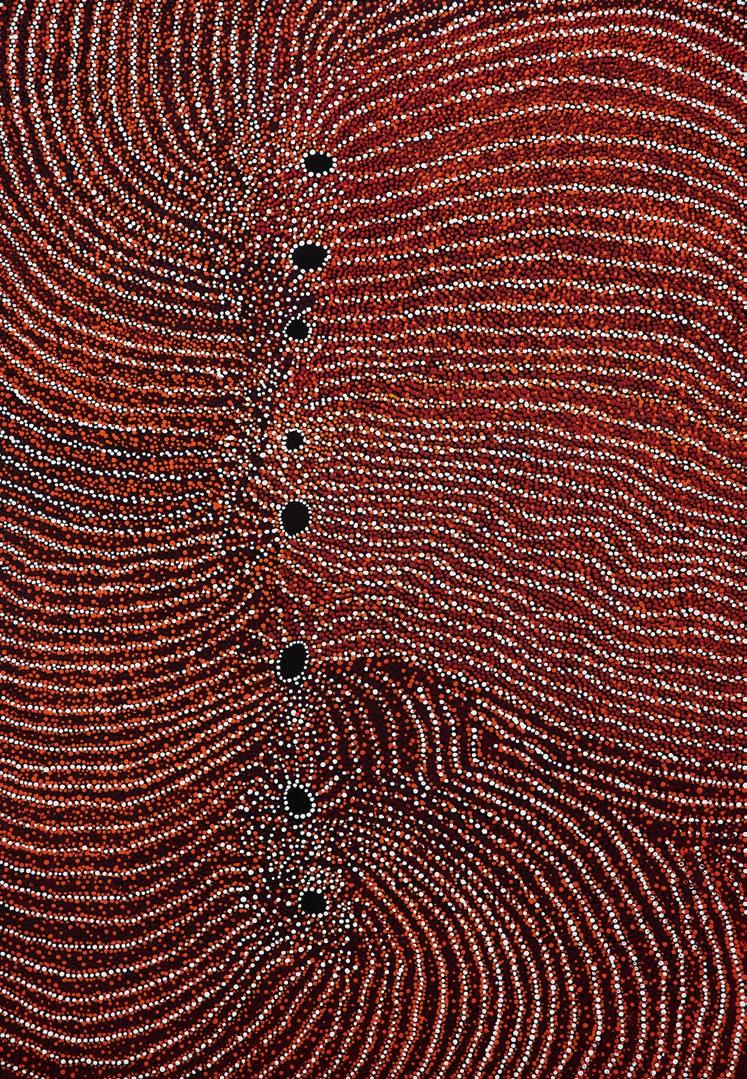
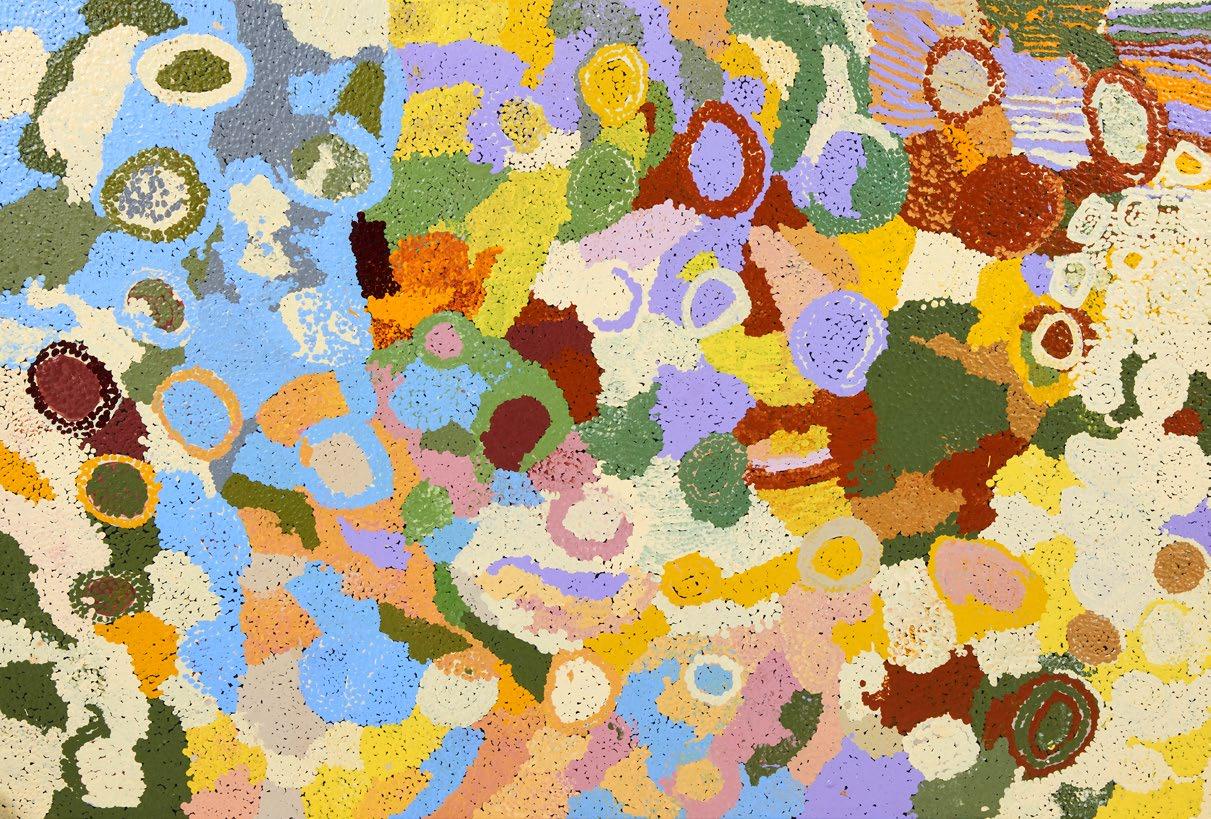
Martumili Arts Centre, Western Australia, cat. no. 23-1175 Private collection, America
$2,000–3,000
BIDU
MINNIE PWERLE
AUSTRALIAN, 1922-2006
Awelye Atnwengerrp, Untitled 2004
synthetic polymer paint on canvas 120 x 92cm
PROVENANCE
Dacou Gallery, Adelaide, cat. no. DG05506
Private collection, Melbourne
$1,800–2,500
END OF EVENING SESSION
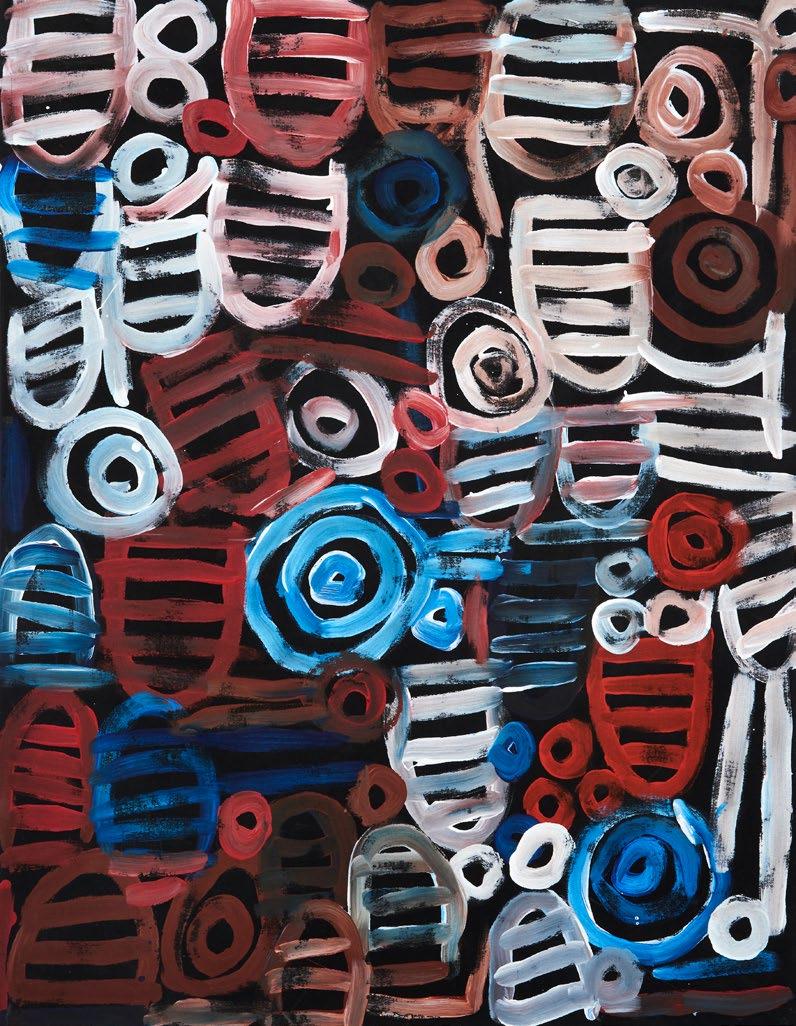
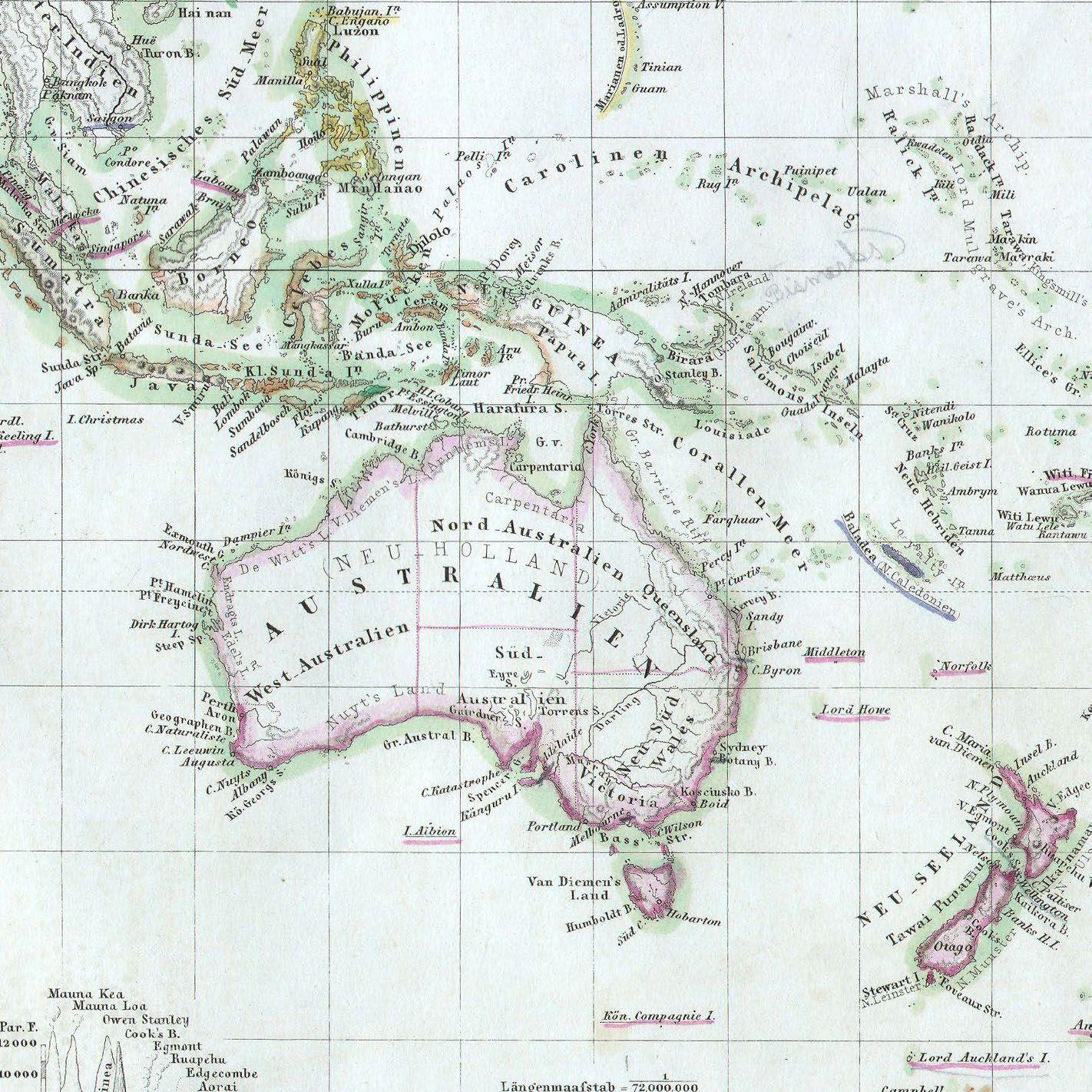
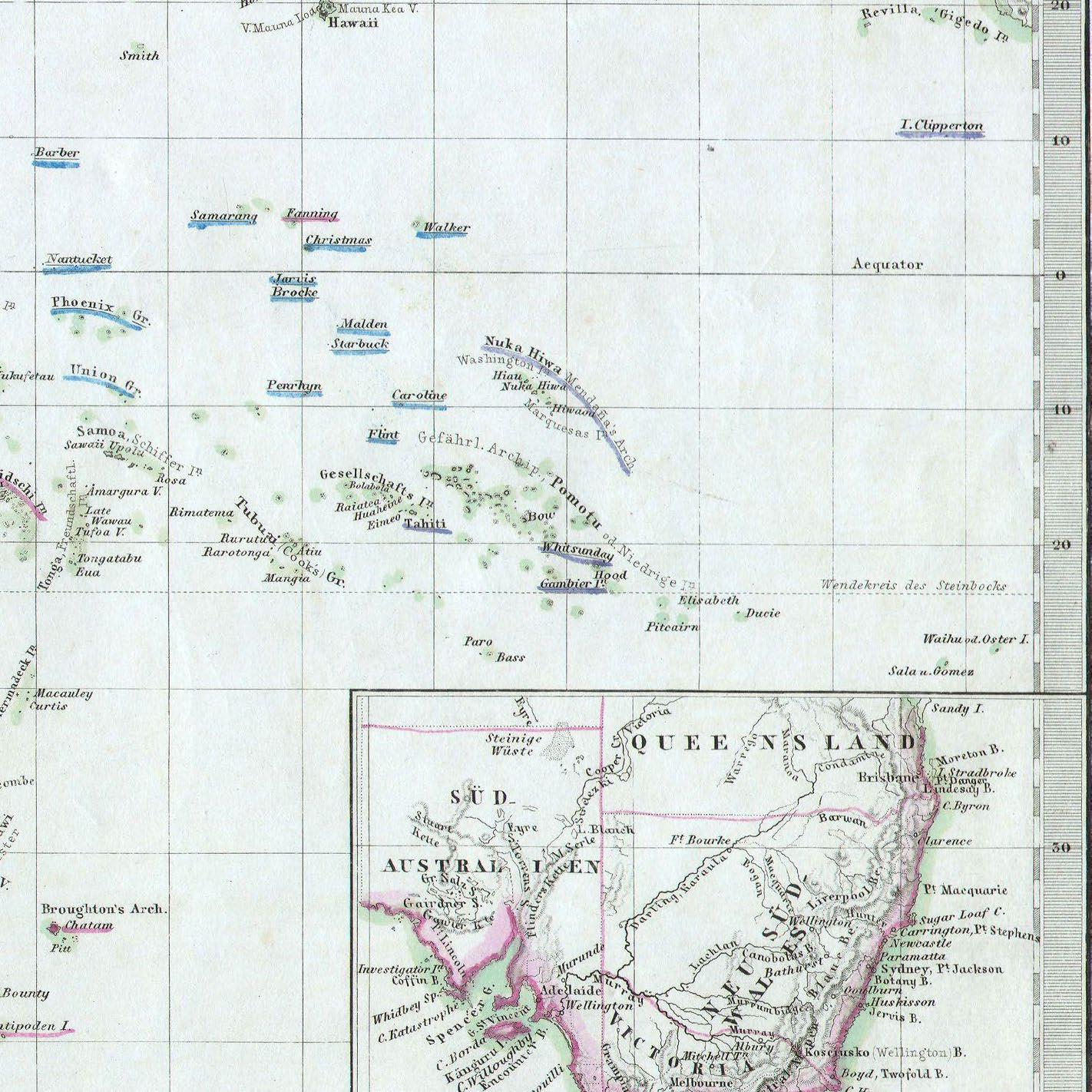
Day Session
Monday 17 November, 10am (AEDT)
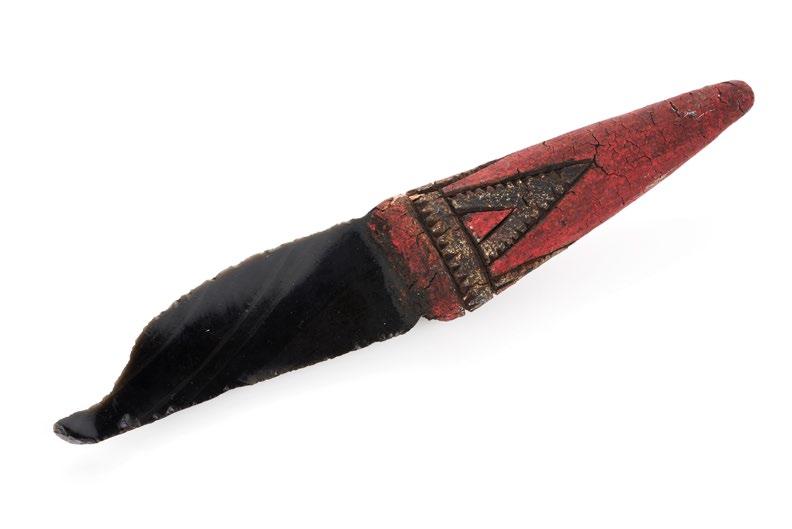
56
An Obsidian Dagger
Admiralty Islands, Bismarck Archipelago, Northeastern Papua New Guinea
Finely knapped obsidian blade set into a carved hardwood handle, bound with fibre and adorned with traces of red and white pigment.
26cm length
$400–800
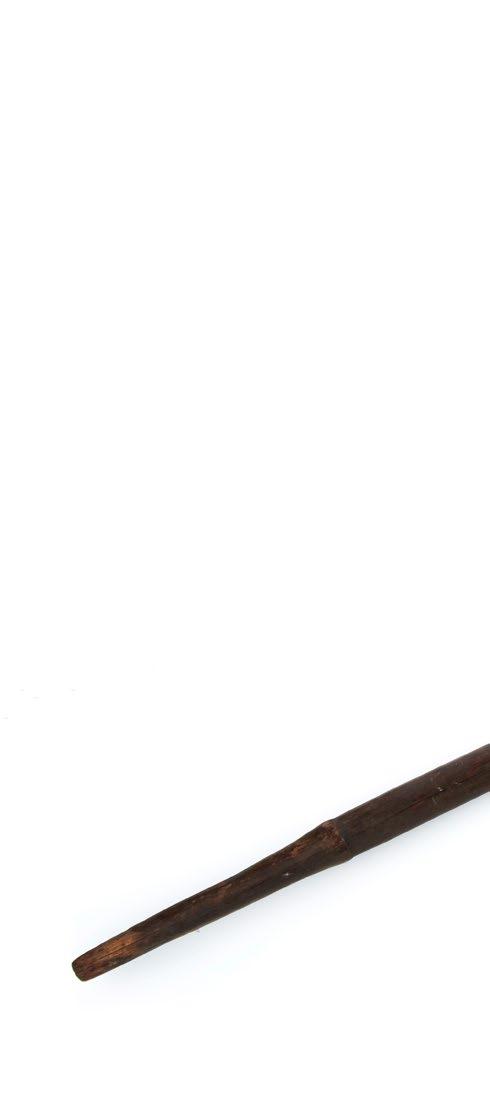

57
A Massim Club
Trobriand Islands, Milne Bay Provence, Papua New Guinea, late 19th century
Carved hardwood club with spatulate head with reduced grip. The blade with incised geometric motifs typical of Massim design. Wear and patina, indicative of age and handling.
Old labels affixed to the blade.
62cm height
Used both in ceremonial contexts and as a status object within the kula exchange system, a ceremonial network of gift-giving practiced among island communities in Papua New Guinea, especially the Massim archipelago, to build prestige, social ties, and political alliances.
$350–700
59
A New Britain Baining Club
Gazelle Peninsula, Bismarck Archipelago, Northeastern Papua New Guinea
Robust hardwood club with elongated shaft and rounded stone disc striking head.
119cm length
Minor splits evident to the shaft
$400–800
60
A Lapalapa Club
Samoa, late 19th century
Carved hardwood club with flaring blade terminal and cylindrical shaft featuring six reducing ridged bands.
81cm length
$500–800
61
A Turtle Shell Trolling Lure
Malatia Island, Solomon Island, 19th century
6cm length
$1,200–1,600

58
A Shark Hook
Mortlock Islands, 20th century
The large hook carved from one piece of wood and fastened with over woven designs of coconut fibre.
32cm length (hook)
$500–1,000

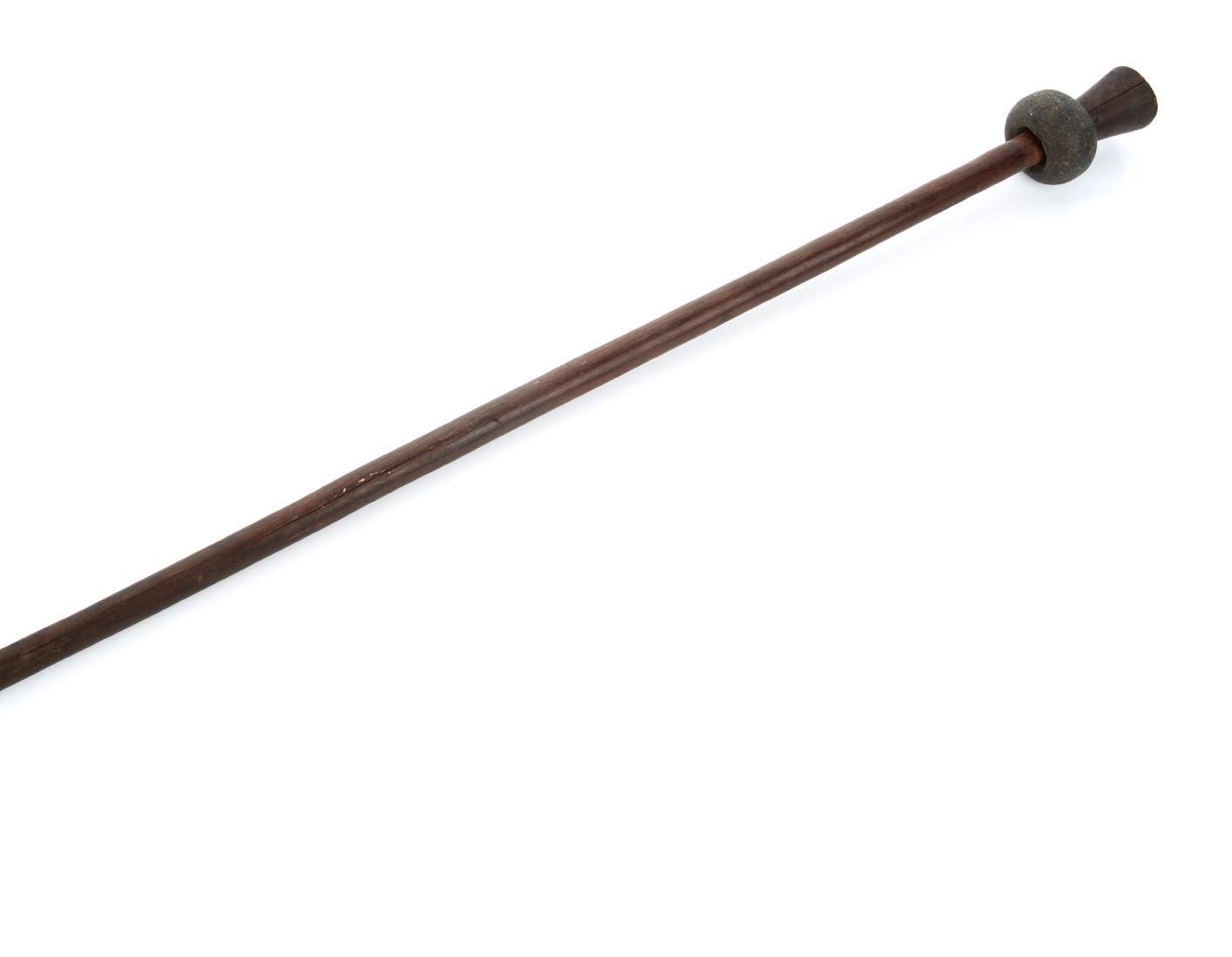
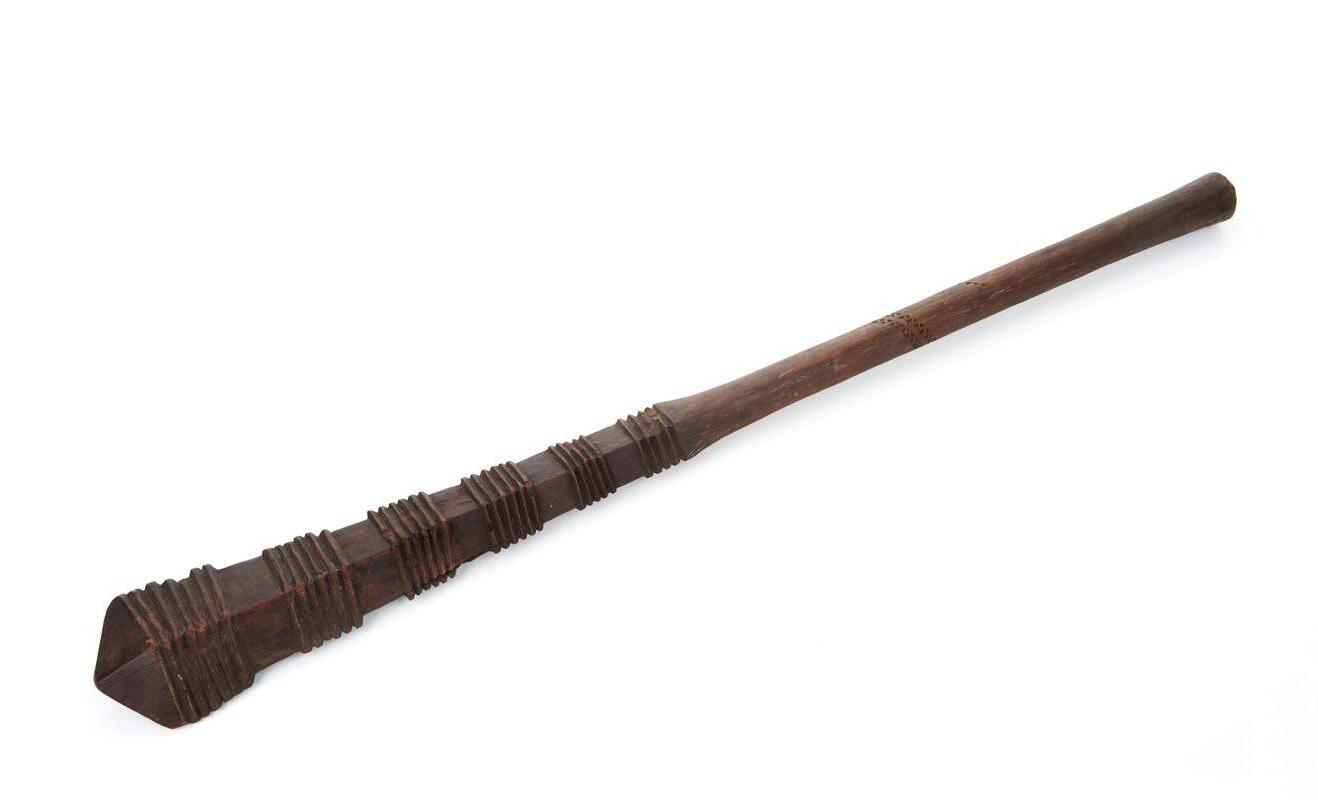


62
An Asmat Shield
Papua Region, Irian Jaya, early 20th century
A vertically oriented wooden shield carved in low relief and painted with black, brown and kaolin pigments. The upper section is surmounted by a carved anthropomorphic head. The reverse side is undecorated with a central grip carved directly into the wood. Natural fibre attachments.
170cm height, 40cm wide
$400–800
63
An Asmat Shield
Papua Region, Irian Jaya, early 20th century
Vertically oriented wooden shield carved in low relief with symmetrical curvilinear motifs and painted with ochre and kaolin pigments. The upper section surmounted by a stylized anthropomorphic figure. The reverse side is undecorated with a central grip carved in high relief. Natural fibre attachments. Used in ritual warfare and ceremonial contexts. These shields served both as physical protection and as a symbolic conduit for ancestral power. Designs were clan-specific and conveyed identity, status, and spiritual potency.
200cm height, 50cm wide
PROVENANCE
Collection Dr David Rosenthal, owner of Powell Street Galleries and part owner of Axion gallery in Richmond which later became Christine Abraham's gallery.
$800–1,600
64
An Asmat Shield
Papua Region, Irian Jaya, early 20th century
Vertically oriented wooden shield carved in low relief and painted with red, white, and black pigments. The upper section is surmounted by a carved blackened anthropomorphic face. The reverse side is undecorated, with a central grip carved in high relief. Natural shell and fibre attachments. 194cm height, 60cm wide
PROVENANCE
Collection Dr David Rosenthal, owner of Powell Street Galleries and part owner of Axion gallery in Richmond which later became Christine Abraham's Gallery.
$800–1,200
65
A Small Asmat Shield
Papua Region, Irian Jaya, early 20th century
A small vertically oriented wooden shield carved in low relief and painted with black, brown and kaolin pigments. The upper section is surmounted by a carved anthropomorphic head. The reverse side is undecorated with a central grip carved directly into the wood. 150cm height, 58cm wide
PROVENANCE
Collection Dr David Rosenthal, owner of Powell Street Galleries and part owner of Axion gallery in Richmond which later became Christine Abraham's gallery.
$400–600
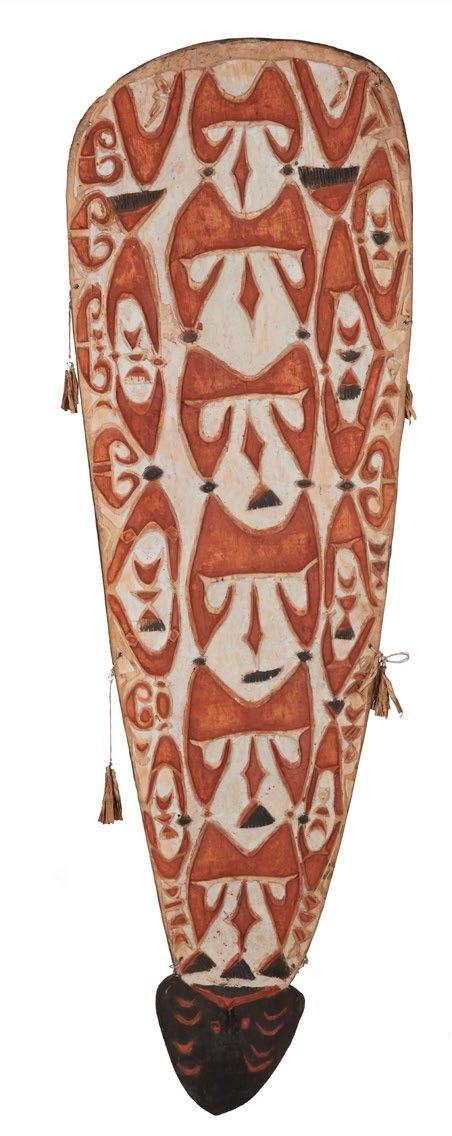

66
A Tortoiseshell Arm Band and a Papuan Gulf Belt
67
A Slit Drum

Papua New Guinea, 20th century
Finely shaped armband crafted from tortoise shell. Formed from a single curved segment heated and moulded into a smooth rounded cuff. Worn by men in coastal regions as adornment and status markers. The exterior with finely incised clan motifs highlighted with lime.
The belt is fashioned from bark and decorated with incised patterns highlighted with lime.
Armband 11cm length, 7cm diameter; belt 8cm height, 18cm diameter
$500–800
Sepik River, Papua New Guinea, 20th century
Horizontally oriented wooden drum carved in low relief with geometric patterns and clanspecific motifs. Painted with black, ochre, and kaolin pigments. One terminal end features a projecting dog head, the opposite end depicts an ancestral figure adorned with cowrie shells. The slit along the body functions as the resonating chamber.
107cm length, 27cm height, 21cm diameter
PROVENANCE
Collection Dr David Rosenthal, owner of Powell Street Galleries and part owner of Axion gallery in Richmond which later became Christine Abraham's Gallery.
$400–800
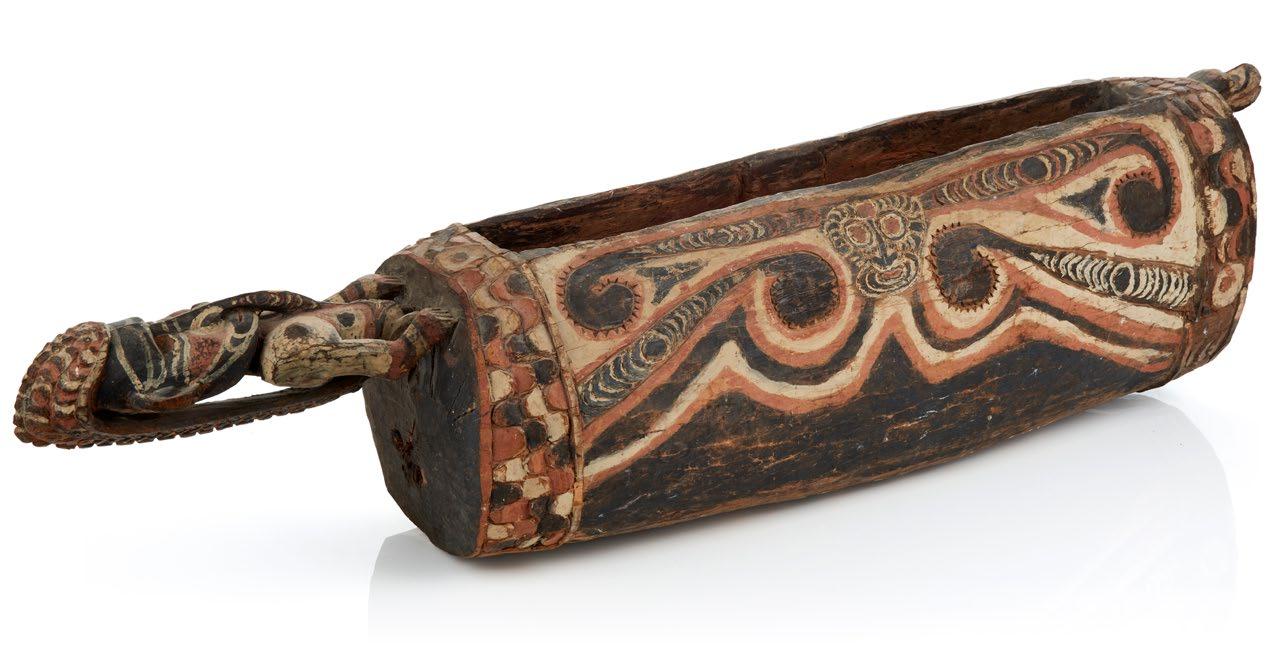
A Massim Canoe Splashboard Trobriand Islands, Milne Bay Provence, Papua New Guinea, 20th century
Carved from a flat section of wood and painted with white, red, and black pigments. Decorated on one side with a central shaft and mirrored scrolls. Features low-relief curvilinear and anthropomorphic motifs. The central apex figure is said to protect the canoe but may turn against the captain if his seamanship fails.
54cm height, 79cm height with stand
$500–800 69
A Massim Canoe Splashboard Trobriand Islands, Milne Bay Provence, Papua New Guinea, 20th century
Carved from a flat section of wood and painted with white, red, and black pigments. Decorated on one side with a central shaft and mirrored scrolls. Features low-relief curvilinear and anthropomorphic motifs. The central figure is said to protect the canoe but may turn against the captain if his seamanship fails.
57cm height, 82cm height with stand
$500–800
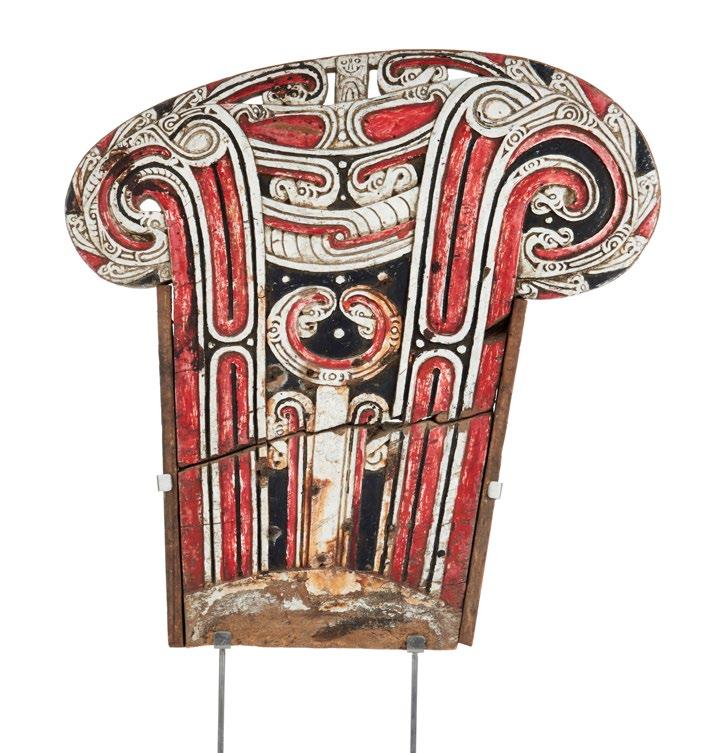
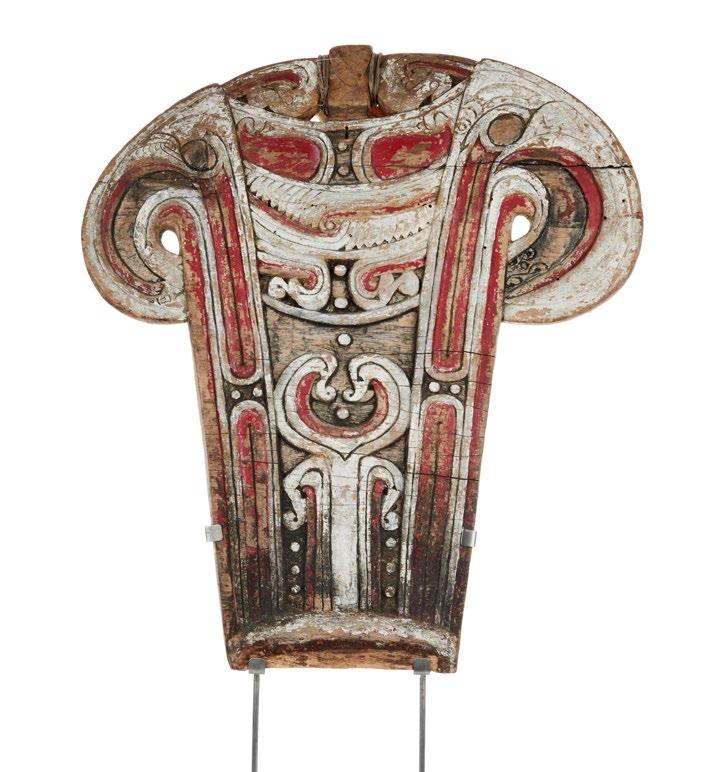
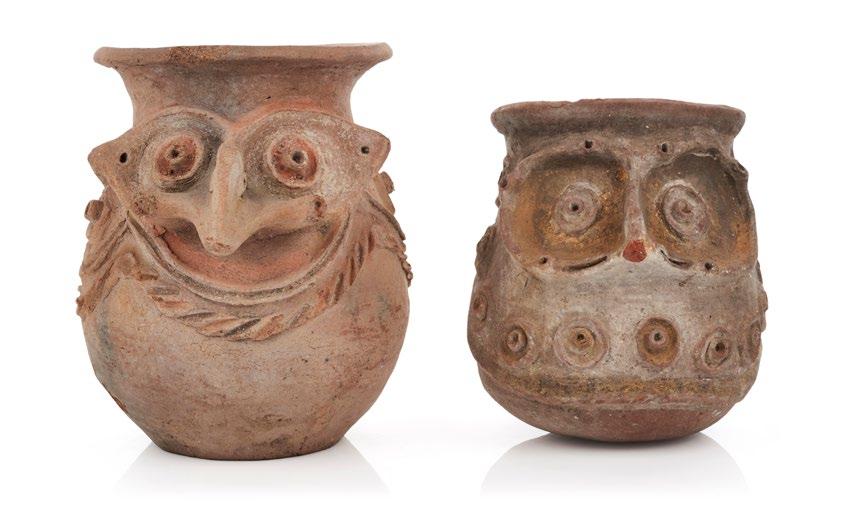
70
Two Aibom Village Sago Storage Jars Chambri Lakes District, Papua New Guinea, 20th century
Clay pit fired vessels with a wide flared neck, constructed from coiled and smoothed clay. The exterior features raised relief designs depicting a stylised bird, rendered with yellow and ochre pigments.
23cm height, 18cm diameter; 19cm height, 15cm diameter
PROVENANCE
Collection Dr David Rosenthal, owner of Powell Street Galleries and part owner of Axion gallery in Richmond which later became Christine Abraham's Gallery.
$400–800
71
A Rare Coconut Grater Stool Nukuoro Atoll, Caroline Islands, Micronesia, 19th century or earlier
Low wooden stool with a side platform designed to accommodate a metal coconut grating blade. Traditionally used in food preparation across Micronesian island communities.
52cm length, 30cm height, 26cm wide
PROVENANCE
Collection Ron Nasser, New York
Collection Seymour and Alyce Lazar, Palm Springs
Arte Primitivo - Fine Pre-Columbian & Tribal Art, Classical, Egyptian and Asian Antiquities #111, Sep 18, 2023
Private Collection, New South Wales
$2,000–3,000
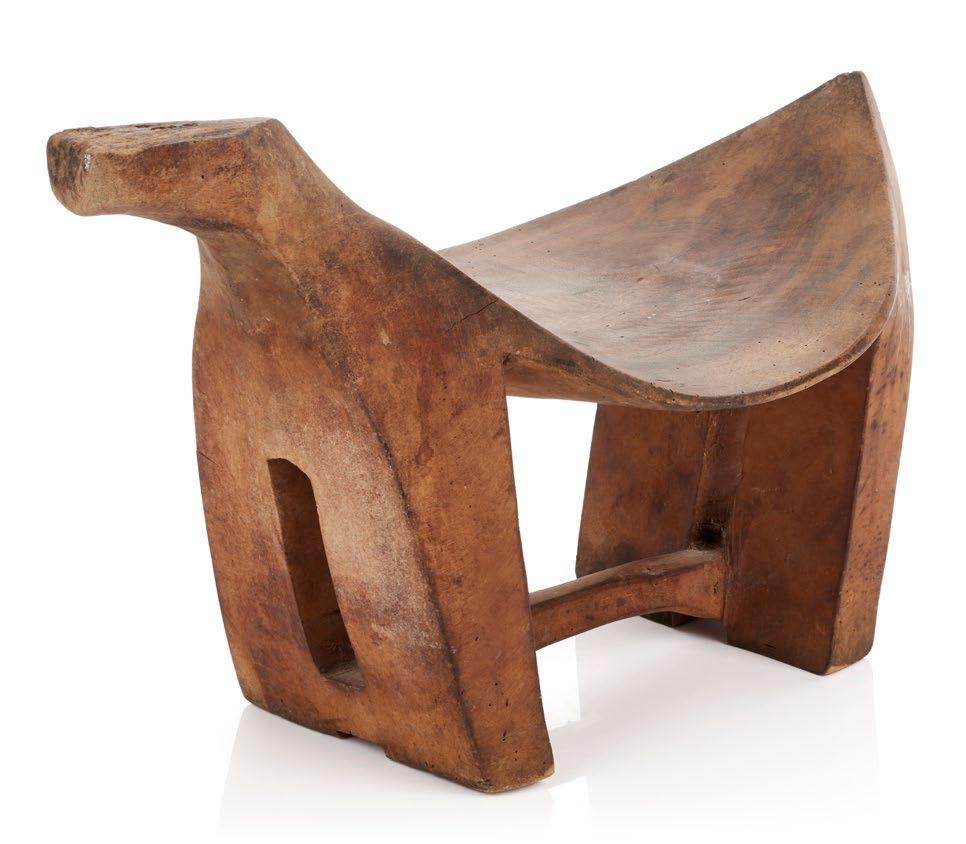
72
A Rare Early Net-Float
Solomon Islands, 19th century
Carved hardwood in the shape of a frigate bird. 23cm length, 10cm height
PROVENANCE
Sotheby's, Sydney.
Collection David Said, Sydney
Private Collection, New South Wales
$600–800
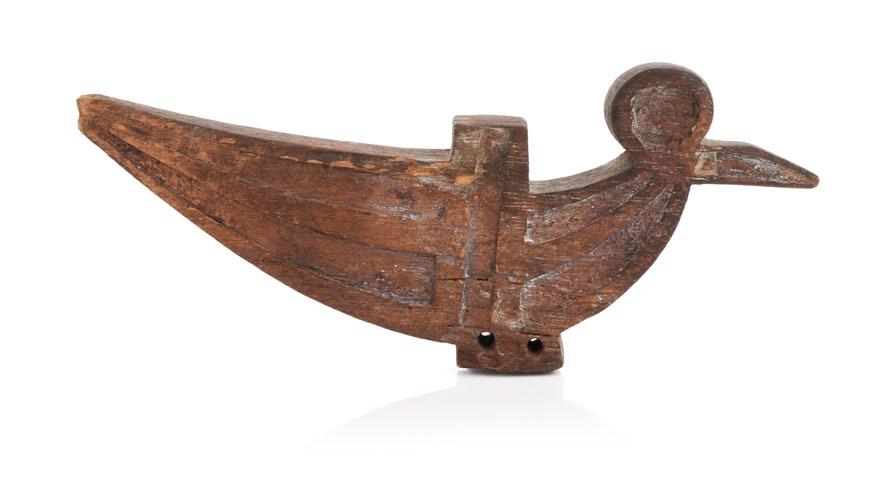
73
A Rare Early Ceremonial Bowl Chuuk Island, Caroline Islands, Micronesia, 19th century
Elliptical, flared-form carved wood bowl with small side handles and foot. Form reflects regional carving traditions. 19cm height, 36.5cm length, 25.5cm wide
PROVENANCE
Private Collection, New South Wales
$400–800


74
A Fijian Tabua (Ceremonial Whale Tooth Necklace) early 19th century
A sperm whale tooth pierced for suspension at both ends with attached natural fibre binding. 11cm length, 7cm wide
PROVENANCE
Private Collection, New South Wales
$300–500
75
A Carved Wooden Stand Māori, Aotearoa, New Zealand, early 20th century
Carved in the style of Ngati Tarawhai, Rotorua, New Zealand. With surmounting wheku figures and cut paua shell embellishments. Square cross section mounted on square base with shallow rectangular well to the top. 55cm height, 23 x 23cm wide
PROVENANCE
Private Collection, New South Wales
$1,500–2,500

76
A Massim Wave Splitter (Tabuya) Trobriand Island, Milne Bay Province, Papua New Guinea, 20th century
The figurehead is carved in the form of a sea serpent with long sinuous neck and head crest. The body surface bears finely incised geometric and curvilinear motifs. Embellished with betel nut husks suspended with plant fibre through the mouth. Mounted on a cast iron base. 60cm length, 25cm height
PROVENANCE
Collection Peter Hallinan, field collected in the 1960s
Collection Ian and Marcia Pakes
Wave splitters, often mounted at the bow, are used on ocean-going canoes in the Massim region. Shaped to cleave water efficiently, the tabuya also served as a symbolic element in ceremonial and navigational contexts.
$500–800
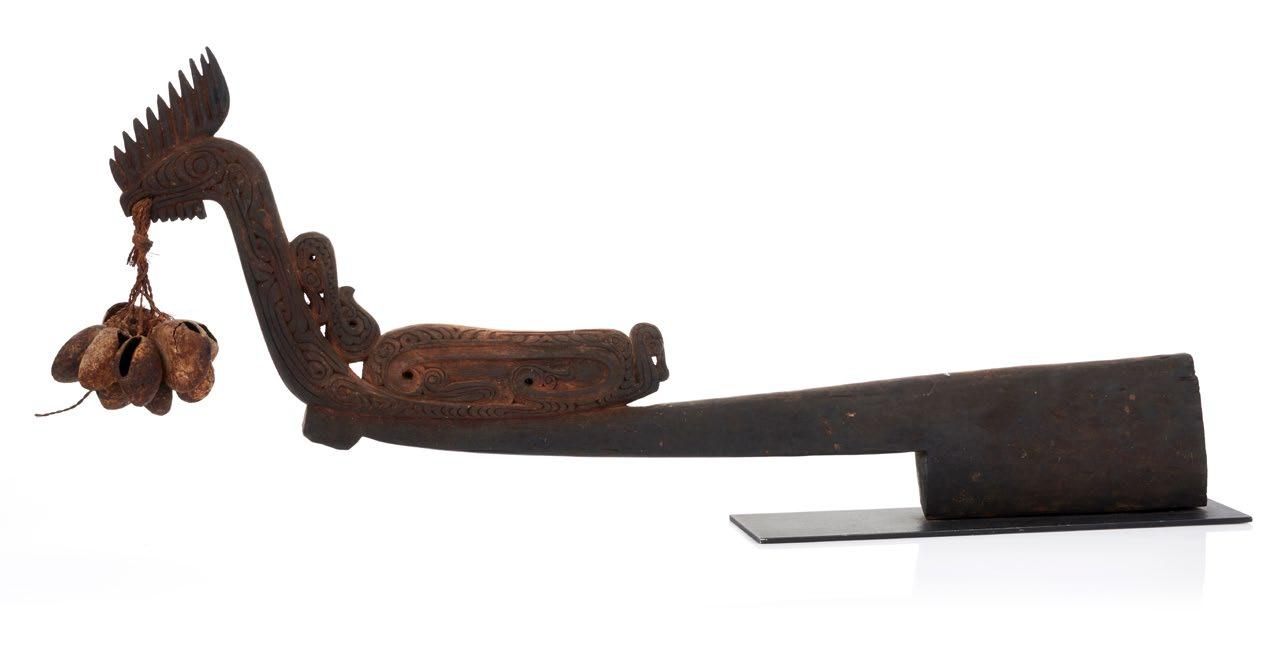
77
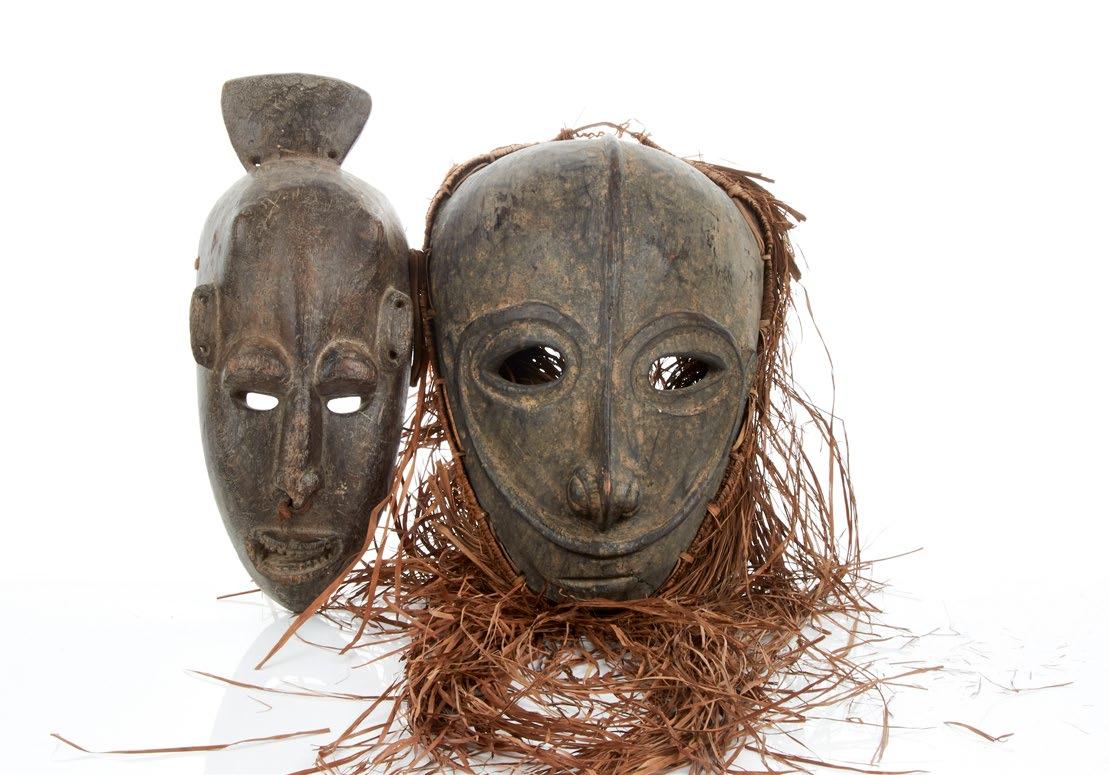
Two Papua New Guinea Masks Iatmul People, Angriman Village, East Sepik Province, 20th century
Each with oval elongated face and pierced eyes. One with plant fibre attachments. 47cm height, 19cm wide; 40cm length, 33cm wide
PROVENANCE
Collection Peter Hallinan, field collected in the 1960s. One mask with Peter Hallinan collection number to the back.
Collection Ian and Marcia Pakes
$800–1,400

78
A Massim Paddle Trobriand Island, Milne Bay Province, Papua New Guinea, 20th century
The blade with finely incised aquatic motifs and painted with red, white, and blue pigments. Stylised crocodile finial.
140cm length
PROVENANCE
Collection of Peter Hallinan, field collected in the 1960s
Collection of Ian and Marcia Pakes
$400–800
79
A Sunduk Ancestral Marker Sama/Bajau Culture, Sulu Archipelago, Philippines, early 20th century
Wood with weathered patina.
67cm height, 34cm length
PROVENANCE
Collection Ian and Marcia Pakes
This carved wood sunduk represents a stylised boat form serving as an ancestral grave marker among the Sama and Bajau peoples of the Sulu Archipelago. The sunduk is typically placed atop or near burial sites, symbolising the soul's journey across water. Mounted on an ebonised plinth.
$500–800
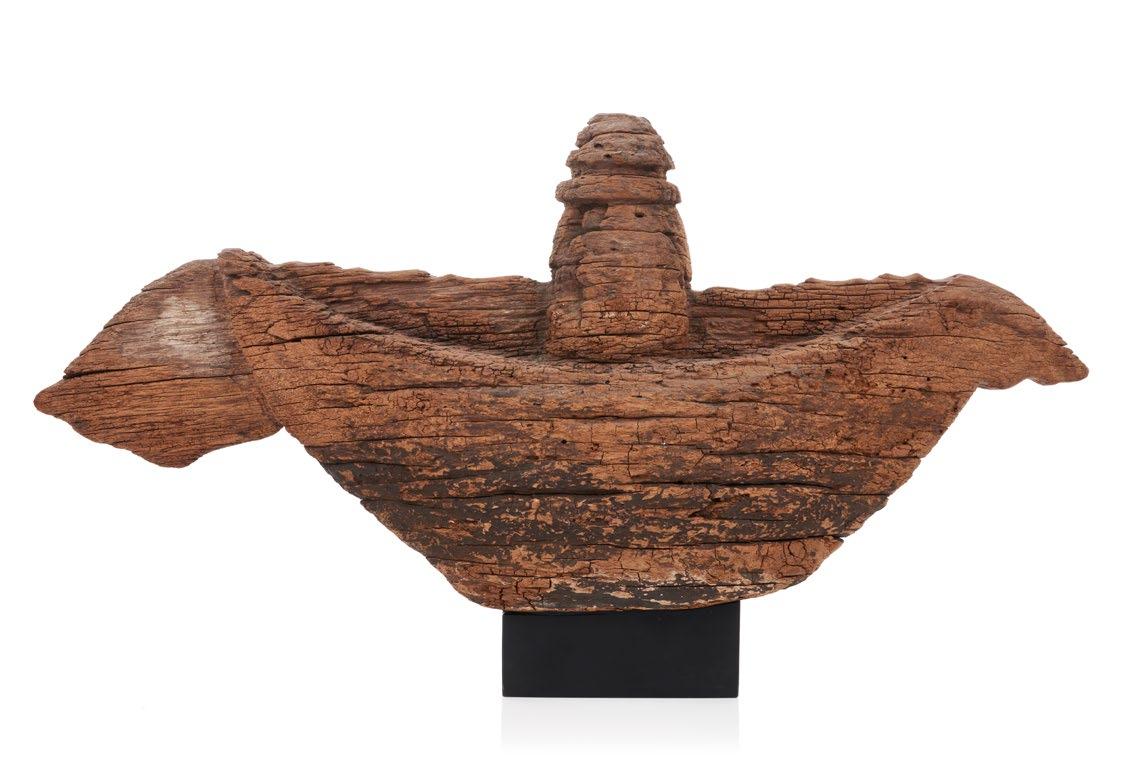
80
A Massim Canoe Bailer
Trobriand Islands, Milne Bay Province, Papua New Guinea, early 20th century
Large bailer carved from a single piece of hardwood, designed for use with ocean-going canoes. The vessel's broad curved form is both functional and sculptural with a solid central handle rising in high relief. Lower section of the face carved with aquatic motifs. 54cm length, 24cm wide
PROVENANCE
Collection Peter Hallinan, field collected in the 1960s
$1,000–2,000

81
A Massim Canoe Bailer
Trobriand Island, Milne Province, Papua New Guinea, 20th century
Large bailer carved from a single piece of hardwood, designed for use with ocean-going canoes. The vessel's broad curved form is both functional and sculptural with a solid central handle rising in high relief. The plains of the face adorned with finely incised aquatic motifs. 46cm length, 21cm wide
PROVENANCE
Collection Peter Halllinan, field collected in the 1960s
Collection Ian and Marcia Pakes, Melbourne
$800–1,600

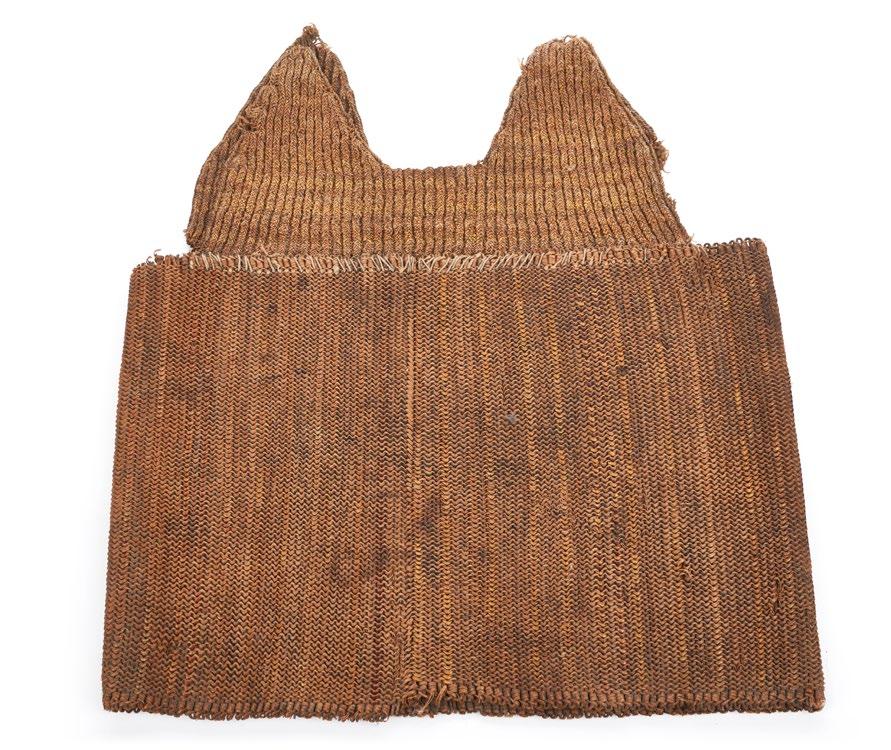
82
A Cuirass (Woven Chest Armor)
Dani People, Baliem Valley, Western Highlands, Irian Jaya
The lower section of the cuirass consists of rattan strips designed to wrap around the torso from just above the waist to the chest. The upper portion is constructed from tightly knotted vegetable fibre rope, enhancing its resilience and shielding the upper chest, collarbones, and shoulders. Decorative colour is added using orchid stems, intricately woven through both the rope and rattan.
50cm height, 47cm wide
PROVENANCE
Collection Peter Hallinan, field collected in the 1960s
Collection Ian and Marcia Pakes
$400–800
83
Two Ifugao Bowls
Mountain Province, North Luzon, Philippines, 19th century
A large wooden duyu bowl with a carved ring foot and scalloped rim, and a smaller double welled spice grinding bowl. 22cm length, 15cm wide
PROVENANCE
Collection Ian and Marcia Pakes
$300–400
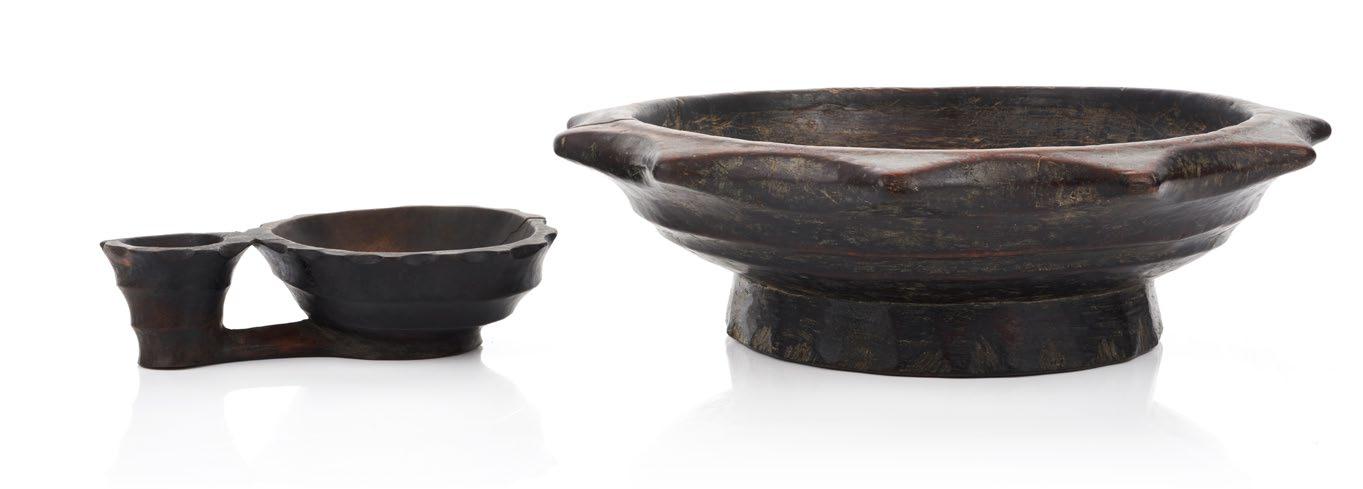
84
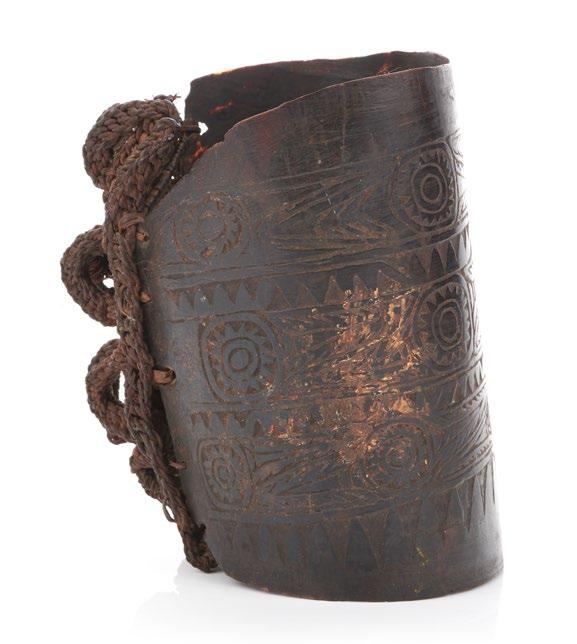
A Tortoiseshell Arm-band
Nogosop Village, East Sepik, Papua New Guinea, 20th century
Finely shaped armband crafted from tortoise shell. Formed from a single curved segment, heated and moulded into a smooth rounded cuff and bound with woven plant fibre. The exterior with finely incised patterns to the surface. Worn by men in coastal regions as adornment and status marker.
17cm height, 10cm diameter
PROVENANCE
Collection Peter Hallinan, field collected in the 1960s
Collection Ian and Marcia Pakes
$300–400
85
An Ifugao Ladder with Carved Figures Mountain Province, North Luzon, Philippines, 1940s or earlier
Ebonised hardwood ladder with four steps. Side rails carved with crouching anthropomorphic figures. Two rungs bound with woven rattan.
183cm height, 51cm wide
PROVENANCE
Collection Ian and Marcia Pakes
Likely associated with a village headman's residence or the household of a prosperous rice landowner.
$1,000–2,000
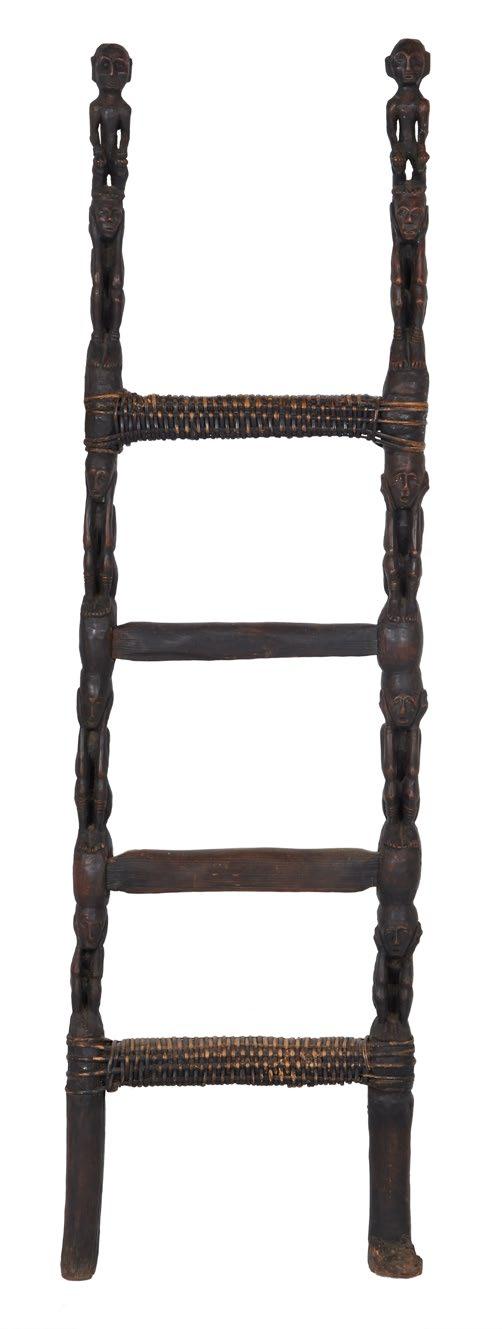


An Ifugao Hunters Backpack with Rain Cover
Mountain Province, North Luzon, Philippines, 19th century
This hunter's backpack from the Ifugao people of northern Luzon is made from woven rattan and has a rounded rain cover made of overlapping tightly bound plant fibre. It's built strong and light for use in forested areas, with a stiff, tube-shaped body, a lid, and loops for shoulder straps. The rain cover, sometimes darkened with soot, keeps the contents dry and ties on with a fibre cord.
61cm height, 47cm wide
PROVENANCE
Collection Ian and Marcia Pakes
$500–800
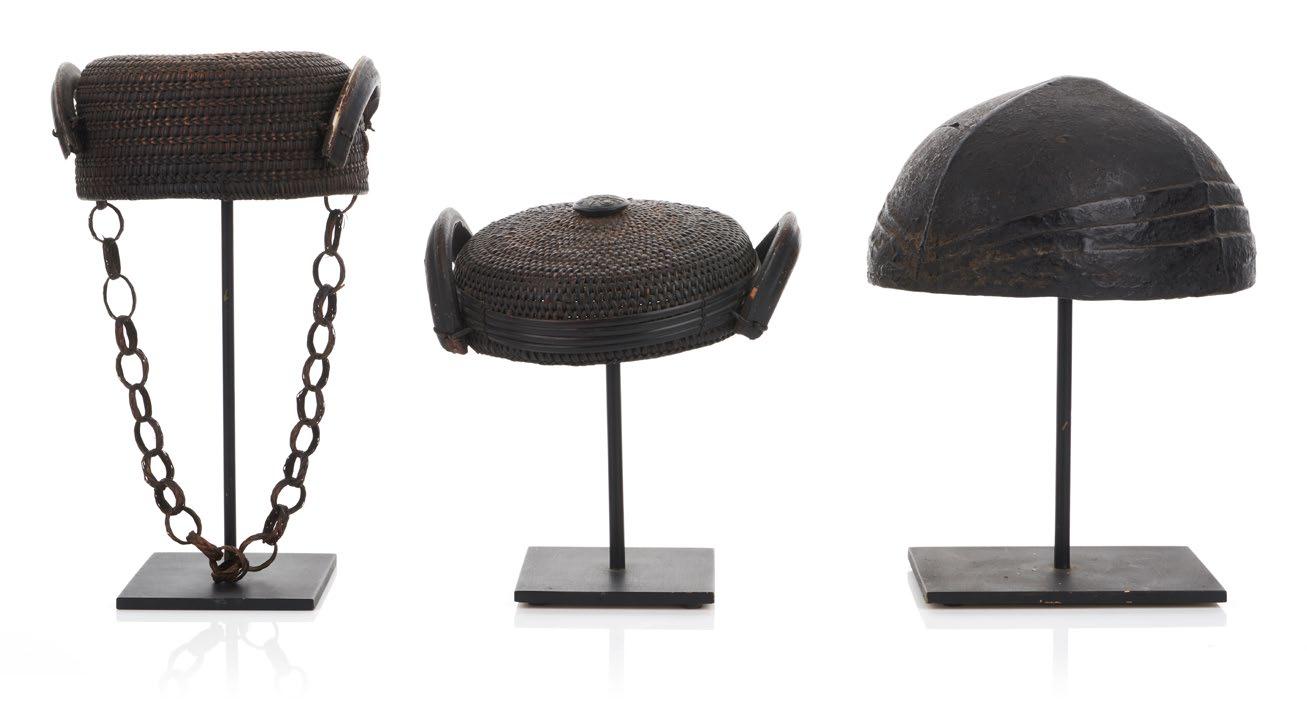
87
Two Ifugao Married Mans Headdresses and Wooden Helmet
Mountain Province, North Luzon, Philippines, circa 1930s
Hats crafted from woven plant fibre and embellished with boar tusk, one with an affixed American serviceman's button. The helmet from carved ebonised wood. All mounted on custom made stands.
21cm length, 15cm, 15cm diameter
PROVENANCE
Collection Ian and Marcia Pakes
$400–600
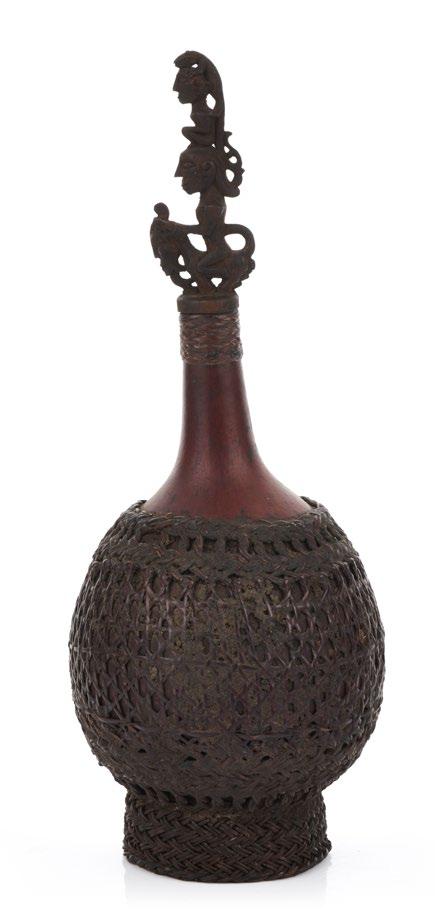
88
An Iatmul Flute Stopper
Sepik River, Papua New Guinea, early 20th century
Carved as a standing male figure with shell eyes and with plant fibre attachments to the ears and with pigment decoration. 40cm height
PROVENANCE
Collection Ron Brownson
$800–1,600
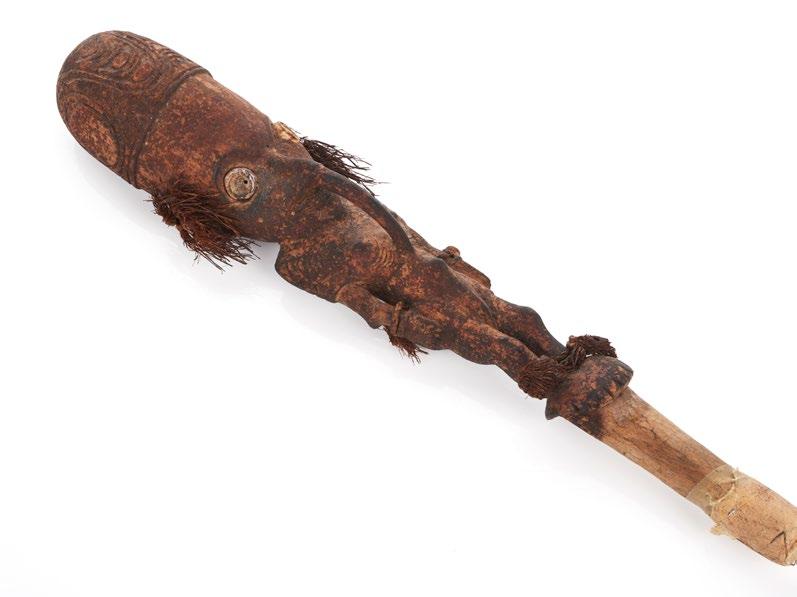
89
A Toba Batak Medicine Gourd Container (Perminangken)
Toba Batak, Sumatra, Indonesia, circa 19th – early 20th century
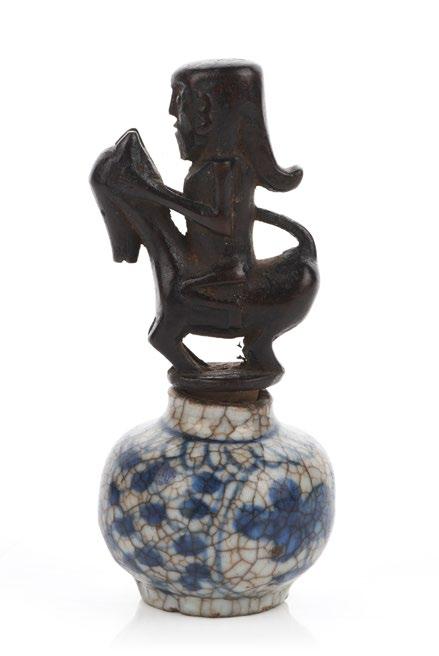
The hardwood stopper portrays a figure riding a "singa". The gourd with a woven rattan sleeve. 34cm height
PROVENANCE
Collection John Graham
A Perminangken is a ritual container used by Toba Batak spiritual specialists (datu) to hold powerful magical substances, often for healing, protection, or sorcery.
$1,500–2,500
90
A Karo Batak Medicine Container
Karo Batak, Sumatra, Indonesia, 19th to 20th century
Small ceramic vessel with blue underglaze painting (from Chinese production), wood stopper in the shape of an equestrian riding on small “singa”. These containers were used by the magic priests to store magical pulp “pupuk”. 9cm height
PROVENANCE
Collection John Graham
$1,800–2,800
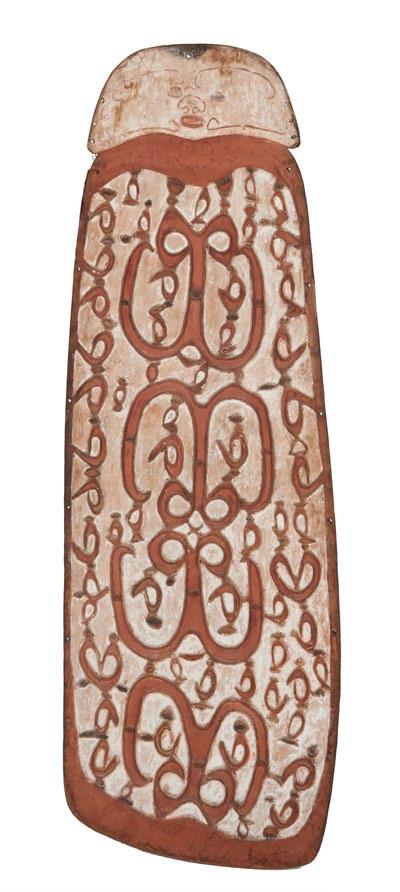
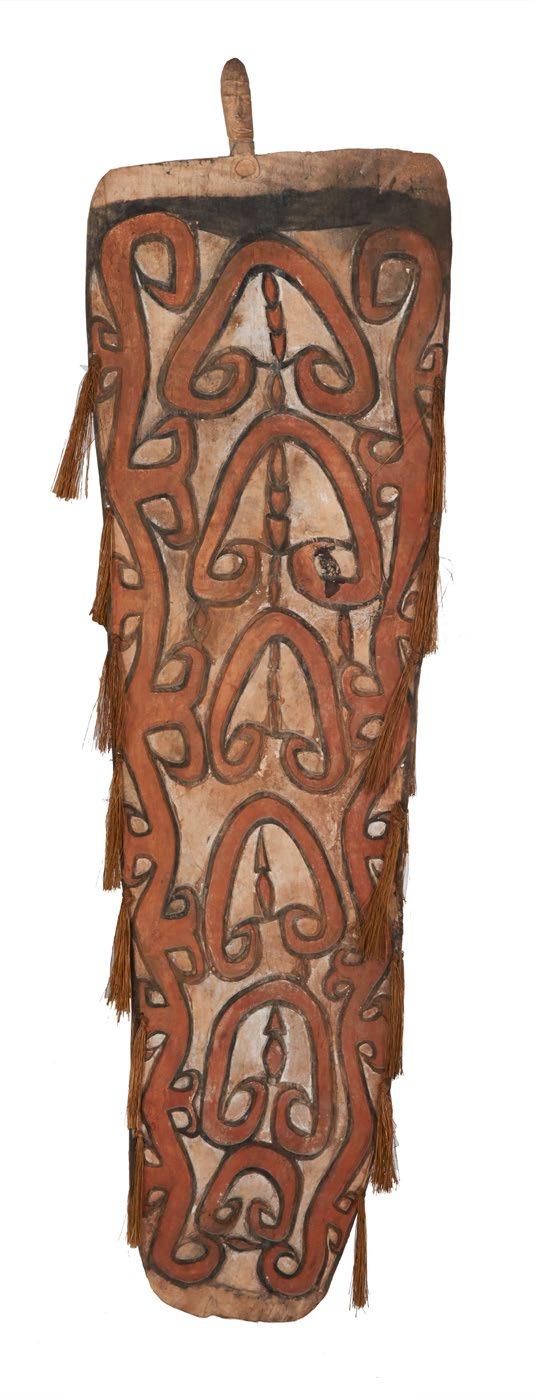
91
An Asmat Shield
Papua Region, Irian Jaya, early 20th century
Vertically oriented wooden shield carved in low relief with symmetrical curvilinear motifs representing ancestral spirits, painted with ochre and kaolin pigments. The upper section terminating in a stylised anthropomorphic face. The reverse side is undecorated with a central grip carved directly into the wood.
119cm height, 65cm wide
PROVENANCE
Collection Dr David Rosenthal, owner of Powell Street Galleries and part owner of Axion gallery in Richmond which later became Christine Abraham's Gallery.
$800–1,200
92
An Asmat Shield
Papua Region, Irian Jaya, early 20th century
Vertically oriented wooden shield carved in low relief and painted with red, white, and black natural pigments. The design features symmetrical curvilinear motifs representing ancestral spirits and protective forces. The upper section is surmounted by a carved anthropomorphic head. The reverse side is undecorated with a central grip carved directly into the wood. Natural fibre attachments.
226cm height, 60cm wide
PROVENANCE
Collection Dr David Rosenthal, owner of Powell Street Galleries and part owner of Axion gallery in Richmond which later became Christine Abraham's Gallery.
$800–1,200
A Rare Hand Coloured Print of
King Tawhiao Māori, Aotearoa, New Zealand, circa 1887
Mounted in a marquetry frame.
27cm height, 19cm wide (not including matt)
$1,000–2,000
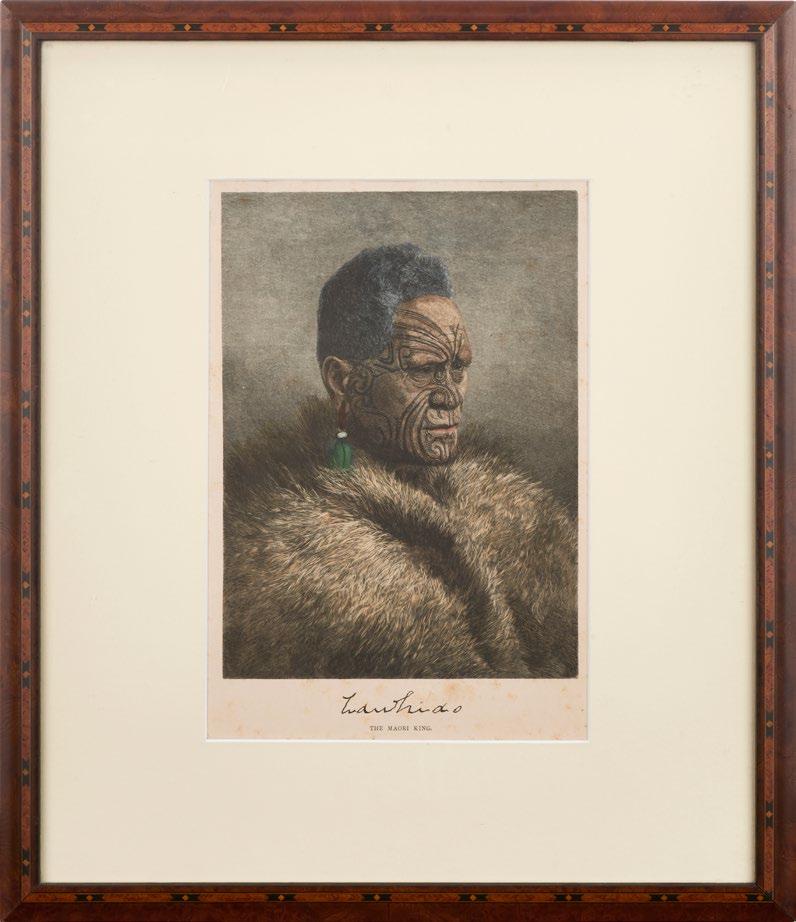


An Inyia-Ewa Spirit Figure
Upper Korewori River, Papua New Guinea, early 20th century
Carved hardwood figure with exaggerated head featuring a beard, prominent forehead, pierced nose, tubular eyes, and open mouth with incised teeth. The elongated body adorned with multiple hooks terminating in a single carved foot. The aged polychrome patina commensurate with age and use.
120cm height
PROVENANCE
Collection John Graham, Melbourne
$4,000–6,000
95
A Torricelli Mask
Sanduan province, Papua New Guinea, early 20th century
Elongated abstract form with blacked finish. 70cm length
$1,200–1,800


96
A rare incised and richly aged hardwood club South East Australia, 19th century
Carved hardwood, tapering spatulate form with rounded end, convex surface with incised interweaving cruciform pattern to both sides, Dark rich patina commensurate with age and use.
63cm length
PROVENANCE
Private collection, Tasmania
$1,500–2,500
97
Two Touraja Sa'Dan Funerary Doors Sulawesi, Indonesia
One with three crouching figures carved in high relief. The door surmounted by a figure wearing a crown. The other with a spirit figure, with head carved in high relief. Fine aged, weathered patina with traces of original pigment.
92 x 44cm, 80 x 42cm
$600–1,200
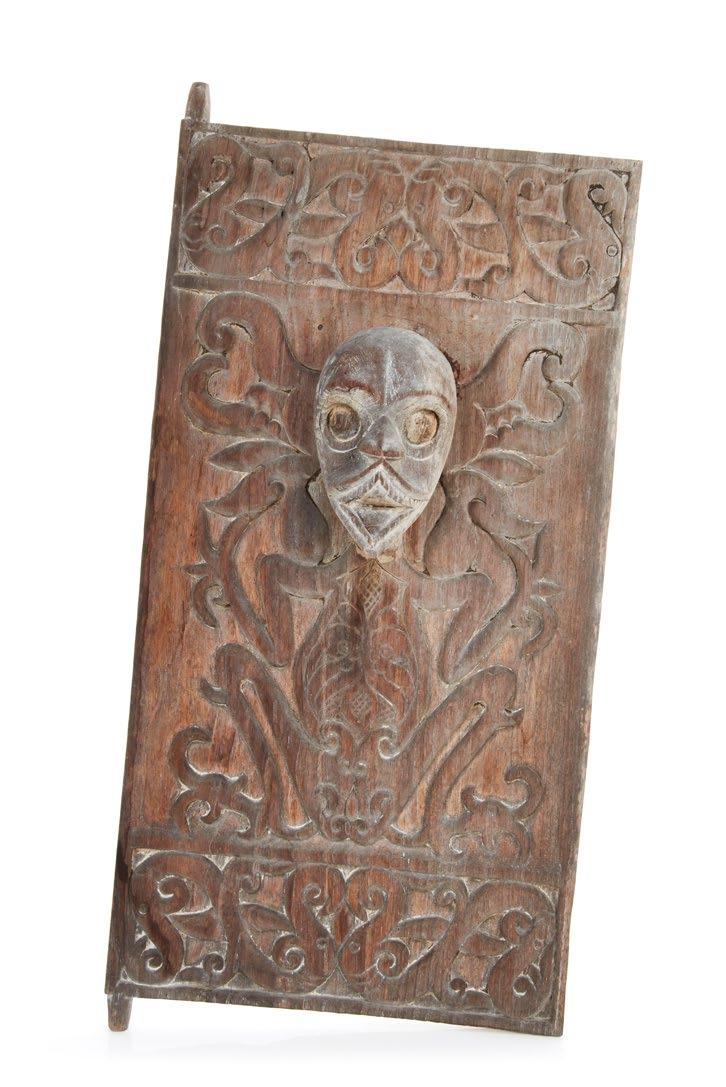
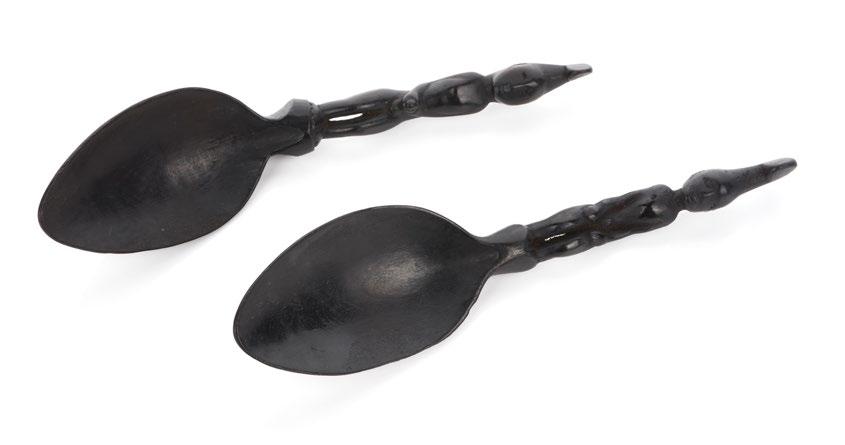
98
A Pair of Ifugao Spoons
Luzon Island, Philippines, 20th century
The handles carved in the form of male and female standing figures.
20cm length
$300–500
99
Two Ifugao Spoons and a Rice Cutter
Luzon Island, Philippines
The handles of each spoon carved with a seated figure with arms crossed. The rice cutter with figural finial.
32cm, 28cm, 23cm length
$350–500
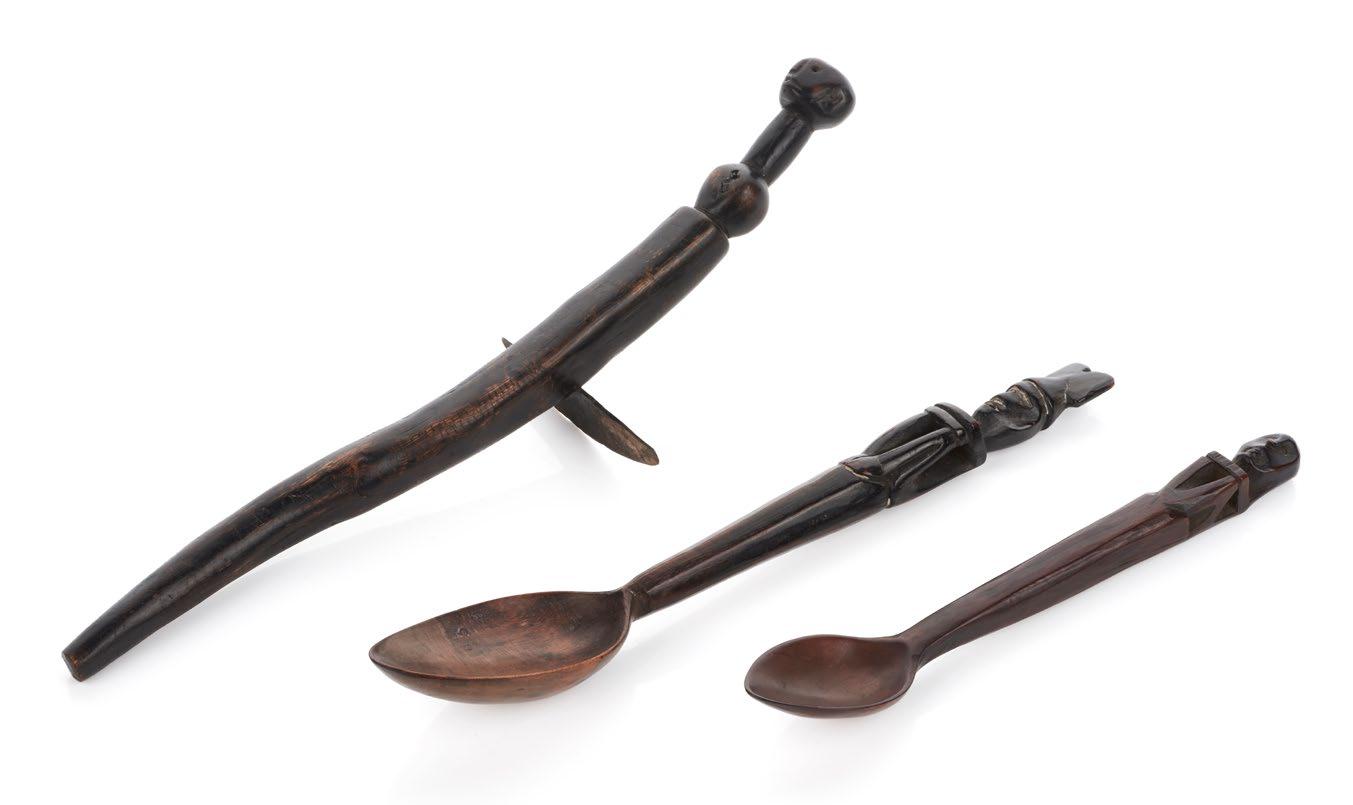
100
An Ifugao Bulul Figure
Luzon Island, Philippines
The figure seated holding a duyu bowl resting on his knees, raised from a plinth base.
45cm height, 14cm wide
PROVENANCE
Private Collection, Melbourne, collected in the Philippines in the early 1990s
$1,400–2,400
101
A Large and Impressive Ifugao Village Rice Spoon
Luzon Island, Philippines, 20th century
With a leaf shaped blade and long slender handle terminating in a bulul rice guardian figure carved in high relief. Rich surface patina. Mounted on a custom-made stand.
170cm height, 8cm wide
$2,000–3,000
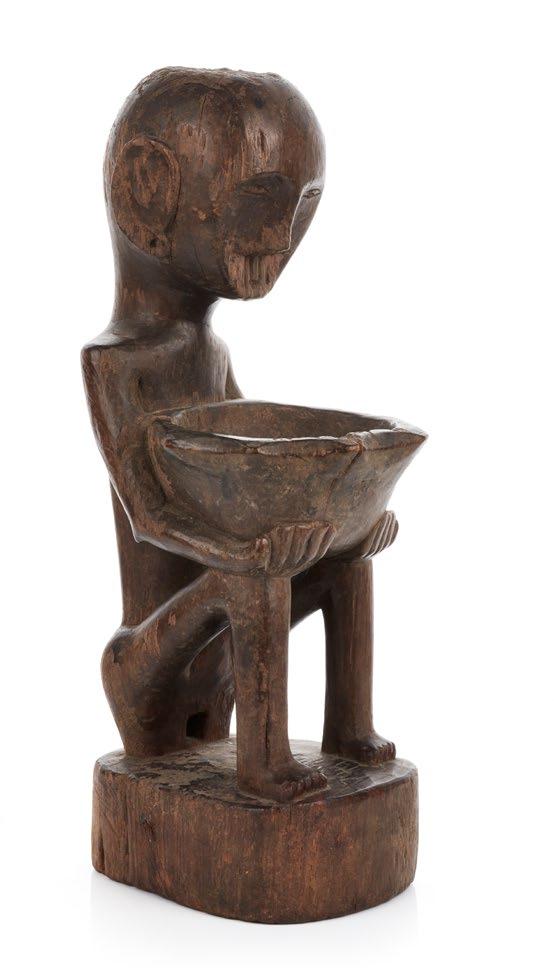


(Detail)

102
A Rare and Unusual Solomon Islands
Postcard
Solomon Islands, 20th century
Hand painted with a warrior's head by Dr Engel Paravacini from the Museum of Natural history in Basel, Switzerland while on a field trip to the Solomon Islands.
The reverse addressed to Mrs. Green and with a personal note to her written by Dr Paravacini. 14 x 10cm
$400–800
103
A Tami Bowl
Tami or Siassi Island, Huon Gulf, Papua New Guinea, early 20th century
Elongated elliptical shape with zoomorphic frigate bird figures carved in high relief to each side.
61cm length, 26cm wide
PROVENANCE
Collection John Perkins, field collected in the 1960s
$500–800
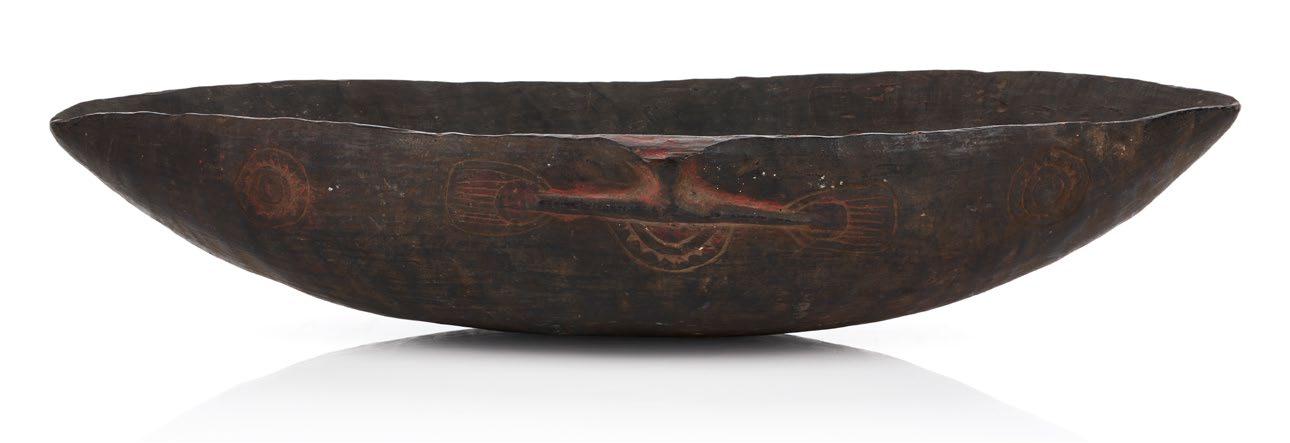
104
Two Ikats
Sumba Island, Indonesian, 20th century
Both featuring geometric patterning, one woven in yellow, brown and russet, the other in yellow, russet blue and pink tones.
180 x 90cm and 180 x 140cm
PROVENANCE
Collection Ian and Marcia Pakes
$300–500
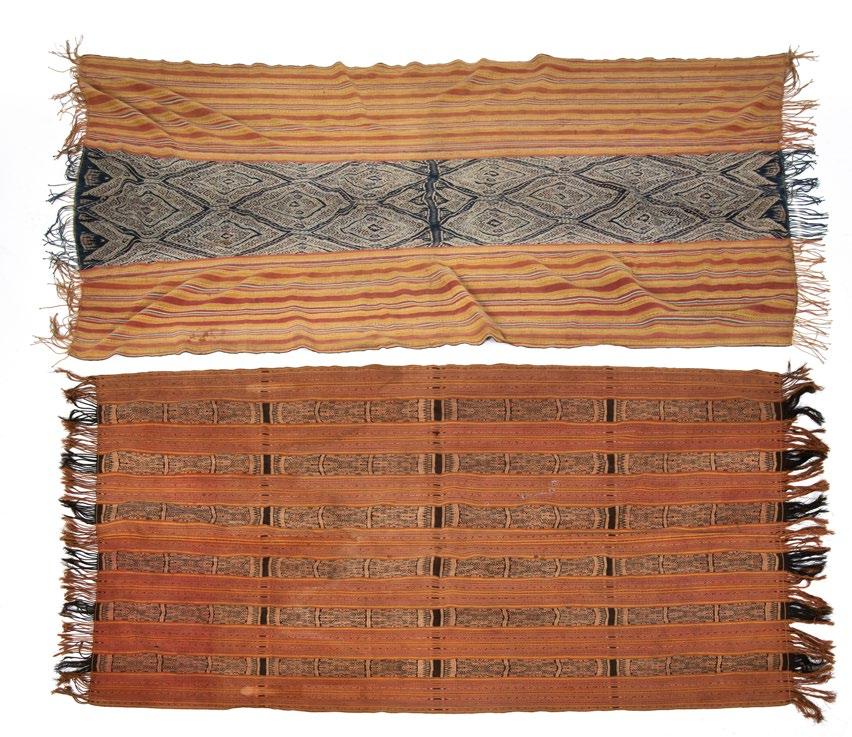
105
Two Ikats
Sumba Island, Indonesian, 20th century
One with animal and geometric designs woven in blue, russet and taupe, the other with geometric designs in muted tones of russet, taupe and mauve.
277 x 96cm (each)
PROVENANCE
Collection Ian and Marcia Pakes
$300–500


106
Three Rare Double Ikat (Geringsing)
Tenganan Pegringsingan, Bali, Indonesia, early to mid-20th century
Cotton, natural dyes, resist-dyed warp and weft.
160 x 21cm, 200 x 52cm and 300 x 76cm
PROVENANCE
Collection of Hans Snell (Indonesia)
Ian and Marcia Pakes collection
Woven in the village of Tenganan Pegringsingan, geringsing textiles are among the rarest and most technically demanding in Southeast Asia. The term geringsing "without sickness”, reflects the cloth’s ritual role in protection and healing.
These three superb examples, dyed in morinda red and iron black, are produced using double ikat technique whereby both warp and weft threads are resist-dyed before weaving, requiring extraordinary precision.
$500–1,000
107
A Double Ikat Patola with Elephant and Leopard Motifs together with an Indian Silk Shawl
Patan, Gujarat, India, 20th century
Silk, natural dyes, resist-dyed warp and weft.
This finely woven silk Patola, produced in the renowned workshops of Patan, Gujarat, exemplifies the technical virtuosity and symbolic depth of India's double ikat tradition.
The textile features alternating motifs of elephants and leopards, rendered in a vibrant palette of lac red and turmeric yellow. Both animals carry layered meanings, sovereignty, protection, fertility, and auspicious force invoked through ceremonial use.
The Indian red silk shawl finely woven with floral designs.
310 x 87 and 260 x 95 (shawl)
In the patola technique, both warp and weft threads are resist-dyed prior to weaving,
requiring months of preparation and precise alignment. The resulting pattern is not applied but embedded. Such textiles were traditionally worn by Jain and mercantile elites during rites of passages.
$300–500
108
An Embroidered Suzani Uzbekistan or Tajikistan, early 20th century
Embroidered and worked in silk thread on a cotton ground, with fruit and geometric designs on a red field.
210 x 185cm
PROVENANCE
Collection Ian and Marcia Pakes
Traditionally made by women as part of a dowry, Suzani textiles adorned walls, beds, and bridal chambers.
$200–400

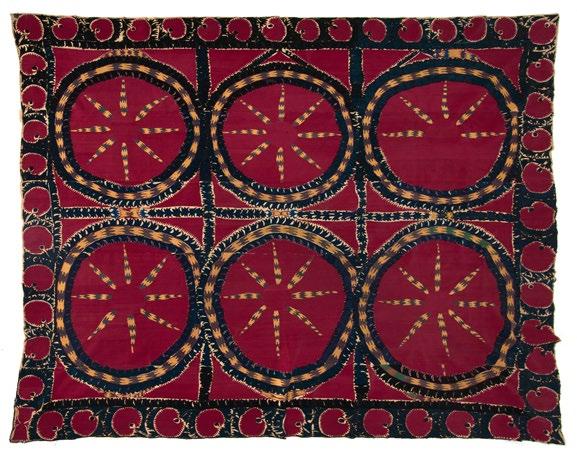
109
A Tampan Ships Cloth Together with A Flores Sarong
Indonesian
The Tampan Ship Cloth with embroidered horse and geometric designs. The Flores Sarong decorated with a stylised floral design. 54 x 62cm and 172 x 60cm
PROVENANCE
Collection Ian and Marcia Pakes
$200–400
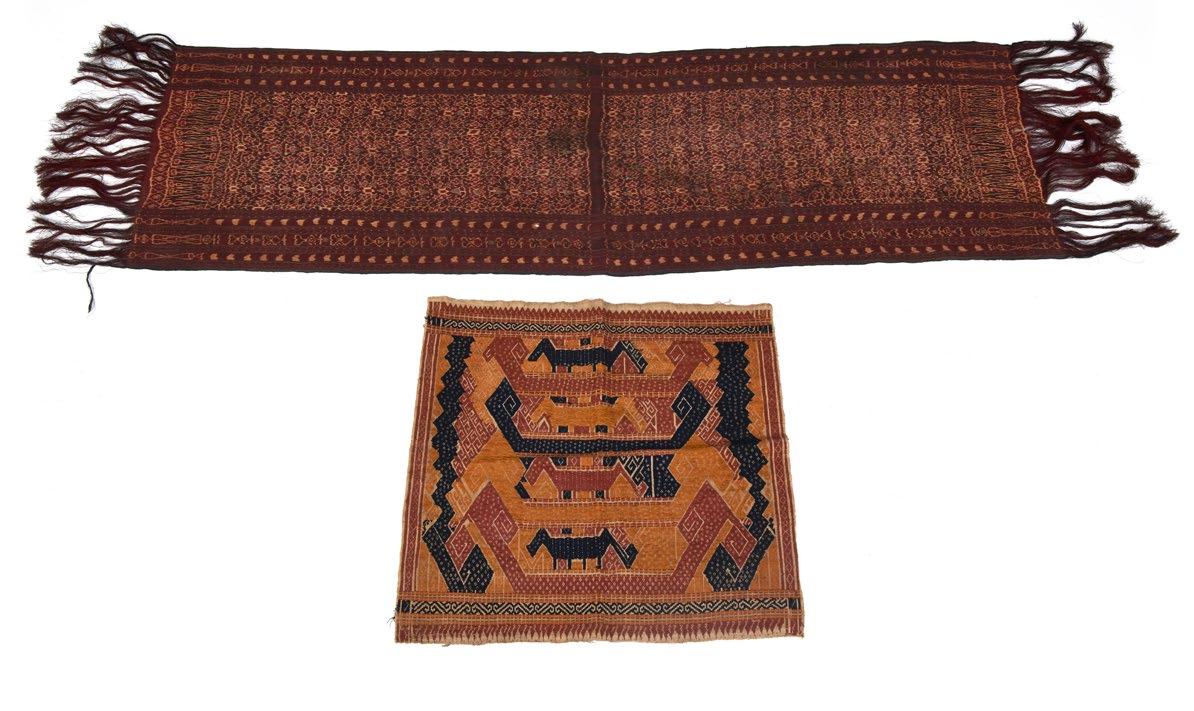
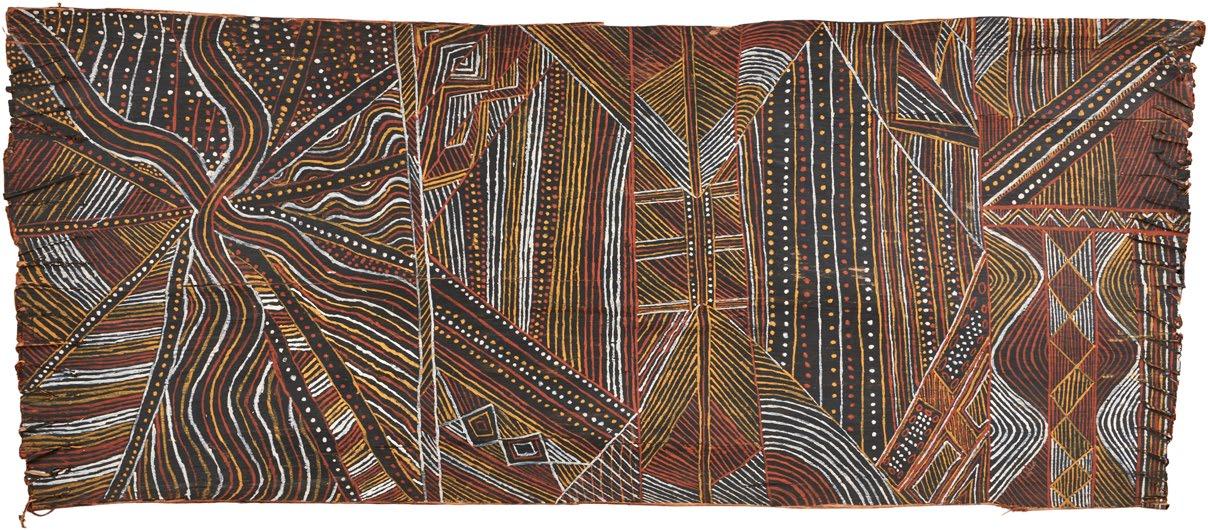

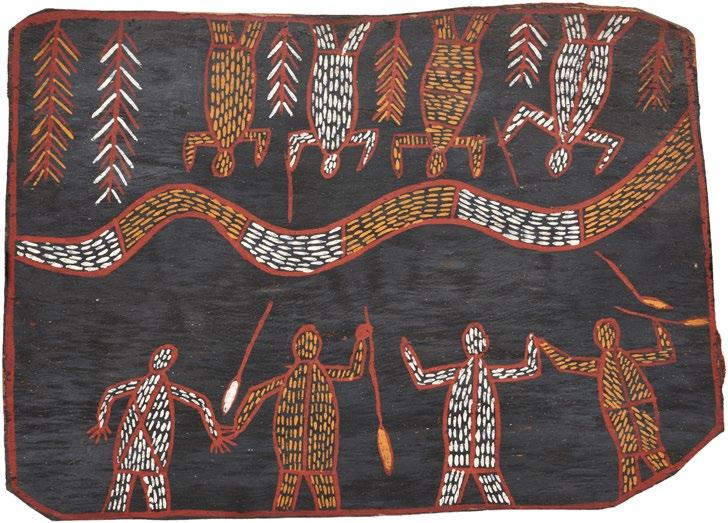
110
MARIE ROSE TIPUNGWUTI
TIWI ISLANDS, AUSTRALIAN, CIRCA 1970
Untitled
natural earth pigments on bark
43 x 101cm
$1,000–1,500
111
ARTIST UNKNOWN
GROOTE EYLANDE, AUSTRALIAN, CIRCA 1960S
figures and ceremonial ground
natural earth pigments on bark
26 x 38.5cm
$1,500–2,500
112
LIPUNDJA GUPAPUYNU
AUSTRALIAN, CIRCA 1912-68
Mokoy figure
natural earth pigments on wood 46cm high
$1,500–2,500
Indigenous art expert Tim Klinginder commented on a related example he once sold: Hoff, J. A., 'Aboriginal Carved and Painted Human Figures in North-East Arnhem Land', in Ucko, P.J., Form in Indigenous Art: Schematisation in the art of Aboriginal Australia and prehistoric Europe, Australian Institute of Aboriginal Studies, Canberra, 1973, pp.156-157
With regard to a closely related figure in the Davidson Collection in the National Museum of Australia Hoff writes: "The carved form of the Mureianas is quite distinctive, being flattened from front to back with very unusual 'notches' in the upper legs. Both the eyes and ears are carved in relief and the shape of the face is noticeably triangular. The legs are much broader than is usual among carved mogwoi figures and the lower legs are not reduced to pointed tips, indicating a departure from traditional ritualuse when they were laced upright in the ground.
'The faces vary from being flattened with a greatly reduced chin to others which have a smoothly curving face and smaller features similar to the head conformation of the Archaic Ganalbingu type.
'The painted decoration of these figures consists of a jiridja sugarbag design on the chest and a yellow outline around the face, while the rest of the mogwoi is painted with a black ground colour.
'All of these Mureiana mogwois were executed by Lipundja I at Milingimbi. While other Aboriginal artists have produced Mureiana figures, it is believed that this distinctive type of Mureiana was developed by Lipundja who rigidly adhered to this artistic formula for the jiridja Mureiana mogwoi." (ibid)
With regard to a related figure Jerome Gould writes, "The diamond design pattern is Jaridja (sic), the sugar bag or wild bee totem. The pointed chin (beard) is suggestive of the bearded Macassam mortuary Tiwi grave poles. The representation here is of Murayana - the cheerful spirit at the mortuary rites ceremony. The happy smile is to cheer up the mourners". (Sotheby's October 20, 2008, lot 76)
113
TONY YUWATI
AUSTRALIAN, BORN 1931
Mokoy figure-circa 1960
natural earth pigments on wood figure 46cm high, 36.5cm high
$1,200–1,800





LEO MELPI
PORT KEATS, AUSTRALIAN, BORN CIRCA 1940
Ceremonial design
Natural earth pigments on stringy bark
98 x 35cm (Irregular)
PROVENANCE
Dr Carmel Gaffney, former lecturer at the University of the Northern Territory, Port Keats, (Wadeye)
Theodore Bruce, Aboriginal and Oceanic Art, lot 9101A, March 2021
Private collection, America
$1,000–2,000 115
ATTRIBUTED TO CHARLIE BRINKEN PORT KEATS (WADEYE), CIRCA 1960S
shark and crocodile
natural earth pigments on bark
58 x 23cm (irregular)
$1,500–2,000
ARTIST UNKNOWN
TIWI ISLANDS, AUSTRALIAN, CIRCA 1960S
Wind Totem
Natural earth pigments on bark
26.5 x 43cm (irregular)
PROVENANCE
D'Lan Davidson, December 15, 2003
Private collection, America
$3,000–5,000


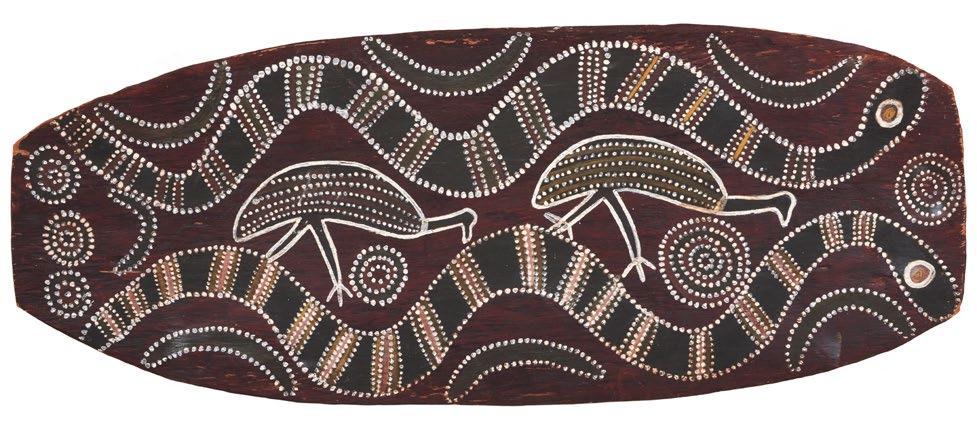
ARTIST UNKNOWN
PORT KEATS (WADEYE), CIRCA 1960S
Ceremonial design
natural earth pigments on bark
62 x 18cm (irregular)
$1,000–2,000
118
ATTRIBUTED TO NYM BUNDUK
PORT KEATS (WADEYE), CIRCA 1904-1974
Emu and snakes and ceremonial ground, circa 1960s
natural earth pigments on bark
63 x 23.5cm (irregular)
$1,000–1,500
ATTRIBUTED
TO NYM BUNDUK
PORT KEATS (WADEYE), CIRCA 1930-1974
Ceremonial design, circa 1960s
natural earth pigments on bark
73.5 x 23.5cm (irregular)
$1,500–2,000

120
ATTRIBUTED TO NYM BUNDUK
PORT KEATS (WADEYE), CIRCA 1903-1974
Ceremonial design, circa 1960s
natural earth pigments on bark
79 x 28cm (irregular)
$2,000–3,000
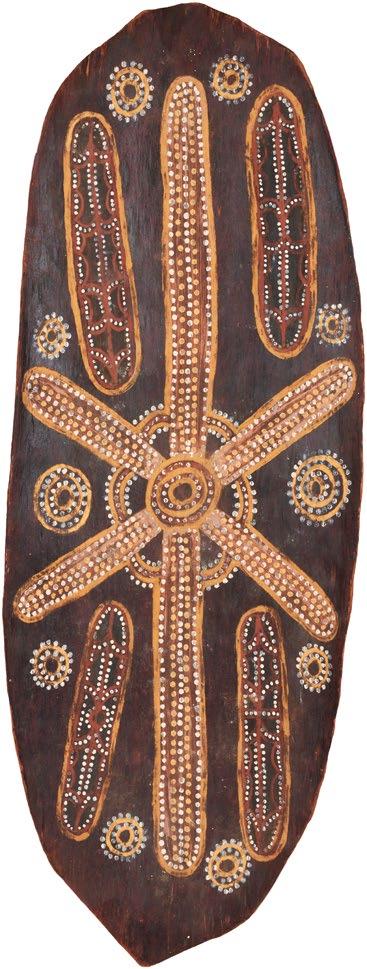
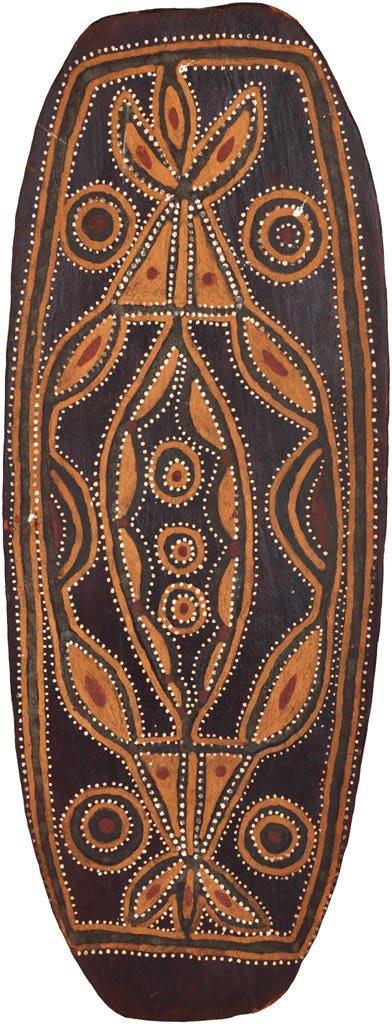
ATTRIBUTED TO NANDABITTA MAMINYAMANDJA
AUSTRALIAN, 1911-1981
Untitled
natural earth pigments on bark
57 x 29cm (irregular)
PROVENANCE
Private collection, America
$1,500–2,000

122
ARTIST UNKNOWN GROOTE EYLANDE AUSTRALIAN, 1960S
Sacred Wind Totem
natural earth pigments on bark
36.5 x 15cm (irregular)
PROVENANCE
Collected in 1969 (per D'Lan Davidson)
D'Lan Davidson, 2003
Private collection, America
$1,000–1,500
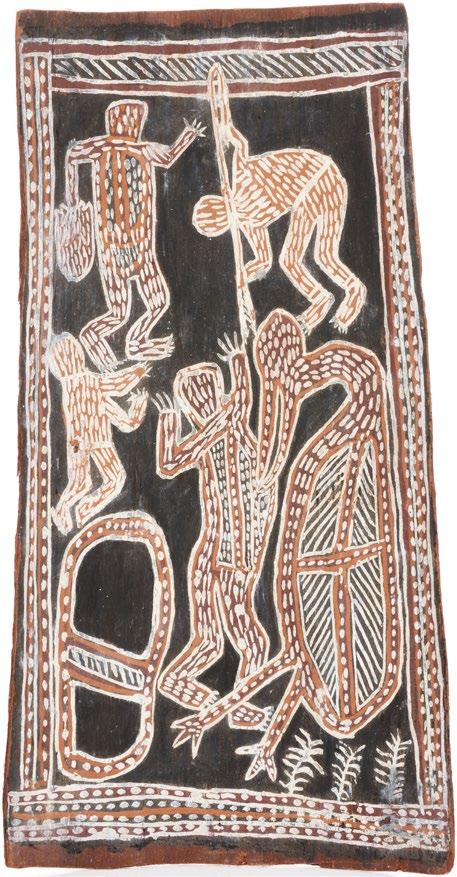
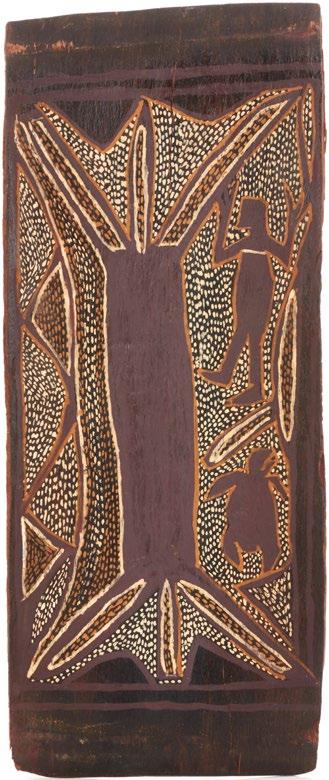
123
JIMBO DOWORNULIMJURA
AUSTRALIAN, CIRCA 1960S
Untitled
natural earth pigments on bark
Text on back reads: "Tribe: Jinang from the area south of Milingimbi. Two men carrying bones in their hand near a pandanus area, which is their dreaming" 45 x 22cm (irregular)
PROVENANCE
Private collection, America
$1,500–2,500
124
JACK DOCHERTY
AUSTRALIAN, BORN CIRCA 1945
Saw Fish Design
natural earth pigments on eucalyptus bark 71 x 29cm (irregular)
PROVENANCE
Bulkrum, Northern Territory
Bonhams, The Clive Evatt Collection of Aboriginal Barks and Sculpture, lot 9, Nov. 2013, Sydney
Private collection, America
Reference on the back: AAC147, N339
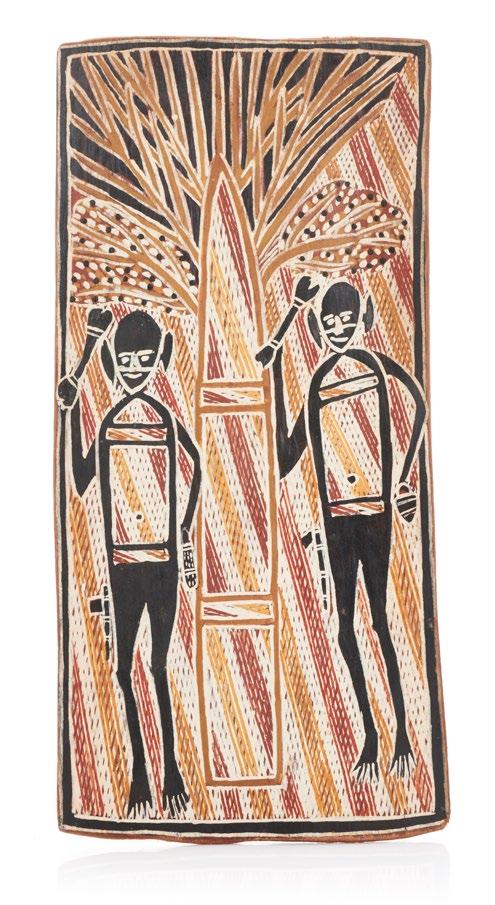
The abstract design is represented in a dance performed during the initiation rites ceremony. This dance which imitates the sawfish swimming against the current up Banyun Creek, the cross-hatched rectangles represent the creek and its currents. The two white triangles with attached serrated teeth symbolize the sawfish snout. This design illustrates the bodies of the dancers.
$1,000–1,500

ARTIST UNKNOWN
AUSTRALIAN, CIRCA 1960
Long-necked turtle, natural earth pigments on bark
79 x 54cm
$1,500–2,500 126
ARTIST UNKNOWN
MILINGIMBI, AUSTRALIAN, CIRCA 1960S
Lizards, leaves and raark
natural earth pigments on bark
64 x 35cm (irregular)
PROVENANCE
Private collection, America
$1,000–1,500
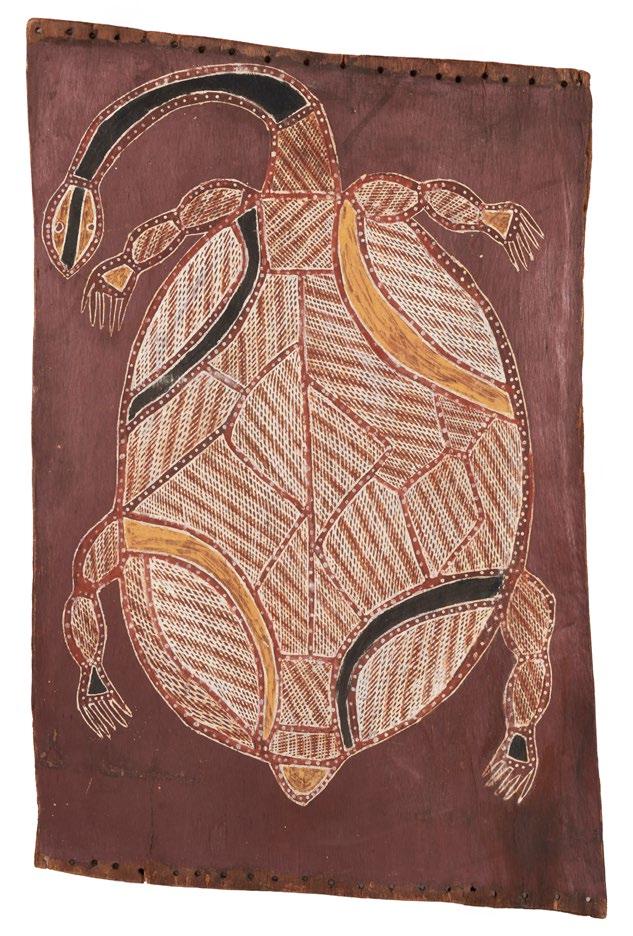
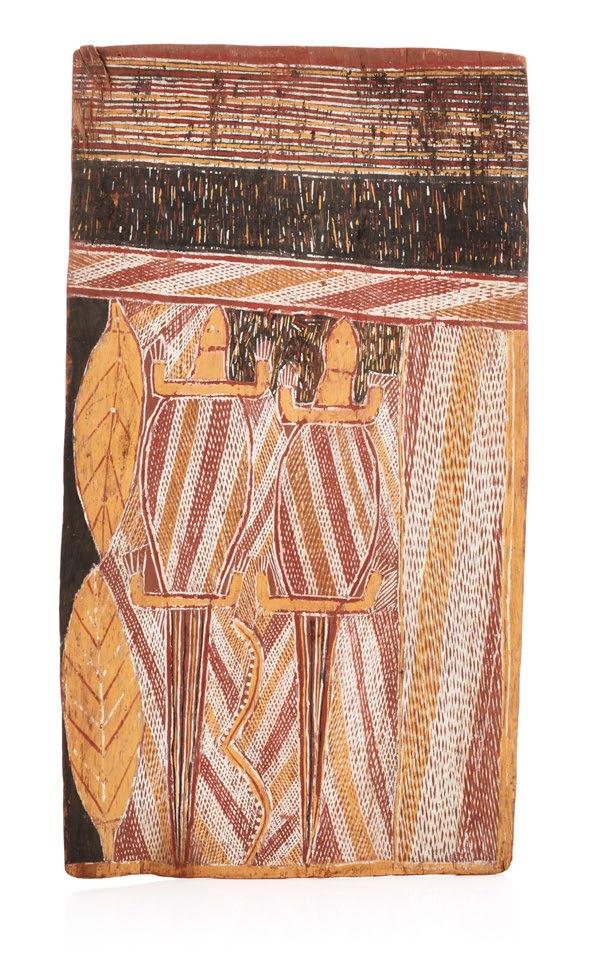
127
DAWIDI MILINGIMBI
AUSTRALIAN, (1921-1970)
Wagilak Sisters Story
natural earth pigments on eucalyptus bark glued to plywood backing circa 1970s
78 x 24cm
PROVENANCE
Collection John Graham, Melbourne
$3,000–5,000

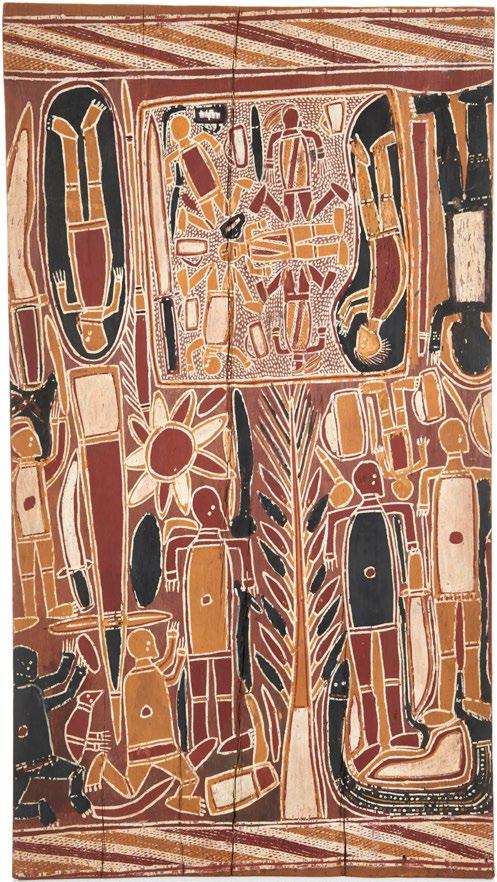
128
JACK KALAKALA AUSTRALIAN, 1925 - 1987
Ceremonial Design, circa 1980
natural earth pigments on bark
72 x 40cm (irregular)
PROVENANCE
Maningrida Arts & Crafts, Northern Territory
Private Collection
Lawson Menzies, Fine Aboriginal Art, lot 314, Sydney, May 2005
Private collection, America
$1,500–2,500
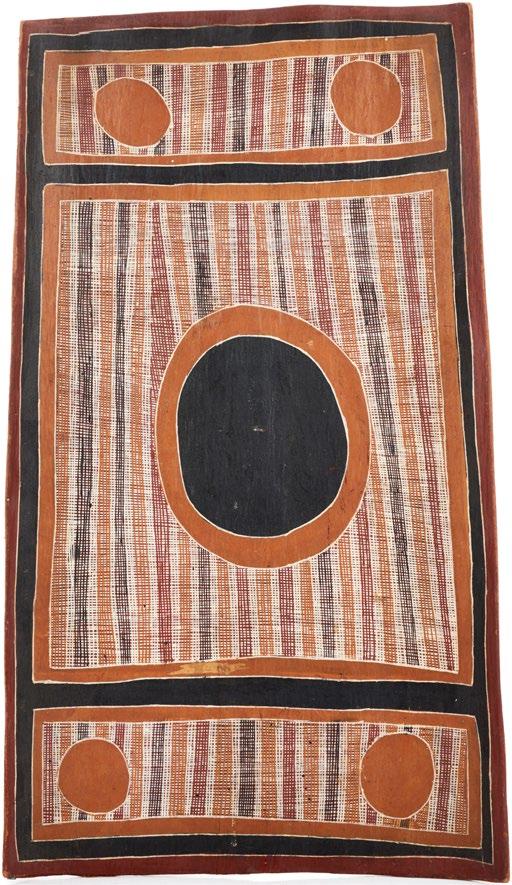
129 TOM DJAWA
AUSTRALIAN, 1905-1980
Goanna Dreaming, circa 1964
natural pigments on bark
Rev.: Djawa, 1964 (Gaywurrwurr, Yirritja), also sets out story and description
35 x 24cm (irregular)
PROVENANCE
Collection of Jim Davidson
Purchased from D'Lan Davidson
Private collection, America
$1,500–2,500
Rev.: Djawa, 1964 (Gaywurrwurr, Yirritja), also sets out story and description
This painting depicts a portion of the Yirritja Narra ceremony. The story represented tells of a great drought that took place when the Goanna people had the form of goannas. There was no water left for anyone to drink, so the Goanna people dug down into this pebbly ground seeking water. The Turtle people and Caterpillar people had already dug deep into the pebbles.
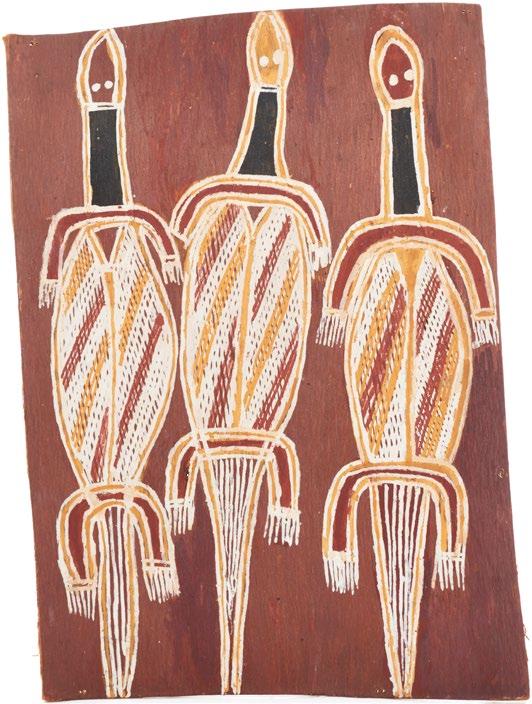
"The goannas dug deeper into the pebbles until they encountered a rock barrier bar below the surface. As soon as they touches this barrier, the goannas turned into stone. These goanna shaped rocks can be seen at this sacred site today, and is the 'dreaming' of the Gaywarrwarr Clan.
Reference on the back: A47, 2600K/6 A50
Tom Djäwa was the undisputed leader of Yolngu people at the small island community of Milingimbi in Arnhem Land from the early 1950s. He was the accepted Gupapuyngu Daygurrgurr clan leader at the time, but also wielded influence over others. As explained by Louise Hamby and Dr Gumbula, Djäwa’s son: ‘Djäwa was a wayirri watangu, hereditary owner in Yolngu law for Milingimbi. His mother was Djambarrpuyngu and his grandmother was Walamangu. This was a contributing factor to Djäwa remaining at Milingimbi and partially a rationale for his accepted leadership.’ In this position Djäwa was responsible for mediating between the Yolngu community and the mission staff, as well as providing extraordinary hospitality to visitors.
Djäwa’s rise in power coincided with the establishment of Reverend Edgar Wells as the mission superintendent and the two worked together to ensure the stability of the community. They became close friends, and their collaboration and mutual respect led to a large number of highquality artworks being created within the community. Wells noted that Djäwa used his interest in the arts ‘to his own advantage and invited clan leaders from other areas to visit Milingimbi and take part in various ritual activities’, as he sought to strengthen his position within the region. Such was their friendship that towards the end of their time in Milingimbi the Wells would often invite Djäwa and Wangurri man Baraltja to their sitting room for an ‘informal evening visit’ and to view slides of artworks. Wells’ wife Ann remembers that, in doing so, Djäwa ‘could tell the story of each thing as it appeared – where it was made, of which clan it was the emblem, when it would be used, and nearly always the artist who had made it. His memory was amazing when it came to lore and legends of his folk’.
Djäwa valued the interest and respect he was shown by balanda (whitefellas) in matters of culture and Yolngu life, and it is telling that he worked with so many visitors who made their way to Milingimbi for a variety of reasons. He clearly saw the benefit in sharing his unique expertise and world view with interested parties and records of such collaborations provide an image of a figure who looms larger than life, someone revered within the community and deeply respected outside of it.
Djäwa had lead roles in two documentary films made by Cecil Holmes, Faces in the sun 1963 and Djalambu 1964, which offers a re-enactment of the final burial ceremony for his father, Narritjnarritj. He also appeared in a documentary on bark painting made by the American collector Edward Lehman Ruhe, who visited Milingimbi in 1972. Djäwa worked with teacher and linguist Beulah Lowe and assisted numerous anthropologists who visited the island, including Ronald and Catherine Berndt and Ian Keen. The Czech artist Karel Kupka spent a considerable amount of time at Milingimbi between 1956 and 1973, and such was the partnership they established that Kupka came to consider Djäwa a brother, with Djäwa defining Kupka as the ‘white black fella’.
In 1954 Djäwa was among a group of six men from Milingimbi who travelled to Toowoomba to dance for Queen Elizabeth II. Ann Wells felt that for Djäwa this ‘was a treasured and instructive journey into a new world’. In stark contrast to this event and to his position within the
community, Djäwa was tasked with completing fencing as part of his mission duties.
Over a 30-year period Djäwa painted on bark and made painted and incised wooden sculptures for the market, which are now held in collections across the world. His paintings vary from sparse compositions with beautifully rendered animals through to intricate, jewel-like works dominated by elegant geometric patterning and complex compositions that reflect his ceremonial seniority. Common in his work is the division of the composition into two sections, with a defined band transecting horizontally. His works also detail specific family responsibilities and connections.
Art from Milingimbi: taking memories back, Art Gallery of New South Wales, Sydney 2016.
130
LENA KURRINIYA MANINGRIDA, AUSTRALIAN, CIRCA 1970
Two Mimih figures
natural earth pigments on bark 42 x 20cm and 42 x 19cm
$1,000–1,500

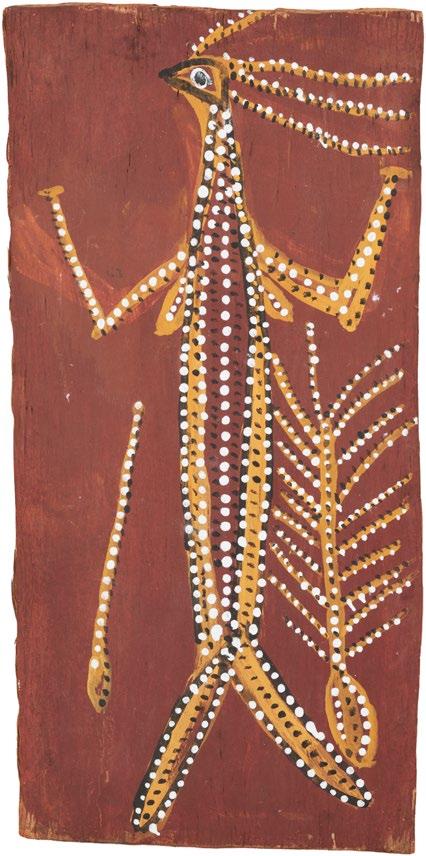

WALLY MANDARRK
AUSTRALIAN, CIRCA 1915-1987
Mimih and fish circa 1960s
natural earth pigments on bark
62.5 x 22cm (irregular)
$1,200–1,800


132
ARTIST UNKNOWN
AUSTRALIAN, CIRCA 1960
Mimih spirit with spears and a dilly bag
natural earth pigments on bark
78 x 42cm
$800–1,200
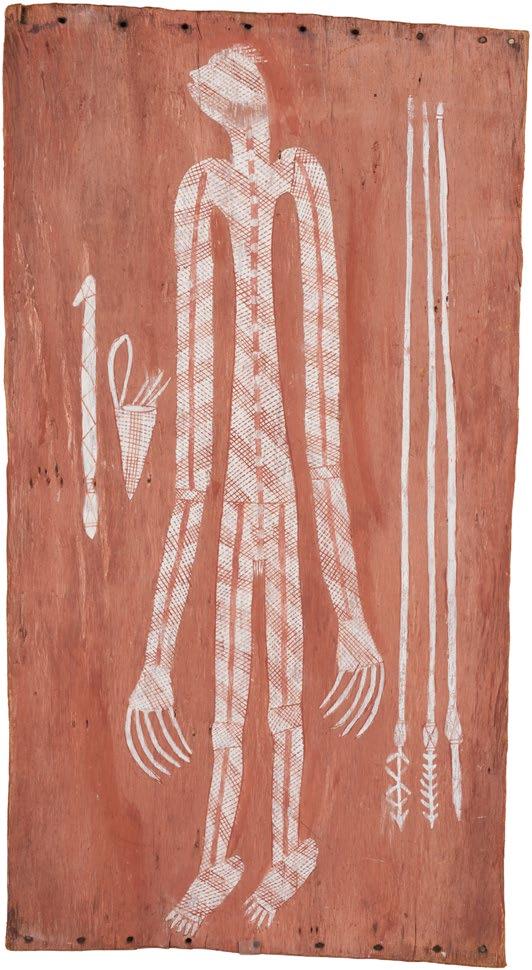
ARTIST UNKNOWN
WEST ARNHEM LAND, AUSTRALIAN CIRCA 1960S
Wallaby and a waterbird with a dilly bag and other tools
natural earth pigments on bark
54.5 x 37cm
$1,000–1,500
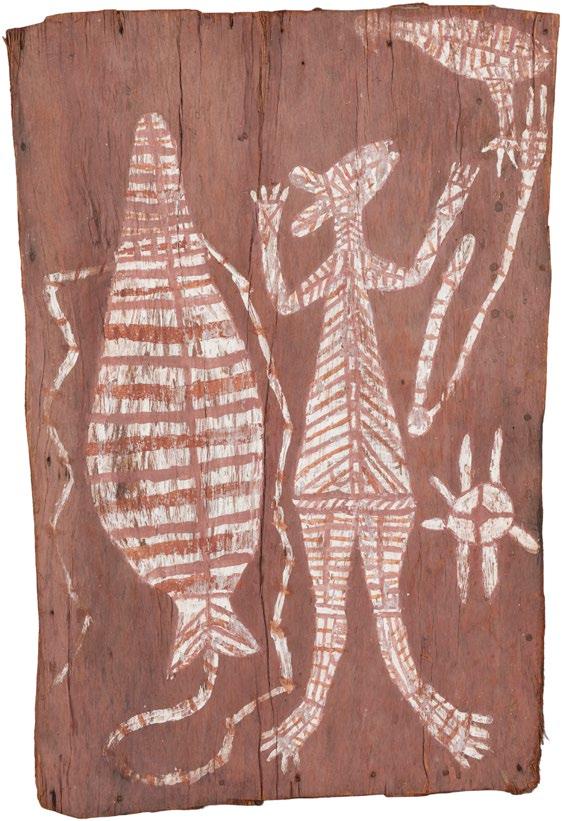
134
JACK NAYINGGUL AUSTRALIAN, CIRCA
1940-2012
natural earth pigments on bark
53 x 28cm
$1,000–1,500
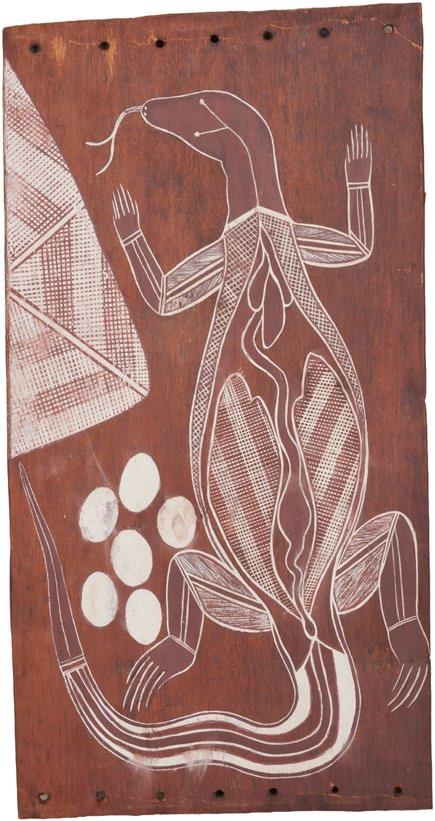
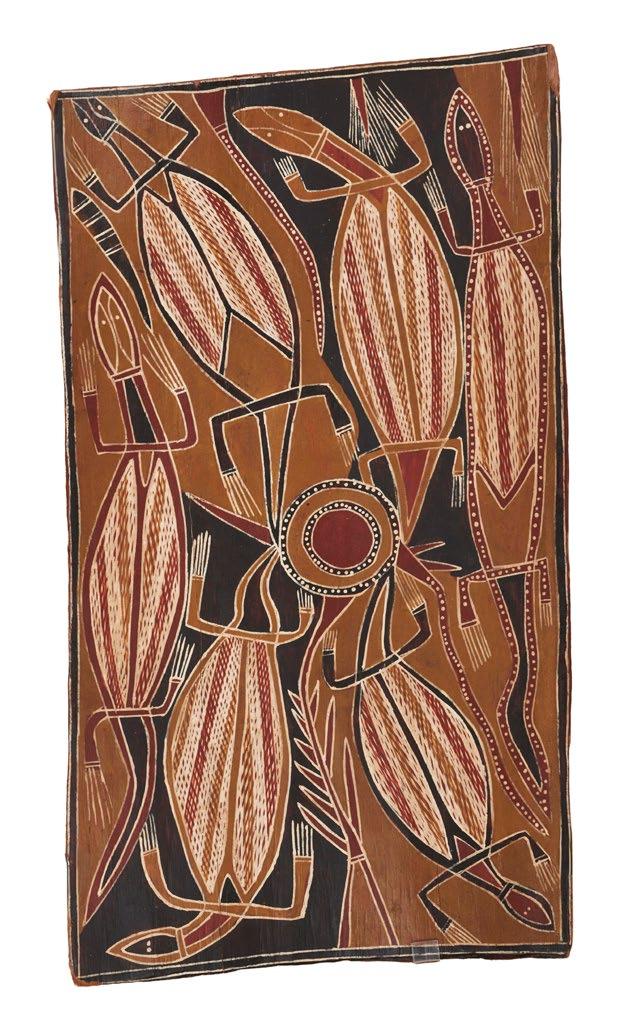
135
PETER BANJURLJURL
AUSTRALIAN, CIRCA 1960S
Goanna's and waterhole
natural earth pigments on bark
58 x 33cm
$600–1,000
136
JACK WUNUWUN
AUSTRALIAN, 1930-
Flying fox or Mega-bats
natural earth pigments on bark
84 x 32cm
$1,500–2,000
Jack Wunuwun was born 1930, Gamardi, east Arnhem Land, Northern Territory. Lived Gamardi, east Arnhem Land. Died 1990, Darwin. Djinang/ Murrungun language.
Jack Wunuwun’s practice focused on the creation of bark paintings that not only engaged with his Aboriginal heritage, but also interacted with elements of European art practice. In particular, Wunuwun’s use of perspective and three-dimensionality was incredibly innovative. Wunuwun viewed art as a means to achieve reconciliation between Indigenous and non-Indigenous Australians, and this philosophy is inherently reflected in his art.
Wunuwun’s work has been displayed in several group exhibitions, including Old Masters: Australia’s Great Bark Artists, National Museum of Australia, Canberra (2014); Stories, from the Holmes à Court Collection, Sprengel Museum, Hannover (1995); Aratjara: Art of the First Australians, Kunstsammlung Nordrhein-Westfalen, Dusseldorf (1993), touring Europe (1993–1994); Magiciens de la Terre, Centre Georges Pompidou and Grande halle de la Villette, Paris (1989); and Artists of Arnhem Land, Canberra School of Art, Australian National University, Canberra (1983).
Wunuwun’s work in held in a number of collections, including the Homes à Court Collection, Perth; Museum of Contemporary Art Australia, Sydney; and National Museum of Australia, Canberra.
Jack Wunuwun’s land is Mewirnbi, on the eastern side of the Blyth River near Cape Stewart in the Northern Territory. He was born in 1930 at around the time that the Australian Government declared Arnhem Land an Aboriginal reserve. He belongs to the Gangarl (Gang-ngal) clan of the Murrungun people of the Dhuwa moiety. Their Wanggarr (original creative spirits) are the Djang’kawu Sisters, the Morning Star and Shark spirits, and the fish trap.
Wunuwun’s paintings Barrdje bunpa (Yams and butterflies) (1988) and Fish trap story (1985–1987) show the wonderment of seasonal change at the end of the wet season, when fruit and yams ripen, flowers bloom and insects flourish. The fish trap is regarded as an entity itself and has a site on a creek to the eastern side of Mewirnbi. Young fish are considered the souls of unborn people and the fish trap is thought of metaphorically as a womb.
As a child Wunuwun moved with his parents to the Methodist mission on nearby Milingimbi Island, where he grew up. During World War II he gravitated to Darwin where he worked as a cook’s assistant in an Australian Army camp. After the war, authorities returned a number of Central Arnhem Land people from Darwin to begin a new settlement at Maningrida. Wunuwun returned in the 1960s and began to make art, including sculptures and paintings for the growing number of balandas (non-Aboriginal people) who came to work at the settlement. He made wooden spirit figures in near-human form and scale, and moved to painting full-time in around 1968 under the tutelage of his older brothers. The growing numbers of balandas irritated many local Aboriginal people across Arnhem Land and around Australia, who then moved from settlements and missions to establish ‘homelands’ on their traditional spiritual clan estates. With his brother-in-law, the artist Johnny Bulun Bulun, Wunuwun moved to Gamedi on the eastern bank of the Blyth River (his mother’s land) adjoining Mewirnbi. (It was here that he was filmed for Curtis Levy’s 1980 documentary Morning Star painter, narrated by the actor David Gulpilil.)
In 1978–1979 Wunuwun was appointed to the Aboriginal Arts Board of the Australia Council. It was in this period he met the south-eastern Aboriginal painter and fellow arts board member Lin Onus who, from 1986 onwards, began to visit Gamedi almost annually. They enjoyed their interaction and influenced each other’s work.
Referenced to Djon Mundine OAM who is an independent Bandjalung curator, writer and sometimes artist.
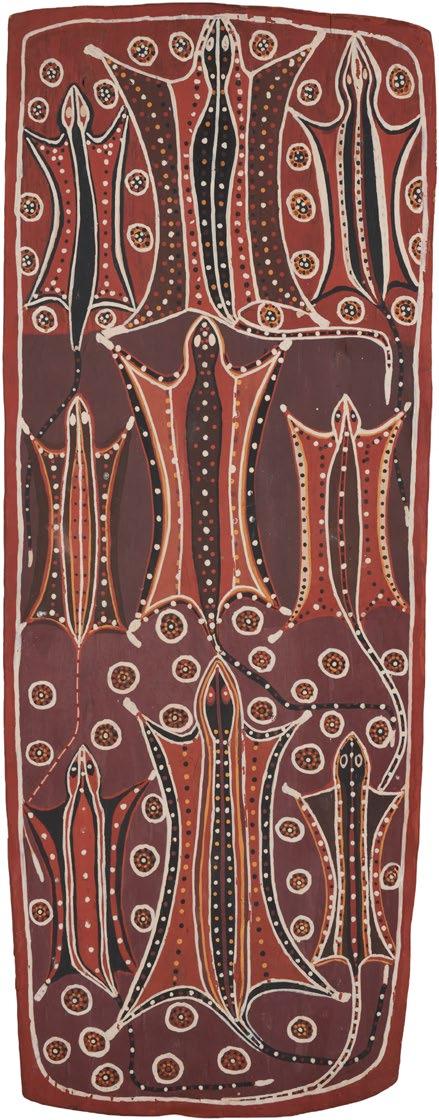


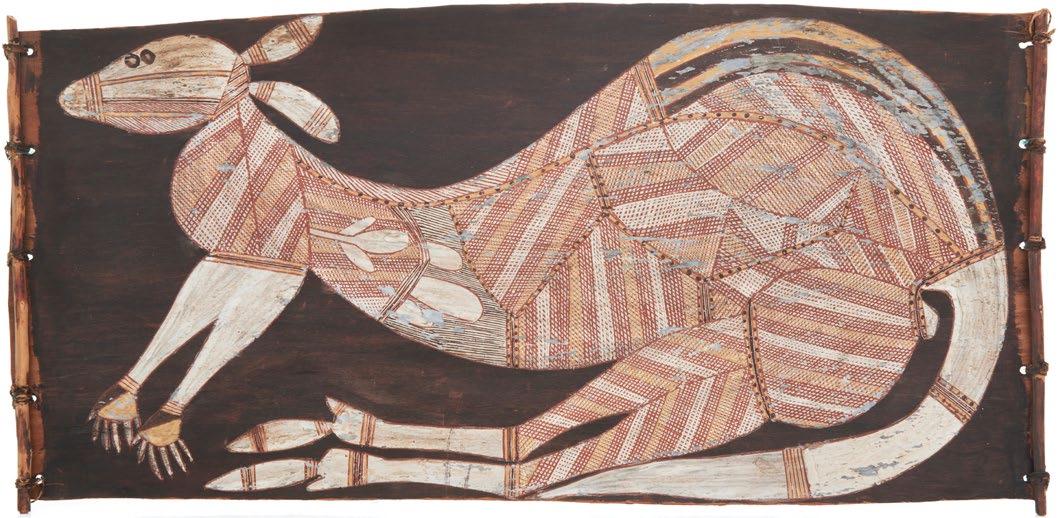
137
JIMMY NJIMINJUMA
AUSTRALIAN, 1945-2004
Namarnkol (Barramundi), 2001
natural earth pigments on bark
30 x 57.5cm
PROVENANCE
Maningrida Arts & Culture, cat. no. 3452001BP
Redback Art Gallery, Queensland Private collection, America
$800–1,200
138 YUWUNYUWUN (ATTRIBUTED) MURRAWARR
OENPELLI, AUSTRALIAN, (C.1928-1979)
Kangaroo
natural earth pigments on eucalyptus bark circa 1960s
75 x 37cm
PROVENANCE
Collection John Graham, Melbourne
$1,500–2,500
139
ARTIST UNKNOWN
OENPELLI, AUSTRALIAN, CIRCA 1960S
Snake and Echidna
natural earth pigments on eucalyptus bark
Bark Painting
72 x 55cm
PROVENANCE
Collection John Graham, Melbourne
$2,500–3,500
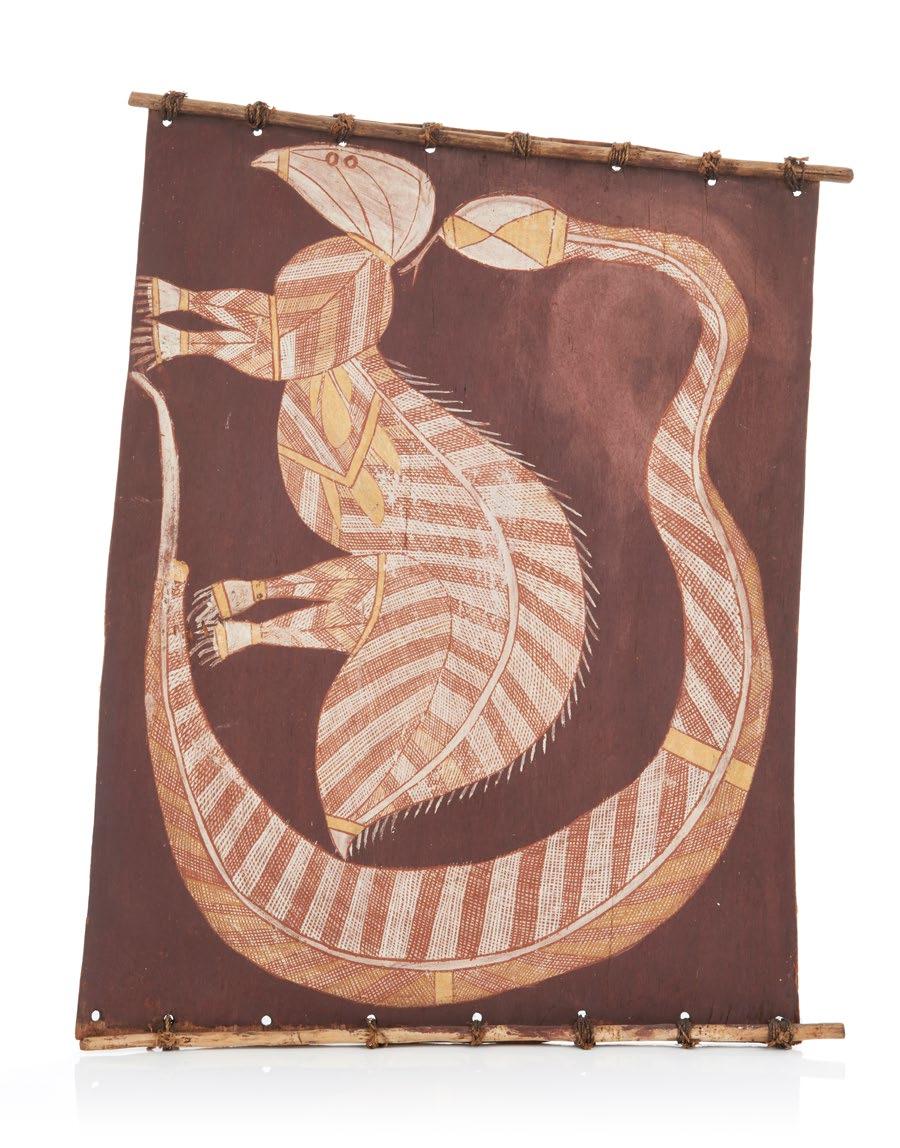

140
IVAN NAMIRRKKI
MANINGRIDA, CIRCA 1960S
goanna
natural earth pigments on bark
83 x 28cm
PROVENANCE
From the R.C. Brictson Museum collection. Exhibited at the San Diego Museum of Man, as well as other venues.
Addressed directly by R.C. Brictson in his lecture circuit.
Private Collection Melbourne
$1,500–2,000
141
JABARRGWA (KNEEPAD) WARRABADALUMBA (ATTRIBUTED)
GROOTE EYLANDE, AUSTRALIAN, 1896-1975
West Wind, 1960s
natural earth pigments on bark
60 x 33cm (irregular)
PROVENANCE
Private Collection, Queensland
Deutscher & Hackett, Lot 258, 2009
Private collection, America
$1,000–1,500
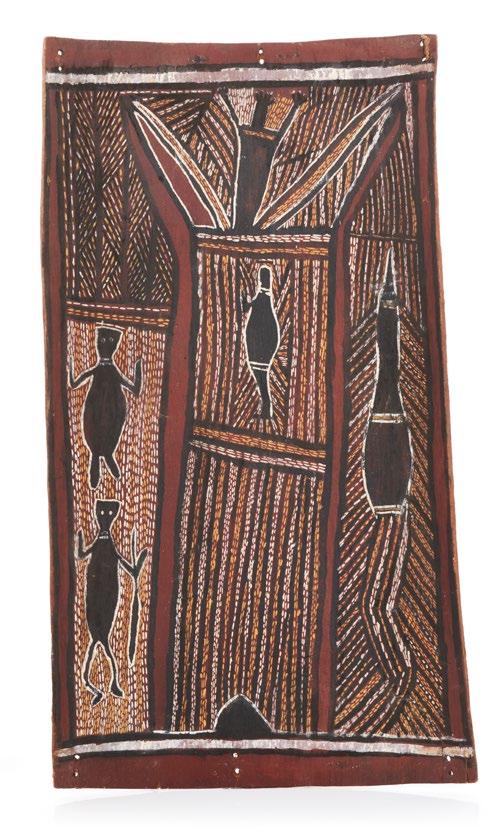
142
NEVILLE MARDDAY
AUSTRALIAN, (B.1932)
Two Mimih spirits
natural earth pigments on eucalyptus bark label affixed verso.
45 x 23cm
$1,000–1,500
143
SADLER MILIDJIDJI
OENPELLI AUSTRALIAN, CIRCA 1960S–70S
Rainbow Serpent and Mimi
natural earth pigments on eucalyptus bark Murrawarr Bark painting.
121 x 43cm
PROVENANCE
Collection John Graham, Melbourne
$2,000–4,000

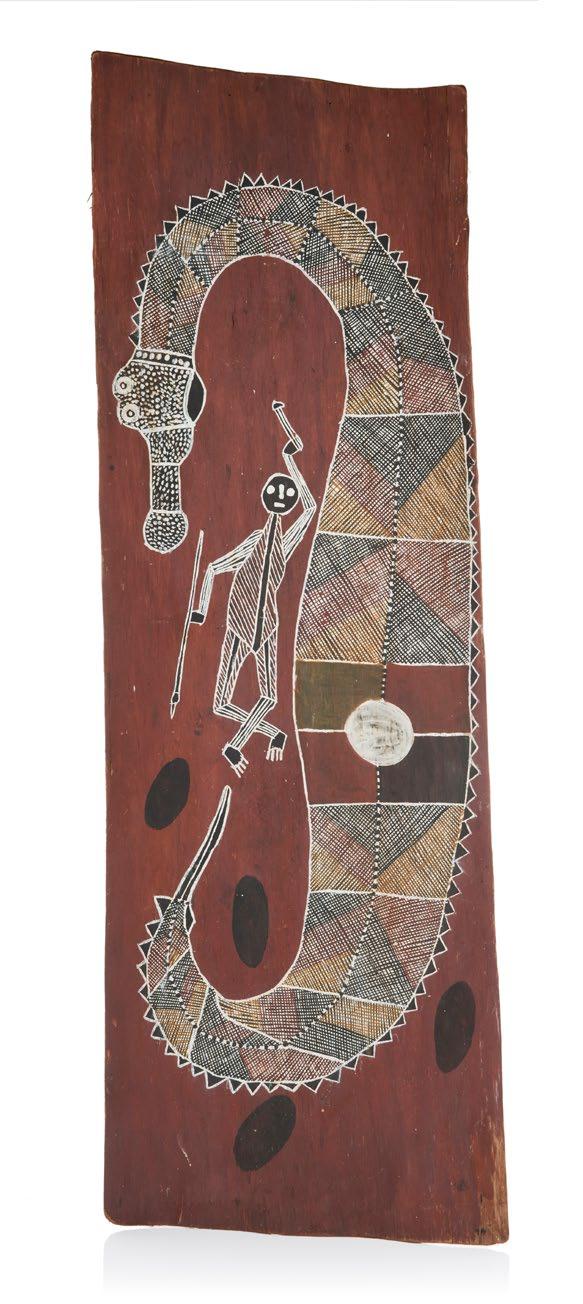
BOLINY WANAMBI
AUSTRALIAN, 1957-2011
Untitled
natural earth pigments on bark
91 x 41cm
Boliny Wanambi (1957-2011) was a contemporary Aboriginal Australian artist from North East Arnhem Land, known for her work with natural ochres on bark, lino-cuts, and ceramics. As a member of the Marrakulu people, she created art reflecting Yolngu culture, which has been exhibited and sold in numerous shows and galleries, notably Annandale Galleries in Sydney
$1,500–2,000

145
MERVYN ROUGHSEY
MORNINGTON ISLAND, AUSTRALIAN, 1970S
Fisherman, birds and fish
natural earth pigments on bark 60 x 25cm (irregular)
PROVENANCE
Private Collection USA
$600–1,000
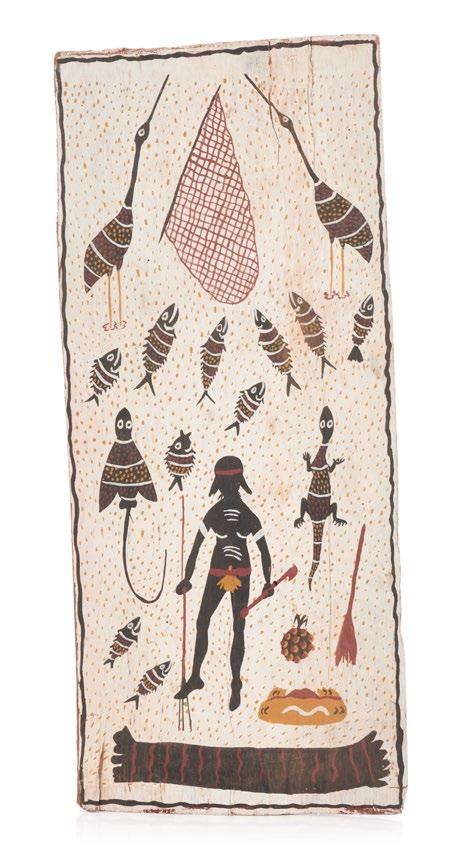
ATTRIBUTED TO JIMMY MIDJAWMIDJAW
AUSTRALIAN, 1897-1985
Kangaroo
natural earth pigments on eucalyptus bark
Attribution given by Tim Klingender formerly of Sotheby's, Australia. An unusual label affixed verso notes that the kangaroo was "cooked and eaten by the old lady".
78cm height, 43cm wide
PROVENANCE
Purchased at the Phyllis Patten Estate sale
Private Collection, Melbourne
$2,000–4,000

147
ARTIST UNKNOWN
AUSTRALIAN, CIRCA 1960S
Morning star pole
natural earth pigments on bark numbered 22-78-45A #16 A55
67 x 18cm (irregular)
PROVENANCE
Private Collection USA
$1,000–2,000
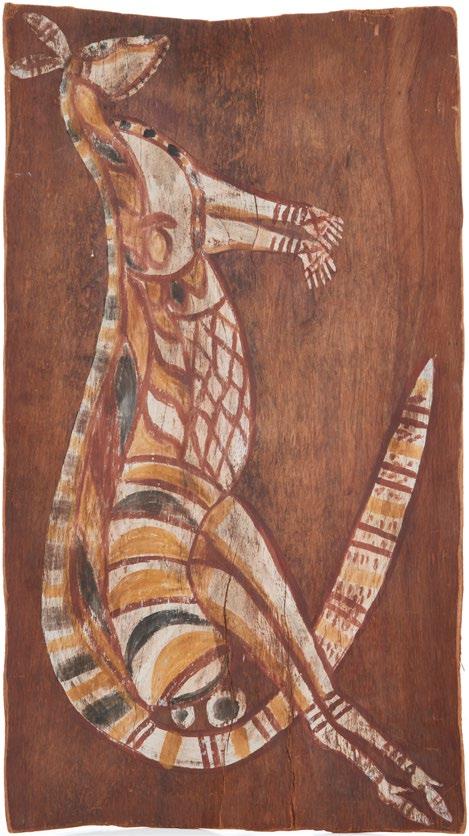

148
A large and Impressive hardwood Fighting Boomerang 19th century, South Australia
Decorated with incised designs across the surface.
117cm length
PROVENANCE
Collection Alan Myren, South Australia
$800–1,600
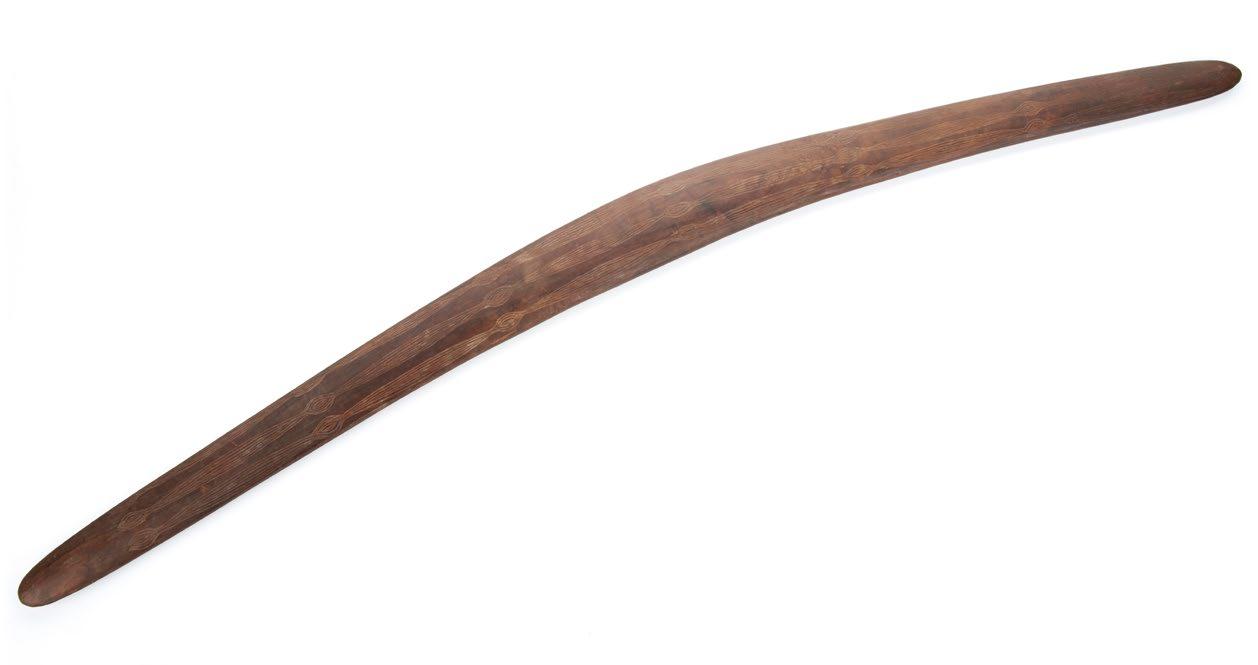
149
A Fighting Club and Three Throwing Clubs
South Australia, 19th century
90cm, 70cm, 51cm, 38cm
PROVENANCE
Collection Alan Myren, South Australia
$600–1,200

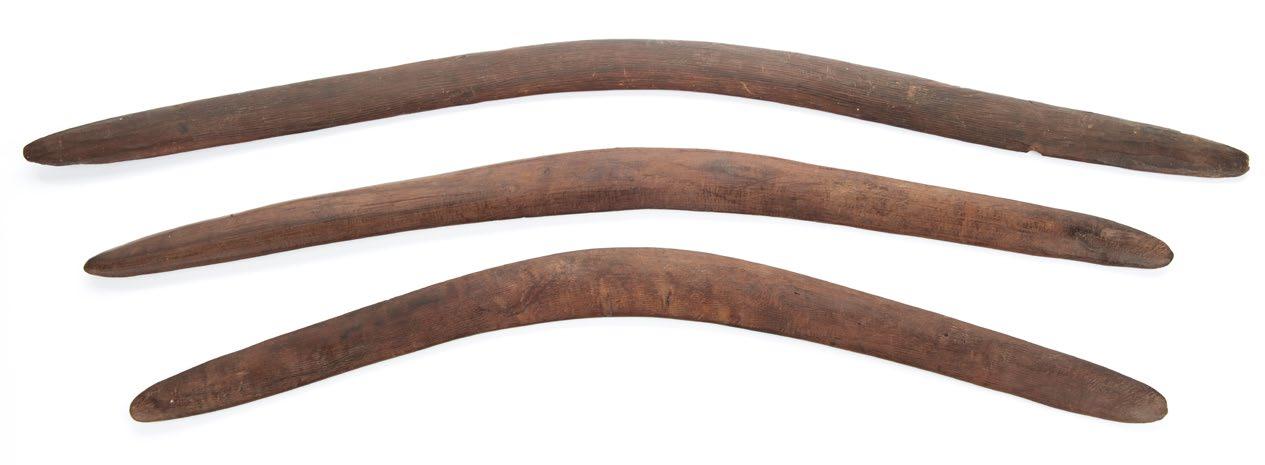
150
Three carved hardwood Boomerangs
South Australia, 19th century
Each with longitudinal incised lines to the surface.
98cm, 84cm, 76cm
PROVENANCE
Collection Alan Myren, South Australia
$600–1,200
151
An Ochre Boomerang and a Hooked Boomerang Australian, 19th century
70cm, 64cm height
PROVENANCE
Collection Arthur Kappler
Private Collection Adelaide
$400–800
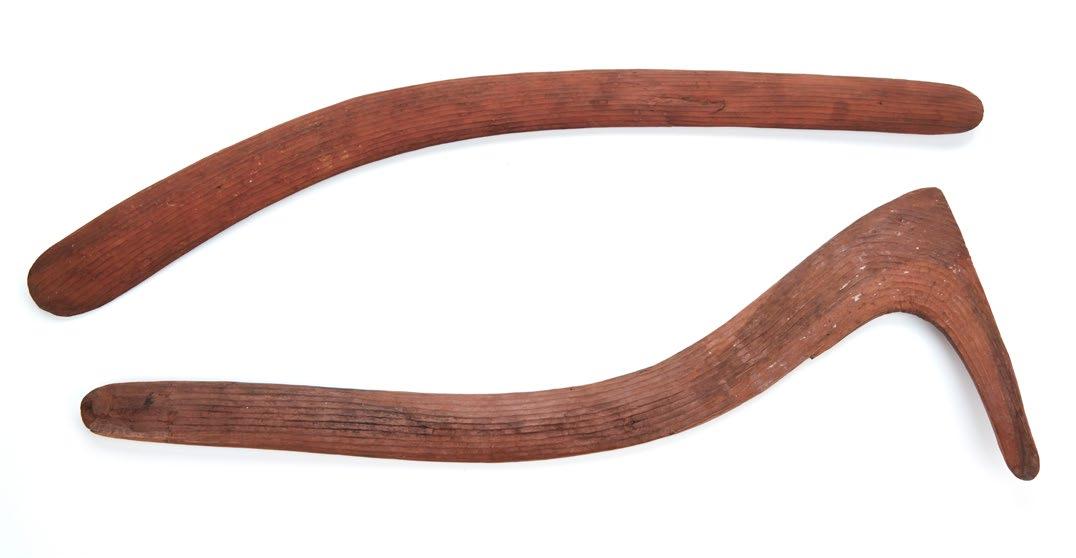

152
An Ochre Boomerang and Two Hooked Boomerangs
Aboriginal, Australia, 19th century
PROVENANCE
Collection Arthur Kappler
Private Collection Adelaide
$500–800
153
Two painted and once stone-cut boomerangs
AUSTRALIAN, PRE-1960S
43cm, 44cm and 63cm long
PROVENANCE
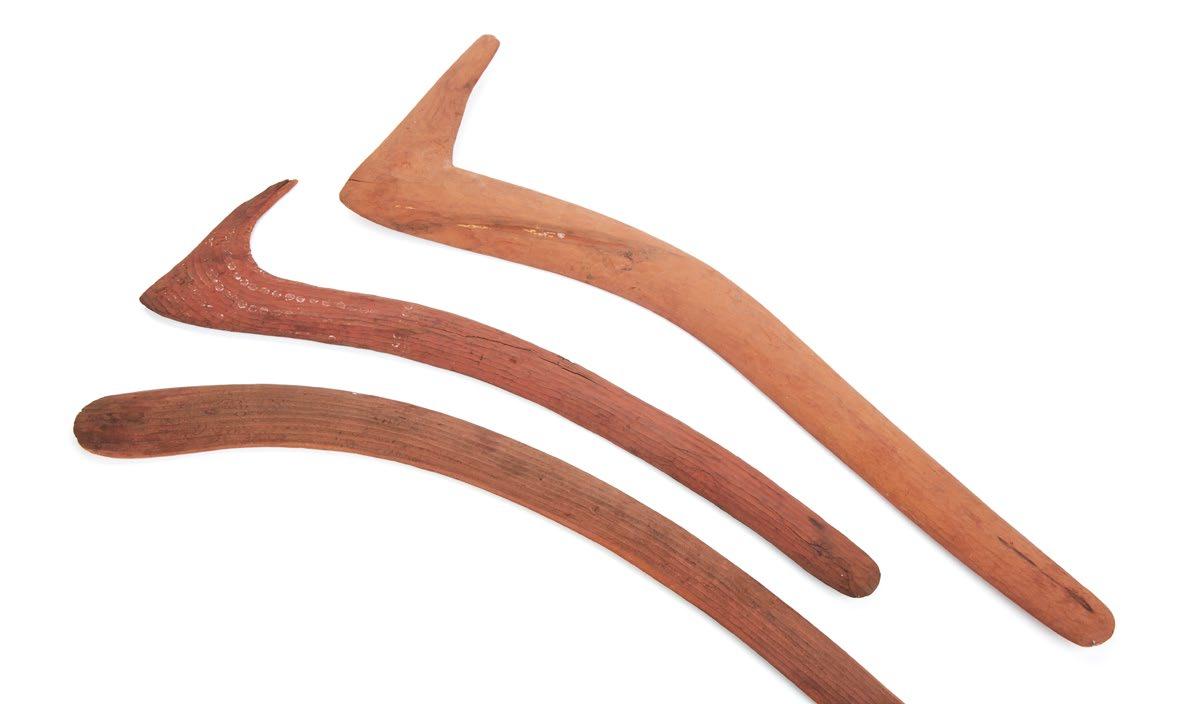
Edna and Rod Quilty owner of a number of stations in the North West of Western Australia, including Lansdowne station, Christmas Creek, Brunett Downs, Bedford Downs, and Fossil Downs.
Circa 1960's then gifted to Patricia Mary Glossop
Patricia Glossop ran a catering business in Perth, WA, which she established in the early 1950s.
Reference the attached book: Nothing Prepared Me! by Edna Exford Quilty, which mentions Patricia flying food and equipment into Lansdowne via light planes for various Quilty family functions.
$200–300
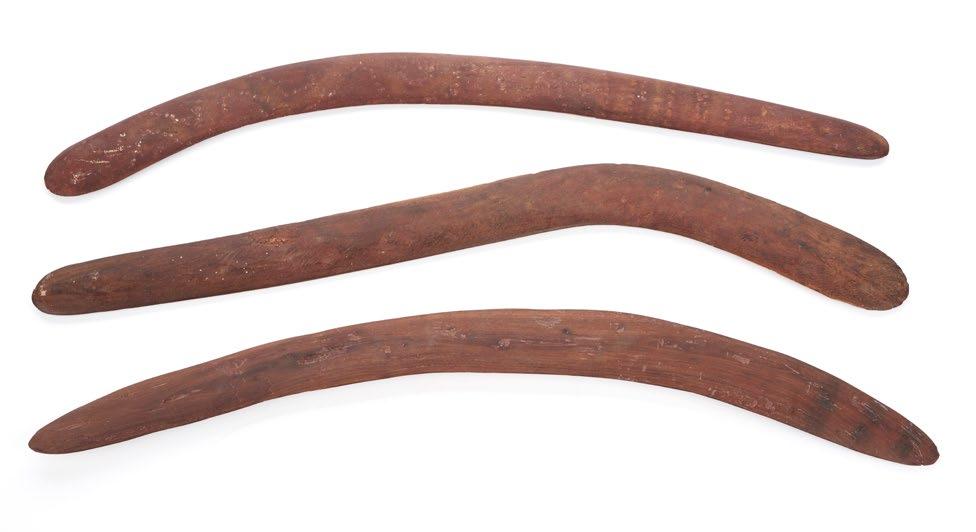
154
Three early stone cut boomerangs
West Australian pre-1960s
69cm, 70cm and 70.5cm long
PROVENANCE
Edna and Rod Quilty owner of a number of stations in the North West of Western Australia, including Lansdowne station, Christmas Creek, Brunett Downs, Bedford Downs, and Fossil Downs.
Circa 1960's then gifted to Patricia Mary Glossop
Patricia Glossop ran a catering business in Perth, WA, which she established in the early 1950s.
Reference the attached book: Nothing Prepared Me! by Edna Exford Quilty, which mentions Patricia flying food and equipment into Lansdowne via light planes for various Quilty family functions.
$200–400
155
A painted stone-cut wood coolamon West Australian 1960s or earlier 60cm long, 21cm wide
PROVENANCE
Edna and Rod Quilty owner of a number of stations in the North West of Western Australia, including Lansdowne station, Christmas Creek, Brunett Downs, Bedford Downs, and Fossil Downs.
Circa 1960's then gifted to Patricia Mary Glossop
Patricia Glossop ran a catering business in Perth, WA, which she established in the early 1950s.
Reference the attached book: Nothing Prepared Me! by Edna Exford Quilty, which mentions Patricia flying food and equipment into Lansdowne via light planes for various Quilty family functions.
$150–250
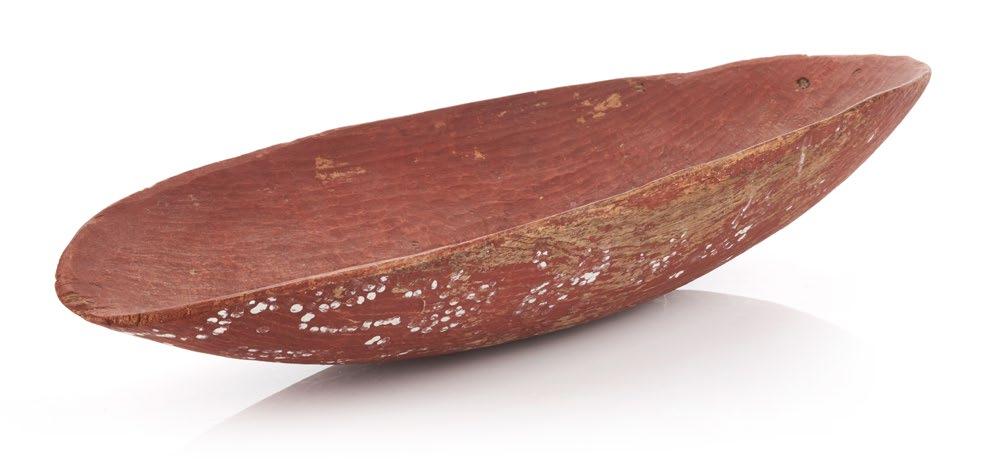
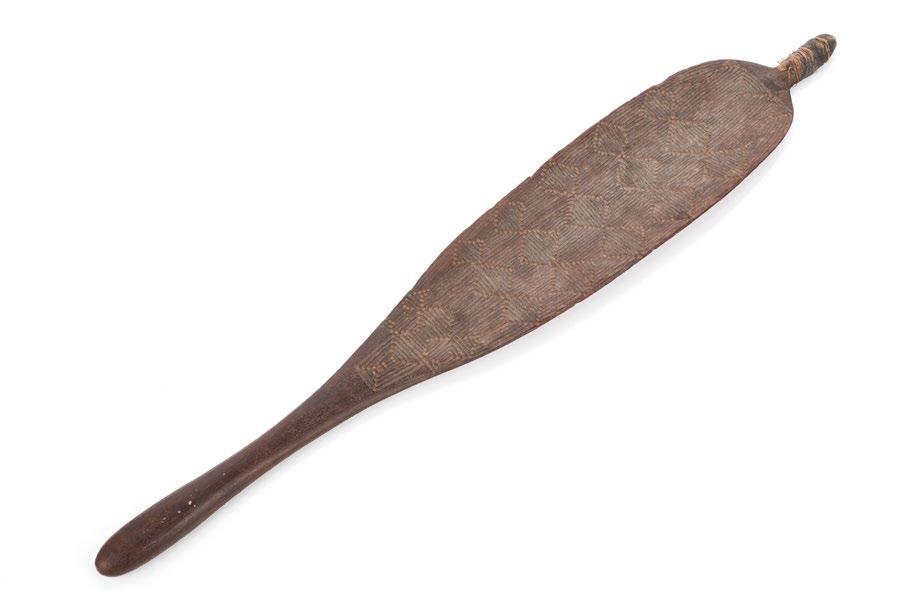

156
An early stone cut Woomera (spear thrower)
West Australian, 19th century
68cm long, 10.5cm wide
PROVENANCE
Edna and Rod Quilty owner of a number of stations in the North West of Western Australia, including Lansdowne station, Christmas Creek, Brunett Downs, Bedford Downs, and Fossil Downs.
Circa 1960's then gifted to Patricia Mary Glossop
Patricia Glossop ran a catering business in Perth, WA, which she established in the early 1950s.
Reference the attached book: Nothing Prepared Me! by Edna Exford Quilty, which mentions Patricia flying food and equipment into Lansdowne via light planes for various Quilty family functions.
$200–300
157
A painted wood and glass tipped spear and a mulga wood club
Australian 1960s
49cm long, 71cm long
PROVENANCE
Edna and Rod Quilty owner of a number of stations in the North West of Western Australia, including Lansdowne station, Christmas Creek, Brunett Downs, Bedford Downs, and Fossil Downs.
Circa 1960's then gifted to Patricia Mary Glossop
Patricia Glossop ran a catering business in Perth, WA, which she established in the early 1950s.
Reference the attached book: Nothing Prepared Me! by Edna Exford Quilty, which mentions Patricia flying food and equipment into Lansdowne via light planes for various Quilty family functions.
$100–200

158
A Wunda Shield
Aboriginal, Australia, 19th century
Convex surface with incised linear designs.
The reverse with integral handle carved in high relief. 82cm length
PROVENANCE
Private collection, Tasmania
$1,000–2,000
159
A Good Hooked Boomerang
Aboriginal, Australia, 19th century
Ochre with incised linear design to the front and reverse.
73cm length
PROVENANCE
Private collection, Tasmania
$800–1,200
160
An early carved Wunda shield
West Australian 19th/early 20th century
76cm long, 12.5cm wide
PROVENANCE
Edna and Rod Quilty owner of a number of stations in the North West of Western Australia, including Lansdowne station, Christmas Creek, Brunett Downs, Bedford Downs, and Fossil Downs.
Circa 1960's then gifted to Patricia Mary Glossop
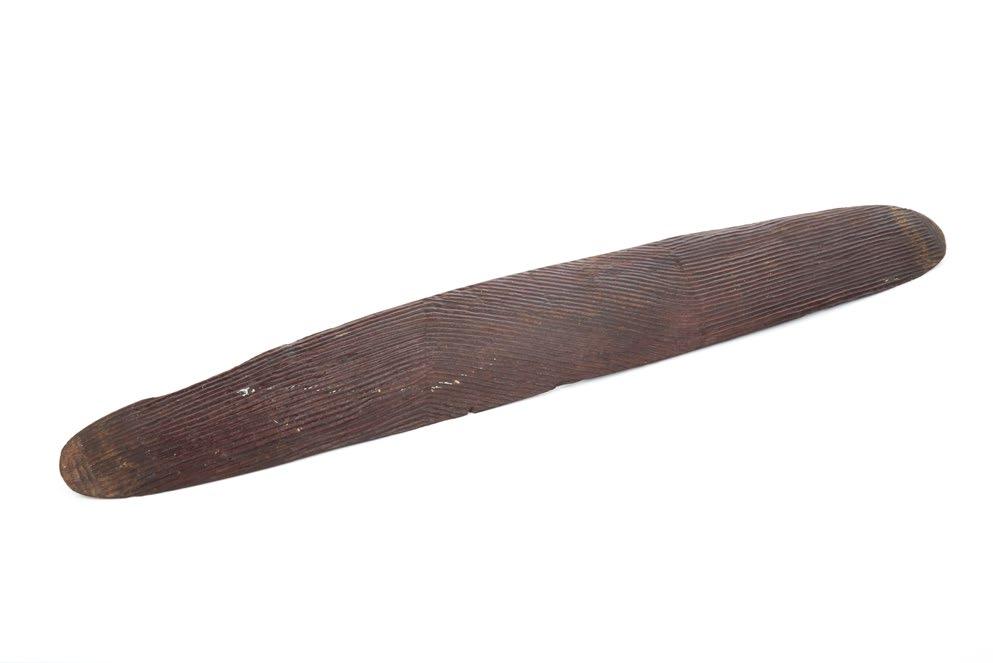
Patricia Glossop ran a catering business in Perth, WA, which she established in the early 1950s.
Reference the attached book: Nothing Prepared Me! by Edna Exford Quilty, which mentions Patricia flying food and equipment into Lansdowne via light planes for various Quilty family functions.
$1,500–2,000
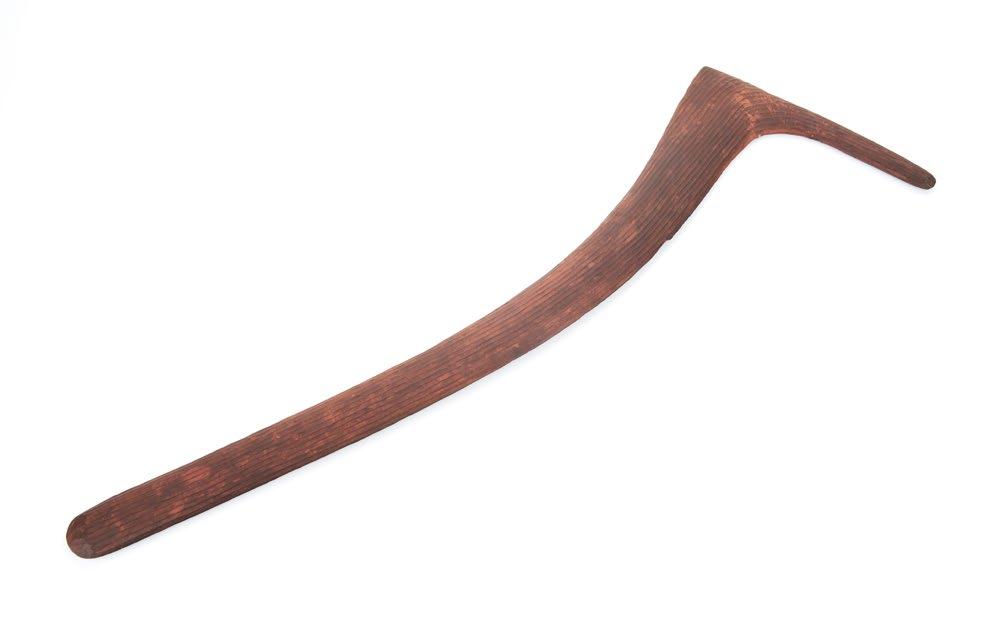
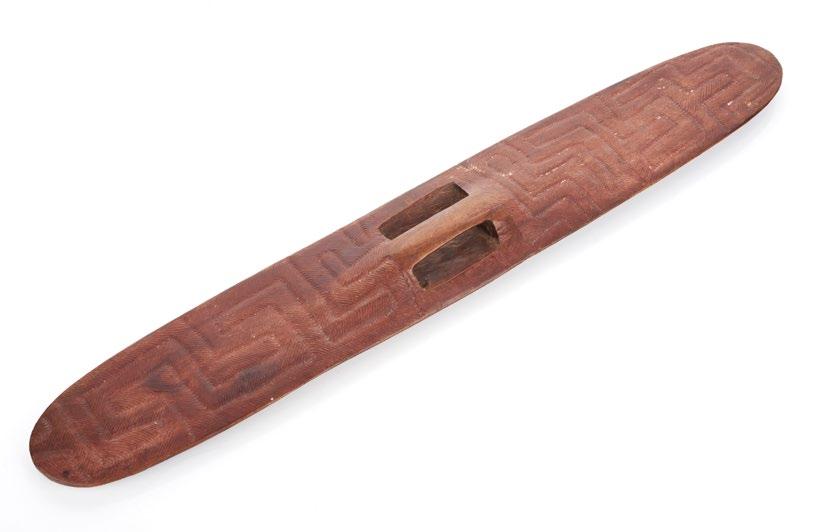
The Indigenous Arts of the Southern Hemisphere
Part 2 Auckland
In association with Found Objects, NZ
Licensed to Trade in Taonga Tūturu
Licence Number #85 2025

PART 2 LIVE AUCTION Monday 24 November 2025, 6pm (NZDT)
VIEWING
Thursday 20 November 5pm–7pm
Friday 21 November 10am–4pm
Saturday 22 November 10am–4pm
Sunday 23 November 11am–3pm
COLLECTIONS Tuesday 25 November 10am–4pm
Wednesday 26 November 10am–4pm
Thursday 27 November 10am–4pm
ADDRESS Gow Langsford Gallery 28-36 Wellesley Street East, Auckland CBD, 1010 New Zealand
ONLINE View catalogue online at www.artvisory.com.au
SPECIALIST ENQUIRIES
ADMINISTRATION ENQUIRIES
James Parkinson 0220 288 541 james@artvisory.com.au
Accounts & auction administration: Amanda Swanson +61 414 592 234 amanda@artvisory.com.au
Melissa Parkinson 0211 581 454 melissa@artvisory.com.au
Collections & Shipping: Jennifer Hirst +61 410 777 996 jennifer@artvisory.com.au
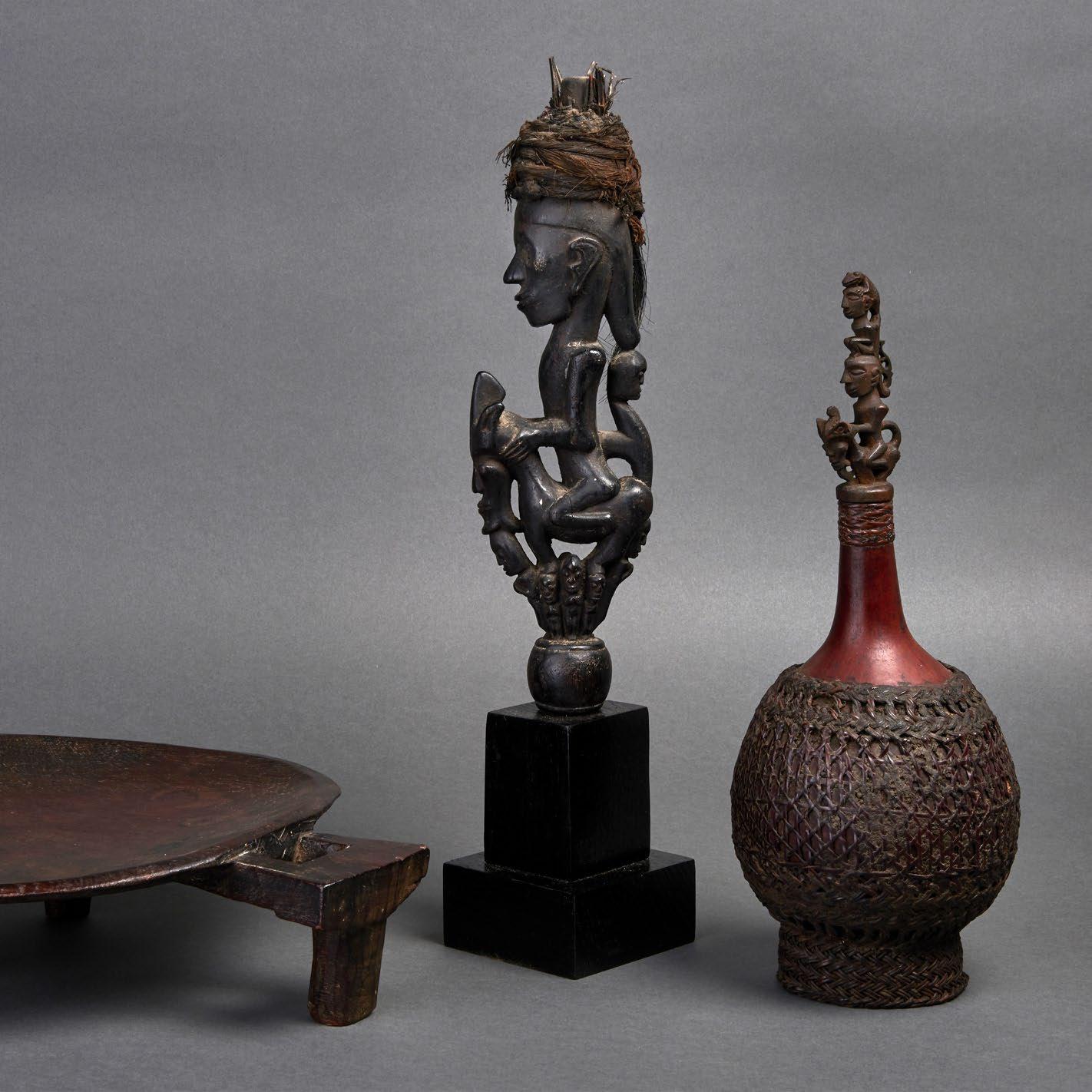
New Zealand Protected Objects Act 1975
Please note that many of the pieces in the Taonga tuturu section of this catalogue have been registered under the Protected Objects Act, this is referred to as Y registration.
Under the terms of this act items that are Y registered may not be sold to non New Zealand residents and may not leave the country without the consent of the Ministry of Culture and Heritage.
To purchase any Y registered item you must be a registered collector. To register as a collector you must apply to the Ministry of Culture and Heritage (info@mch.govt.nz).
For further information on Y registration and the registered items in this catalogue contact: James Parkinson james@artvisory.com.au
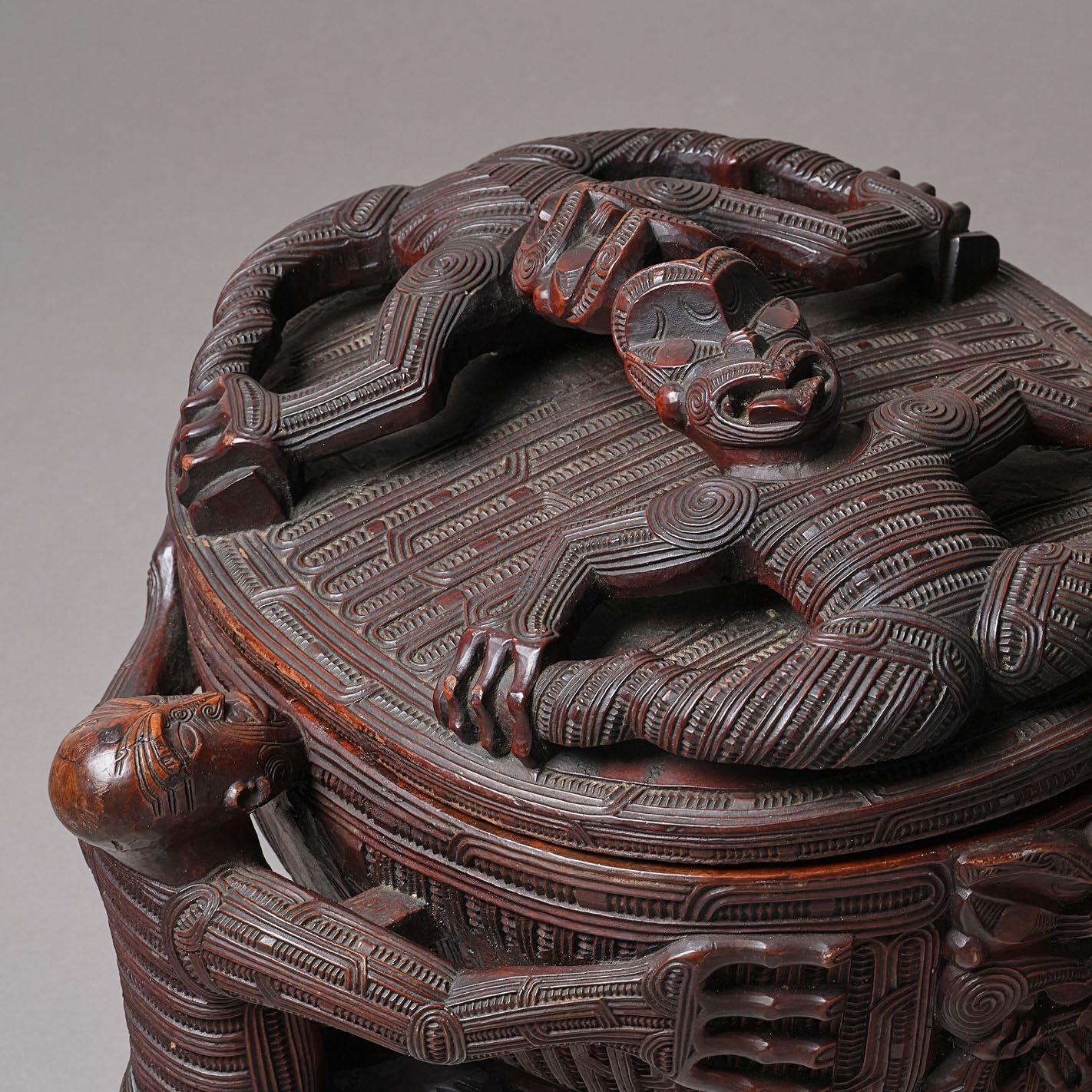
How to bid at our Auctions
Part 2 Auckland
Catalogues and Viewing
Auction catalogues can be viewed on the Artvisory website www.artvisory.com. au approximately three weeks prior to the published date of an Auction.
Printed catalogues will be available complimentary at the auction viewing.
The Auction viewing is open to the public and generally takes place during the three days prior to the Auction date, at the advertised location/s in the Auction catalogue.
Lot Descriptions
The Lot/Catalogue descriptions provide the overall information of an item including size, date or age, medium, attribution, quantity and if known, provenance.
Estimates
This auction will be conducted in New Zealand dollars. (NZD$)
The estimate accompanies each lot in the printed and online catalogue. This estimate takes into consideration the quality, condition, rarity, condition and provenance of the item. Each estimate also has a reserve, and the reserve is the undisclosed and confidential amount set at or below the low estimate. Please note the reserve will never exceed the low estimate at Artvisory.
Condition Reports
Condition reports supplement the lot/catalogue description and focus on the condition of the item. We strongly advise obtaining a condition report if you are unable to view the lot in person. Condition reports and additional images are available to view as part of the auction item listing at Invaluable.com or can be requested from Artvisory directly.
Symbols
Occasionally a symbol is printed next to a lot number in the catalogue, this indicates a special clause that is associated with the sale of that item. Please refer to the Terms and Conditions for specific symbol meanings and information.
Buyers Premium
Artvisory charges a Buyers Premium of 21% in New Zealand plus a GST charge of 15% on the hammer price of all Auction items unless otherwise stipulated.
Bidding
Artvisory offers four options for bidding at our Auctions:
Live Bidding
If this is your first-time bidding in person at an Artvisory auction you will be required to register with us, which requires you to fill out a buyer registration form in person at the viewing. To facilitate this, please bring along your Government issued photo identification, such as a driver’s licence or passport as this is the only form of identification that will be accepted. Please make sure you register in the name you want your final invoice to be made out to, as invoices once issued cannot be changed, and in certain cases a deposit may be required before you can bid.
Online Bidding
Online bidding is via the International Invaluable.com auction platform and allows you to bid via the internet in real time, whilst also allowing you to view the live feed of the Auction. You have two options to register for this service:
• Register via the Artvisory website as a Private Label customer and an Invaluable.com online bidding fee of 2% of the hammer price is added
• Register direct with Invaluable.com and an online bidding fee of 5% of the hammer price is added
Please make sure you register for online bidding at least 24 hours prior to the Auction to ensure you can login correctly so when the auction commences you can login without issues and you do not miss your lot.
Please note if you have not bid with Artvisory previously, then Government issued photo identification verifying your name and address will be also be required before you can be approved to bid with Artvisory via the Invaluable.com site, and in certain cases a bidding deposit (20% of the low estimate of each Lot you wish to bid on) may be required before you can bid.
Artvisory cannot be held responsible for any errors that occur with internet connectivity during an auction or buyer bidding errors and stipulates that either Chrome or Firefox are the recommended Internet Browsers for online bidding as Invaluable.com is not supported by Safari.
Bidding Deposits
Artvisory reserves the right to request a deposit for any buyer wanting to register for the auction, and this must be received in cleared funds 24 hours prior to the commencement of the auction. If the buyer is not successful, then it will be refunded in full by the third day after the auction.
Telephone Bidding
Complimentary telephone bidding is available at all of our live Auctions and involves an Artvisory representative calling you approximately 3–5 lots in advance of your nominated lot and you then instruct them to bid on your behalf.
Telephone Bids must be requested at least 24 hours prior to the commencement of the Auction and are provided on a first come, first served basis, as the number of phone lines available are limited.
See our website to download and complete a telephone bidding form and please note that if this is your first time bidding with Artvisory, we will require a clear, scanned copy of Government issued photo identification such as a drivers licence or current passport verifying your name and address and in certain cases a deposit may be required before you can bid.
Artvisory reserves the right to request a deposit for any buyer wanting to register for the auction, and this must be received in cleared funds 24 hours prior to the commencement of the auction. If the buyer is not successful, then it will be refunded in full by the third day after the auction.
Absentee Bidding
Absentee bidding offers convenience if you are unable to attend an Auction in person, bid over the telephone, or if you wish to stick to your budget.
An absentee bid should be set at the maximum amount you wish to bid on the lot/s you are interested in purchasing. Should the lot/s be knocked down at an amount lower than the bid recorded on your form, the lot will be sold to you for the lesser hammer price plus Buyers Premium. If identical bids are received for the same lot, then the first bid received will take precedence.
Absentee bids must be received by Artvisory at least 24 hours prior to the Auction commencing and the Company cannot be held responsible for activating any late bids that are received.
See our website to download and complete an absentee bidding form and please note if this is your first time bidding with Artvisory, we will require a clear, scanned copy of Government issued photo identification such as a drivers licence or current passport verifying your name and address and in certain cases a deposit may be required before you can bid.
Payment and Collection
If you are successful with your bid/s, an invoice will be emailed to you immediately after the Auction finishes.
For this Auction you will pay the hammer price, plus the Buyers Premium of 21% plus GST on each lot, the GST of 15% on hammer together with any additional charges such as the Invaluable.com online bidding fee.
As per our terms and conditions, payments must be made in full by three (3) days after the Auction has been completed as printed in the catalogue.
For this auction, payments must be made in NZD$ via Direct Deposit into the New Zealand Commonwealth Bank Company Trust Account - Company Trust Account details are included on the invoice that is emailed to you after the Auction if you are a successful bidder. Cash, Cheques and Credit cards are not accepted for this auction.
All items must be paid for in full and collected within the collection times advertised for each individual Auction and if items are not collected within this time frame then Artvisory reserves the right to charge removal, storage and release fees.
Packing and Delivery
Artvisory has a list of recommended carriers specific to each auction that will be sent to you if you are a successful buyer.
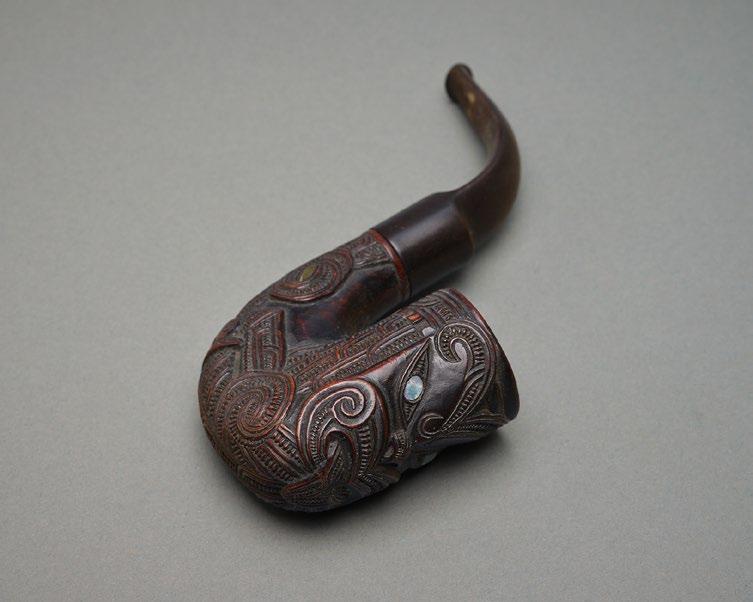
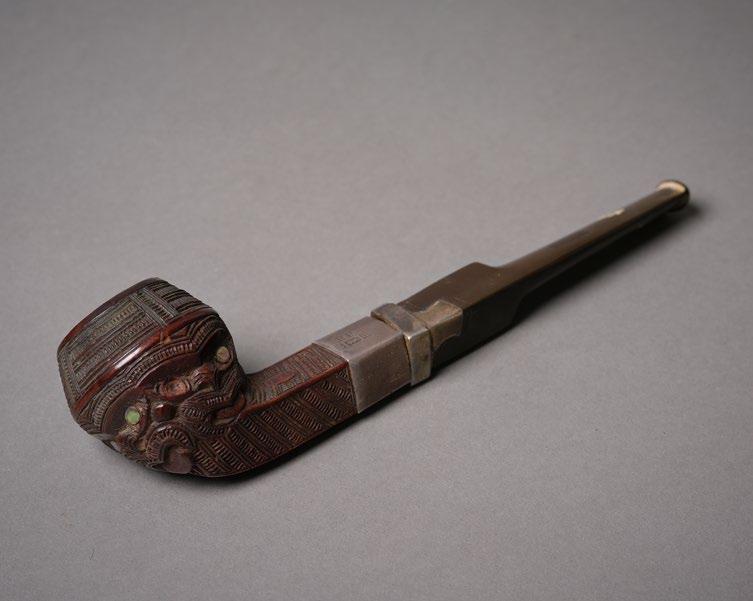
1
A Carved Pipe
Māori, Ngati Tarawahi, Aotearoa, New Zealand, early 20th century
The bowl carved as a wheku head with open mouth and protruding tongue and with paua shell eyes
NZ Protected Object Act (1975)
Registration number: Y22875 10cm height
PROVENANCE
Collection of Ron Brownson, Auckland
NZ$400–800
2
A Tene Waitere Carved Pipe
Māori, Aoteraoa, New Zealand, late 19th/early 20th century
Protected Objects Act (1975)
Registration Number Y number pending 15cm length
PROVENANCE
Collection Patrick O'Connor
Tene Waitere (1853-1931) carved pipes are rare examples of Māori artistry, blending traditional Ngati Tarawhai carving with colonial-era forms. Crafted in Rotorua in the late 19th and early 20th centuries, these tobacco pipes feature haehae and pakati patterns, stylised tiki figures. Waitere’s pipes were often presentation pieces gifted to visiting dignitaries.
NZ$3,000–4,000
3
A Carved Pipe with Bakelite Mouthpiece
Māori, Ngati Tarawhai, Aotearoa, New Zealand, early 20th century
The bowl with four wheku heads, all with inset paua shell eyes.
NZ Protected Object Act (1975)
Registration number: Y22873 11cm height
PROVENANCE
Collection of Ron Brownson, Auckland
NZ$500–800
4
A Carved Wood Tobacco Pipe by Master Carver Thomas Heberley (1876-1937)
Māori, Aotearoa, New Zealand, early 20th century
Bowl carved with double tane figures lying prone with elbows raised, one hand to hip the other holding the tongue. Cut paua shell embellishments. Curved bakerlite stem with muka binding to mouthpiece. The rim is stamped 'Christeson', 18ct.
Protected Objects Act (1975)
Registration Number Y14645 15cm length
PROVENANCE
Collection Robert Lerner (1960–2022)
NZ$800–1,200
5
A Thomas Heberley Pipe
Māori, Aotearoa, New Zealand, early 20th century
The bowl carved in the form of a naturalistic tane head flanked by two wahine to oriented to the rear. "Kia Ora" carved to the underside. The square ferrule and circular rim are stamped with the Christeson trademark, 9ct.
Protected Objects Act (1975)
Registration Number Y number pending 7cm length
PROVENANCE
Collection Patrick O'Connor
Thomas Heberley (1876–1937) was a master Māori carver of Te Ati Awa descent, renowned for his intricately crafted tobacco pipes and museum work. The pipes were carved by Heberley for Louis Peter Christeson, who had a tobacconist and barber shop business in Wellington in 1891.
NZ$1,500–2,000
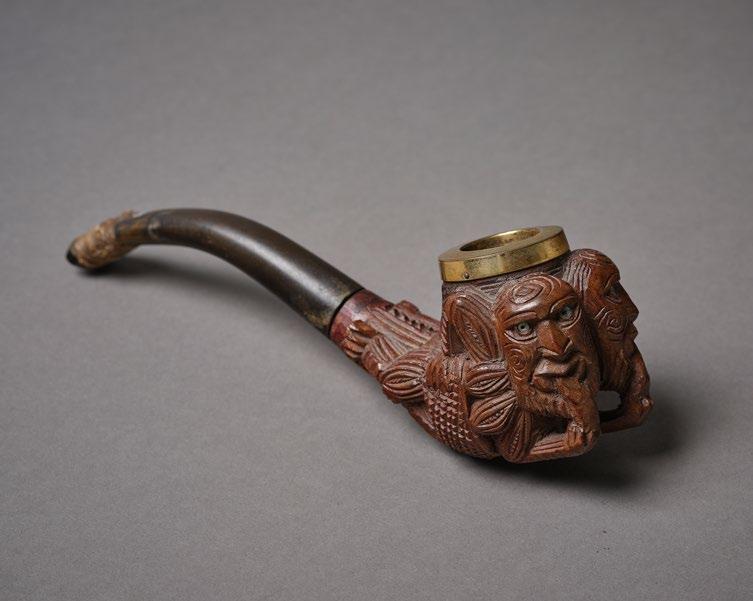

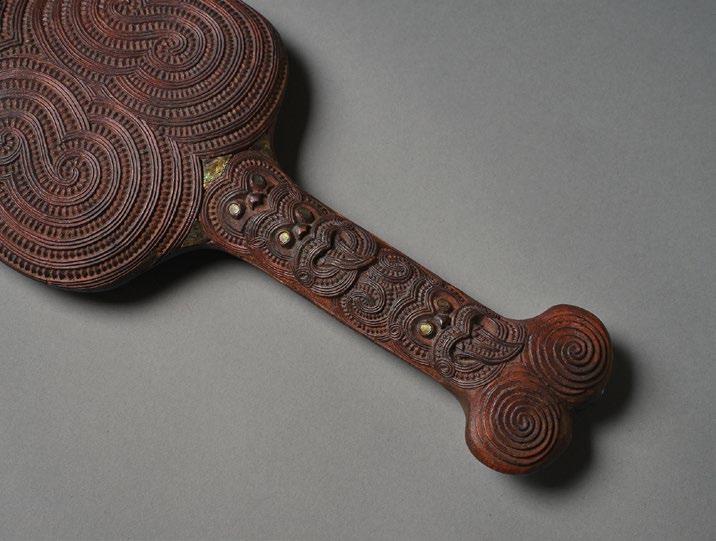
6
A Ngati Tarawhai Style Kotiate Māori, Aotearoa, New Zealand, 20th century
Decorated with spiral carving, the handle carved with three wheku heads with inset paua shell eyes.
Protected Objects Act (1875)
Registration Number Y22938 45cm length
PROVENANCE
Ron Brownson collection
NZ$500–1,000
7
A Carved Panel
Māori, Aotearoa, New Zealand
Decorated in low relief with an ancestral figure with wheku head. Red ochre painted finish
Protected Objects Act (1875)
Registration Number Y22939
50cm height, 23cm wide
8
A Small Toki Pounanu
Māori, Aotearoa, New Zealand, 18th century or earlier
Roughly modelled with natural scarring. Protected Objects Act (1975)
Registration Number Y15005 5cm length
PROVENANCE
Collection Robert Lerner (1960–2022)
NZ$200–300
9
Two Pre-European Toki (Argillite) Māori, Aotearoa, New Zealand, 18th century or earlier
Protected Objects Act (1975)
Registration Number Y15093, Y22777 13cm, 15cm length
PROVENANCE
Collection Robert Lerner (1960–2022)
10
A Section of Worked Pounamu Māori, Aotearoa, New Zealand, 19th century or earlier
Protected Objects Act (1975)
Registration Number Y15050 14cm length
PROVENANCE
Collection Robert Lerner (1960–2022)
NZ$50–100
11
A Small Pounamu Pendant
Māori, Aotearoa, New Zealand, 19th century or earlier
Rectangular shape pierced for suspension. Protected Objects Act (1975)
Registration Number Y15036 4cm
PROVENANCE
NZ$100–200 6
Collection Robert Lerner (1960–2022)
NZ$200–400
PROVENANCE
Collection of Ron Brownson, Auckland
NZ$400–800
12
A Good Large Pre-European Toki
Māori, Aotearoa, New Zealand, 18th century or earlier
Quadrangular tapering form with well defined lateral edges and bevel, hammer dressed tang and poll. Minor flaking.
Protected Objects Act (1975)
Registration Number Y15676
31cm length
PROVENANCE
Gifted to Roger Edmonds, Kalimantan Collection by his Mother in 1981 and loaned to the Nelson Museum in New Zealand for many years.
Purchased by tender at Dunbar Sloane, Auckland, 20 April 2011
Collection Robert Lerner (1960–2022)
NZ$1,000–2,000
13
A Pre-European Hogback Toki
Maoro, Aotearoa, New Zealand, 18th century or earlier
Flaked and hammer dressed surface with long smooth bevel. Two large flakes to the cutting edge.
Protected Objects Act (1975)
Registration Number Y14006
19cm length
PROVENANCE
Collection Robert Lerner (1960–2022)
NZ$200–400
14
An Adze Blade From Papua New Guinea Mount Hagen, 19th century or earlier
Stone axe blade traditionally crafted in green serpentine-like stone.
27cm length, 8cm width
PROVENANCE
Purchased from Sotheby's, London, November 2001. Lot 260
Kalimantan Collection, Roger Edmonds
Purchased by tender at Dunbar Sloane, Auckland, 20 April 2011
Collection Robert Lerner (1960–2022)
NZ$200–400
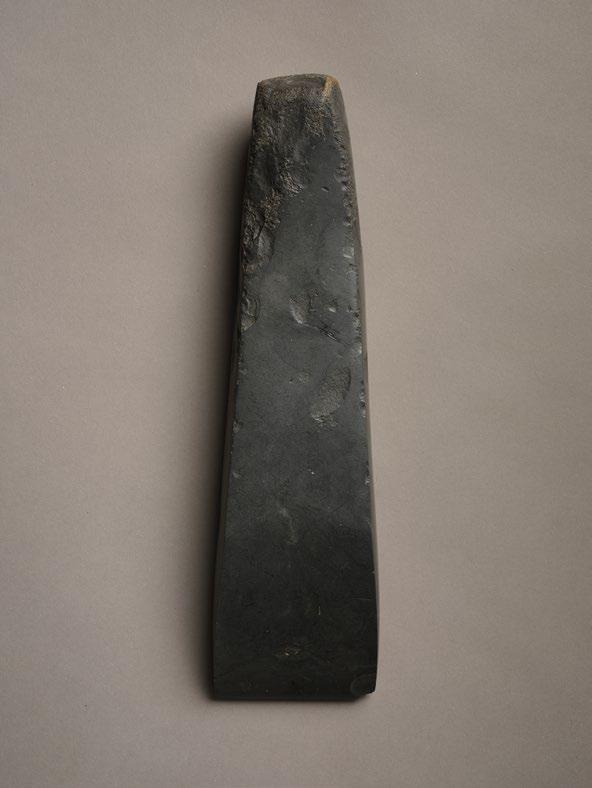
15
A Pre-European Toki
Māori, Aotearoa, New Zealand, 18th century or earlier
Argillite stone with smooth surface. Protected Objects Act (1975) Registration Number Y14005 17cm length
PROVENANCE
Collection Robert Lerner (1960–2022)
NZ$200–400
16
A Tin Box with Embossed Tane Head
Aotearoa, New Zealand, 20th century
8 x 11cm
PROVENANCE
Collection Robert Lerner (1960–2022)
NZ$200–400

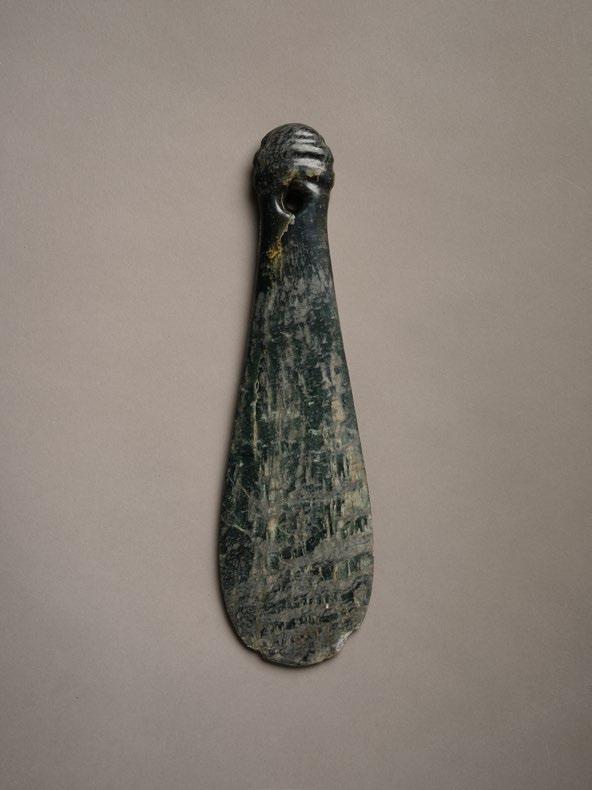
A
Large Mere Pounamu (Nephrite Hand Club)
Māori, Aotearoa, New Zealand, 19th century or earlier
Thick heavy spatulate shaped blade with curved surface carved in dark mottled kawakawa variety stone. The flat grip section tapering to a shouldered butt with four concentric grooves. Comes with a custom made stand.
Protected Objects Act (1975) Registration Number Y11459
41.6cm length, 10.3cm wide
PROVENANCE
Purchased at Dunbar Sloane, Auckland, 2008. Lot 1021
Kalimantan Collection, Roger Edmonds
Purchased by tender at Dunbar Sloane, Auckland, 20 April 2011
Collection Robert Lerner (1960–2022)
NZ$10,000–15,000
18
A Mere Pounamu (Nephrite Hand Club)
Māori, Aotearoa, New Zealand, 19th century or earlier
Spatulate shaped blade with tapered grip reducing to a flared rounded butt with three concentric grooves. Carved in dark kawakawa variety stone with pale mottled/streaked inclusions.
Protected Objects Act (1975) Registration Number Y09623
31.2cm length, 9cm wide
PROVENANCE
Purchased at Cordy's, Auckland, 2008. Lot 135
Kalimantan Collection, Roger Edmonds
Purchased by tender at Dunbar Sloane, Auckland, 20 April 2011
Collection Robert Lerner (1960–2022)
NZ$1,500–2,500

A Good Pre-European Hei Tiki Māori, Aotearoa, New Zealand, 18th century or earlier
A classic type I hei tiki carved in bright kawakawa variety stone. The finely carved facial features display widely recessed double ringed eyes, a detailed nasal ridge extending to the top of the head, and a heart shaped mouth showing the tongue and teeth. The stone-drilled countersunk suspension hole showing wear commensurate with age and use.
NZ Protected Object Act (1975) Registration Number Y15099 8.5cm length, 5.7cm wide
PROVENANCE
Purchased at Sotheby's, London, March 1980. Lot 55 Kalimantan Collection, Roger Edmonds
Purchased by tender at Dunbar Sloane, Auckland, 20 April 2011 Collection Robert Lerner (1960–2022)
NZ$15,000–20,000


21
A Small Mere Pounamu (Nephrite Hand Club)
Māori, Aotearoa, New Zealand, 18th century or earlier
A beautiful example of a small finely carved mere pounamu, most likely made for a chieftainess or high-born wahine toa (female warrior). Smooth blade carved in bright kawakawa variety stone with ochre coloured marsden inclusions to the grip section. Stone-drilled countersunk suspension hole and three shallow concentric grooves to the butt.
Protected Objects Act (1975) Registration Number Y8999
30.5cm length, 8cm wide
PROVENANCE
Purchased at Dunbar Sloane, Auckland, March 2005, Lot 234
Kalimantan Collection, Roger Edmonds
Purchased by tender at Dunbar Sloane, Auckland, 20 April 2011
Collection Robert Lerner (1960–2022)
NZ$8,000–12,000
A Mere Pounamu (Nephrite Hand club)
Māori, Aotearoa, New Zealand, 18th century
The flat spatulate shaped blade tapers to a robust grip section which terminates in an ovoid butt with five concentric grooves. Carved in Kawakawa variety stone with milky pale inanga inclusions.
Protected Objects Act (1975) Registration Number Y1724
35cm length, 10.7cm wide
PROVENANCE
Collection John Elliot Lawford (1933–2020)
Purchased at Dunbar Sloane, Auckland, December 2003. Lot 73
Kalimantan Collection, Roger Edmonds
Purchased by tender at Dunbar Sloane, Auckland, 20 April 2011
Collection Robert Lerner (1960–2022)
NZ$5,000–8,000

An Important Pre-European Hei Tiki Māori, Aotearoa, New Zealand, 18th century or earlier
A classic type I hei tiki carved in dark flawless kawakawa variety stone. The facial features display widely recessed eyes with nasal bridge and mouth worn but still visible. The body shows a clearly delineated neck surmounting a rounded belly, with precisely carved arms and legs.
Shallow indents mark three fingers on each hand resting on the thighs.
Some natural scarring to back of the head. The stone-drilled suspension hole and left eye ring have worn out indicating great age and use.
Protected Object Act (1975) Registration Number Y4801 10.9cm length, 5.4cm wide
PROVENANCE
Collection Kenneth Athol Webster (1906–1967), Wellington
Purchased at Dunbar Sloane, Auckland, May 2006. Lot 66 Kalimantan Collection, Roger Edmonds
Purchased by tender at Dunbar Sloane, Auckland, 20 April 2011
Collection Robert Lerner (1960–2022)
NZ$10,000–18,000
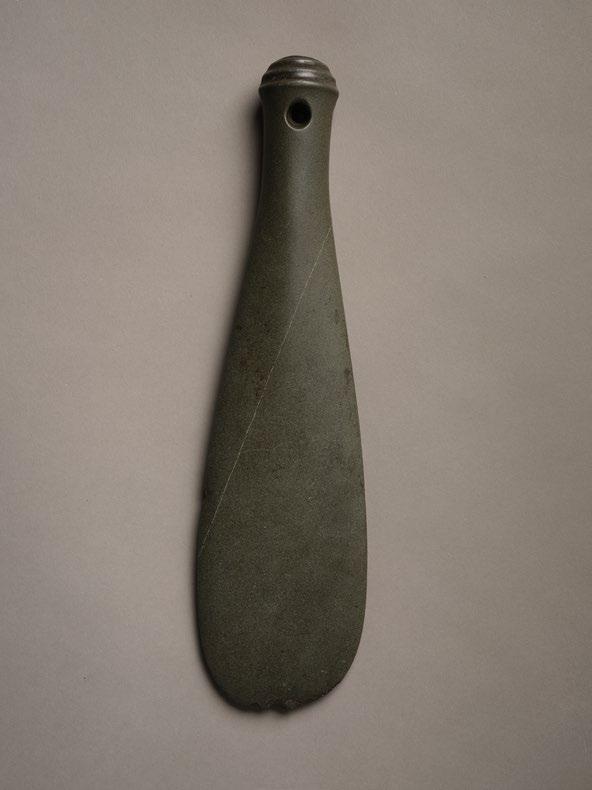
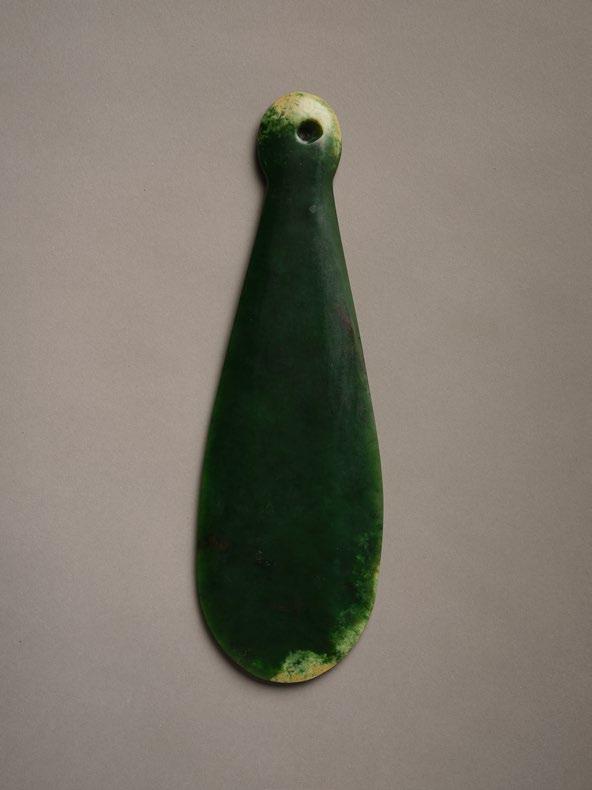
23
A Patu Onewa (Stone Hand Club)
Māori, Aotearoa, New Zealand, 19th century or earlier
Carved in graywacke variety stone featuring a fine quartz vein. Countersunk suspension hole with five ridges to the hilt.
Protected objects Act (1975) Registration Number Y15667
35cm length, 9cm wide
PROVENANCE
Collection Emeritus Professor Thomas Peter Huntley McKellar (1921 - 2003), Dunedin
Private sale, February 1993
Kalimantan Collection, Roger Edmonds
Purchased by tender at Dunbar Sloane, Auckland, 20 April 2011
Collection Robert Lerner (1960–2022)
NZ$1,000–2,000
24
A Small Finely Carved Mere Pounamu (Nephrite Hand Club)
Māori, Aotearoa, New Zealand, 18th century or earlier
Spatulate blade with reduced grip flaring to a rounded butt. Offset stonedrilled countersunk suspension hole. Carved in superb dark kawakawa variety stone with marsden inclusions to the apex of the blade edge and butt. Most likely created for a chieftainess or high-born wahine toa (female warrior).
Protected Objects Act (1975) Registration Number Y13281
27cm length, 8.5cm wide
PROVENANCE
Purchased at Cordy's, Auckland, 2008. Lot 217
Kalimantan Collection, Roger Edmonds
Purchased by tender at Dunbar Sloane, Auckland, 20 April 2011
Collection Robert Lerner (1960–2022)
NZ$10,000–15,000


25
A Hei Tiki Carved in Bowenite
Māori, Aotearoa, New Zealand, early 19th century or earlier
Called the "Whanganui Tiki", when it was on display at the Whanganui Musuem, this rare artefact is a good example of a pre-European hei tiki carved in translucent blue/green bowenite. Called Tangiwai in Māori, this translucent serpentine stone is found only near Milford sound in the South Island. The stone is sharply and thinly carved with simple incisions. Small, recessed eye rings display red sealing wax embellishment applied later. Worn suspension hole commensurate with age and use.
Female sex indicated.
Protected Objects Act (1975) Registration Number Y3204
9cm length, 5.8cm wide
PROVENANCE
Purchased at Dunbar Sloane, Auckland, April 1996. Lot 18
Kalimantan Collection, Roger Edmonds
Purchased by tender at Dunbar Sloane, Auckland, 20 April 2011
Collection Robert Lerner (1960–2022)
NZ$3,000–5,000
26
A Large Pre-European Hei Tiki
Māori, Aotearoa, New Zealand, 18th century or earlier
A rare type II hei tiki with head tilted to the right carved in semi translucent inanga variety stone. Right hand to the chest displays three well defined fingers, the body is thick and muscular, clearly defined feet meet with two toes formed by a small perforation. Stone-drilled countersunk suspension hole to the top of the head.
Protected Objects Act (1975) Registration Number Y1170 11.5cm length, 6.7cm wide
PROVENANCE
Purchased at Dunbar Sloane, Auckland, 2008. Lot 44
Kalimantan Collection, Roger Edmonds
Purchased by tender at Dunbar Sloane, Auckland, 20 April 2011
Collection Robert Lerner (1960–2022)
NZ$8,000–12,000
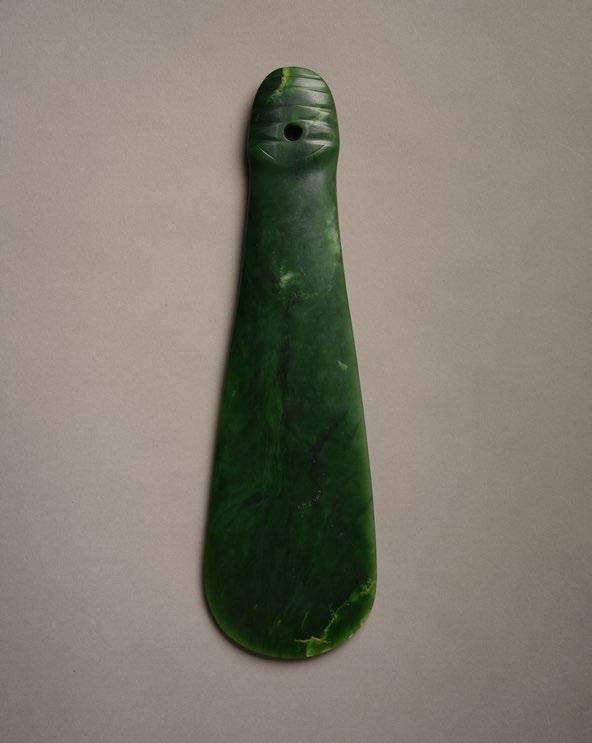
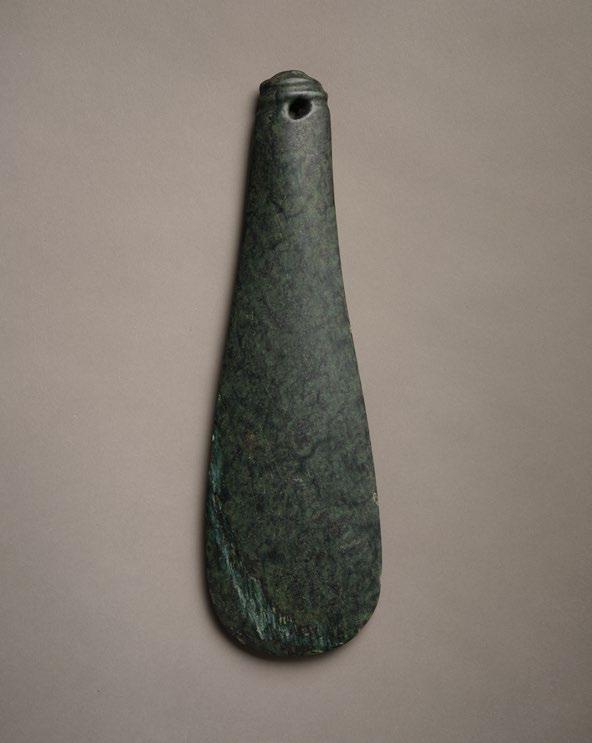
A Mere Pounamu (Nephrite Hand Club)
Māori, Aotearoa, New Zealand,19th century or earlier
Carved in bright translucent kawakawa variety stone. Five distinct grooves carved to the butt. Lapidary scarf evident down one side of the blade.
This mere is the first pounamu artefact purchased by Roger Edmonds c.1970. After a short stay with his parents, the mere was loaned to the Whanganui Regional Museum where it remained for the next quarter of the century before becoming part of the Kalimantan Collection.
Protected Objects Act (1975) Registration Number Y15669
33.6cm length, 9.8cm wide
PROVENANCE
Purchased private sale, c.1970
Kalimantan Collection, Roger Edmonds
Purchased by tender at Dunbar Sloane, Auckland, 20 April 2011
Collection Robert Lerner (1960–2022)
NZ$10,000–15,000
A Mere Pounamu (Nephrite Hand Club)
Māori, Aotearoa, New Zealand, 18th century or earlier
Spatulate shaped blade with wide grip section terminating with three grooves and a stone-drilled countersunk hole to the butt.
Carved in dark mottled kawakawa variety stone.
Protected Objects Act (1975) Registration Number Y3270
33cm length, 10cm wide
PROVENANCE
Purchased at Dunbar Sloane, Wellington,1996. Lot 45
Kalimantan Collection, Roger Edmonds
Purchased by tender at Dunbar Sloane, Auckland, 20 April 2011
Collection Robert Lerner (1960–2022)
NZ$8,000–12,000
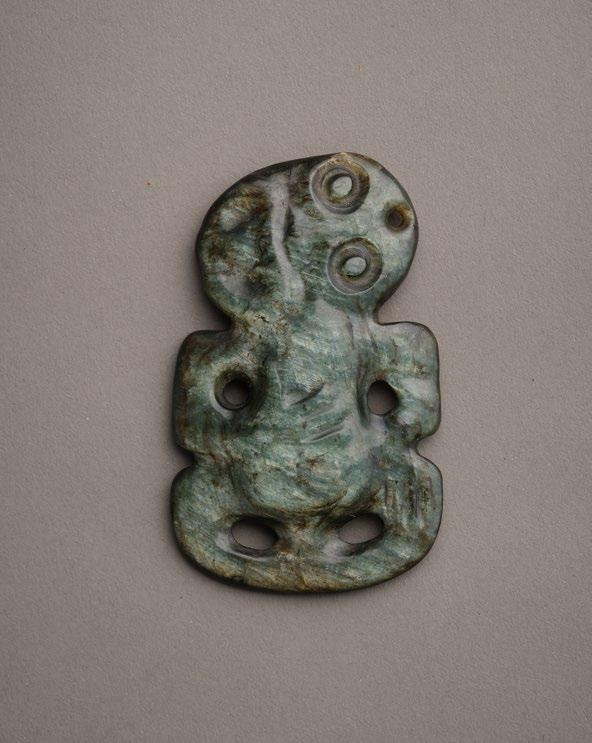
29
A Hei Tiki Carved in Silvery Inanga Pounamu
Māori, Aotearoa, New Zealand, 18th century or earlier
A rare type II hei Tiki with head tilted to the right carved in silvery chatoyant inanga, possibly the result of heat treatment. The right hand to chest has three fingers and a clear thumb. Facial features are worn but visible. Stone-drilled countersunk hole to the top of the head. Discovered in a private garden in Whakatane, in the North Island of New Zealand in the 1970s.
Protected Objects Act (1975) Registration Number Y5548
8.6cm length, 5.4cm wide
PROVENANCE
Purchased at Dunbar Sloane, Auckland, April 1996. Lot 49
Kalimantan Collection, Roger Edmonds
Purchased by tender at Dunbar Sloane, Auckland, 20 April 2011
Collection Robert Lerner (1960–2022)
NZ$6,000–12,000

30
A Pounamu Kuru (Ear Pendant)
Māori, Aotearoa, New Zealand, late 19th century
Kawakawa variety stone with dark speckled inclusions.
Oval cross section with tapered tip.
Protected Objects Act (1975) Registration Number Y15096
9.5cm length
PROVENANCE
Purchased at Sotheby's, London, February 1980
Kalimantan Collection, Roger Edmonds
Purchased by tender at Dunbar Sloane, Auckland, 20 April 2011
Collection Robert Lerner (1960–2022)
NZ$200–400

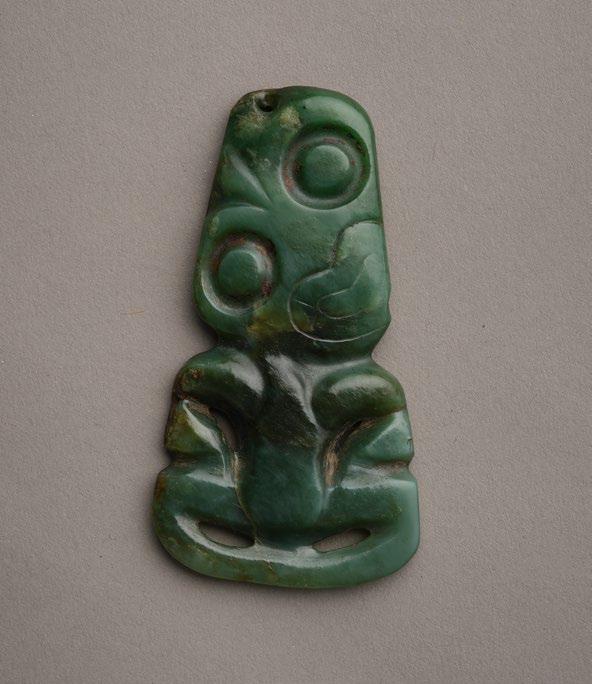
A Small Pounamu Kuru (Ear Pendant)
Māori, Aotearoa, New Zealand, 19th century or earlier
Carved in dark Kawakawa with streaked inclusions.
Short with an irregular rounded cross-section and flattened ends.
Protected Objects Act (1975) Registration Number Y15097
5.5cm length
PROVENANCE
Purchased at Sotheby's London, December 1980. Lot 166
Kalimantan Collection, Roger Edmonds
Purchased by tender at Dunbar Sloane, Auckland, 20 April 2011
Collection Robert Lerner (1960–2022)
NZ$400–800
32
A Pre-European Hei Tiki
Māori, Aotearoa, New Zealand, 18th century or earlier
A type I form most likely fashioned from an adze carved in inanga variety stone. Such hei tiki often retain the wedge-shaped outline characteristic of adze blades, with straight margins intersecting at the head, arms,
and legs. The head is frequently elongated laterally to conform to the previous model. Many hei tiki appear to have been reworked from toki pounamu—nephrite adzes that held significant cultural and functional value for Māori. As taonga, these tools were highly prized, frequently passed down through generations, and eventually retired from utilitarian use. Their transformation into hei tiki imbued the resulting pendant with inherited mana, linking it to the genealogy and prestige of prior owners. Consequently, such hei tiki continued to accrue symbolic power and status through successive wearers.
Protected Objects Act (1975) Registration Number Y15659
6.7cm, 4.3cm wide
PROVENANCE
Kalimantan Collection, Roger Edmonds
Purchased at Sotheby's, London, 1979, Lot 77
Robert Lerner Collection
Purchased at Dunbar Sloane, Wellington, 2011
REFERENCE
Austin, D. (2019). Te Hei Tiki: An enduring treasure in a cultural continuum Te Papa Press.
NZ$4,000–8,000
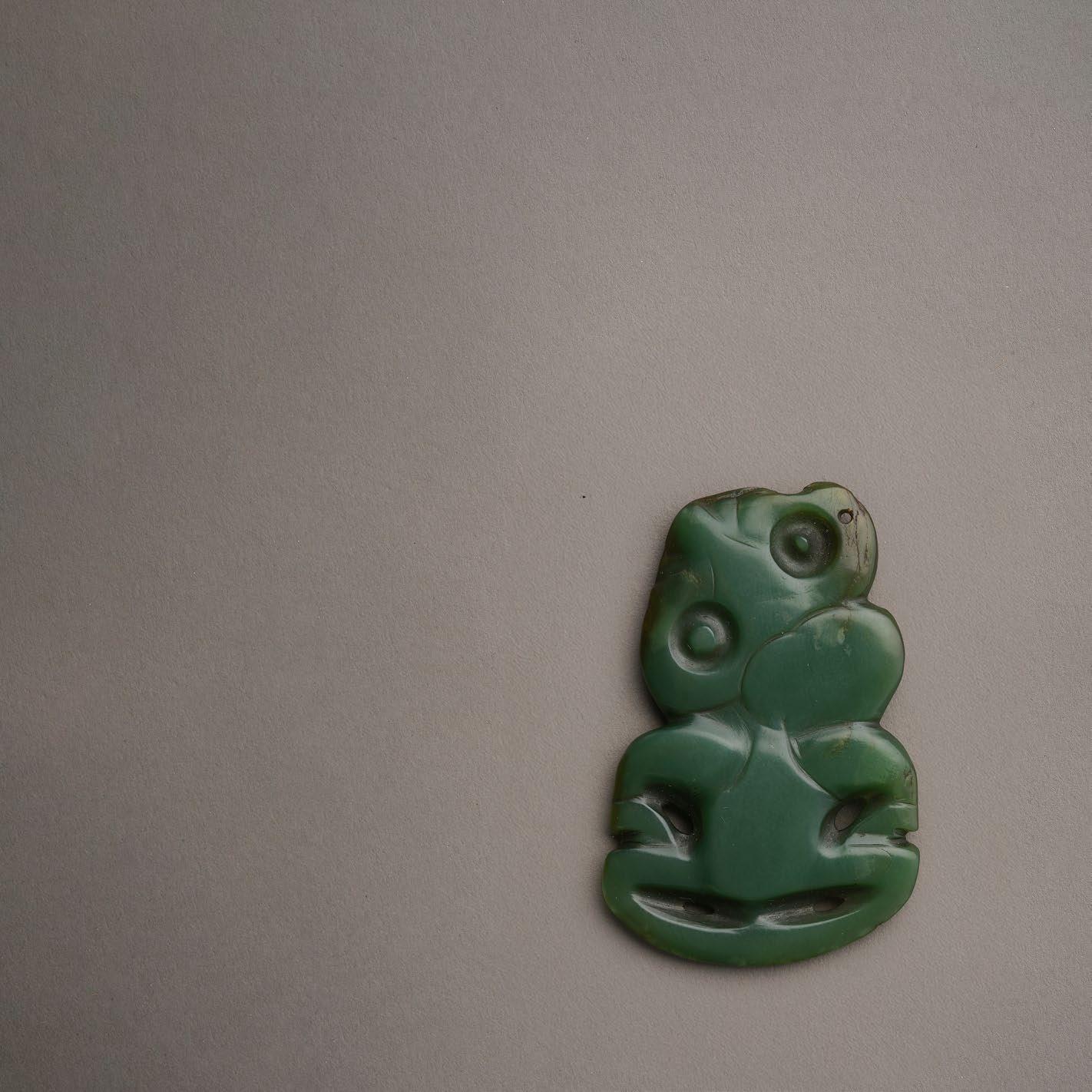
An Important Pre-European Hei Tiki Māori, Aotearoa, New Zealand, 18th century or earlier
A small classic type I form carved in even olive-green inanga variety stone. The broad head displays two deeply recessed eye rings with faintly incised remains of a nasal bridge extending to the top of the head and a single outline for the mouth. The arms have sharply angled elbows and unmarked hands. The legs are fine and continuous. The original stonedrilled suspension hole has broken out, and a second small hole has been drilled straight through the top right side. The significant surface wear commensurate with great age and use.
Protected Objects Act (1975) Registration Number Y9312
5.8cm length, 3.8cm wide
PROVENANCE
Collection Kenneth Athol Webster (1906 – 1967), Wellington
Purchased at Dunbar Sloane, Auckland, March 2005. Lot 287 Kalimantan Collection, Roger Edmonds
Purchased by tender at Dunbar Sloane, Auckland, 20 April 2011
Collection Robert Lerner (1960–2022)
NZ$2,000–3,000

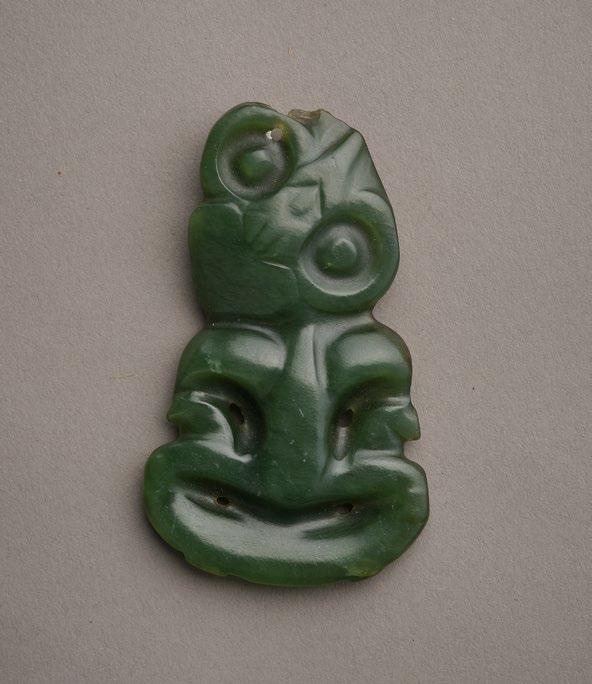
A Pre-European Hei Tiki
Māori, Aotearoa, New Zealand, late 19th century or earlier
A classic type I hei tiki carved in highly polished smooth inanga variety stone with pale inclusions to the face. The facial features are heavily worn, with eye-rings still baring aged red sealing wax embellishment (probably added later). The body is slightly asymmetric from left to right, with flat verso and gently rounded front. There are no clear markings on the body. Large countersunk suspension hole to the top of the head.
Protected Objects Act (1975) Registration Number Y10791
10.5cm length, 6cm wide
PROVENANCE
Purchased Dunbar Sloane, Auckland, November 2006, Lot 1110
Kalimantan Collection, Roger Edmonds
Purchased by tender at Dunbar Sloane, Auckland, 20 April 2011
Collection Robert Lerner (1960–2022)
NZ$8,000–14,000
35
A Small Pre-European Hei Tiki
Māori, Aotearoa, New Zealand, 18th century or earlier
A small type I hei tiki carved in bright inanga variety stone. The facial features display deep widely recessed double ringed eyes with a lightly defined nasal ridge, the heart shaped mouth details are worn. The concealed stone-drilled suspension hole has broken out from age and generational use. The small hole to the right eye-ring has been later drilled.
Protected Objects Act (1975) Registration Number Y1249
8.7cm length, 5.2cm wide
PROVENANCE
Purchased from Liverpool antique dealer Mr Joseph Trentini by Dunbar Sloane Snr and brought back to New Zealand in 1981. The sea ports of Liverpool, Dublin, were a good source for early tribal art brought back by whalers and sealers during the late-18th and 19th centuries.
Purchased at Dunbar Sloane, Auckland, November 1982. Lot 1015
Kalimantan Collection, Roger Edmonds
Purchased by tender at Dunbar Sloane, Auckland, 20 April 2011
Collection Robert Lerner (1960–2022)
NZ$10,000–15,000


36
A Pounamu Kuru (Ear Pendant)
Māori, Aotearoa, New Zealand, 19th century or earlier
Slightly uneven cross-section with countersunk suspension hole.
Carved in kawakawa variety stone.
Protected Objects Act (1975) Registration Number Y8790
6.7cm
PROVENANCE
Purchased at Dunbar Sloane, Auckland, June 1999. Lot 1298
Kalimantan Collection, Roger Edmonds
Purchased by tender at Dunbar Sloane, Auckland, 20 April 2011
Collection Robert Lerner (1960–2022)
NZ$300–500
37
A Pre-European Hei Tiki
Māori, Aotearoa, New Zealand, 18th century or earlier
A type I form carved in inanga variety stone with milky pale mottled inclusions. The facial features display deep wide slightly asymmetrical eye rings with faint traces of incised detailing to the nose and mouth. Small concealed stone-drilled suspension hole though the back of the head.
Protected Objects Act (1975) Registration Number Y2584
9.8cm length, 5.5cm wide
PROVENANCE
Originally purchased by Dunbar Sloane Snr from George Walker Auction House, Auckland, in 1972
Purchased at Dunbar Sloane, Auckland, August 2004. Lot 27
Kalimantan Collection, Roger Edmonds
Purchased by tender at Dunbar Sloane, Auckland, 20 April 2011
Collection Robert Lerner (1960–2022)
NZ$5,000–10,000

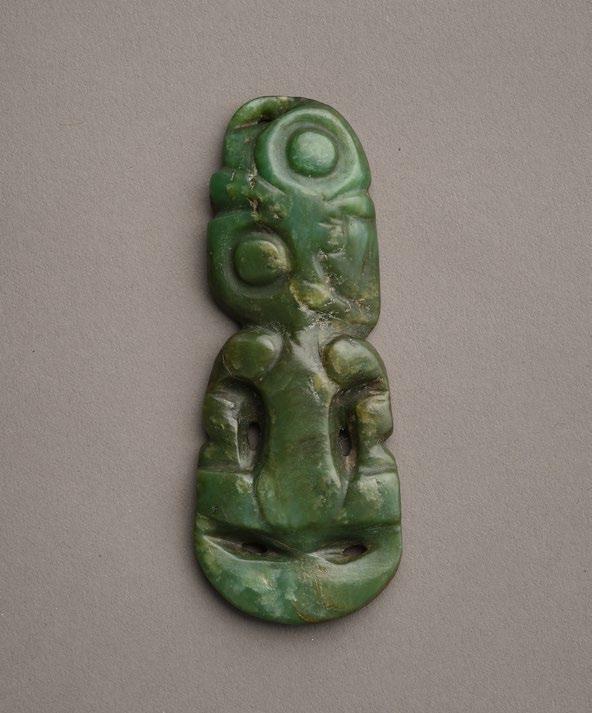
38
An Impressive Pre-European Hei Tiki
Māori, Aotearoa, New Zealand, 18th century or earlier
A superb type I form carved in rare opaque olive-green ruakaraka pounamu—rare kawakawa variety with an orange-hued oxidised crust and olive to light green flesh.
The head displays widely recessed eyes, a detailed nasal bridge with a diamond pattern and clearly defined nostrils over a lightly marked mouth.
Unusual deep wide triangulated ribs carved to the torso with three split toes forming the feet. Partially concealed suspension hole stoned-drilled through the back of the head.
Protected Objects Act (1975) Registration Number Y7874 11cm length, 4.7cm wide
PROVENANCE
Purchased at Dunbar Sloane, Auckland, August 2004. Lot 26
Kalimantan Collection, Roger Edmonds
Purchased by tender at Dunbar Sloane, Auckland, 20 April 2011
Collection Robert Lerner (1960–2022)
NZ$10,000–15,000
39
A Pre-European Hei Tiki
Māori, Aotearoa, New Zealand, 18th century
A long narrow type I hei tiki carved in mottled inanga variety stone. With double ringed eyes, ribs to the torso, and unmarked hands and feet.
Stone-drilled suspension hole through the top of the head.
Protected Objects Act (1975) Registration Number Y7813 10.3cm length, 4.1cm wide
PROVENANCE
Collection of Sir Arthur Maitland Hughes, OBE (1924–2005), ex All Black and prominent figure in the racing industry.
Purchased at Sotheby's, London, November 1982
Kalimantan Collection, Roger Edmonds
Purchased by tender at Dunbar Sloane, Auckland, 20 April 2011
Collection Robert Lerner (1960–2022)
NZ$4,000–8,000

A Pre-European Hei Tiki Carved in Dark Kawakawa Pounamu Māori, Aotearoa, New Zealand, 18th century or earlier
A classis type I hei tiki carved in deep dark green almost black kawakawa variety stone with faint pale markings on the belly. Deeply carved with vivid facial details, double eye rings with a nasal ridge extending to the peaked forehead and heart shaped mouth displaying a tongue and three teeth. The torso shows a delineated neck and rib markings with a curved belly. The legs are continuous and slightly peaked near the unmarked toes. Stone-drilled concealed suspension hole through the back to the top of the head.
Protected Objects Act (1975) Registration Number Y9313 11.5cm length, 5.2cm width
PROVENANCE
Collection Kenneth Athol Webster (1906–1967), Wellington Purchased private sale Dunbar Sloane, November 2005. Kalimantan Collection, Roger Edmonds
Purchased by tender at Dunbar Sloane, Auckland, 20 April 2011
Collection Robert Lerner (1960–2022)
NZ$12,000–18,000

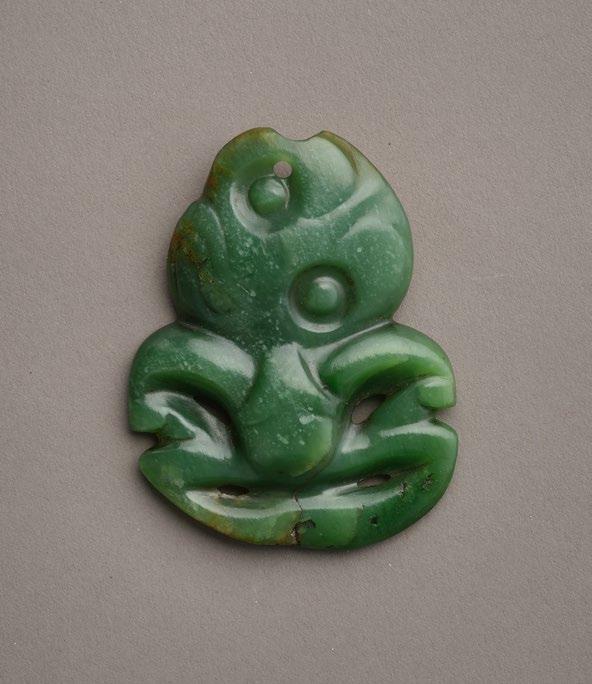
Two Toki (Adze Blades)
Māori, Aotearoa, New Zealand, 18th century or earlier
Two small toki made in argillite. Smooth surface polish quadrangular form with intact cutting edges.
Protected Objects Act (1975) Registration Numbers Y5856, Y5857 Left, 6.2cm length, 2.9cm wide, Right, 5.4cm length, 3.5cm
PROVENANCE
Purchased at Haywards Auctions, Whanganui, 2004
Kalimantan Collection, Roger Edmonds
Purchased by tender at Dunbar Sloane, Auckland, 20 April 2011
Collection Robert Lerner (1960–2022)
NZ$300–500
42
A Pre-European Hei Tiki
Māori, Aotearoa, New Zealand, 18th century or earlier
A good example of the more unusual type I hei tiki distinguished by its oval outline with elbows forming the widest points. Hei tiki of this shape are believed to have originated either from cut tabs of pounamu that were subsequently rounded off, or from naturally oval-shaped stones selected for their form. Carved in bright Kawakawa variety stone with a scatter of small pale inclusions. The early stone-drilled suspension hole has broken out with a second added later.
Protected Objects Act (1975) Registration Number Y3201 8cm length, 6.3cm wide
PROVENANCE
Private sale Dunbar Sloane, Auckland, April 1996.
Kalimantan Collection, Roger Edmonds
Purchased by tender at Dunbar Sloane, Auckland, 20 April 2011
Collection Robert Lerner (1960–2022)
NZ$4,000–8,000
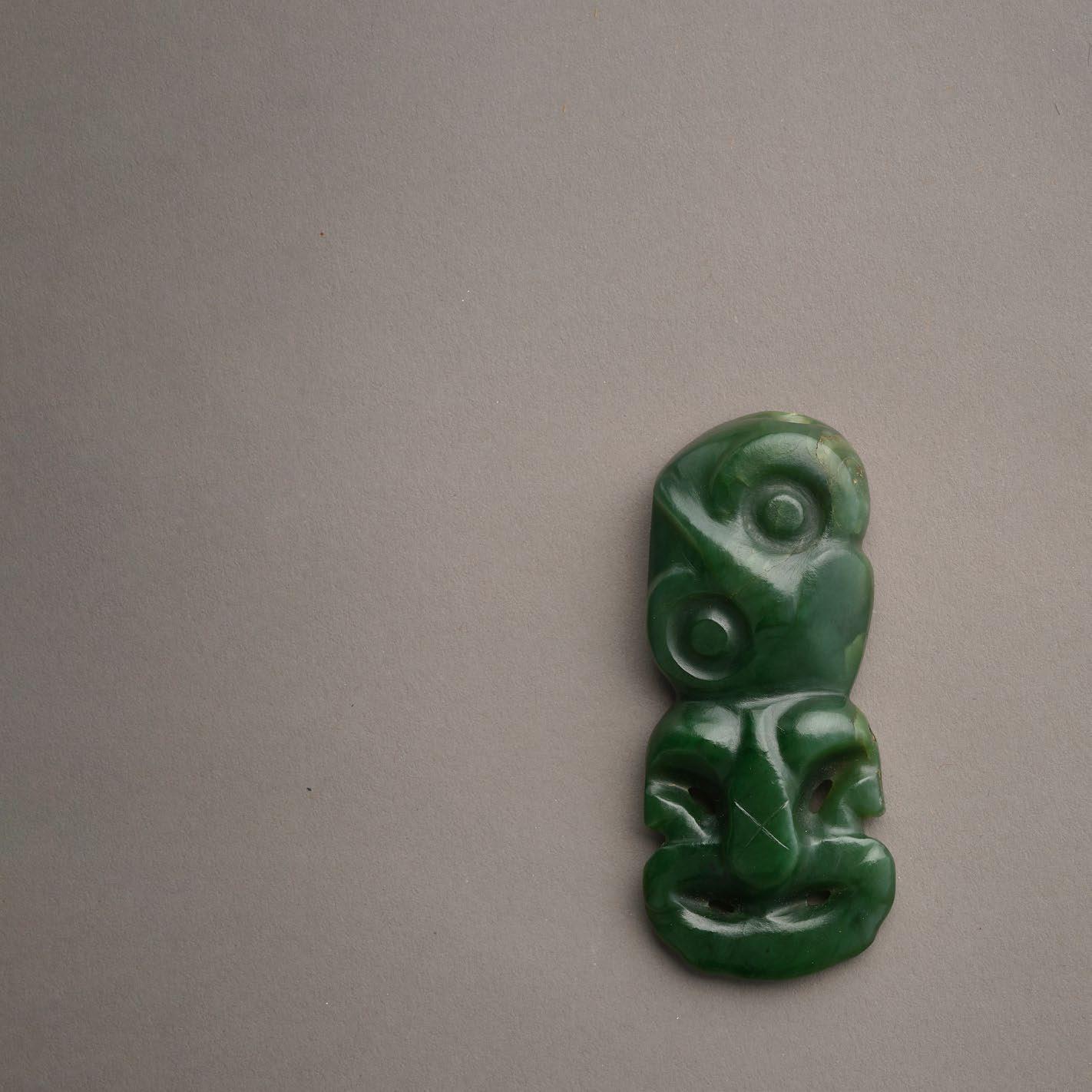
43
A Superb Pre-European Hei Tiki Māori, Aotearoa, New Zealand, 18th century or earlier
A type I form carved from kawakawa variety stone with pale milky casts to the face. The face displays beautifully formed eye rings, a long triangular nasal ridge extending to the top of the head, and a smooth polished heart shaped mouth. The body is delineated with a narrow neck and shallow x is etched across the belly, the back is smooth and flat. Concealed suspension hole through the back of the head. This superbly carved hei tiki is one of two in this offering that carries the dual Provenance of Sir Jacob Epstein and Carlo Monzino. Protected Objects Act (1975) Registration Number Y13202
10.4cm length, 4.4cm wide
PROVENANCE
Collection Sir Jacob Epstein (1880-1959), New York City
Purchased from the above, 1965
Collection Carlo Monzino (1933-1996), Milan
Purchased by private sale, Dunbar Sloane, 2007
Kalimantan Collection, Roger Edmonds
Purchased by tender at Dunbar Sloane, Auckland, 20 April 2011
Collection Robert Lerner (1960–2022)
REFERENCE
Pictorially referenced in., Epstein, J., Bassani, E., & McLeod, D. M. (1989). Jacob Epstein: Collector. Associazione Poro.
NZ$6,000–12,000
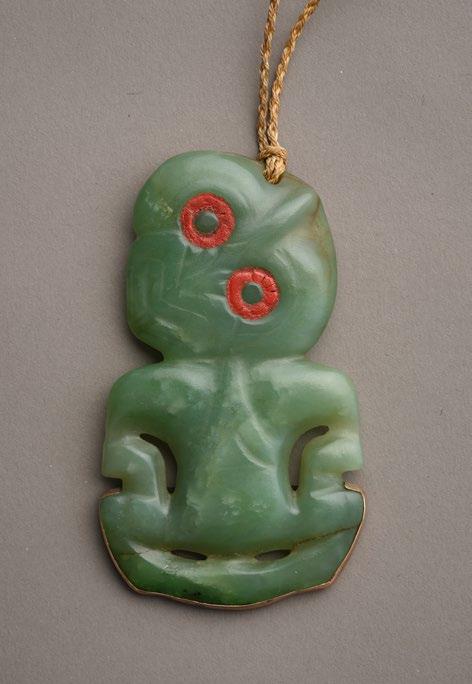

A Hei Tiki with Gold Backing and Bone Toggle Māori, Aotearoa, New Zealand, 19th century of earlier
A type I hei tiki carved in milky pale inanga variety stone. Facial features displaying eye rings embellished with red sealing wax and distinctive nasal ridge extending to the top of the head. The legs broken away and repaired with a 9ct gold plaque attached verso. Countersunk suspension hole with attached muka binding and bone toggle.
Protected Objects Act (1975) Registration Number Y10520 10cm length, 4.8m wide
PROVENANCE
Collection Robert Lerner (1960–2022)
NZ$3,000–5,000
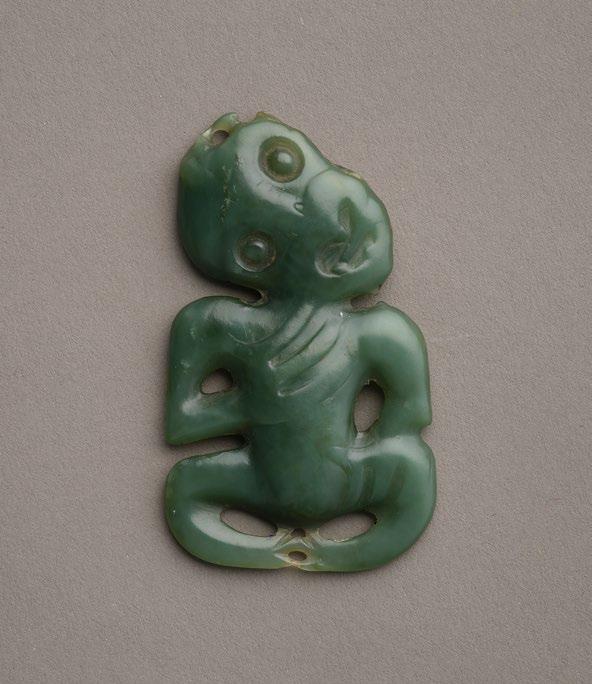
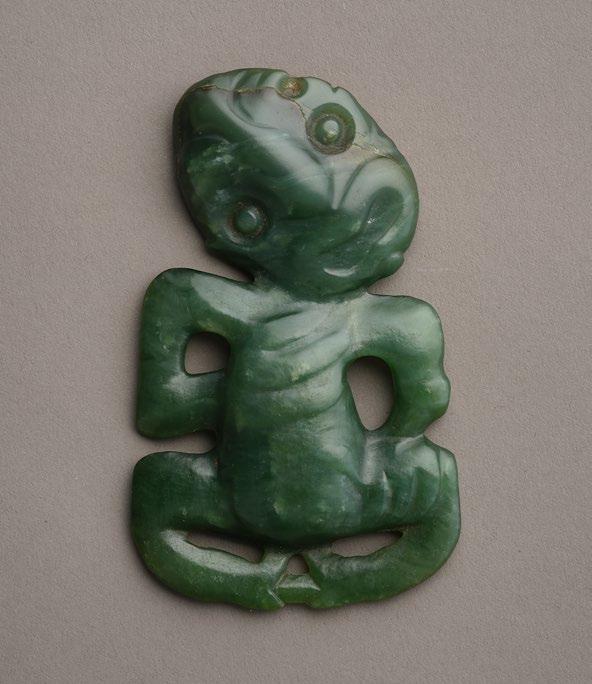
45
A Small Finely Carved Pre-European Hei Tiki
Māori, Aotearoa, New Zealand, 18th century or earlier
A classic type II hei tiki carved in superb grey-green inanga variety stone, groin markings indicate female sex. The facial features showing small wide set eye rings and heart shaped mouth with forked tongue flicking to the side. The left hand to chest displays a finely carved thumb and three fingers, with index finger held to the mouth conferring her special character. Two stone-drilled suspension holes, one broken out indicating her great age and generational use.
Protected Objects Act (1975) Registration Number Y7810
7.2cm length, 4.3cm wide
PROVENANCE
Collection Sir Arthur Maitland Hughes, OBE (1924–2005), ex All Black and prominent figure in the racing industry.
Purchased at Dunbar Sloane, Auckland, May 2006. Lot 15
Kalimantan Collection, Roger Edmonds
Purchased by tender at Dunbar Sloane, Auckland, 20 April 2011
Collection Robert Lerner (1960–2022)
NZ$15,000–25,000
46
A Superb Large Pre-European Hei Tiki
Māori, Aotearoa, New Zealand, 18th century or earlier
A superb example of an early type II hei tiki carved in kawakawa variety stone with pale milky inclusions. The head displays tiny ear and chin projections, small recessed eyes with surmounting crescent shaped eyebrow markings and lightly detailed nasal bridge and mouth. Details of the three fingered hands to chest and thigh are finely carved and clearly visible. The stone-drilled suspension hole has worn thin at the center, with a possible broken suspension hole nearby.
Protected Objects Act (1975) Registration Number Y10751
10.4cm length, 6.6cm wide
PROVENANCE
Purchased at Dunbar Sloane, Auckland, May 2006. Lot 15
Kalimantan Collection, Roger Edmonds
Purchased by tender at Dunbar Sloane, Auckland, 20 April 2011
Collection Robert Lerner (1960–2022)
NZ$15,000–20,000
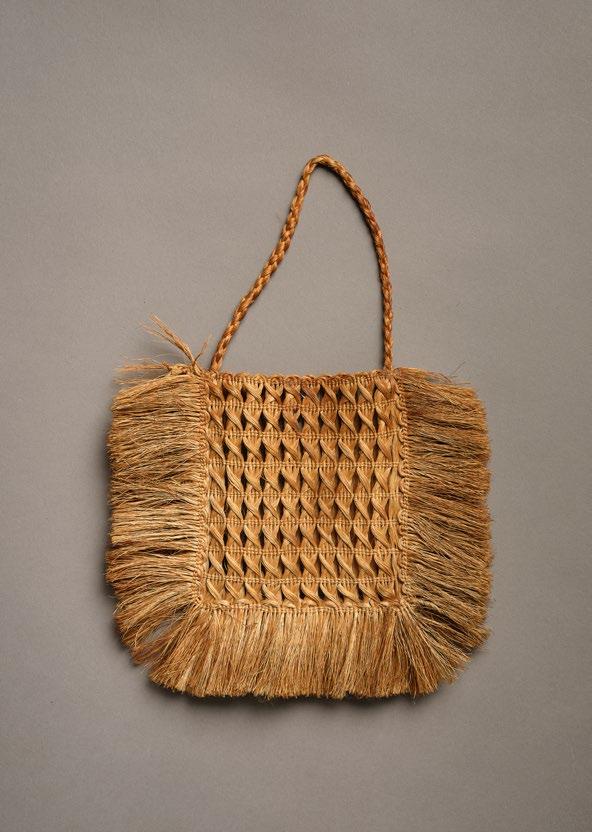

47
Small Woven Muka Kete
Māori, Aotearoa, New Zealand, early 20th century
Handwoven from prepared flax fibre (muka), this small kete features a tight diamond-patterned weave and a soft fringe along the edges. Likely used for carrying small personal items.
Protected Objects Act (1975) Registration Number Y22942
17cm length, 19cm wide
PROVENANCE
Collection Robert Lerner (1960–2022)
NZ$800–1,200
48
A Woven Muka Wall-Pouch
Māori, Aotearoa, New Zealand, early 20th century
Small wall-mounted pouch woven from prepared flax fibre (muka) with fabric backing.
Protected Objects Act (1975) Registration Number Y09674
35cm length, 23cm wide
PROVENANCE
Collection Robert Lerner (1960–2022)
NZ$500–800

A Large and Important Pre-European Hei Tiki Māori, Aotearoa, New Zealand, 18th century or earlier
A superb large type I example carved in kawakawa variety stone with distinctive pale mottled inclusions. The left tilting head displays small deeply recessed eyes with surmounting eyebrow markings, a detailed but slightly worn nasal ridge and finely carved heart shaped mouth with tongue and teeth clearly visible. The body is thick and muscular with well defined shoulders and elbows. Concealed stone-drilled suspension hole through the back of the head.
This superbly carved hei tiki is one of two in this offering that carries the layered Provenance shared by Sir Jacob Epstein and Carlo Monzino reflecting both the mana of ancestral Māori craftsmanship and the discerning eye of two major 20th-century collectors.
Protected Objects Act (1975) Registration Number Y13201
12.3cm length, 6.7cm width
PROVENANCE
Collection Sir Jacob Epstein (1880 - 1959), New York City
Purchased from the above, 1965
Collection Carlo Monzino (1933 - 1996), Milan
Purchased by private sale, Dunbar Sloane, 2007
Kalimantan Collection, Roger Edmonds
Purchased by tender at Dunbar Sloane, Auckland, 20 April 2011
Collection Robert Lerner (1960–2022)
REFERENCE
Pictorially referenced in., Epstein, J., Bassani, E., & McLeod, D. M. (1989).
Jacob Epstein: Collector. Associazione Poro.
NZ$15,000–25,000
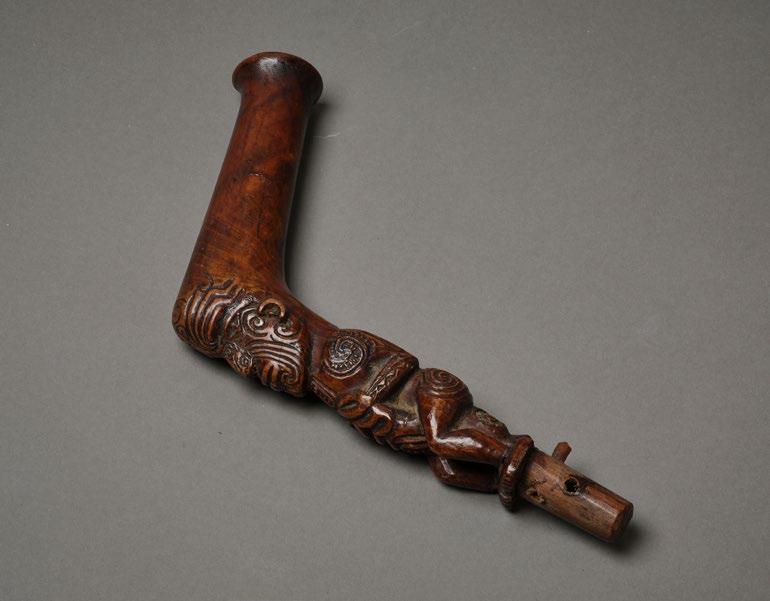

50
A Tokotoko Handle
Māori, Aotearoa, New Zealand, 19th century
The upper section of a ceremonial Māori walking stick displaying a finely carved tane figure with naturalistic face and ta moko tattoo.
Comes with stand.
Protected Objects Act (1975)
Registration Number Y13628
20cm length, 9cm wide
PROVENANCE
Collection Robert Lerner (1960–2022)
NZ$3,000–6,000
51
A Tokotoko (Ceremonial Walking Stick)
Māori, Aotearoa, New Zealand, early 20th century
Carved wood with cloaked figure and cut paua shell decoration.
Protected Objects Act (1975)
Registration Number Y13849
87cm height
PROVENANCE
Collection Robert Lerner (1960–2022)
NZ$2,000–3,000
A Carved Model Canoe Prow (Tauihu) Māori, Aotearoa, New Zealand, 19th century
With standing wheku figurehead ornamented with rauponga spirals carved with triple hae hae and pataki (lower section of the front leg missing). To the rear is an ancestral figure with hands clasped to the belly. The middle section is carved with the traditional pitau whakareia forms (perforated double spiral) typical of a waka taua (Māori war canoe figurehead). Ebonised and embellished with cut paua shells (two missing).
Protected Objects Act (1975) Registration Number Y15077 22cm height, 43cm length
PROVENANCE
Collection Robert Lerner (1960–2022)
NZ$15,000–25,000



A
Toki Poutangata Handle with Associated Blade
Māori, Aotearoa, New Zealand, 19th century or earlier
The handle with finely carved wheku head figure and rauponga pattern terminating with a second wheku head. Inlaid with cut paua shell.
Protected Objects Act (1975) Registration Number Y12251, Y14964
30cm length, 16cm
PROVENANCE
Collection Robert Lerner (1960–2022)
NZ$3,000–5,000 54
A Mere Pounamu
Māori, Aotearoa, New Zealand, 19th century
Carved in superb kawakawa variety stone with distinctive pale inclusions. Wide flat blade with sharp translucent edge.
Protected Objects Act (1975) Registration Number Y10900
35.5cm length, 12cm wide
PROVENANCE
Purchased at Dunbar Sloane, Auckland, November 2006. Lot 1111
Kalimantan Collection, Roger Edmonds
Purchased by tender at Dunbar Sloane, Auckland, 20 April 2011
Collection Robert Lerner (1960–2022)
NZ$5,000–8,000

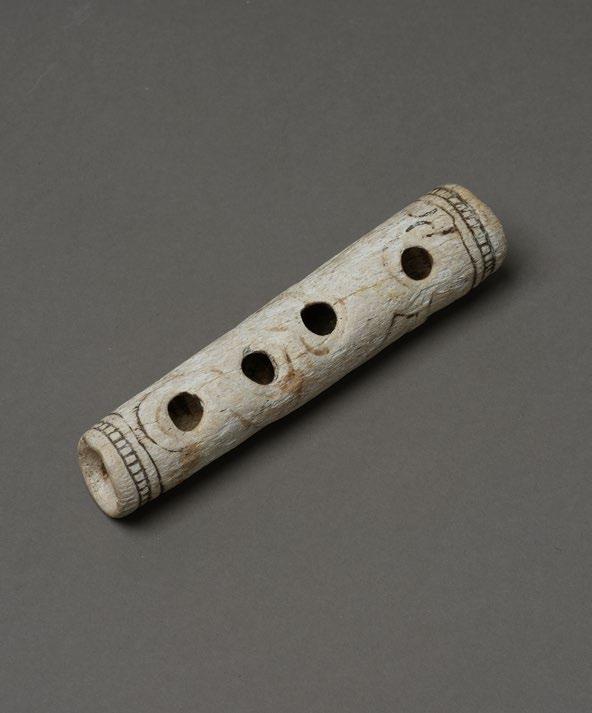
55
A Feather Kete
Māori, Aotearoa, New Zealand, 19th century
A woven muke kete decorated with pheasant feathers.
Protected Objects Act (1875) Registration Number Y22941 21cm height, 15cm wide
PROVENANCE
Collection Robert Lerner (1960–2022)
NZ$2,000–4,000
56
A Nguru (Māori Nose Flute)
Māori, Aotearoa, New Zealand, 19th century or earlier
The nguru is a traditional nose flute that is unique to Aotearoa New Zealand. It has an up-turned snout end, into which the player exhales through one nostril, and perforated holes, or 'note-stops' (wenewene) along the length of the stem which produce melodious low-sobbing notes that invoke the voice of Hineraukatauri, the female ancestral spirit of Māori music. Nguru can be made of wood, stone, or bone and were often played at times of great sorrow, such as tangihanga (funerary events).
Protected Objects Act (1975) Registration Number Y13965 13cm length
PROVENANCE
Collection Robert Lerner (1960–2022)
NZ$8,000–12,000

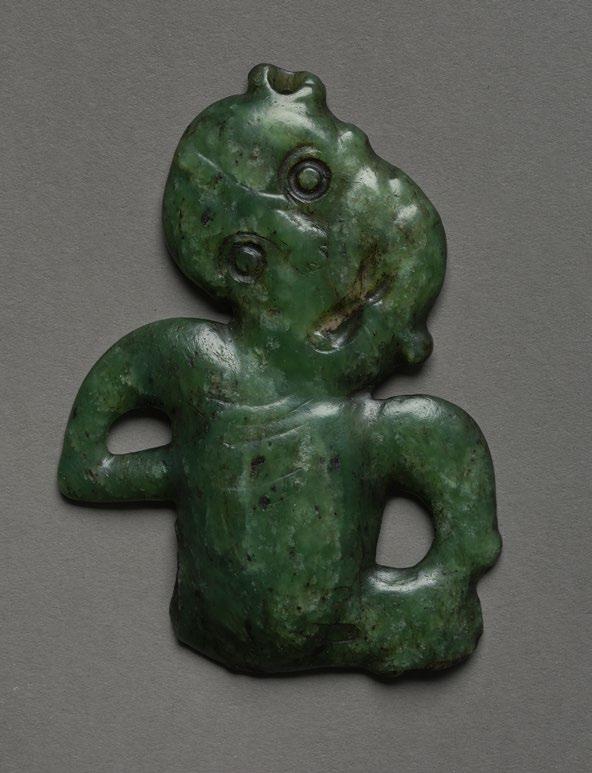
A Hei Tiki
Māori, Aotearoa, New Zealand, 19th century
Carved in inanga variety stone with pale feathery inclusions. Polished surface.
Protected Objects Act (1975) Registration Number Y7662
7.3cm length, 4.5cm wide
PROVENANCE
Purchased at Dunbar Sloane, Auckland, March 2005. Lot 232
Kalimantan Collection, Roger Edmonds
Purchased by tender at Dunbar Sloane, Auckland, 20 April 2011
Collection Robert Lerner (1960–2022)
NZ$10,000–15,000 58
A Rare Pre-European Pounamu Hei Tiki
Māori, Aotearoa, New Zealand, 18th century or earlier
Kawakawa variety stone with inanga inclusions, type II form with fine facial details showing some ware, three-fingered hands with thumbs to the chest and thigh. Suspension hole on outstanding lug. Female sex indicated. Right thigh and legs broken away.
Protected Objects Act (1975) Registration Number Y09294 13cm height
PROVENANCE
Collection Andrew Miet
Collection Betty Reily
Collection Patick O'Conner
NZ$10,000–15,000
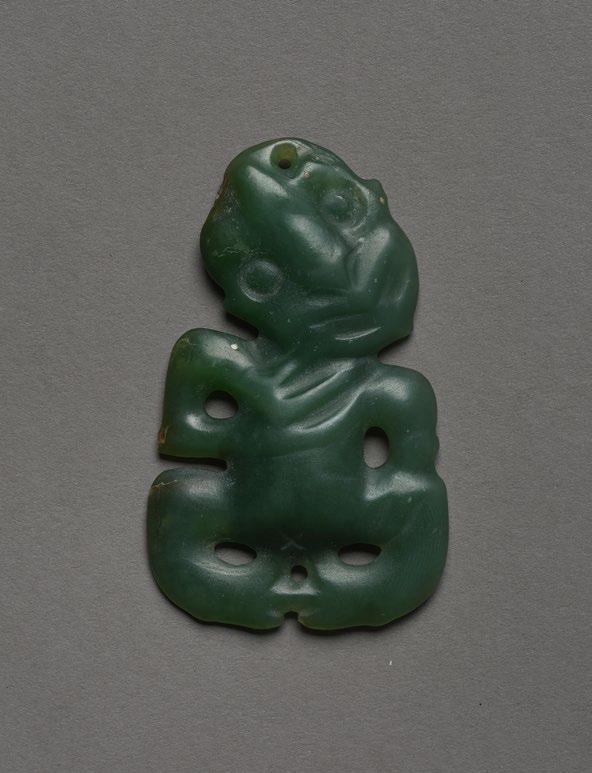
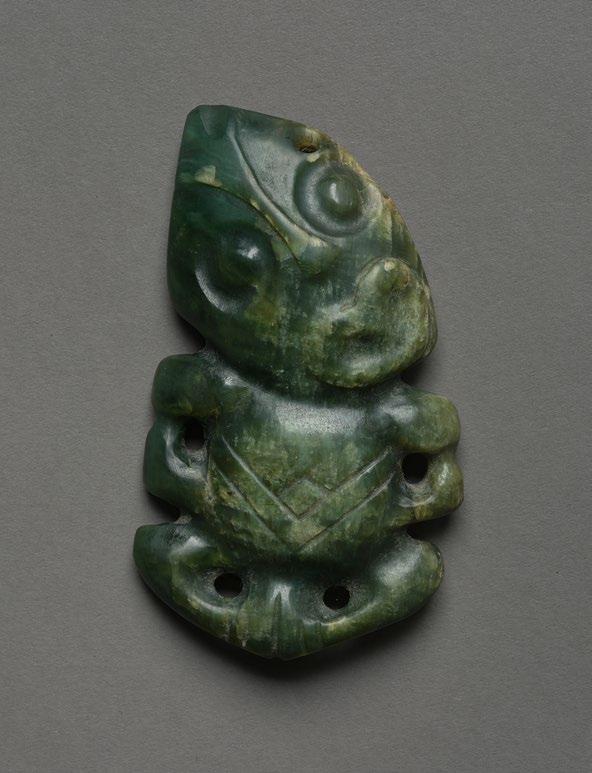
59
A Finely Carved Pre-European Hei Tiki
Māori, Aotearoa, New Zealand, 18th century or earlier
A Type II female form finely carved in the highly prized kahurangi variety stone. Facial feature display small recessed eye rings, chin and ear projections with right index finger held to a finely rendered heart shaped mouth. Well defined three-fingered hands with thumbs held to chest and thigh, intact countersunk suspension hole to the top of the head.
Protected Objects Act (1975) Registration Number Y090026 8cm length, 4.5cm wide
PROVENANCE
Collection Dame Jenny Gibbs, Wellington
Purchased at Dunbar Sloane, Wellington, October 2022, lot 139
Collection Patrick O'Connor, Auckland
NZ$15,000–20,000
60
A Hei Tiki
Māori, Aotearoa, New Zealand, 19th century
A type I hei tiki carved in kawakawa variety stone with pale cloudy inclusions. The unusual, peaked head suggests a spiritual connection to a maunga (mountain).
Protected Objects Act (1975) Registration Number Y number pending 10.5cm height, 6cm wide
PROVENANCE
Collection Betty Riley
Collection Patrick O'Connor Maunga hold profound significance in Māori culture, woven through mythology, whakapapa (genealogy), and daily life. They are not merely landforms but tupuna—ancestral beings—whose presence anchors iwi (tribes) to place and history.
NZ$4,000–6,000
PATOROMU TAMATEA
An Historically Important Kumete Whakairo
(Carved Lidded Presentation Bowl)
Māori, Aotearoa, New Zealand, 19th century
The large and impressive kumete carved with two figures each modelled in a crouching position holding the bowl in their outstretched arms and supporting it on their legs with their chins resting on the bowl rim. Each figure with four fingered hands and naturally rendered face decorated with ta moko. The bodies of each extensively carved with rauponga (notched ridges and parallel grooves) and pikorauru (spiral) designs. The bowl is extensively carved with a fine design of rauponga conforming with the design on the figures. Each side of the bowl is carved with an ancestral figure rendered in low relief with a wheku head and protruding tongue. The carved lid with two outward facing relief carved figures with splayed legs held in their three fingered hands. The head of each carved in wheku form with protruding tongue. Each figure decorated with rauponga and with pikorauru designs to the shoulder above the main lid section which is decorated with further rauponga patterning. Superb overall colour and with rich patination to the head of each crouching figure.
Protected Objects Act (1975) Registration Number Y1436
30cm height, 42cm wide
PROVENANCE
Gifted by the chiefs of the Te Arawa tribe to Robert Graham M.P in 1878 in acknowledgment for his work in settling peace over a land dispute between the chiefs Te Pokiha of Ngati Pikiao and Petera Te Pukuatua of Ngati Whakaue: Retained in the Graham family collection from 1878-2009. Sold by Dunbar Sloane Auckland in November 2009.
Private Collection Auckland.
Patrick O'Connor collection
REFERENCE
Neich, R. (2001). Carved histories: Rotorua Ngati Tarawhai woodcarving Auckland University Press.
NZ$260,000–300,000
From Tradition to Innovation: The Significance and Importance of Patoromu Tamatea’s Masterpiece Kumete Whakairo
The kumete whakairo presented here is one of three large and historically significant figure-supported bowls carved between 1865 and 1885 by the master carver Patoromu Tamatea. In 1878, it was gifted to Robert Graham, a member of Parliament, along with three other taonga in recognition of his role in resolving a major land dispute between two Te Arawa chiefs in Maketu, Bay of Plenty.
Patoromu Tamatea, of Ngati Tamateatutahi hapu, Ngati Pikiao, Rotorua, is widely recognized as an influential carver and community leader from the Te Arawa region. His body of work includes waka (canoes), tekoteko (gable figures), weapons, tokotoko (ceremonial walking sticks), and heru (combs). Notably, the Museum of New Zealand Te Papa Tongarewa and the Auckland War Memorial Museum both hold collections of his carvings. Among his most significant contributions is his mastery of large figure-supported bowls. Tamatea is credited as one of the pioneers of this form, and his works predate all other known examples from Ngati Tarawhai and Ngati Pikiao carvers.
These magnificent kumete whakairo, evolved from traditional carved whakahuia and kumete, demonstrate an innovative response to increased European demand for Māori carvings in the late 19th century. They were crafted as prestigious presentation pieces or commissioned by wealthy patrons. Of the three known examples, one resides in the collection of the Auckland War Memorial Museum, initially commissioned by
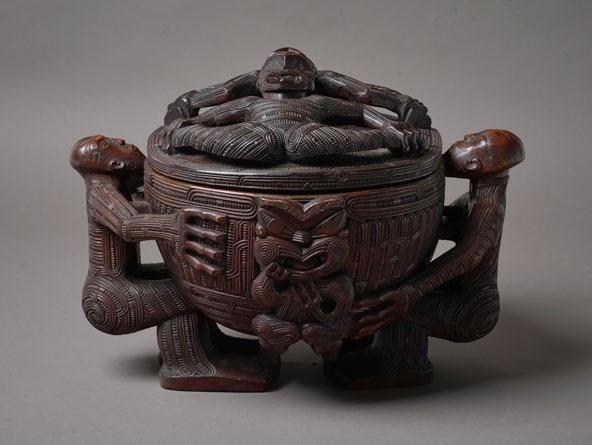

Sir George Grey during his tenure as Governor of New Zealand. Although it was completed after Grey’s departure, it later came into the possession of Captain Gilbert Mair and was deposited at the Auckland Museum as part of his collection.
Another example from this historically significant group of three, is housed in the Museum of New Zealand Te Papa Tongarewa. It was presented to Tamihana Te Rauparaha, son of renowned Ngati Toa chief Te Rauparaha, remembered today for popularizing the haka. Like the kumete in Auckland Museum and the one offered here, Tamatea’s distinct style is evident, featuring robust crouching figures, finely carved rauponga patterns, and relief-carved figures on the lid. His rauponga detailing is particularly refined, with tightly carved, interconnected haehae grooves— an artistic hallmark unique to his work.
The piece in this catalogue was specifically carved for Robert Graham, a Scottish-born politician who arrived in New Zealand at 22. Throughout his career, Graham served in the House of Representatives, Auckland Council, and as Superintendent of Auckland. A fluent speaker in te reo Māori and friend to Te Arawa, he was known as Ropata Karema among Māori communities. In June 1878, Graham was called upon to mediate a serious land dispute between Te Pokiha Taranui of Ngati Pikiao and Petera Te Pukuatua of Ngati Whakaue in Maketu. With tensions escalating towards warfare, Graham travelled three days on horseback from Auckland to Pukemarie Pa, successfully persuading the chiefs to postpone fighting while he negotiated with the government. His intervention led to a resolution, and in gratitude, Te Arawa chiefs gifted him 1,500 acres of land. Although this gift was later invalidated by the government, Graham also received a presentation of taonga, including two carved paddles and two significant Māori carvings.
This kumete was among those taonga, alongside a carved chalice by Anaha Te Rahui—known within Graham’s family as the ‘Peace Chalice’ for its association with the peace settlement he brokered. The chalice is now in Te Papa Tongarewa’s collection, and historical photographs taken by Josiah Martin around 1890 depict both pieces together. Additionally, the kumete was sketched in pencil by Richard Reverend Lashley, and his drawings and notes on Māori art are preserved in the British Museum. The presentation to Graham that included carvings from two different iwi within the Te Arawa region-the peace chalice by Anaha Te Rahui of Ngati Tarawhai and this kumete whakairo by Patoromu Tamatea of Ngati Pikiao signifies the deep artistic and cultural connections between the carvers
of this iwi. This has been observed and commented on by museum curator and scholar Roger Neich in his seminal book on the carving of the Ngai Tarawhai carvers Carved Histories. At some unknown point, the kumete, chalice, and paddles were separated, leaving this kumete as the only piece retained by Graham’s family. It was retained for over 130 years and passed on by descent until its sale in 2009.
This kumete whakairo, alongside the examples in the Auckland War Memorial Museum and Te Papa Tongarewa national collections, stand among the most historically and artistically significant Māori carvings of the late 19th century. Its connection to influential figures and pivotal moments further elevates its importance within the continuum of Māori artistic tradition.
This kumete stands as the most authentic of the three known examples. In contrast, the versions housed at Te Papa Tongarewa, and the Auckland Museum have undergone modifications, each fitted with lock escutcheons—likely repurposed at some stage to serve as donation boxes.
Tamatea’s innovative approach to carving and his adaption of traditional whakahuia and Kumete forms into magnificent Kumete whakairo, such as this. Informed Māori art and its development but also resonated well beyond Aotearoa leaving lasting impressions on artists such as Paul Gauguin. Gauguin encountered the companion piece to this kumete when he visited the Auckland War Memorial Museum in 1985, He sketched it and later incorporated its imagery into his paintings Te Rerioa (1897) and Still Life with Mangoes (1901).
Tamatea’s distinctive rauponga patterns—marked by their continuous, sinuous grooves—reflect a compelling interplay between tradition and artistic innovation. The way these motifs are rendered on the kumete anticipates the visual language of later New Zealand artists such as Gordon Walters, and Māori artists including Cliff Whiting, Sandy Adsett, Para Matchitt, and Rangi Kipa, each of whom reinterpreted ancestral forms to assert Māori design within a contemporary aesthetic. In this light, the kumete whakairo is far more than an historical object; it stands as a vital conduit within a living continuum, bridging classical Māori carving practices with evolving forms and the emergence of modern New Zealand art. It embodies an ongoing artistic dialogue - one that continues to evolve while remaining deeply grounded in cultural identity and ancestral narratives.
James Parkinson



62
A Rare and Important Signaling Taiaha (Fighting Staff)
Māori, Aotearoa, New Zealand, 19th century or earlier
The arero (tongue) finely rauponga spirals and pataki. Upoko (head) with small circular eyes inlaid with cut paua shell. Long slender tapering shaft with rounded end. Dark rich patina. Remains of an old collector's label affixed.
Protected Objects Act (1975) Registration Number Y1149
210.5cm height, 9cm wide
PROVENANCE
Private Collection Geff Hobbs, Sulu Gallery, Wellington
Collection Patrick O'Connor
A symbol of mana and authority, the signaling taiaha represents the prestige of the iwi or marae, and the bearer must be highly trained in mau rakau (Māori martial arts). These very large Taiaha are exceedingly rare. They were most likely used in warfare to signal and direct warriors on the battlefield. Very of few these rare, large and important artefacts are held in global public institutions and this one stands out as an exceptional example.
NZ$20,000–30,000
63
An Early Contact Period Pou Whakarae Head (Palisade Post)
Māori, Aotearoa, New Zealand, 18th century
Carved timber, the arresting head with full facial ta moko featuring deeply recessed wheku form eyes. The forehead with nga tiwana carved detail, the nose with double rauru spirals and with nga pae tarewa lines running from the nose and framing the mouth.
Protected Objects Act (1975) Registration Number Y14190
28cm height, 16cm wide
PROVENANCE
Purchased from Webb's, Oceanic Art and African Art, Auckland, June 2010
Collection Peter Strattford
Purchased Dunbar Sloane, Wellington, October 2022. Lot 195
Collection Patrick O'Connor
This impressive Māori sculpture was probably once part of the main palisade post of a Māori pa, or defensive settlement or hill fort.
NZ$20,000–25,000


A Superb Swamp Recovered
Pou
Māori, Aotearoa, New Zealand, 19th century
The upper section with remnants of an ancestral figure.
The lower section with a low relief carved ancestral figure with wheku head with three fingered hands placed to the chest.
186 x 32cm
NZ$8,000–12,000

65
A Rare Waka Taua Rauawa (Gunwale)
Māori, Aotearoa, New Zealand, early 19th century
Carved with side profile ancestral figures with wheku heads interlinked with mania figures with cut paua shell eyes. Pierced with holes to the upper and lower section to enable the board to be attached to the waka taua (war canoe) Red ochre painted finish. Fully restored to museum standards.
Protected Objects Act (1975)
Registration Number Y22608
246cm length, 30cm wide
PROVENANCE
Collection Peter Stratford, Auckland
Collection Patrick O'Connor, Auckland
NZ$16,000–24,000
66
A Rare Waka Taua Rauawa (Gunwale)
Māori, Aotearoa, New Zealand, early 19th century
Carved with side profile ancestral figures with wheku heads interlinked with mania figures with cut paua shell eyes. Pierced with holes to the upper and lower section to enable the board to be attached to the waka taua (war canoe) Red ochre painted finish. Fully restored to museum standards.
Protected Objects Act (1975)
Registration Number Y22609
200cm length, 30cm wide
PROVENANCE
Collection Peter Stratford, Auckland
Collection Patrick O'Connor, Auckland
NZ$16,000–24,000


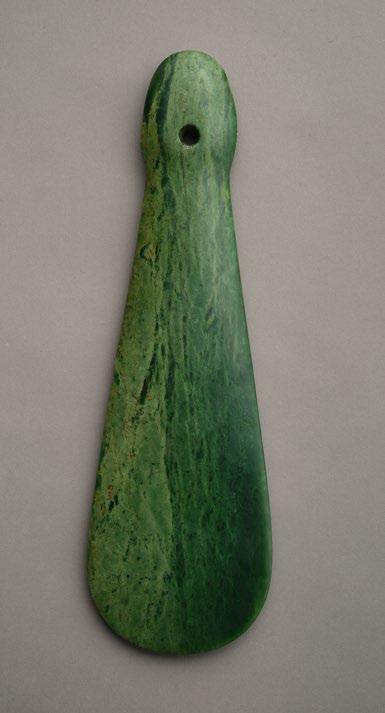


67
A Mere Pounamu
Māori, Aotearoa, New Zealand, 19th century
Spatulate shaped with pierced suspension hole. Inanga variety pounamu.
Protected Objects Act (1975)
Registration Number Y219897
35cm length
NZ$4,000–8,000
68
A Large and Impressive Toki Pounamu
Māori, Aotearoa, New Zealand, 19th century
Quadrangular shape with lapidary scarf to one side. Kawakawa variety pounamu with marsden inclusions.
Protected Objects Act (1975)
Registration Number Y1719
30cm length
PROVENANCE
Collection Bob Ching, Nelson
NZ$1,500–2,500
69
A Whale Bone Heru
Māori, Aotearoa, New Zealand, 19th century
The handle carved as a manaia figure in low relief 18cm length
Protected Objects Act (1875)
Registration Number Y22937 18cm length
NZ$1,000–2,000
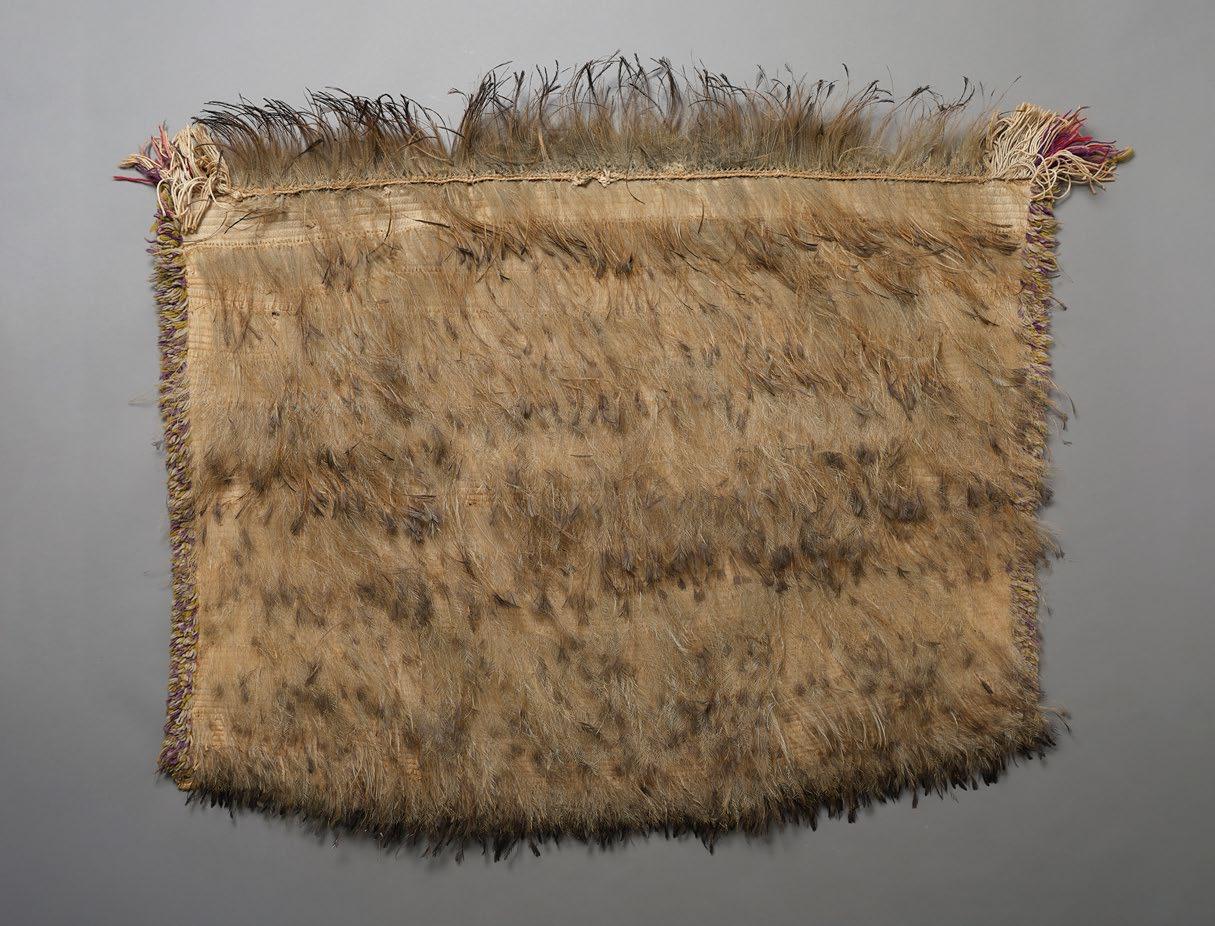
An Unusual Transitional Emu Feather Cloak
Māori, Aotearoa, New Zealand, early 20th century Muka weft-aho, worked in double finger pair twining.
With a candlewick boarder lined with white, green, purple and red wool.
Protected Objects Act (1975) Registration Number Y22876
105 x 95cm
PROVENANCE
Collection Dame Jenny Gibbs
NZ$5,000–10,000
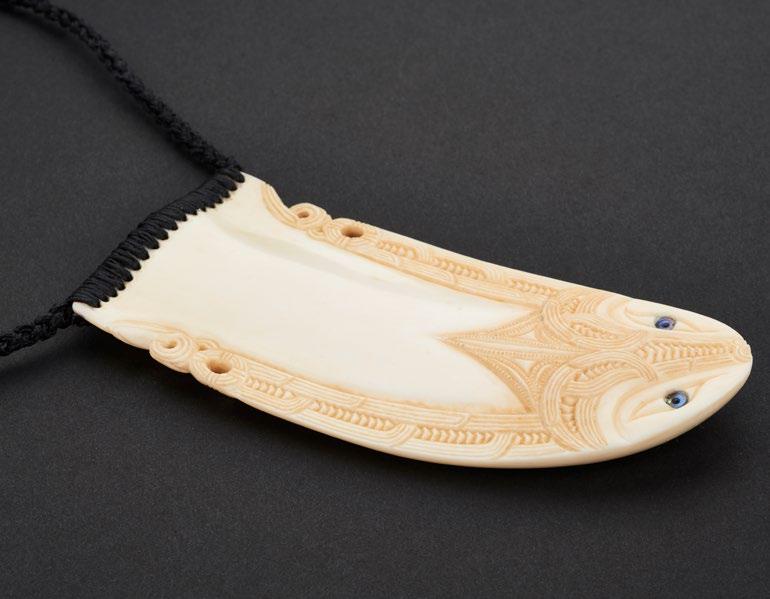

71
Gareth McGhie Rei Puta Kaiwhakatere (The Navigator)
Māori, Aotearoa, New Zealand, 2025
Carved from marine ivory. This large rei puta in marine is a contemporary take on the traditional Rei puta form featuring an animistic face at the base with two manaia figures running along each side featuring the pakati-hae-hae pattern work. With attached hand-woven binding.
13cm length
NZ$1,000–2,000
72
Gareth McGhie Rei Puta Kekeno
Carved from marine ivory. This contemporary Rei puta is representative of the seal and features the distinctive pakati-hae-hae pattern work through the face and central panel. With attached hand-woven binding.
11cm length
NZ$800–1,200
73
A Pounamu Hei Tiki by Alan Brown
Māori, Aotearoa, New Zealand
Finely carved in Inanga variety pounamu. Mounted on a swamp matai stand. 11.4cm height
Alan Brown is New Zealand master carver. He has been carving for over 30 years. He draws strongly from his Māori heritage to reflect the beauty of this land and the South Pacific in his work. He can trace his bloodline (through direct descent) to the canoes that came from Eastern Polynesia and the Great Migration of 1350 A.D. His work is displayed in national and international galleries, museums throughout the world.
NZ$4,000–6,000
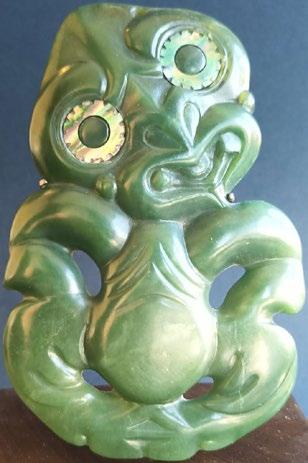
74
A Pair of Contemporary Hei Tiki by Master Carver Richard Anderson
Māori, Ngati Kahungunu, Tainui, Aotearoa, New Zealand
Finely carved matching pair of hei tiki in soft-hued inanga pounamu. Well-balanced proportions, deep incised features, and a smooth, luminous finish highlight the stone's natural beauty. The reverse equally detailed presented on burr totara stands also hand crafted by Richard. 11cm height
PROVENANCE
Private collection, Auckland.
Richard Anderson is a self-taught master carver celebrated for his precision and deep connection to the pounamu he works. Guided by both tradition and the stone itself, his creations are sought after by collectors worldwide.
NZ$14,000–18,000



A large and Impressive Hoe (Paddle) by Lyonel Grant (Ngati Pikiao, Te Arawa)
Māori, Aotearoa, New Zealand, circa 1975
The upper section carved with a figure of Papatuanuku conjoined with another figure and with Ranginui, the sky father carved at the top of the handle. The blade with a figure of tane above a marakihau. All inset with paua shell eyes.
230cm length
PROVENANCE
Private Collection, Auckland
This a rare and important carved hoe by one of New Zealand's most important contemporary master carvers. Lyonel Grant has exhibited nationally and internationally. His work is held in many Galleries and public institutions including The British Museum and The Museum of New Zealand, Te Papa Tongarewa.
NZ$12,000–18,000
76
An Asmat shield
Papua Region, Irian Jaya, early 20th century
A vertically oriented wooden shield carved in low relief and painted with white, brown and kaolin pigments. The reverse side is undecorated, with a central grip carved directly into the wood.
164cm height, 32cm wide
PROVENANCE
Mick Pendergrast Collection, Auckland
Ron Brownson Collection, Auckland
NZ$500–1,000
77
An Aboriginal Parrying Shield
Australia, 19th or earlier
Carved hardwood with convex surface and incised pattern to the surface. Carved handle to back.
85cm length, 12cm wide
NZ$2,000–4,000
78
A Kakame Figure
Papua New Guinea, Wapo Creek, 20th century
The standing figure with outstretched arms and quizzical expression. Made from naturally grown branches. Painted with ochre and lime pigments.
67cm height
PROVENANCE
Collection Ron Brownson, Auckland Kakame figures are typically kept in ceremonial houses with the treasure trophies of hunted animals.
NZ$600–1,200
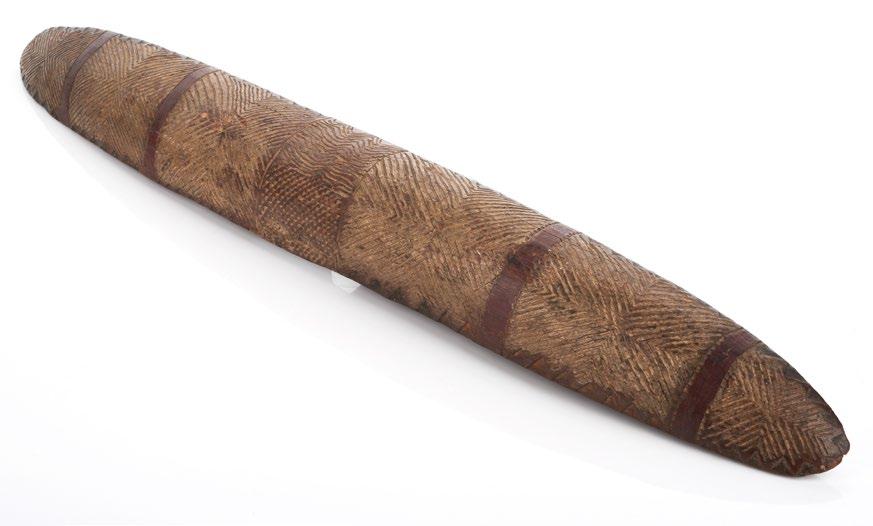
79
A Large and Impressive Kava Bowl Fiji, 19th Century
The circular bowl raised on three tapering legs. 64cm diameter
PROVENANCE
Fiji Museum. Deaccessioned from the collection in 1960
Ron Brownson collection, Auckland
NZ$800–1,600
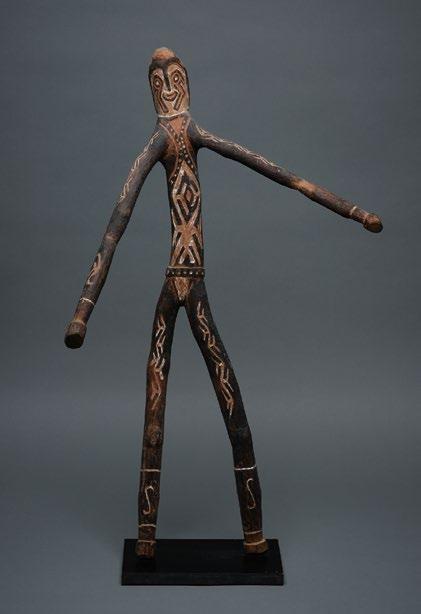
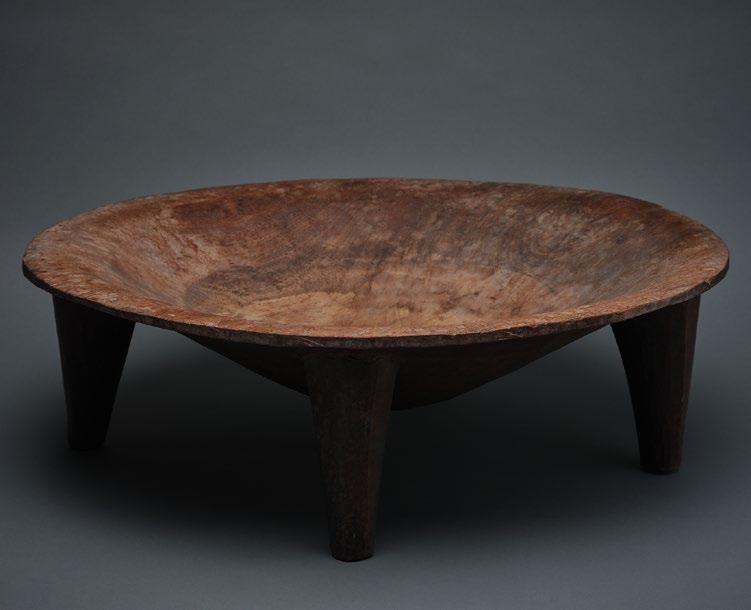
80
An Indonesian Ikat Bali, early 20th century
Depicting a warrior figure framed by a geometric pattern boarder with tassel fringe.
88 x 37cm
NZ$200–400
81
An Antique Anatolia Kelim Runner Rug
Southeast Anatolia, 19th century, circa 1875
Woven in two pieces with an anthropomorphic finial, floral and geometric design on a multicoloured field. The boarder with a conforming design. Kelim rugs of this design with distinctive and archaic looking anthropomorphic finials are rare.
317 x 242cm
PROVENANCE
Acquired from Netherhampton auctions, United Kingdom in 2010
Ron Brownson collection, Auckland
NZ$1,000–2,000
82
A Good Antique Turkman Ersari Beshir Rug circa 1890
With repeating floral and geometric guls in red and blue outlined in ivory.
161 x 148cm
PROVENANCE
Collection Ron Brownson, Auckland
NZ$1,000–2,000
83
An Antique Kurdish Flatweave Wool Rug Iran, late 19th century
Optical pattern design centered by two geometric guls framed by bands of geometric and stylised floral motifs in predominant red, blue and ivory.
118 x 110cm
PROVENANCE
Collection Ron Brownson, Auckland
NZ$500–1,000
84
A Good Caucasian Sumac Flatweave Wool rug
early 20th century
The central field with a black and white diamond lattice cheque pattern framed by a geometric lozenge design boarder and with blue, green and russet horizontal bands with scattered hook motifs.
275 x 162cm
PROVENANCE
Collection Ron Brownson, Auckland
NZ$1,000–2,000
85
A Caucasian Sumac Flatweave Wool rug 20th century
The central field with bold geometric and cheque pattern designs, the border with hook shaped motifs.
103 x 72cm
PROVENANCE
Collection Ron Brownson, Auckland
NZ$600–1,200
86
An Important and Rare Antique Bergama Anatolia Prayer Rug Turkey, Çanakkale-Bergama region, early 19th century, circa 1820
Rich natural dyes. Kerman hand-spun wool pile weft and warp, decorated with a blue outlined mihrab and tree of life design on a red field.
85 x 75cm
PROVENANCE
Collection of Jocelyn Tidswell
Collection Ron Brownson, Auckland. Purchased by Ron Brownson at Webb's auctions March 2003.
This rug was one of Ron Brownson's favourite rugs and was on display in his apartment. It was formerly in the collection of renowned rug collector Jocelyn Tidswell. Ron noted that it was the oldest rug in her collection.
NZ$1,500–2,500
87
An Impressive Uzbek Suzani Uzbekistan, 19th century
Cotton and silk weave with a repeating red rondel design, Each rondel with stylised black floral boarder
240 x 175cm
PROVENANCE
Collection Ron Brownson, Auckland
NZ$2,000–3,000
88
A Caucasian Flatweave Kilim Rug early 20th century
Decorated in horizontal bands with geometric motifs in pink, orange and brown.
83 x 48cm
PROVENANCE
Collection Ron Brownson, Auckland
NZ$500–1,000
89
A Large Caucasian Carpet early 20th century
Woven in two pieces with a stepped lozenge and geometric pattern with dark blue boarder.
195 x 153cm
PROVENANCE
Collection Ron Brownson, Auckland
NZ$1,000–2,000
90
An Indonesian Ikat Sumba Island, 20th century
Woven in two bands, each with four standing figures on a mauve, brown and purple.
218 x 115cm
PROVENANCE
Collection Ron Brownson, Auckland
NZ$200–400
91
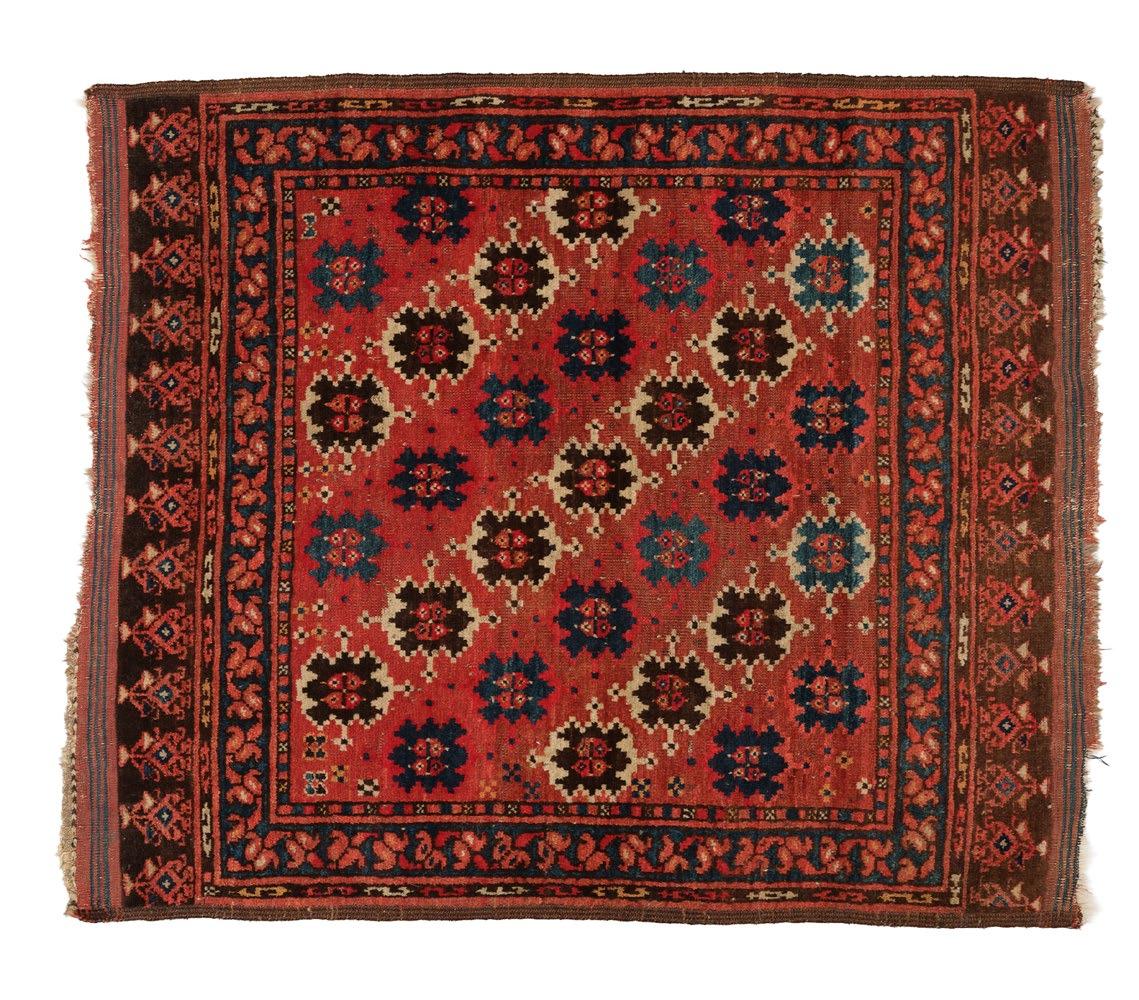
A Good Antique Turkeman Beshir Ersari Rug
19th century, circa 1860
Wool pile with repeating cruciform guls and bold geometric patterning on a red field
116 x 71cm
PROVENANCE
Collection of Jocelyn Tidswell. Collection Ron Brownson, Auckland. Purchased by Ron Brownson at Webb's auctions March 2003.
NZ$1,000–2,000
92
An Indonesian Ikat 20th century
Woven with alternating bands in red and indigo depicting equestrian figures and chickens, symbolic of protection and domestic prosperity.
203 x 109cm
PROVENANCE
Collection Ron Brownson, Auckland
NZ$200–400
93
A Heriz-Karaja Runner Rug Northwest Persian, early 20th century
Featuring a bold floral and geometric medallion layout in a saturated palette of madder red on an indigo field. The stylized floral and angular motifs reflect the robust aesthetic of village weaving traditions in the Qareh Dagh region.
353 x 97cm
PROVENANCE
Collection Ron Brownson, Auckland
NZ$1,000–2,000
An Armenian Kazak Prayer Rug
Inscribed Arabic date code for 1918
Mihrab design with cruciform medallions on a cream and red field and with an interlacing boarder design. 142 x 160cm
PROVENANCE
Collection Jocelyn Tidswell
Collection Ron Brownson, Auckland. Purchased by Ron Brownson at Webb's auctions March 2003.
REFERENCE
Ron Brownson, 'The wonderful eye of Jocelyn Tidswell', Context, no, 5, (Nov 2004/Mar 2005)
NZ$1,500–3,000
The Ron Brownson Collection of Textiles and Persian Rugs: A Journey Through Pattern, Colour and History
The Ron Brownson textile collection constitutes a significant corpus of over 200 individual works, encompassing a broad spectrum of weaving traditions and cultural origins. It is notable for its inclusion of Indonesian ikats, antique flatweaves, devotional prayer rugs and monumental Anatolian carpets. The collection reflects both aesthetic discernment and a sustained collecting engagement with textile heritage. Latterly housed within a nineteenth-century Flemish linen press, a Georgian coffer and two trunks, these works were not merely stored but integrated into Ron’s domestic environment, contributing to a richly layered interior space. Ron always had selections of his rugs on display in his apartment. Some on the floor, others draped over a stand so they could be handled and discussed, talking about rugs was Ron’s ideal moment of relaxation. Ron’s passion for textiles was shaped not just by his enduring love of colour, texture and pattern, or his fascination with history and the allure of the unfamiliar. It was also deeply personal. His paternal grandfather hailed from southwestern Syria, from a village in the vicinity of the Golan Heights. The textiles he collected became a tactile bridge to that familial past, a way of honouring his lineage through his collecting. Over several decades, he also amassed a substantial library of tribal textile literature, which enriched both his research and his collecting practice. Ron approached his textile collecting with a depth of scholarly insight, blending connoisseurship with cultural sensitivity and understanding. Prayer rugs feature strongly in the Ron Brownson textile collection. They occupy a unique niche within the broader category of Islamic textiles. Typically smaller in size, these rugs are designed to delineate sacred space for individual prayer, often featuring a mihrab—a niche-shaped motif symbolising the direction of Mecca. Beyond their religious function, prayer rugs are deeply personal artefacts, often gifted at life milestones or passed down through generations. Their designs vary by region: Persian prayer rugs may exhibit floral arabesques and medallions, while Turkish examples lean toward geometric symmetry.
Anatolian rugs, which also feature strongly in the collection, are woven in the heartlands of modern-day Turkey. They are prized for their bold geometry and tribal symbolism. Rooted in nomadic traditions, these rugs often feature stylised motifs. The dyes derived from madder root, indigo and walnut husks imbue the wool with earthy vibrancy, while the symmetrical knotting technique lends durability. Collectors value Anatolian rugs not only for their visual impact, but for their ethnographic resonance: each rug is a mnemonic device, encoding the beliefs and aesthetics of its weaver’s community. Regional variants offer distinct palettes and pattern languages, making Anatolian textiles a fruitful ground for comparative study.
Flat-woven textiles, such as kilims and soumaks, were also a rewarding area of collecting for Ron. Their makers eschew pile in favour of interwoven warp and weft, resulting in lightweight, reversible fabrics. Kilims, especially, are celebrated for their abstract compositions and saturated colours. These decorative textiles are often used as wall hangings, floor coverings and historically as dowry items. Their lack of pile allows for crisp geometric articulation, with motifs such as diamonds, hooks and zigzags conveying protection, abundance and continuity. Flat weaves are particularly appealing to collectors who appreciate minimalist design and the interplay of negative space. Moreover, their portability and affordability make them accessible entry points into textile collecting, while their cultural specificity, be it Kurdish, Baluchi or Caucasian, offers rich avenues for research and storytelling.
Included in the collection are three important antique rugs that Ron purchased at auction in 2003 from the collection of renowned New Zealand rug collector Jocelyn Tidswell. These include an important and rare Bergama Anatolia rug from Turkey made in the early 19th century (lot 86), a good antique Turkeman Beshir Ersari rug dated to circa 1860 (lot 91) and a rare Armenian Kazak prayer rug with an inscribed Arabic date code for 1918 (lot 94). These three rugs were amongst Ron’s favourites in his collection, particularly the Bergama Anatolia rug which was on permanent display in his apartment.
Beyond their warm and tactile beauty, hand-woven textiles serve as repositories of memory and meaning. To collect them is not merely to decorate, but to preserve, reflect and study as Ron did. The act of collecting afforded him a profound sense of fulfilment, mirroring the emotional resonance often observed among dedicated collectors engaged in the pursuit of culturally significant artefacts. Like everything we collect, though, their journey continues after us in an unbroken and enriching narrative. Whether it’s the devotional intimacy of a prayer rug, the tribal geometry of Anatolian weaves, the abstract precision of flat-woven kilims each piece invites reverence and inquiry. For Ron, this practice was also deeply personal, woven through with familial ties and quiet acts of remembrance. In an age of mass production, these fine handwoven and unique works stand as quiet testaments to tradition and cultural continuity, each thread spun with an enduring narrative.
James Parkinson

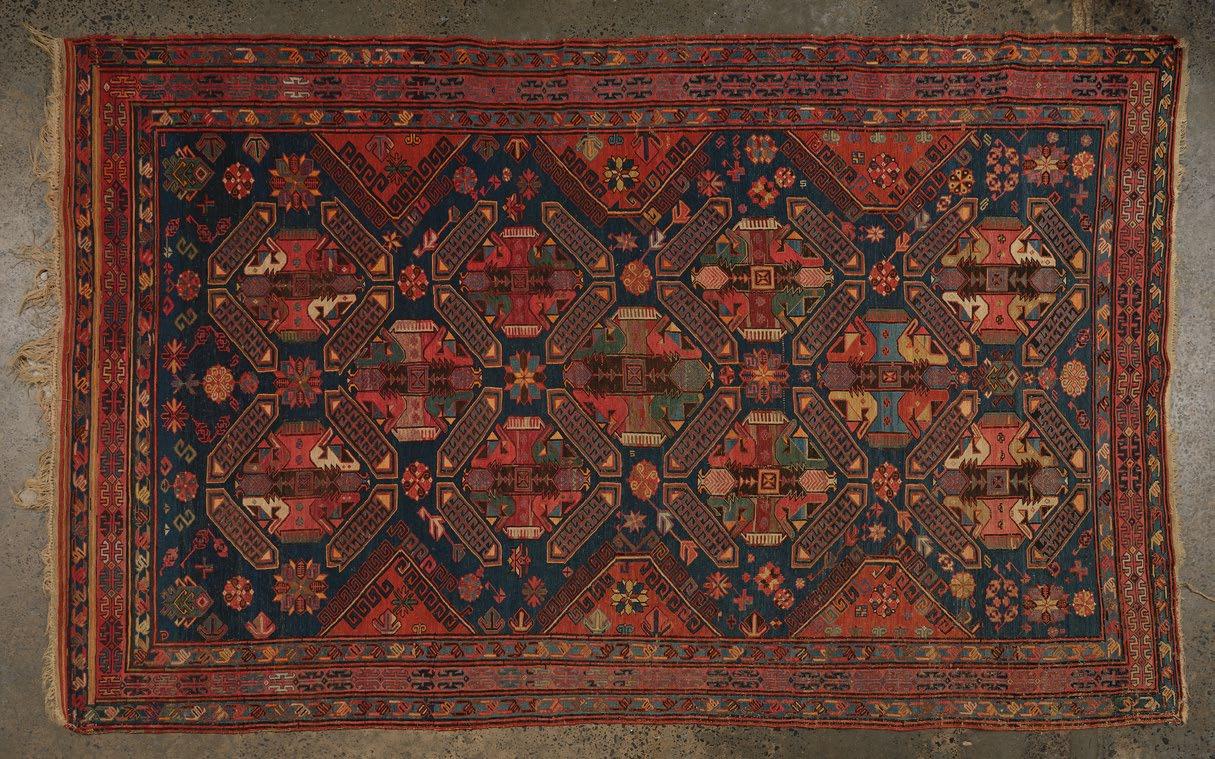
95
A Good Antique Caucasian Soumak Rug
Azerbaijan, circa 1890
Woven with six large geometric medallions and with scattered flowerheads and cruciform guls on a blue field with repeating hook pattern to the boarder.
250 x 161cm
PROVENANCE
Collection Ron Brownson, Auckland
NZ$1,500–2,500
96
A Qashquai Flatweave Rug
Early 20th century
Woven with a gul, lozenge and geometric design on a red field with horizontal bands to each end.
200 x 170cm
PROVENANCE
Collection Ron Brownson, Auckland
NZ$1,000–2,000
97
A Rare Soumak Hand Knotted Prayer Rug
Decorated with a repeating gul design on a cream and pale red field. The top section with unusual inscription and stylised handprint design – most likely the insignia of the rug maker
111 x 81cm
PROVENANCE
Collection Ron Brownson, Auckland
NZ$500–800
98
An Indonesian Ikat 20th century
Woven with an ancestral male figure flanked by two figures on a red field.
112 x 59cm
PROVENANCE
Collection Ron Brownson, Auckland
NZ$200–400
99
An Afghan Skull cap 20th century
Profusely embellished with lapis lazuli, turquoise and coins.
20cm diameter
PROVENANCE
Collection Ron Brownson, Auckland
NZ$400–800
100
The Ron Brownson Ethnographic Art Catalogue Collection
Seventy-six catalogues including Sotheby's, Christie's, Lempertz, Bonhams, Mossgreen and Finch and Co and others.
PROVENANCE
Collection Ron Brownson, Auckland
NZ$800–1,600
101
The Ron Brownson Ethnographic Library Collection
This extensive collection of 110 books was compiled by Ron Brownson over thirty years and covers all areas –African, Asian and Oceanic.
Included in the collection are rare volumes including:
The George Ortiz Collection Catalogue, Sotheby Parke Bernet. 29th June 1978
With annotated notes from Ron Brownson and signed inside the front cover.
Oceanic Art by Anthony JP Meyer.
Tibetan Painting by Pratapaditya Pal.
Tibetan Sacred Art: The heritage of Tantra by Detlef Ingo Lauf.
Royal Hawaiian Featherwork by Na Hulu Alii. Polynesia: The Mark and Carolyn Blackburn collection of Polynesian art by Adrienne Kappler.
The James Hooper Collection: Art and Artefacts of the Pacific.
Africa and the Americas by Steven Phelps, Hardcover with dust jacket
Oceanic Art by Anthony JP Meyer.
Two volumes in a slip case.
The Asmat of New Guinea: The Journal of Michael Clark Rockefeller: Edited by Adrian A Gerbrands, Hardcover.
New Guinea Art: Masterpieces from the Jolika collection of Marcia and John Friede: Two volumes in a slipcase.
Polynesian Art by Edward Dodd.
The Samoa Islands by Dr Theodore Verhaaren: Two Volumes.
The Fuller Collection of Pacific Artifacts by Ronald W. Force and Maryanne Force.
Ethnology of Vanuatu: An early 20th century study by Felix Speiser, The Arts of the South Pacific by Jean Guiart.
PROVENANCE
Collection Ron Brownson, Auckland
NZ$2,000–4,000
END OF SALE
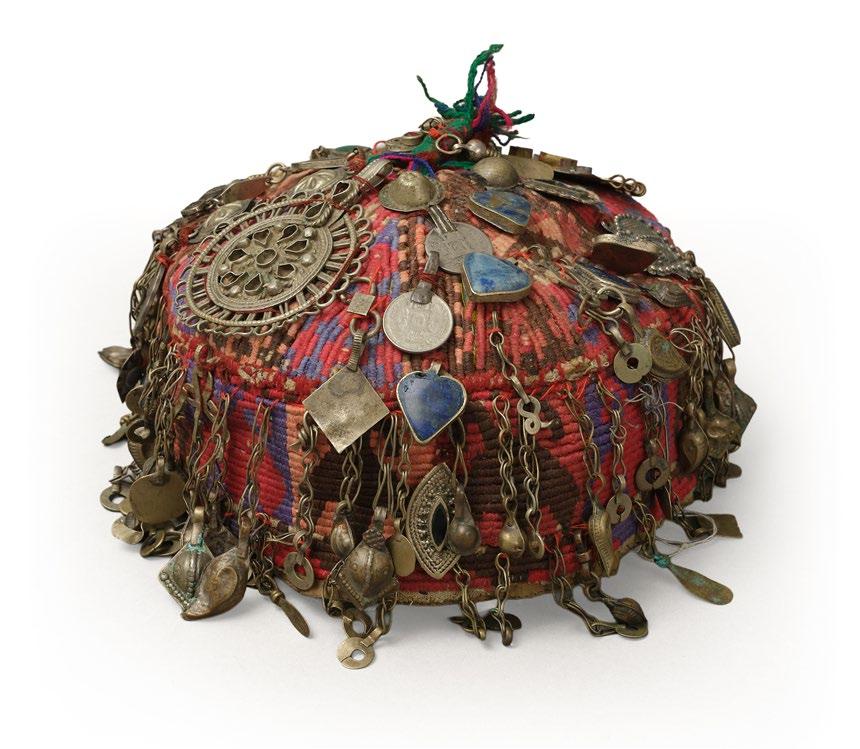
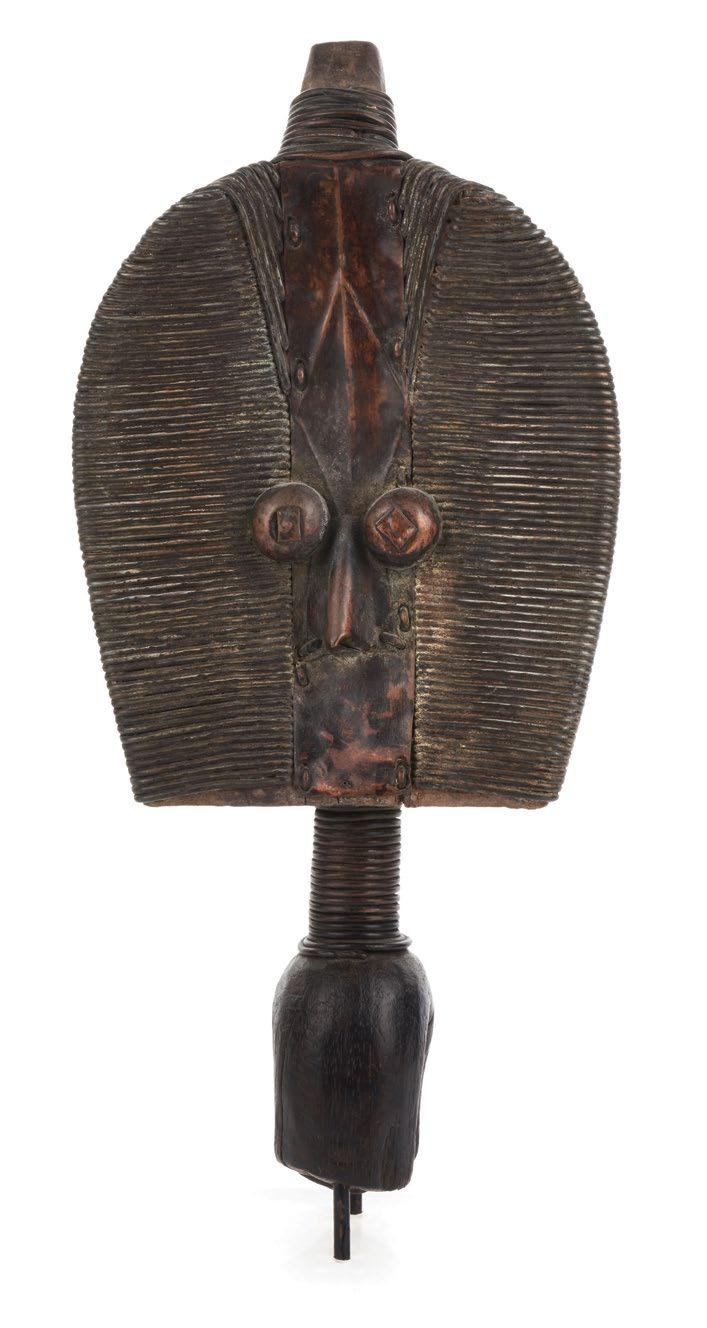
An African Kota reliquary figure, 37cm high
Estimate $500–1,000
Timed Online Auction
Online now and closing Tuesday 18 November from 4pm (AEST)
Viewing
Mon 17 & Tue 18 November 10am-4pm CLIK Collective, 15 Cochranes Road, Moorabbin VIC 3189
Enquiries
James Parkinson
james@forauction.com.au
A Rare Ikenga Figure, Igbo, Nigeria, 19th century 46cm height
Provenance: Collected by Bishop Herbert Tugwell in the late 19th century. Collection of John Graham, Tribal Arts Premier, Melbourne
Estimate: $7,000–10,000
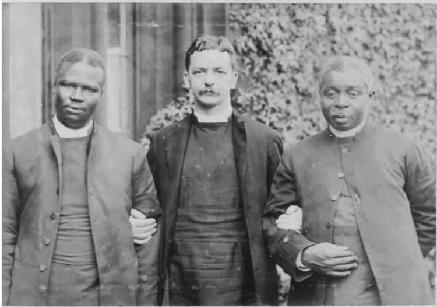
Auction • May 2026
Enquiries
James Parkinson james@artvisory.com.au
Melissa Parkinson melissa@artvisory.com.au


Assistant Bishop Oluwole, Bishop Herbert Tugwell, Assistant Bishop Phillips

Brett Whiteley (Australian, 1939-1992) The Dove etching in four colours, with paint and collage, edition number 23/30
110 x 78.5 cm
Estimate: $30,000–40,000
Be part of the first fine Australian art auction of the new year, when the market is back refreshed.
Enquiries
Paul Sumner 0412 337 827
paul@artvisory.com.au
Michael O’Meara 0418 505 519 michael@artvisory.com.au
Auction • March 2026

Auction • Monday 4 May 2026
The finest decorative arts from across the world in one beautiful, curated catalogue.
Enquiries
Paul Sumner 0412 337 827 paul@artvisory.com.au
Arts of the Middle East
Dr Susan Scollay 0418 175 694
Indian and South East Asian Arts
James Parkinson james@artvisory.com.au
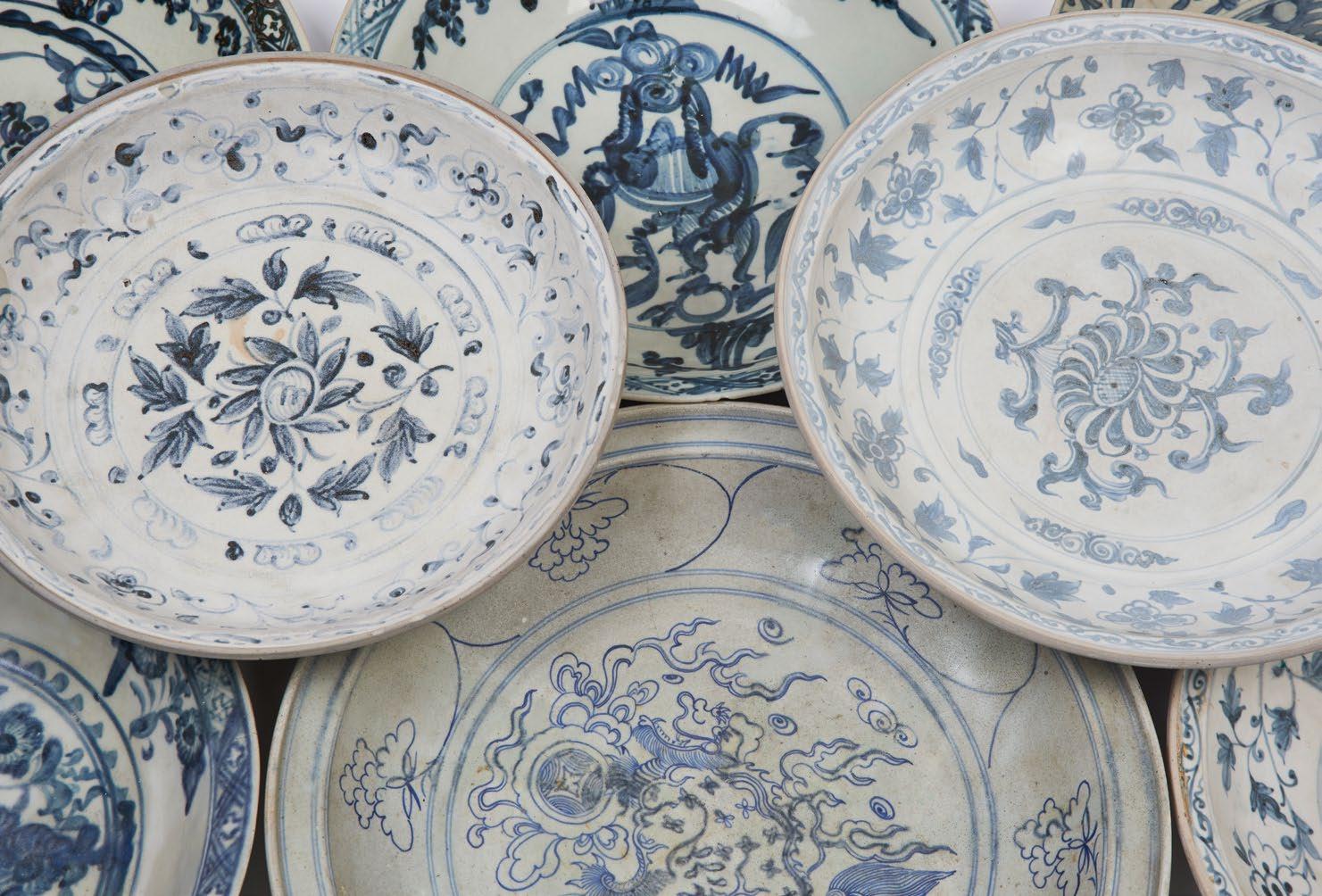
Rare and Important Ancestor Figure (Korwar)
Waigeo Island, Raja Amput Islands, Irian Jaya Carved wood, 19th century or earlier. 43cm height.
Provenance: Thomas Murray Asiatic and Ethnographic art
The Marc Pinto Collection of Oceanic, Indonesian and Australian Art
Auction • Tuesday 26 May 2026
Single-Owner Auction of Global Indigenous Arts
Enquiries
James Parkinson james@artvisory.com.au
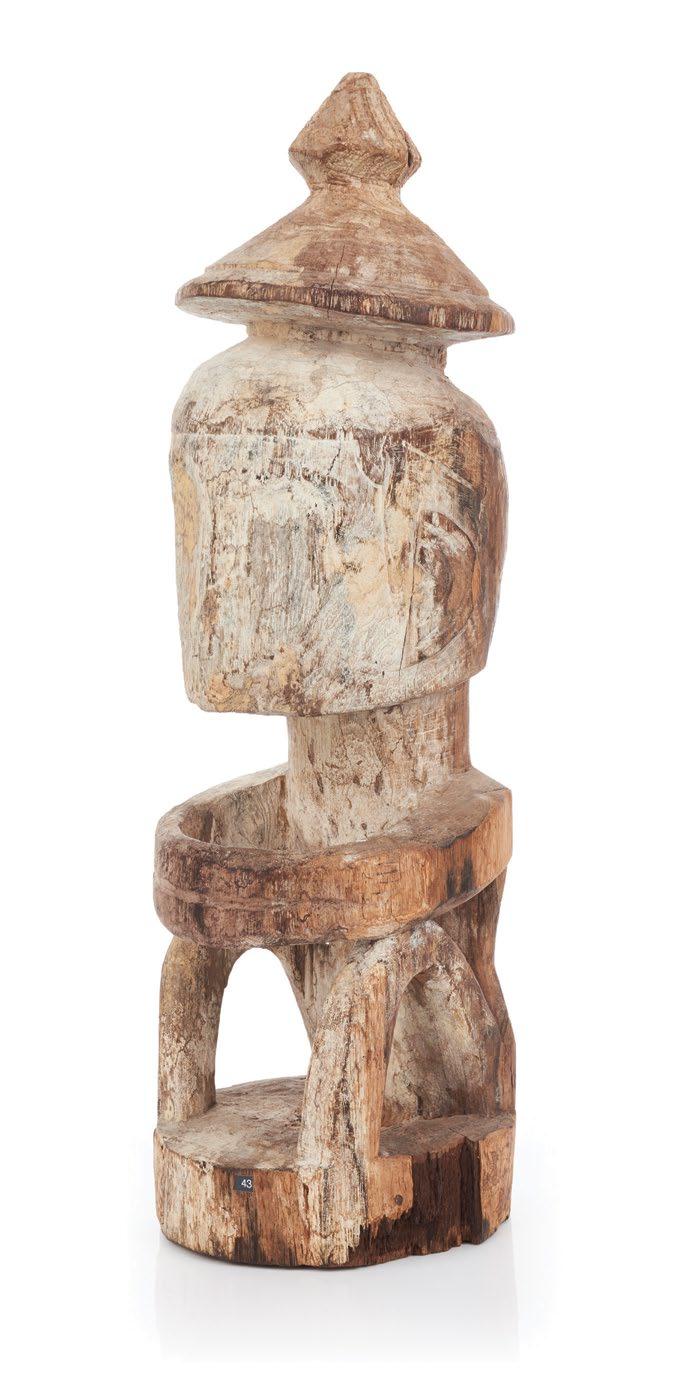
KK Partners Group, Chartered accountants are based in Brighton Victoria and have set up and independently managed the vendor trust accounts for Artvisory vendors, since the day the company was established.
Buyer payments are collected in this trust account and reconciled to auction results when an auction is complete. Payments owed to vendors are processed by KK Partners Group, after which any monies owed to Artvisory as per the Auction Agent Agreements are paid.
Together KK Partners Group and Artvisory ensure auction clients funds are collected, reconciled and processed responsibly and with accountability.
Copyright (Part 1)
1 © Mick Walankari Tjakamarra/Copyright Agency, 2025
2 © Jimmy Donegan/Copyright Agency, 2025
3 © Nyarapayi Giles/Copyright Agency, 2025
4 © Carolanne Ken/Copyright Agency, 2025
5 © Nora Wompi/Copyright Agency, 2025
11 © Barbara Mbitjana Moore/Copyright Agency, 2025
12 © Tjala Arts Collaborative/Copyright Agency, 2025
14 © Emily Kam Kngwarray/Copyright Agency, 2025
15 © Maringka Baker/Copyright Agency, 2025
25 © Badayal Lofty Nadjamerrek/Copyright Agency, 2025
26 © Freddie Timms/Copyright Agency, 2025
27 © Charlie Tararu Tjungurrayi/Copyright Agency, 2025
28 © Billy Thomas/Copyright Agency, 2025
34 © Tjumpo Tjapanangka/Copyright Agency, 2025
35 © Yaritji Young/Copyright Agency, 2025
36 © Rosalind Tjanyari/Copyright Agency, 2025
37 © Jimmy Donegan/Copyright Agency, 2025
38 © Betty Kuntiwa Pumani/Copyright Agency, 2025
50 © Marcus Camphoo/Aboriginal Artists Agency, 2025
51 © Betty Campbell/Copyright Agency, 2025
52 © Neville Niypula Mcarthur/Copyright Agency, 2025
53 © Imelda Yukenbarri Guguman/Copyright Agency, 2025
54 © Ngamaru Bidu/Copyright Agency, 2025
55 © Minnie Pwerle/Copyright Agency, 2025
114 © Leon Melpi/Copyright Agency, 2025
123 © Jimbo Dowornulimjura/Aboriginal Artists Agency, 2025
124 © Jack Docherty/Aboriginal Artists Agency, 2025
128 © Jack Kalakala/Copyright Agency, 2025
129 © Tom Djawa 1/Copyright Agency, 2025
130 © Lena Kurriniya/Copyright Agency, 2025
131 © Wally Mandarrk/Copyright Agency, 2025
135 © Peter Banjurljurl/Aboriginal Artists Agency, 2025
136 © Jack Wunuwun/Copyright Agency, 2025
137 © Jimmy Njiminjuma/Copyright Agency, 2025
140 © Ivan Namirrkki/Copyright Agency, 2025
143 © Sadler Milidjidji/Aboriginal Artists Agency, 2025
144 © Baliny Wanambi/Art Yirrkala 2025
145 © Mervyn Roughsey/Copyright Agency, 2025
Part 1 Absentee Bid Form
In order to register to bid with Artvisory, please complete this form, scan and email to accounts@artvisory.com.au
Auction Title:
Name (please print clearly):
Email Address (for invoicing & correspondence):
Telephone (mobile): Telephone (home/work):
310 Toorak Road South Yarra VIC 3141 +61 3 9826 4039 www.artvisory.com.au
Invoice address (PO Box not accepted): City State Post Code Country
Please tick here if you do not want to receive special invitations and online auction catalogues by email.
We value your privacy and will not disclose your details to any third party. You may request that your details are removed from our database at any time. If you have not previously purchased with Artvisory, please scan your photo ID (either a drivers licence or passport) and email to accounts@artvisory.com.au
Lot Number (in order)
Catalogue Description (please print clearly) Cover Bid Not including buyer’s premium or GST (where applicable)
I authorise Artvisory to register bids on a per lot basis up to the maximum price I have indicated for each lot. I will not hold Artvisory responsible for any errors that occur. I understand that if my bid is successful, the purchase price will be the sum of my final bid plus the buyer’s premium of 26% plus GST of the final hammer price plus any GST payable on the hammer price, as indicated in the catalogue. GST will be charged on the buyer’s premium. If the lot is denoted by the † symbol, GST will be charged the whole amount (hammer price + GST). If the Resale Royalty Scheme is applicable 5% will be charged on the hammer price only. The Resale Royalty Scheme is denoted by the § symbol in the catalogue. Your invoice will be emailed to the supplied email address immediately after the auction has finished and will contain all details pertaining to payment and collection.
I have read and accepted Artvisory’s terms and conditions as printed in the catalogue and online at www.artvisory.com.au. Bids will not be processed unless this form is signed.
Signature Date
Bidder Number (Office Use Only)
Part 1 Telephone Bid Form
In order to register to bid with Artvisory, please complete this form, scan and email to accounts@artvisory.com.au
Auction Title:
Name (please print clearly):
Email Address (for invoicing & correspondence):
Telephone (mobile): Telephone (home/work):
Invoice address (PO Box not accepted):
310 Toorak Road South Yarra VIC 3141 +61 3 9826 4039 www.artvisory.com.au
City State Post Code Country
Please tick here if you do not want to receive special invitations and online auction catalogues by email. We value your privacy and will not disclose your details to any third party. You may request that your details are removed from our database at any time.
If you have not previously purchased with Artvisory, please scan your photo ID (either a drivers licence or passport) and email to accounts@artvisory.com.au
Lot Number (in order)
Catalogue Description (please print clearly)
Bid Not including buyer’s premium or GST (where applicable)
Telephone bids must be received by Artvisory no later than 24 hours prior to the commencement of the Auction. Once received, your bid will be confirmed by email.
I authorise Artvisory to register bids on a per lot basis up to the maximum price I have indicated for each lot. I will not hold Artvisory responsible for any errors that occur. I understand that if my bid is successful, the purchase price will be the sum of my final bid plus the buyer’s premium of 26% plus GST of the final hammer price plus any GST payable on the hammer price, as indicated in the catalogue. GST will be charged on the buyer’s premium. If the lot is denoted by the † symbol, GST will be charged the whole amount (hammer price + GST). If the Resale Royalty Scheme is applicable 5% will be charged on the hammer price only. The Resale Royalty Scheme is denoted by the § symbol in the catalogue. Your invoice will be emailed to the supplied email address immediately after the auction has finished and will contain all details pertaining to payment and collection.
I have read and accepted Artvisory’s terms and conditions as printed in the catalogue and online at www.artvisory.com.au. Bids will not be processed unless this form is signed.
Signature Date
Bidder Number (Office Use Only)
Part 2 Absentee Bid Form
In order to register to bid with Artvisory, please complete this form, scan and email to accounts@artvisory.com.au
Auction Title:
Name (please print clearly):
Email Address (for invoicing & correspondence):
Telephone (mobile): Telephone (home/work):
Invoice address (PO Box not accepted):
Please tick here if you do not want to receive special invitations and online auction catalogues by email.
310 Toorak Road South Yarra VIC 3141 +61 3 9826 4039 www.artvisory.com.au
We value your privacy and will not disclose your details to any third party. You may request that your details are removed from our database at any time.
If you have not previously purchased with Artvisory, please scan your photo ID (either a drivers licence or passport) and email to accounts@artvisory.com.au
Lot Number (in order)
Catalogue Description (please print clearly)
Cover Bid Not including buyer’s premium or GST (where applicable)
I authorise Artvisory to register bids on a per lot basis up to the maximum price I have indicated for each lot. I will not hold Artvisory responsible for any errors that occur. I understand that if I am the successful bidder, the purchase price will be the sum of my final bid (the hammer price) plus the Buyers Premium of 21%, plus 15% GST. I understand and accept that some lots may have additional amounts applicable and that these lots will be denoted with symbols in the catalogue. By signing this registration form I agree that I have read and accept Artvisory’s terms and conditions of sale, as per the printed catalogue and online at www.artvisory.com.au. Artvisory reserves the right not to process any bids until this form is signed. Your invoice will be emailed to the supplied email address immediately after the auction has finished and will contain all details pertaining to payment and collection.
I have read and accepted Artvisory’s terms and conditions as printed in the catalogue and online at www.artvisory.com.au. Bids will not be processed unless this form is signed.
Signature Date
Bidder Number (Office Use Only)
Part 2 Telephone Bid Form
In order to register to bid with Artvisory, please complete this form, scan and email to accounts@artvisory.com.au
Auction Title:
Name (please print clearly):
Email Address (for invoicing & correspondence):
Telephone (mobile):
Invoice address (PO Box not accepted):
310 Toorak Road South Yarra VIC 3141 +61 3 9826 4039 www.artvisory.com.au
Telephone (home/work):
City State Post Code Country
Please tick here if you do not want to receive special invitations and online auction catalogues by email.
We value your privacy and will not disclose your details to any third party. You may request that your details are removed from our database at any time.
If you have not previously purchased with Artvisory, please scan your photo ID (either a drivers licence or passport) and email to accounts@artvisory.com.au
Lot Number (in order)
Catalogue Description (please print clearly)
Cover Bid Not including buyer’s premium or GST (where applicable)
Telephone bids must be received by Artvisory no later than 24 hours prior to the commencement of the Auction. Once received, your bid will be confirmed by email.
I authorise Artvisory to register bids on a per lot basis up to the maximum price I have indicated for each lot. I will not hold Artvisory responsible for any errors that occur. I understand that if I am the successful bidder, the purchase price will be the sum of my final bid (the hammer price) plus the Buyers Premium of 21%, plus 15% GST. I understand and accept that some lots may have additional amounts applicable and that these lots will be denoted with symbols in the catalogue. By signing this registration form I agree that I have read and accept Artvisory’s terms and conditions of sale, as per the printed catalogue and online at www.artvisory.com.au. Artvisory reserves the right not to process any bids until this form is signed. Your invoice will be emailed to the supplied email address immediately after the auction has finished and will contain all details pertaining to payment and collection.
I have read and accepted Artvisory’s terms and conditions as printed in the catalogue and online at www.artvisory.com.au. Bids will not be processed unless this form is signed.
Signature Date
Bidder Number (Office Use Only)
Part 1 Terms and Conditions of Sale
The terms and conditions of sale listed here contain the policies of Artvisory Pty Ltd. They are the terms on which Artvisory Pty Ltd and the Seller contract with the Buyer. They may be amended by a printed Saleroom Notice or oral announcements made before and during the sale. By bidding at auction you agree to be bound by these terms and conditions.
1. Background to the Terms used in these Conditions
The conditions that are listed below contain terms that are used regularly and may need explanation. They are as follows:
“the Buyer” means the person with the highest bid accepted by the Auctioneer
“the Lot” means any item depicted within the sale for auction and in particular the item or items described against any lot number in the catalogue.
“the Hammer price” means the amount of the highest bid accepted by the auctioneer in relation to a lot
“the Buyers Premium” means the charge payable by the Buyer to the auction house as a percentage of the hammer price.
“the Reserve” means the lowest amount at which Artvisory has agreed with the Seller that the lot can be sold.
“Forgery” means an item constituting an imitation originally conceived and executed as a whole, with a fraudulent intention to deceive as to authorship, origin, age, period, culture or source, where the correct description as to such matters is not reflected by the description in the catalogue. Accordingly no lot shall be capable of being a forgery by reason of any damage or restoration work of any kind (Including re-painting).
“the insured value” means the amount that Artvisory in its absolute discretion from time to time shall consider the value for which a lot should be covered for insurance (whether or not insurance is arranged by Artvisory.)
All values expressed in Artvisory Pty Ltd catalogues (in any format) are in Australian Dollars (AU$) unless otherwise specified. All bids, “hammer price”, “reserves”, “Buyers Premium” and other expressions of value are understood by all parties to be in Australian Dollars (AU$) unless otherwise specified.
2. Artvisory Auctions as Agent
Except as otherwise stated Artvisory Pty Ltd acts as agent for the Seller.
The contract for the sale of the property is therefore made between the Seller and the Buyer.
3. Before the Sale
a) Examination of Property
Prospective Buyers are strongly advised to examine in person any property in which they are interested before the Auction takes place. Neither Artvisory nor the Seller provides any guarantee in relation to the nature of the property apart from the Limited warranty in the paragraph below.
The property is otherwise sold “AS IS” and a condition report can be requested at any time prior to the sale.
b) Catalogue and other Descriptions
All statements by Artvisory in the catalogue entry for the property or in the condition report, or made orally or in writing elsewhere, are statements of opinion and are not to be relied upon as statements of fact. Such statements do not constitute a representation, warranty or assumption of liability by Artvisory of any kind. References in the catalogue entry to the condition report to damage or restoration are for guidance only and should be evaluated by personal inspection by the bidder or a knowledgeable representative. The absence of such a reference does not imply that an item is free from defects or restoration, nor does a reference to particular defects imply the absence of any others. Estimates of the selling price should not be relied on as a statement that this is the price at which the item will sell or it’s value for any other purpose. Neither Artvisory nor The Seller is responsible for any errors or omissions in the catalogue or any supplemental material.
Images are measured height by width (sight size). Illustrations are provided only as a guide and should not be relied upon as a true representation of colour or condition. Images are not shown at a standard scale. Mention is rarely made of frames (which may be provided as supplementary images on the website) which do not form part of the lot as described in the printed catalogue.
Foreign buyers should note that all transactions are in Australian dollars so there may be a small
exchange rate risk. The costs associated with acquiring a good certificate will be carried by the purchaser. If the item turns out to be forged or otherwise incorrectly described, all reasonable costs will be borne by the vendor.
c) Buyers Responsibility
All property is sold “as is” without representation or warranty of any kind by Artvisory or the Seller. Buyers are responsible for satisfying themselves concerning the condition of the property and the matters referred to in the catalogue by requesting a condition report
No lot to be rejected if, subsequent to the sale, it has been immersed in liquid or treated by any other process unless the Auctioneer’s permission to subject the lot to such immersion or treatment has first been obtained in writing.
4. At the Sale
a) Refusal of Admission
Artvisory reserves the right at our complete discretion to refuse admission to the auction premises or participation in any auction and to reject any bid.
b) Registration before Bidding
Any prospective new buyer must complete and sign a registration form and provide photoidentification before bidding. Artvisory may request bank, trade or other financial references to substantiate this registration.
c) Bidding as a Principal
When making a bid, a bidder is accepting personal liability to pay the purchase price including the buyers premium and all applicable taxes, plus all other applicable charges, unless it has been explicitly agreed in writing with Artvisory before the commencement of the sale that the bidder is acting as agent on behalf of an identified third party acceptable to Artvisory and that Artvisory will only look to the principal for payment.
d) International Registrations
All International clients not known to Artvisory will be required to scan through an accredited form of photo identification and pay a deposit at our discretion in cleared funds into Artvisory’s account at least 24 hours before the commencement of the auction. Bids will not be accepted without this deposit. Artvisory also reserves the right to request any additional forms of identification prior to registering an overseas bid.
This deposit can be made using a credit card via a secure BPOINT link, however the balance of any purchase price in excess of $5,000 can not be charged to this card without prior arrangement.
This deposit is redeemable against any auction purchase.
e) Absentee bids
Artvisory will use reasonable efforts to execute written bids delivered to us AT LEAST 24 Hours before the sale for the convenience of those clients who are unable to attend the auction in person. If we receive identical written bids on a particular lot, and at the auction these are the highest bids on that lot, then the lot will be sold to the person whose written bid was received and accepted first. Execution of written bids is a free service undertaken subject to other commitments at the time of the sale and we do not accept liability for failing to execute a written bid or for errors or omissions which may arise. It is the bidder’s responsibility to check with Artvisory after the auction if they were successful. Unlimited or “Buy” bids will not be accepted.
f) Telephone bids
Priority will be given to overseas and interstate bidders. Please refer to the catalogue for the Telephone Bids form. Arrangements for this service must be confirmed AT LEAST 24 HOURS PRIOR to the auction commencing. Artvisory accepts no responsibility whatsoever for any errors or failure to execute bids. In telephone bidding the buyer agrees to be bound by all terms and conditions listed here and accepts that Artvisory cannot be held responsible for any miscommunications in the process. The success of telephone bidding cannot be guaranteed due to circumstances that are unforeseen. Buyers should be aware of the risk and accept the consequences should contact be unsuccessful at the time of Auction. Artvisory will advise Telephone Bidders who have registered at least 24 hours before the auction of any relevant changes to descriptions, withdrawals or any other sale room notices.
G) Online and Timed Online Bidding
Artvisory offers an online bidding service via Invaluable.com. When bidding online the buyer agrees to be bound by all terms and conditions listed here by Artvisory and agrees to pay any fees charged in regard to any purchases made via Invaluable.com.
Artvisory accepts no responsibility for any errors, failure to execute bids or any other miscommunications regarding this process. It is the online bidder’s responsibility to ensure the accuracy of the relevant information regarding bids, lot numbers and contact details and to make sure the Internet Browser used for bidding is either Chrome or Firefox not Safari as this browser does not support the Invaluable.com platform. We recommend registering or logging at least 24 hours in advance prior to bidding in the sale to make sure there are no issues with customer log in.
H) Reserves
Unless otherwise indicated, all lots are offered subject to a reserve, which is the confidential minimum price below which the Lot will not be sold. The reserve will not exceed the low estimate printed in the catalogue. The auctioneer may open the bidding on any Lot below the reserve by placing a bid on behalf of the Seller. The auctioneer may continue to bid on behalf of seller up to the amount of the reserve, either by placing consecutive bids or by placing bids in response to other bidders.
I) Auctioneers Discretion
The Auctioneer has the right at his absolute and sole discretion to refuse any bid, to advance the bidding in such a manner as he may decide, to withdraw or divide any lot, to combine any two or more lots and, in the case or error or dispute and whether during or after the sale, to determine the successful bidder, to continue the bidding, to cancel the sale or to re-offer and resell the item in dispute. If any dispute arises after the sale, then Artvisory’s sale record is conclusive.
J) Successful bid and passing of risk
Subject to the auctioneer’s discretion, the highest bidder accepted by the auctioneer will be the buyer and the striking of his hammer marks the acceptance of the highest bid and the conclusion of a contract for sale between the Seller and the Buyer. Risk and responsibility for the lot (including frames or glass where relevant) passes immediately to the Buyer.
K) Indicative Bidding steps, etc.
Artvisory reserves the right to refuse any bid, withdraw any lot from sale, to place a reserve on any lot and to advance the bidding according to the following, at the auctioneers discretion:
Increment Amount Dollar Range
$20
$0–$500
$50 $500–$1,000
$100 $1,000–$2,000
$200 $2,000–$5,000
$500 $5,000–$10,000
$1,000 $10,000–$20,000
$2,000 $20,000–$50,000
$5,000 $50,000–$100,000
$10,000 $100,000–$200,000
$20,000 $200,000–$500,000
$50,000 $500,000–$1,000,000
Absentee bids must follow these increments and any bids that don’t follow the steps will be rounded up to the nearest acceptable bid.
5. After the Sale
a) Buyers Premium
In addition to the hammer price, the buyer agrees to pay to Artvisory the buyer's premium. The buyer’s premium is 26% of the hammer price plus 10% GST. (Goods and Services Tax) where applicable.
b) Payment and passing of title
The buyer must pay to the company trust account managed by KK Partners Pty Ltd Chartered Accountants the full amount due (comprising the hammer price, buyer's premium and any applicable taxes and GST) not later than 3 days after the auction date.
The buyer will not acquire title for the lot until Artvisory receives full payment in cleared funds, and no goods under any circumstances will be released without confirmation of cleared funds received. This applies even if the buyer wishes to send items interstate or overseas.
Payment can be made by direct transfer or Eftpos/ credit card in person with a 1.43% (inc GST) merchant fee charged for Visa, Mastercard and American Express.
Credit card payments where the card-holder is not present can be made by requesting a secure BPOINT link to be emailed by Artvisory Accounts. Cash in person is not accepted, however this may be deposited directly into the company trust account and bank receipt supplied) Personal, Company and Bank cheques are not accepted.
The buyer is responsible for any bank fees and charges applicable for the transfer of funds into Artvisory’s company trust account.
c) Collection of Purchases & Insurance
Artvisory is entitled to retain items sold until all amounts due to us have been received in full in good cleared funds. Subject to this, the Buyer shall collect purchased lots within 3 days from the date of the sale unless otherwise agreed in writing between Artvisory and the Buyer. At the fall of the hammer, insurance is the responsibility of the purchaser.
d) Packing, Handling and shipping
Artvisory will be able to suggest local, national and international carriers and takes no responsibility whatsoever for the actions of any recommended third party carrier. Artvisory can pack and handle goods purchased at the auction by agreement, however will take no responsibility for damage, and a charge may be made for this service. All packing, shipping, insurance, postage & associated charges will be borne by the purchaser.
e) Cultural heritage Export Licences
Unless otherwise agreed by us in writing, the fact that the buyer wishes to apply for an export licence does not affect his or her obligation to make full payment immediately, nor our right to charge interest or storage charges on late payment. It is the Buyer’s responsibility to check Australia’s Protection of Moveable Cultural Heritage Act 1986 before purchase. If the Buyer requests Artvisory to apply for an export licence then we shall be entitled to charge a fee for this service. We shall not be obliged to rescind a sale nor to refund any interest or other expenses incurred by the Buyer where payment is made by the Buyer in circumstances where an export licence is not granted.
f) Remedies for non-payment
If the Buyer fails to make full payment immediately, Artvisory is entitled to exercise one or more of the following rights or remedies (in addition to asserting any other rights or remedies available under the law)
i) to charge interest at such a rate as we shall reasonably decide
ii) to hold the defaulting Buyer liable for the total amount due and to commence legal proceedings for it’s recovery along with interest, legal fees and costs to the fullest extent permitted under applicable law
iii) to cancel the sale
iv) to resell the property publicly or privately on such terms as we see fit
v) to pay the Seller an amount up to the net proceeds payable in respect of the amount bid by the defaulting Buyer. In these circumstances the defaulting Buyer can have no claim upon Artvisory in the event that the item(s) are sold for an amount greater than the original invoiced amount.
vi) to set off against any amounts which Artvisory may owe the Buyer in any other transactions, the outstanding amount remaining unpaid by the Buyer.
vii) where several amounts are owed by the Buyer to us, in respect of different transactions, to apply any amount paid to discharge any amount owed in respect of any particular transaction, whether or not the Buyer so directs.
viii) to reject at any future auction any bids made by or on behalf of the Buyer or to obtain a deposit from the Buyer prior to accepting any bids.
ix) to exercise all the rights and remedies of a person holding security over any property in our possession owned by the Buyer whether by way of pledge, security interest or in any other way, to the fullest extent permitted by the law of the place where such property is located. The Buyer will be deemed to have been granted such security to us and we may retain such property as collateral security for such Buyer’s obligations to us.
x) to take such other action as Artvisory deem necessary or appropriate
If we do sell the property under paragraph (iv), then the defaulting Buyer shall be liable for payment of any deficiency between the total amount originally due to us and the price obtained upon reselling as well as for all costs, expenses, damages, legal fees and commissions and premiums of whatever kinds associated with both sales or otherwise arising from the default.
If we pay any amount to the Seller under paragraph (v) the Buyer acknowledges that Artvisory shall have all of the rights of the Seller, however arising, to pursue the Buyer for such amount.
g) Failure to collect purchases
Where purchases are not collected within 3 days from the sale date, whether or not payment has been made, we shall be permitted to remove the property to a warehouse at the buyer’s expense, and only release the items after payment in full has been made of removal, storage handling, insurance and any other costs incurred, together with payment of all other amounts due to us.
6. Extent of Artvisory Liability
Artvisory agrees to refund the purchase price in the circumstances of the Limited Warranty set out in paragraph 7 below. Apart from that, neither the Seller nor we, nor any of our employees or agents are responsible for the correctness of any statement of whatever kind concerning any lot, whether written or oral, nor for any other errors or omissions in description or for any faults or defects in any lots. Except as stated in paragraph 7 below, neither the Seller ourselves, our officers, agents or employees give any representation warranty or guarantee or assume any liability of any kind in respect of any lot with regard to merchantability, fitness for a particular purpose, description, size, quality, condition, attribution, authenticity, rarity, importance, medium, provenance, exhibition history, literature or historical relevance. Except as required by local law any warranty of any kind is excluded by this paragraph.
7. Limited Warranty
Subject to the terms and conditions of this paragraph, the Seller warrants for the period of thirty days from the date of the sale that any property described in this catalogue (noting such description may be amended by any saleroom notice or announcement) which is stated without qualification to be the work of a named author or authorship is authentic and not a forgery. The term “Author” or “authorship” refers to the creator of the property or to the period, culture, source, or origin as the case may be, with which the creation of such property is identified in the catalogue.
The warranty is subject to the following: i) it does not apply where a) the catalogue description or saleroom notice corresponded to the generally accepted opinion of scholars and experts at the date of the sale or fairly indicated that there was a conflict of opinions, or b) correct identification of a lot can be demonstrated only by means of a scientific process not generally accepted for use until after publication of the catalogue or a process which at the date of the
publication of the catalogue was unreasonably expensive or impractical or likely to have caused damage to the property.
ii) the benefits of the warranty are not assignable and shall apply only to the original buyer of the lot as shown on the invoice originally issued by Artvisory when the lot was sold at Auction.
iii) the Original Buyer must have remained the owner of the lot without disposing of any interest in it to any third party
iv) The Buyer’s sole and exclusive remedy against the Seller in place of any other remedy which might be available, is the cancellation of the sale and the refund of the original purchase price paid for the lot less the buyers premium which is non refundable. Neither the Seller nor Artvisory will be liable for any special, incidental nor consequential damages including, without limitation, loss of profits not for interest.
v) The Buyer must give written notice of claim to us within thirty days of the date of the Auction. The Seller shall have the right, to require the Buyer to obtain two written opinions by recognised experts in the field, mutually acceptable to the Buyer and Artvisory to decide whether or not to cancel the sale under warranty.
vi) the Buyer must return the lot to Seller in the same condition that it was purchased.
8. Severability
If any part of these Conditions of Sale is found by any court to be invalid, illegal or unenforceable, that part shall be discounted and the rest of the Conditions shall continue to be valid to the fullest extent permitted by law.
9. Copyright
The copyright of all images, illustrations and written material produced by Artvisory relating to a lot including the contents of this catalogue, is and shall remain the property at all times of Artvisory and shall not be used by the Buyer, nor by anyone else without our prior written consent. Artvisory and the Seller make no representation or warranty that the Buyer of a property will acquire any copyright or other reproduction rights in it.
10. Law and Jurisdiction
These terms and conditions and any matters concerned with the foregoing fall within the exclusive jurisdiction of the courts of the state in which the auction is held.
11. Pre-Sale Estimates
Artvisory publishes with each catalogue our opinion as to the estimated price range for each lot. These estimates are approximate prices only and are not intended to be definitive. They are prepared well in advance of the sale and may be subject to revision. Interested parties should contact Artvisory prior to auction for updated pre-sale estimates and starting prices.
12. Sale results
Artvisory will provide auction results as published on the website www.artvisory.com.au via Invaluable.com after the sale.
13. Goods and Service Tax
In accordance with A New Tax System (Goods and Services Tax) Act 1999 Artvisory Auctions will collect on behalf of the Australian tax office (ATO) a Goods and Service Tax (GST) of 10% on all applicable transactions.
GST is applicable on the hammer price in the case where the seller is selling property that is owned by an entity registered for GST. GST is also applicable on the hammer price in the case where the seller is not an Australian resident. These lots are denoted by a dagger symbol † placed next to the estimate.
GST is also applicable on the buyer’s premium. Overseas buyers and buyers non-resident in Australia will not be charged GST on both hammer price and premiums under the following conditions:
1. The items are exported through a Artvisory approved freight company including Australia Post
2. The items are exported within 60 days of the date of the sale
The invoice supplied by Artvisory for purchases will be regarded as a Tax invoice for GST purposes.
14. Resale Royalty Scheme
Under the legal obligations of the Resale Royalty Scheme for Visual Artists Act 2009, sellers must provide the following information to comply with the act:
• was the artwork acquired after 8 June 2010?
• is the sale/reserve price (including GST) $1,000 or more?
• is the artist from Australia or a country listed in the Regulations to the Act?
• is the artist alive, or deceased less than 70 years? The seller:
i) acknowledges that he or she understands his or her legal obligations under the Resale Royalty for Visual Artists Act 2009 (the Act);
ii) undertakes to comply with all requirements of the Act, including by providing its agent, the company, with accurate information sufficient for compliance with sections 28 and 29 of the Act;
iii) undertakes to indemnify the company for any loss incurred by the company as a result of the vendor’s failure to comply with any of the vendor’s legal obligations under the Act; and iv) acknowledges that if he or she fails to comply with any of his or her legal obligations under the Act, the company may provide the vendor’s name and contact details to Copyright Agency Limited (CAL).
Lots subject to payment of the Resale Royalty Scheme will be denoted by the §. The Australian Resale Royalty is a flat rate of 5% on the hammer price (including GST). The Australian Resale Royalty is payable by the buyer in addition to the buyers premium plus any applicable GST.
Part 2 Terms and Conditions of Sale
The terms and conditions of sale listed here contain the policies of Artvisory Pty Ltd. They are the terms on which Artvisory Pty Ltd and the Seller contract with the Buyer. They may be amended by a printed Saleroom Notice or oral announcements made before and during the sale. By bidding at auction you agree to be bound by these terms and conditions.
1. Background to the Terms used in these Conditions
The conditions that are listed below contain terms that are used regularly and may need explanation. They are as follows:
“the Buyer” means the person with the highest bid accepted by the Auctioneer
“the Lot” means any item depicted within the sale for auction and in particular the item or items described against any lot number in the catalogue.
“the Hammer price” means the amount of the highest bid accepted by the auctioneer in relation to a lot
“the Buyers Premium” means the charge payable by the Buyer to the auction house as a percentage of the hammer price.
“the Reserve” means the lowest amount at which Artvisory has agreed with the Seller that the lot can be sold.
“Forgery” means an item constituting an imitation originally conceived and executed as a whole, with a fraudulent intention to deceive as to authorship, origin, age, period, culture or source, where the correct description as to such matters is not reflected by the description in the catalogue. Accordingly no lot shall be capable of being a forgery by reason of any damage or restoration work of any kind (Including re-painting).
“the insured value” means the amount that Artvisory in its absolute discretion from time to time shall consider the value for which a lot should be covered for insurance (whether or not insurance is arranged by Artvisory.)
All values expressed in this sale (in any format) are in New Zealand Dollars (NZDAU$). All bids, “hammer price”, “reserves”, “Buyers Premium” and other expressions of value are understood by all parties to be in New Zealand Dollars (NZD$) unless otherwise specified.
2. Artvisory Auctions as Agent
Except as otherwise stated Artvisory Pty Ltd acts as agent for the Seller.
The contract for the sale of the property is therefore made between the Seller and the Buyer.
3. Before the Sale
a) Examination of Property
Prospective Buyers are strongly advised to examine in person any property in which they are interested before the Auction takes place. Neither Artvisory nor the Seller provides any guarantee in relation to the nature of the property apart from the Limited warranty in the paragraph below.
The property is otherwise sold “AS IS” and a condition report can be requested at any time prior to the sale.
b) Catalogue and other Descriptions
All statements by Artvisory in the catalogue entry for the property or in the condition report, or made orally or in writing elsewhere, are statements of opinion and are not to be relied upon as statements of fact. Such statements do not constitute a representation, warranty or assumption of liability by Artvisory of any kind. References in the catalogue entry to the condition report to damage or restoration are for guidance only and should be evaluated by personal inspection by the bidder or a knowledgeable representative. The absence of such a reference does not imply that an item is free from defects or restoration, nor does a reference to particular defects imply the absence of any others. Estimates of the selling price should not be relied on as a statement that this is the price at which the item will sell or it’s value for any other purpose. Neither Artvisory nor The Seller is responsible for any errors or omissions in the catalogue or any supplemental material.
Images are measured height by width (sight size).
Illustrations are provided only as a guide and should not be relied upon as a true representation of colour or condition. Images are not shown at a standard scale. Mention is rarely made of frames (which may be provided as supplementary images on the website) which do not form part of the lot as described in the printed catalogue.
Foreign buyers should note that all transactions are in Australian dollars so there may be a small exchange rate risk. The costs associated with acquiring a good certificate will be carried by the purchaser. If the item turns out to be forged or otherwise incorrectly described, all reasonable costs will be borne by the vendor.
c) Buyers Responsibility
All property is sold “as is” without representation or warranty of any kind by Artvisory or the Seller. Buyers are responsible for satisfying themselves concerning the condition of the property and the matters referred to in the catalogue by requesting a condition report
No lot to be rejected if, subsequent to the sale, it has been immersed in liquid or treated by any other process unless the Auctioneer’s permission to subject the lot to such immersion or treatment has first been obtained in writing.
4. At the Sale
a) Refusal of Admission
Artvisory reserves the right at our complete discretion to refuse admission to the auction premises or participation in any auction and to reject any bid.
b) Registration before Bidding
Any prospective new buyer must complete and sign a registration form and provide photo-identification before bidding. Artvisory may request bank, trade or other financial references to substantiate this registration.
c) Bidding as a Principal
When making a bid, a bidder is accepting personal liability to pay the purchase price including the buyers premium and all applicable taxes, plus all other applicable charges, unless it has been explicitly agreed in writing with Artvisory before the commencement of the sale that the bidder is acting as agent on behalf of an identified third party acceptable to Artvisory and that Artvisory will only look to the principal for payment.
d) International Registrations
All International clients not known to Artvisory will be required to scan through an accredited form of photo identification and pay a deposit at our discretion in cleared funds into the Artvisory Company Trust Account (NZ) account at least 24 hours before the commencement of the auction. Bids will not be accepted without this deposit. Artvisory also reserves the right to request any additional forms of identification prior to registering an overseas bid.
e) Absentee bids
Artvisory will use reasonable efforts to execute written bids delivered to us AT LEAST 24 Hours before the sale for the convenience of those clients who are unable to attend the auction in person. If we receive identical written bids on a particular lot, and at the auction these are the highest bids on that lot, then the lot will be sold to the person whose written bid was received and accepted first. Execution of written bids is a free service undertaken subject to other commitments at the time of the sale and we do not accept liability for failing to execute a written bid or for errors or omissions which may arise. It is the bidder’s responsibility to check with Artvisory after the auction if they were successful. Unlimited or “Buy” bids will not be accepted.
f) Telephone bids
Please refer to the catalogue or the website for the Telephone Bids form. Arrangements for this service must be confirmed AT LEAST 24 HOURS PRIOR to the auction commencing. Artvisory accepts no responsibility whatsoever for any errors or failure to execute bids. In telephone bidding the buyer agrees to be bound by all terms and conditions
listed here and accepts that Artvisory cannot be held responsible for any miscommunications in the process. The success of telephone bidding cannot be guaranteed due to circumstances that are unforeseen. Buyers should be aware of the risk and accept the consequences should contact be unsuccessful at the time of Auction. Artvisory will advise Telephone Bidders who have registered at least 24 hours before the auction of any relevant changes to descriptions, withdrawals or any other sale room notices.
K) Indicative Bidding steps, etc.
Artvisory reserves the right to refuse any bid, withdraw any lot from sale, to place a reserve on any lot and to advance the bidding according to the following, at the auctioneers discretion: Increment Amount Dollar Range
$20
$50
$100
G)
Online and Timed Online Bidding
Artvisory offers an online bidding service via Invaluable.com. When bidding online the buyer agrees to be bound by all terms and conditions listed here by Artvisory and agrees to pay any fees charged in regard to any purchases made via Invaluable.com. Artvisory accepts no responsibility for any errors, failure to execute bids or any other miscommunications regarding this process. It is the online bidder’s responsibility to ensure the accuracy of the relevant information regarding bids, lot numbers and contact details. Chrome or Firefox must be used as a web browser, as Safari does not support the Invaluable.com online platform. We recommend registering or logging at least 24 hours in advance prior to bidding in the sale to make sure there are no issues with customer log in.
H) Reserves
Unless otherwise indicated, all lots are offered subject to a reserve, which is the confidential minimum price below which the Lot will not be sold. The reserve will not exceed the low estimate printed in the catalogue. The auctioneer may open the bidding on any Lot below the reserve by placing a bid on behalf of the Seller. The auctioneer may continue to bid on behalf of seller up to the amount of the reserve, either by placing consecutive bids or by placing bids in response to other bidders.
I) Auctioneers Discretion
The Auctioneer has the right at his absolute and sole discretion to refuse any bid, to advance the bidding in such a manner as he may decide, to withdraw or divide any lot, to combine any two or more lots and, in the case or error or dispute and whether during or after the sale, to determine the successful bidder, to continue the bidding, to cancel the sale or to re-offer and resell the item in dispute. If any dispute arises after the sale, then Artvisory’s sale record is conclusive.
J)
Successful bid and passing of risk
Subject to the auctioneer’s discretion, the highest bidder accepted by the auctioneer will be the buyer and the striking of his hammer marks the acceptance of the highest bid and the conclusion of a contract for sale between the Seller and the Buyer. Risk and responsibility for the lot (including frames or glass where relevant) passes immediately to the Buyer.
$200
$500
$1,000
$0–$500
$500–$1,000
$1,000–$2,000
$2,000–$5,000
$5,000–$10,000
$10,000–$20,000
$2,000 $20,000–$50,000
$5,000
$50,000–$100,000
$10,000 $100,000–$200,000
$20,000 $200,000–$500,000
$50,000 $500,000–$1,000,000
Absentee bids must follow these increments and any bids that don’t follow the steps will be rounded up to the nearest acceptable bid.
5. After the Sale
a) Buyers Premium
In addition to the hammer price, the buyer agrees to pay to Artvisory the buyer's premium. The buyer’s premium for this sale is 21% of the hammer price plus 15% GST. (Goods and Services Tax) where applicable.
b) Payment and passing of title
The buyer must pay to the company trust account managed by KK Partners Pty Ltd Chartered Accountants the full amount due (comprising the hammer price, buyer's premium and any applicable taxes and GST) not later than 3 days after the auction date.
The buyer will not acquire title for the lot until Artvisory receives full payment in cleared funds, and no goods under any circumstances will be released without confirmation of cleared funds received. This applies even if the buyer wishes to send items interstate or overseas.
Payment can be made in NZD by direct transfer to the Company Trust bank account provided on the invoice. (KK Partners Group).
The buyer is responsible for any bank fees and charges applicable for the transfer of funds into Artvisory’s NZ company trust account.
c) Collection of Purchases & Insurance
Artvisory is entitled to retain items sold until all amounts due to us have been received in full in cleared funds. Subject to this, the Buyer shall collect purchased lots within 3 days from the date of the
sale unless otherwise agreed in writing between Artvisory and the Buyer.
At the fall of the hammer, insurance is the responsibility of the purchaser.
d) Packing, Handling and shipping
Artvisory will be able to suggest local, national and international carriers and takes no responsibility whatsoever for the actions of any recommended third party carrier. Artvisory can pack and handle goods purchased at the auction by agreement, however will take no responsibility for damage, and a charge may be made for this service. All packing, shipping, insurance, postage & associated charges will be borne by the purchaser.
e) Cultural Heritage/Protected Object Art 1975
Please note that many of the pieces this auction have been registered under the Protected Objects Act (1975)
This is referred to a Y registration. Under the terms of the act, items that are y registered may not be sold to non-New Zealand residents and may not leave the country without the consent of the Ministry of Culture and Heritage . To purchase any Y registered taonga you must be a registered collector. To register as a collector, you must apply to the Ministry of Culture and Heritage (info@mch.govt.nz)
It is the Buyer’s responsibility to check New Zealand's Protected Object Art 1975 before purchase. We shall not be obliged to rescind a sale nor to refund any interest or other expenses incurred by the Buyer where prior approval for registration is not made and granted by the Buyer.
f) Remedies for non-payment
If the Buyer fails to make full payment immediately, Artvisory is entitled to exercise one or more of the following rights or remedies (in addition to asserting any other rights or remedies available under the law)
i) to charge interest at such a rate as we shall reasonably decide
ii) to hold the defaulting Buyer liable for the total amount due and to commence legal proceedings for it’s recovery along with interest, legal fees and costs to the fullest extent permitted under applicable law
iii) to cancel the sale
iv) to resell the property publicly or privately on such terms as we see fit
v) to pay the Seller an amount up to the net proceeds payable in respect of the amount bid by the defaulting Buyer. In these circumstances the defaulting Buyer can have no claim upon Artvisory in the event that the item(s) are sold for an amount greater than the original invoiced amount.
vi) to set off against any amounts which Artvisory may owe the Buyer in any other transactions, the outstanding amount remaining unpaid by the Buyer.
vii) where several amounts are owed by the Buyer to us, in respect of different transactions, to apply any amount paid to discharge any amount owed in respect of any particular transaction, whether or not the Buyer so directs.
viii) to reject at any future auction any bids made by or on behalf of the Buyer or to obtain a deposit from the Buyer prior to accepting any bids.
ix) to exercise all the rights and remedies of a person holding security over any property in our possession owned by the Buyer whether by way of pledge, security interest or in any other way, to the fullest extent permitted by the law of the place where such property is located. The Buyer will be deemed to have been granted such security to us and we may retain such property as collateral security for such Buyer’s obligations to us.
x) to take such other action as Artvisory deem necessary or appropriate
If we do sell the property under paragraph (iv), then the defaulting Buyer shall be liable for payment of any deficiency between the total amount originally due to us and the price obtained upon reselling as well as for all costs, expenses, damages, legal fees and commissions and premiums of whatever kinds associated with both sales or otherwise arising from the default. If we pay any amount to the Seller under paragraph (v) the Buyer acknowledges that Artvisory shall have all of the rights of the Seller, however arising, to pursue the Buyer for such amount.
g) Failure to collect purchases
Where purchases are not collected within 3 days from the sale date, whether or not payment has been made, we shall be permitted to remove the property to a warehouse at the buyer’s expense, and only release the items after payment in full has been made of removal, storage handling, insurance and any other costs incurred, together with payment of all other amounts due to us.
6. Extent of Artvisory Liability
Artvisory agrees to refund the purchase price in the circumstances of the Limited Warranty set out in paragraph 7 below. Apart from that, neither the Seller nor we, nor any of our employees or agents are responsible for the correctness of any statement of whatever kind concerning any lot, whether written or oral, nor for any other errors or omissions in description or for any faults or defects in any lots. Except as stated in paragraph 7 below, neither the Seller ourselves, our officers, agents or
employees give any representation warranty or guarantee or assume any liability of any kind in respect of any lot with regard to merchantability, fitness for a particular purpose, description, size, quality, condition, attribution, authenticity, rarity, importance, medium, provenance, exhibition history, literature or historical relevance. Except as required by local law any warranty of any kind is excluded by this paragraph.
7. Limited Warranty
Subject to the terms and conditions of this paragraph, the Seller warrants for the period of thirty days from the date of the sale that any property described in this catalogue (noting such description may be amended by any saleroom notice or announcement) which is stated without qualification to be the work of a named author or authorship is authentic and not a forgery. The term “Author” or “authorship” refers to the creator of the property or to the period, culture, source, or origin as the case may be, with which the creation of such property is identified in the catalogue.
The warranty is subject to the following:
i) it does not apply where a) the catalogue description or saleroom notice corresponded to the generally accepted opinion of scholars and experts at the date of the sale or fairly indicated that there was a conflict of opinions, or b) correct identification of a lot can be demonstrated only by means of a scientific process not generally accepted for use until after publication of the catalogue or a process which at the date of the publication of the catalogue was unreasonably expensive or impractical or likely to have caused damage to the property.
ii) the benefits of the warranty are not assignable and shall apply only to the original buyer of the lot as shown on the invoice originally issued by Artvisory when the lot was sold at Auction.
iii) the Original Buyer must have remained the owner of the lot without disposing of any interest in it to any third party
iv) The Buyer’s sole and exclusive remedy against the Seller in place of any other remedy which might be available, is the cancellation of the sale and the refund of the original purchase price paid for the lot less the buyers premium which is non refundable. Neither the Seller nor Artvisory will be liable for any special, incidental nor consequential damages including, without limitation, loss of profits not for interest.
v) The Buyer must give written notice of claim to us within thirty days of the date of the Auction. The Seller shall have the right, to require the Buyer to obtain two written opinions by recognised experts in the field, mutually acceptable to the Buyer and Artvisory to decide whether or not to cancel the sale under warranty.
vi) the Buyer must return the lot to Seller in the same condition that it was purchased.
8. Severability
If any part of these Conditions of Sale is found by any court to be invalid, illegal or unenforceable, that part shall be discounted and the rest of the Conditions shall continue to be valid to the fullest extent permitted by law.
9. Copyright
The copyright of all images, illustrations and written material produced by Artvisory relating to a lot including the contents of this catalogue, is and shall remain the property at all times of Artvisory and shall not be used by the Buyer, nor by anyone else without our prior written consent. Artvisory and the Seller make no representation or warranty that the Buyer of a property will acquire any copyright or other reproduction rights in it.
10. Law and Jurisdiction
These terms and conditions and any matters concerned with the foregoing fall within the exclusive jurisdiction of the courts of the state in which the auction is held.
11. Pre-Sale Estimates
Artvisory publishes with each catalogue our opinion as to the estimated price range for each lot. These estimates are approximate prices only and are not intended to be definitive. They are prepared well in advance of the sale and may be subject to revision. Interested parties should contact Artvisory prior to auction for updated pre-sale estimates and starting prices.
12. Sale results
Artvisory will provide auction results as published on the website www.artvisory.com.au via Invaluable.com after the sale.
13. Goods and Service Tax
In accordance with New Zealand Goods and Services Tax Law Artvisory Auctions will collect on behalf of the New Zealand tax office a Goods and Service Tax (GST) of 15% on the buyer’s premium.
Overseas buyers and buyers non-resident in New Zealand will not be charged GST on the premium under the following conditions:
1. The items are exported through a Artvisory approved International freight company
2. The items are exported within 28 days of the date of the sale
The invoice supplied by Artvisory for purchases in NZD$ will be regarded as a Tax invoice for GST purposes.
